FEATURING 273 Industry-First Reviews of Fiction, Nonfiction, Children’s, and YA Books



FEATURING 273 Industry-First Reviews of Fiction, Nonfiction, Children’s, and YA Books


The author and bookseller celebrates Black girlhood with a new middle-grade anthology

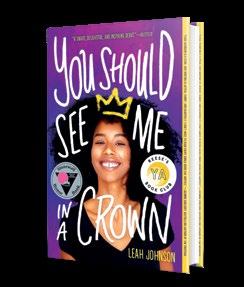
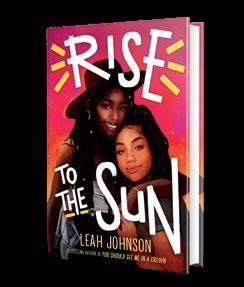
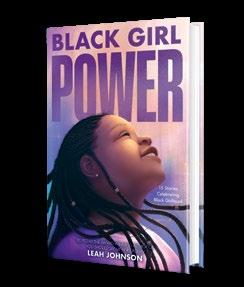
FROM THE EDITOR’S DESK
IF YOU’RE A book lover, one of the most alarming trends of the past few years is the rise of censorship in U.S. schools and school libraries. During this year’s Banned Books Week (Sept. 22–28), PEN America, the literary nonprofit that advocates for freedom of speech, reported more than 10,000 challenges to various titles during the 2023–24 school year, statistics that were “off the charts,” according a memo about the preliminary findings. The American Library Association tallied fewer book bans in its own preliminary report, but however you keep score, there’s no doubt that right-wing activists today feel emboldened to challenge books—especially those by and about Black, Indigenous, and People of Color (BIPOC) and LGBTQ+ people—poten-
tially keeping these works out of the hands of young people in many communities.
As discouraging as this state of affairs may be, the response of the literary and education communities has been inspiring. The New York Public Library, for example, has launched a Teen Banned Book Club; this fall they’re reading Mike Curato’s Flamer —one of the most frequently challenged titles in recent years—and teens nationwide will have the opportunity to discuss the book with the author online on Nov. 21.
Elsewhere, bookstores have leapt into the void. In her hometown of Gainesville, Florida, author Lauren Groff (Fates and Furies, The Vaster Wilds) opened The Lynx, a shop with an “emphasis in books that are currently
Frequently Asked Questions: www.kirkusreviews.com/about/faq
Fully Booked Podcast: www.kirkusreviews.com/podcast/
Advertising Opportunities: www.kirkusreviews.com/book-marketing
Submission Guidelines: www.kirkusreviews.com/about/publisher-submission-guidelines
Subscriptions: www.kirkusreviews.com/magazine/subscription
Newsletters: www.kirkusreviews.com
For customer service or subscription questions, please call 1-800-316-9361
challenged or banned in Florida, as well as those by BIPOC authors, LGBTQ+ authors, and Florida authors.” (According to PEN America, Florida and Iowa lead the nation in challenges.) A nonprofit associated with the store, The Lynx Watch, works to distribute banned books throughout the state.
Author Leah Johnson, who appears on the cover of this issue, is also playing a vital role in the fight to protect access to books—not just by writing them but by selling them, too. Last fall, the author of the acclaimed YA novels You Should See Me in a Crown (2020) and Rise to the Sun (2021) opened Loudmouth Books in her hometown of Indianapolis. Loudmouth specializes in books by marginalized people; the impetus for the business was the wave of legislation facilitating book banning that has swept through many states, including Indiana.
More recently, Johnson edited the middle-grade anthology Black Girl Power: 15 Stories Celebrating Black Girlhood (Freedom Fire/
Disney, Nov. 12), which brings together contributions by Elise Bryant, Kekla Magoon, Ibi Zoboi, Dhonielle Clayton, and others. As Johnson tells editor at large Megan Labrise in the cover story on p. 88, the new Disney imprint, headed by author Kwame Mbalia, made a “big statement” by putting the book on its inaugural list: “These narratives [of adolescence] are universal but so rarely given the time and the space to shine when it comes to us Black girls,” she says. That very challenge to the literary status quo is what often puts books like Black Girl Power in the crosshairs of would-be censors. The reactionary forces behind challenges and bans hate to expose young people to new narratives and new ways of seeing the world. Fortunately, literary citizens like Leah Johnson are fighting back with powerful stories and platforms for readers to find them. That’s something to celebrate.


Ingram’s Collection Development team of MLS-degreed librarians work to ensure that libraries are positioned to anticipate and meet patron demand.
Take advantage of these customizable programs today.
Trending Topic Lists:
iCurate Complimentary
Discover hundreds of complimentary curated lists.
Forthcoming Title Lists:
iCurate Coming Soon
To meet the need to easily manage new, forthcoming and tending titles, this annual subscription is NOW complimentary!
Essential Collection Analysis:
iCurate Core
Rebalance your collection with a one-time list suite of essential titles missing from your collection.
Tailor-Made Special Projects:
iCurate Custom
Supplement your collection team with Ingram’s librarians to curate high-quality, customized lists, tailored to fit your specific needs.
Diversity Audit:
iCurate inClusive
An effortless & effective diversity audit that delivers a one-time diversity assessment of your library’s collections. Including a comprehensive holdings assessment, data-driven reports, and actionable lists.
Co-Chairman
HERBERT SIMON
Publisher & CEO
MEG LABORDE KUEHN mkuehn@kirkus.com
Chief Marketing Officer
SARAH KALINA skalina@kirkus.com
Publisher Advertising & Promotions
RACHEL WEASE rwease@kirkus.com
Indie Advertising & Promotions
AMY BAIRD abaird@kirkus.com
Author Consultant RY PICKARD rpickard@kirkus.com
Lead Designer KY NOVAK knovak@kirkus.com
Magazine Compositor
NIKKI RICHARDSON nrichardson@kirkus.com
Kirkus Editorial Senior Production Editor
ROBIN O’DELL rodell@kirkus.com
Kirkus Editorial Senior Production Editor
MARINNA CASTILLEJA mcastilleja@kirkus.com
Kirkus Editorial Production Editor
ASHLEY LITTLE alittle@kirkus.com
Copy Editors
ELIZABETH J. ASBORNO
LORENA CAMPES
NANCY MANDEL BILL SIEVER
Contributing Writers
GREGORY MCNAMEE
MICHAEL SCHAUB
Co-Chairman
MARC WINKELMAN
Editor-in-Chief TOM BEER tbeer@kirkus.com
President of Kirkus Indie
CHAYA SCHECHNER cschechner@kirkus.com
Fiction Editor LAURIE MUCHNICK lmuchnick@kirkus.com
Nonfiction Editor JOHN McMURTRIE jmcmurtrie@kirkus.com
Young Readers’ Editor
LAURA SIMEON lsimeon@kirkus.com
Young Readers’ Editor
MAHNAZ DAR mdar@kirkus.com
Editor at Large MEGAN LABRISE mlabrise@kirkus.com
Senior Indie Editor
DAVID RAPP drapp@kirkus.com
Indie Editor
ARTHUR SMITH asmith@kirkus.com
Editorial Assistant NINA PALATTELLA npalattella@kirkus.com
Indie Editorial Assistant
DAN NOLAN dnolan@kirkus.com
Indie Editorial Assistant SASHA CARNEY scarney@kirkus.com
Mysteries Editor
THOMAS LEITCH

Contributors
Colleen Abel, Stephanie Anderson, Kent Armstrong, Mark Athitakis, Colette Bancroft, Audrey Barbakoff, Thomas Beheler, Nell Beram, Heather Berg, Elizabeth Bird, Christopher A. Biss-Brown, Sarah Blackman, Rhea Borja, Jessica Hoptay Brown, Jeffrey Burke, Kevin Canfield, Catherine Cardno, Hailey Carrell, Tobias Carroll, Charles Cassady, Ann Childs, Tamar Cimenian, Caridad Cole, Rachael Conrad, Adeisa Cooper, Jeannie Coutant, Kim Dare, Michael Deagler, Cathy DeCampli, Dave DeChristopher, Elise DeGuiseppi, Steve Donoghue, Anna Drake, Elspeth Drayton, Lisa Elliott, Tanya Enberg, Rosalind Faires, Joshua Farrington, Eiyana Favers, Rodney Fierce, Katie Flanagan, Mia Franz, Ayn Reyes Frazee, Jenna Friebel, Robbin Friedman, Roberto Friedman, Nivair H. Gabriel, Laurel Gardner, Jean Gazis, Fiona Giles, Chloé Harper Gold, Carol Goldman, Carla Michelle Gomez, Melinda Greenblatt, Vicky Gudelot, Tobi Haberstroh, Silvia Lin Hanick, Loren Hinton, Zoe Holland, Katrina Niidas Holm, Abigail Hsu, Julie Hubble, Kathleen T. Isaacs, Darlene Ivy, Kristen Jacobson, Wesley Jacques, Jessica Jernigan, Deborah Kaplan, Ivan Kenneally, Stephanie Klose, Lyneea Kmail, Andrea Kreidler, Alexis Lacman, Megan Dowd Lambert, Carly Lane, Christopher Lassen, Hanna Lee, Judith Leitch, Maureen Liebenson, Elsbeth Lindner, Coeur de Lion, Sarah Lohmann, Barbara London, Karen Long, Patricia Lothrop, Wendy Lukehart, Kyle Lukoff, Leanne Ly, Michael Magras, Joan Malewitz, Thomas Maluck, Collin Marchiando, Matthew May, J. Alejandro Mazariegos, Kirby McCurtis, J. Elizabeth Mills, Tara Mokhtari, Clayton Moore, Andrea Moran, Rhett Morgan, Christopher Navratil, Liza Nelson, Therese Purcell Nielsen, Katrina Nye, Erin O’Brien, Tori Ann Ogawa, Mike Oppenheim, Nick Owchar, Emilia Packard, Andrea Page, Megan K. Palmer, Derek Parker, Sarah Parker-Lee, Hal Patnott, John Edward Peters, Christofer Pierson, Shira Pilarski, Carolyn Quimby, Kristy Raffensberger, Stephanie Reents, Erica Rivera, Kelly Roberts, Amy Robinson, Lizzie Rogers, Elisa Rowe, Gia Ruiz, Lloyd Sachs, Bob Sanchez, Keiko Sanders, Meredith Schorr, Gretchen Schulz, Jerome Shea, Sadaf Siddique, Linda Simon, Margot E. Spangenberg, Allison Staley, Mathangi Subramanian, Deborah Taylor, Eva Thaler-Sroussi, Desiree Thomas, Bill Thompson, Renee Ting, Lenora Todaro, Jenna Varden, Christina Vortia, Katie Weeks, Audrey Weinbrecht, Amelia Williams, Kerry Winfrey, Marion Winik, Livia Wood, Bean Yogi, Jenny Zbrizher, Natalie Zutter
THIS YEAR, the first Tuesday of November is something more than Laydown Day for new books—it’s also the day of the presidential election, when no one is going to be paying attention to the latest fiction releases. But there are some exciting novels slipping into bookstores that day, beginning with Two Times Murder (Severn House, Nov. 5), the second novel in a mystery series by Adam Oyebanji. The hero, Gregory Abimbola, describes himself as “a bi-racial Russian of African descent pretending to be English.” He’s also a former Russian agent hiding out in Pittsburgh, teaching at a private school and—no surprise—getting mixed up in a variety of murders. Our starred review says this book


is “not to be missed.” (See the full review opposite.)
The title of Andy Marino’s chilling novel, The Swarm (Redhook, Nov. 5), refers to a brood of cicadas that appears in upstate New York a year before they’re due. There’s a dead body whose teeth and nails have been fully removed and who’s suspiciously untouched by insects. There’s a young woman caught up in a cult. There’s a forensic entomologist and a tech company founder trying to figure out what’s going on. “Readers who savor bugs and body horror will find plenty to enjoy here,” according to our review. “Shaggy, kinetic, and relentless.”
With any luck, we’ll know the next president by November’s second Laydown Tuesday, and

we’ll have more attention to spare for books. One to consider: Richard Price’s Lazarus Man (Farrar, Straus and Giroux, Nov. 12), his first novel since Lush Life in 2008. When that book came out, our reviewer said, “There oughta be a law requiring Richard Price to publish more frequently. Because nobody does it better.” (In 2015, he published The Whites using the pseudonym Harry Brandt.) Perhaps he’s been writing this new book ever since he finished Lush Life, since it’s set in 2008, and follows a Harlem community in the aftermath of a building collapse. Our starred review calls it “an affecting novel by a literary urbanologist in top form.”
It’s been six years since Haruki Murakami published
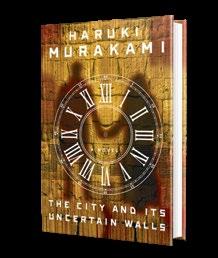
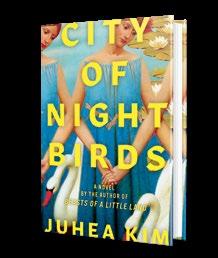
a novel, and his latest, The City and Its Uncertain Walls (translated by Philip Gabriel; Knopf, Nov. 19), harkens back to an even older work, Hard-Boiled Wonderland and the End of the World (1991). In a mysterious walled city, a young man interprets dusty dreams and then, returning to a more recognizable world, he grows up to become a librarian working with tangible books. Our starred review calls it “another beguilingly enigmatic tale from Murakami, complete with jazz, coffee, Borgesian twists, the Beatles, and other trademark motifs.…One of his most satisfying tales.”
Juhea Kim’s first novel, Beasts of a Little Land (2021), was a historical epic encompassing decades of 20th-century Korean history though a group of women trained by a renowned courtesan. Her enchanting new book, City of Night Birds (Ecco, Nov. 26), couldn’t be more different: Taking place in the world of Russian ballet, it follows one celebrated ballerina’s tumultuous career. Our starred review calls it “another brilliant page-turner.”
Laurie Muchnick is the fiction editor.
The second in Oyebanji’s A Quiet Teacher series doubles down on his hero’s skills and determination.
Gregory Abimbola is a complicated fellow with an incredible past. He’s the biracial British child of an African father and a Russian mother, brought up in a country where his “very skin was a scandal.” He’s a former Russian agent who’s hiding out in Pittsburgh after a failed attempt to kill him in Djibouti, teaching Russian and French to students at a private school whose privileged parents’ simplistic notions of race and culture are a constant source of frustration.
Everywhere he turns there’s a murder that needs to be
investigated and no one as equipped as he is to solve it. Now, a local police detective asks him to identify a body found in the river; a spurned suburban wife wants him to prove that her ex-husband’s death was not a suicide; and worst of all, a former colleague from the Russian Intelligence Agency orders him to discover— and dispatch—the killer of a fellow agent, threatening harm to his mother if he balks. There’s scant reward for success and danger lurking in failure, but as in Abimbola’s first foray into detection proved in A Quiet Teacher (2022), his code of honor makes it impossible for him turn his back on those who need him.

Oyebanji makes the unimaginable not only credible but compelling by exposing Abimbola’s rich inner life and setting it against the struggles of those who rely on him for help, most of whom can’t get out of their own way,
but nevertheless command readers’ sympathy for their challenges. Oyebanji’s puzzles are well-crafted and his solutions ingenious, leaving readers with both a sense of satisfaction and an appetite for more. Not to be missed.
Aber, Aria | Hogarth (368 pp.)
$29.00 | Jan. 14, 2025 | 9780593731116

A n aspiring photographer bent on concealing her Afghan heritage becomes embroiled in the Berlin techno scene and a fraught relationship with an older man.
Nilab Haddadi, known by most of her friends as Nila, is the daughter of refugees. Her parents, who once lived prosperous lives as doctors in Kabul, fled Afghanistan before she was born. All Nilab knows is the life they subsequently carved out in Berlin, and it, by turn, embarrasses and infuriates her: Their building is run-down and littered with Nazi graffiti, neighbors eye her comings and goings suspiciously, and memories of how carefully her family had to present themselves after 9/11 to avoid being harassed still loom large. After returning home from a boarding school where no one knew her true origins, 18-year-old Nilab has no desire to stick around an apartment defined by her dead mother’s absence and her father’s disapproval. She escapes to a techno club she affectionately refers to as the Bunker, where she quickly falls into the orbit of 36-year-old Marlowe Woods, known throughout the underground scene as “the American writer who always carried speed.” Though he has a “kind-of girlfriend” when they meet and Nilab’s friends warn her against getting in too deep, there is a queasy inevitability to their union. Coming-of-age stories focused on a relationship with an older, ill-advised paramour are a time-honored tradition, but Marlowe’s red flags are so glaring from the outset that Nilab comes across as startlingly, almost doggedly naïve. Aber’s storytelling also often undercuts its own tensions: Nilab narrates the novel from an indeterminate future, dampening the emotional immediacy, and more than once Aber elides dramatic conversations between characters in favor of describing the emotional aftermath. Still, Aber’s vivid depiction of
A campfire story about a girl whose brother is a bear.
Berlin and the novel’s earnest wrestling with shame about desire and identity will be of interest to many readers. A debut still in the process of finding itself—like its young protagonist.
Kirkus Star
Armstrong, Tammy | Harper/ HarperCollins (352 pp.) | $28.99 Oct. 8, 2024 | 9780063396142

Well-wrought touches of the fantastic enhance this tale of a girl growing up in a Canadian logging camp a century ago. About the time that Pearly Everlasting Hazen—named for a wildflower—is born in a remote logging camp in New Brunswick in 1920, her father, the camp cook, finds a tiny, orphaned bear cub in an ice-rimmed burrow. He brings the creature home, and his wife nurses her infant daughter and the cub together. As far as Pearly Everlasting and her family are concerned, Bruno is her brother, even as he grows big enough to unsettle strangers. The logging camps where the Hazens live are harsh places; if the work doesn’t kill someone, the weather might. Pearly Everlasting’s mother, Eula, is a healer who tends workers’ broken bones and other wounds, while her husband, Edon, keeps everyone fed. Pearly Everlasting and Bruno—and human older sister Ivy—grow up in this nurturing nest, attuned to the natural world and pretty much blissfully unaware of what’s beyond. Their only outside contact is a woman they call Song-catcher, an ethnologist who, with her companion,
Ebony, travels around with cumbersome recording equipment to document folk music and tales by people like Eula. The eventual snake in this childhood paradise is a new camp boss, a bully named Swicker, who arrives with a couple of minions and soon has Bruno in his sights. An attempt to bear-nap Bruno and sell him to an animal trader is foiled with the help of Song-catcher and Ebony, but later girl and bear, teenagers by now, stumble upon a murdered body, and Bruno is blamed and confiscated. Pearly Everlasting’s harrowing quest to get him back, on foot through the winter woods and then in a town that’s a complete mystery to her, is paralleled by the search for the pair by a young man named Ansell, a worker at the camp whose face is strangely webbed with silver scars, the result of a lightning strike. Armstrong, who has published five books of poetry and two previous novels, tells their tale in lyrically striking prose and makes its fairy tale elements work by grounding them in the grim realities and stunning beauties of life in a Depression-era logging camp. A campfire story about a girl whose brother is a bear becomes a warmly enchanting novel.
Arsén, Isa | Putnam (368 pp.)
$30.00 | Jan. 7, 2025 | 9780593718360

Sex and drugs and… Shakespeare. What begins as a marriage of convenience between two 1950s New York actors—one seeking to avoid scrutiny from the House Un-American
Activities Committee—results in more drama than they foresaw. Narrator Margaret Wolf, a member of the Bard Players, is a refugee from a hardscrabble Kentucky upbringing and from the violence and mistreatment of her early days in theater in Richmond. When she marries Wesley Shoard, a handsome, charming, and gay fellow cast member, it’s an unconventional union but one marked by love and affection. Margaret’s personal demons—including no small amount of overidentification with the roles she plays—leave her in a fragile mental state and out of work for a period. She accompanies Wesley to an unusual engagement at an isolated replica of Shakespeare’s Globe Theatre in the New Mexico desert. The couple’s relationship is tested during a summer of rehearsals there by numerous forces, including troupe members attractive—and attracted—to both of them; Margaret’s growing dependence on the pharmaceuticals—licit and illicit—she relies on to face the day; and the unexplained and menacing presence of a network of mobsters affiliated with the theater’s operations. The troupe’s engagement comes to a tumultuous end, with high stakes for Margaret and Wesley and a cinematic resolution to the duo’s woes, incorporating several nods to the Bard along the way. With sensitivity to a range of queer relationships as well as to Margaret’s unraveling psyche, Arsén paints a vivid portrait of 1950s backstage culture. The demands and compulsions of theater life create a satisfying backdrop for historical fiction that works as a page-turner.
The play’s not the only thing here; Arsén’s players intrigue as well.
Barker, Susan | Putnam (352 pp.)
$29.00 | Jan. 28, 2025 | 9780593718292

not just accepted but expected. An author doesn’t have to show us something new, because showing us something old in a new way provides its own thrills. What Barker offers here is essentially a vampire tale with subtle echoes of Dracula. Instead of trains and coaches, we have air travel. Telegrams are replaced by information gleaned from the dark web. And, in place of Bram Stoker’s bloodsucking revenant, we get an elusive woman with a camera and an eldritch god to feed. The story begins when two travelers, Jake and Mariko, discover that they share a terrible affinity. Both have lost loved ones to the same uncanny affliction, and both blame a strange woman who seems to be ageless. Mariko connects Jake with her dead brother’s wife. His interview with Mariko’s sister-in-law is both fascinating and chilling, as she describes her husband’s transformation from a charismatic artist to a monster she no longer recognized. Jake is convinced that the woman who seduced Mariko’s brother is the same woman who destroyed his best friend. After this, most of the text is composed of “testimonies” Jake gathers from other victims’ survivors and scenes from the perspective of the woman he’s hunting, and it’s a mess. However, horror fiction can survive—and even benefit from— mess. Dracula is a mess, but it’s a fascinating mess that moves at a fevered pace. Jake’s testimonies are repetitive and do nothing to advance the narrative, and the shifts in perspective seldom tell us anything new. The worldbuilding is rickety and kind of cringe. It turns out that the more you explain a terrible entity beyond human comprehension, the less terrible it gets. Similarly, the villain’s backstory makes her less, rather than more, frightening. An ungainly novel that undermines the promise of its premise.
Stuart Woods’ Golden Hour
Battles, Brett | Putnam (336 pp.)
$30.00 | Dec. 3, 2024 | 9780593331606

Battles continues his authorized takeover of Woods’ expansive turf with a tale that puts ex–CIA agent Teddy Fay in both the driver’s seat and the hot seat.
Ancient evil at large in the modern world. Horror has always been—at least, in its Anglophone form—a genre in which repetition is

Long before Teddy ended his career as a rogue intelligence agent by faking his death in a plane crash, he masterminded Operation Golden Hour, a task force devoted to taking down the Trust, in whose name Tovar Lintz funded terrorist operations around the globe. Now Tovar’s son, Felix Braun, chief executive of Braun Logistics and Security, has decided that it’s payback time against the agents behind Golden Hour, killing three of them and targeting the rest. Current CIA director Lance Cabot, one of the few people who know that Teddy’s still alive and flourishing under the guise of both Centurion Pictures producer Billy Barnett and Mark Weldon, star of Centurion’s new film Storm’s Eye, persuades him to go on the offense against whoever’s executing his agents and leaving a Trust signature behind. The publicity tour Mark Weldon is about to join in Italy for the screening of Storm’s Eye at the World Thriller Film Festival will provide the perfect cover, argues Lance. And he’s exactly right, for movie melodrama and offscreen maneuvering merge seamlessly with Teddy’s mission against Felix Braun, who’s very interested indeed to learn that the prime mover behind Golden Hour is still alive. Though there’s never any serious doubt about how all this will end, Battles plots much more tightly than Woods did—though that’s a low bar to clear—and fans of the series, first developed as a counterpoint to the ancient Stone Barrington franchise, won’t be disappointed.
Proof that the “golden hour” extends far beyond the ideal time to shoot movie exteriors.
Kirkus Star
Berlinski, Mischa | Liveright/ Norton (320 pp.) | $27.99 Jan. 21, 2025 | 9781324095200
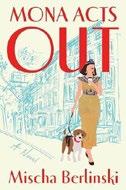
A celebrated Shakespearean actress spends Thanksgiving rather differently than expected.
Berlinski follows acclaimed novels set in Thailand (Fieldwork, 2007) and Haiti (Peacekeeping, 2016) with a New York–based comedy of manners and morals featuring a brilliantly imagined female protagonist, Mona Zahid, one of the stars of a Shakespearean theater troupe based in the East Village. Until recently, the company was led by legendary director Milton Katz, but an article in the New York Times, filled with accusations of misconduct from a slew of actresses, led to his disgrace. Mona, herself “an out-and-out, unabashed Miltophile,” was not among the accusers. We meet her as she awakens in her Morningside Heights apartment on Thanksgiving Day to a full house— in addition to her surgeon husband, teenage son, and canine companion Barney, her in-laws and her college student niece, Rachel, are milling about. Absent is Rachel’s mother—Mona’s sister, Zahra—who died less than a year earlier, leaving Mona a stash of 150 pain pills of which there are now only six. Mona starts her day by taking two. Not long after, she hears the assembled family members begin to argue about Milton Katz and Donald Trump. She knows she should go out and save the day, but by then she has vaped some weed so strong she suspects it of being laced with “hallucinogenic toad drippings” and can only bring herself to put Barney on his leash and race out the front door, claiming she’s off to buy parsley. At this point the novel takes an amazing left turn; suffice to say, Mona will not be home for dinner. Readers who know their Shakespeare will thrill to Berlinski’s brilliant distillation of
the power and relevance of the plays and characters, but those who don’t will find they can easily come along for the ride. And a great ride it is. Wonderfully constructed, witty, warm, wise, and filled with an extraordinary sense of the relation between theater and life.
Bohman, Therese | Trans. by Marlaine Delargy | Other Press (192 pp.) | $16.99 paper | Jan. 14, 2025 | 9781635424188
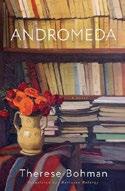
A young woman’s platonic but passionate relationship with her mentor affords her insight into both the past and her own possible futures. When we meet the main narrator of this languid novel of ideas, she’s a young woman fulfilling an unpaid internship at Rydéns, a prestigious publishing house in Stockholm. A woman from a stolid middle-class Swedish family whose parents “dutifully went off to work without any particular career ambitions,” the narrator is overwhelmed by her own inexperience. She has to learn “from scratch: what to wear, how to use the printer and the photocopier…” Also, how to navigate the standard interpersonal politics of any office, which, in this particularly heady profession, also include entrenched positions on the nature of art, the function of publishing, and the ideology of commerce, as Rydéns struggles to place itself at the forefront of modern Swedish culture while still maintaining the prestige of a past steeped in traditional publishing values. Introverted and serious in nature, the narrator feels more kinship with literature of “genuine purpose” than she does with the sort of books her contemporaries are more likely to champion—easily marketable novels with “a clear message” but written in “dull prose, lying heavy and dead on every single page…as if the authors had followed a template for significant depictions of contemporary society.” The narrator’s iconoclasm soon catches the eye
of Gunnar, Rydéns powerful editor-inchief, whose own sensibilities are a reliquary of a rapidly vanishing age. Gunnar takes the narrator under his wing, grooming her to take over his position running Andromeda, the avant-garde imprint he founded. Over the next many years, the two form an enduring bond, centered around their love for ideas and the glimmering impossibility of something more they both feel developing between them. But when Gunnar’s ill health forces him into retirement, the narrator is left alone to examine the true nature of their relationship, of her identity within the systems she has helped to preserve, and of the art she celebrates. A confident, erudite novel, comfortable with developing at its own pace, Bohman’s latest adds to her growing cavalcade of young women with old, enduring ideals. Deeply provocative in its quiet contemplation.
Brandon, John | McSweeney’s (250 pp.)
$28.00 | Nov. 26, 2024 | 9781963270075

An old debt threatens to upend a young ex-con’s efforts to start his life over again.
“Nobody’s even,” aging crime boss Arthur Bonne tells the kid standing in his office. “There’s guys I help and guys I hurt. You fall in that first bunch. I’m asking you to do something for me, and if you do it right and don’t perform a full wop opera in my office, I won’t ask you to do nothing else.” The kid is Pratt Zimmer; he’s just 25, but he’s lived and lost enough to know better than to believe Bonne will ever leave him alone. Pratt’s fresh from a three-year jail stint for his part in a botched car theft that set Bonne back $250,000, and now Bonne expects more from him than just jail time to make them square again. Added to the money debt is an emotional one: Bonne partly blames Pratt for the death of his son, Matty, even though Pratt was behind
bars by the time his childhood friend’s indulgence in too many drugs got the better of him. “It could only be punishment,” Pratt realizes about the job. “That was the only thing that made sense. Forced penance for Matty.” In this novel and his others—especially Arkansas (2008) and Citrus County (2010)—Brandon explores the difficult circumstances surrounding desperate characters in humid, forgotten corners of the Southeast. Here, he’s crafted a compelling thriller set around Tampa in the 1990s as a young ex-con struggles to start his life over, even though the deck is stacked against him. It’s not just the job Bonne tells him to finish by the end of June— kill an accountant who’s stealing from Bonne—that’s the problem. Pratt’s still grieving the loss of his parents in a boating accident, coping with the guilt he partly accepts for not doing more to protect Matty from himself, and nursing a smoldering love for Kallie, Matty’s ex. He’s also facing a string of lowlife thugs, drug dealers, and a dirty cop as he tries to figure out how not to kill the accountant and still free himself from Bonne’s debt. Brandon keeps the story moving at a brisk pace, and his choice of a 1990s setting is especially interesting: It reminds readers how different—and how difficult—things like a stakeout were in a cellphone-free, GPS-less world. Brandon proves that even an impossible situation with only one outcome can suddenly yield an unexpected solution.
Callaghan, Jo | Random House (400 pp.) | $18.00 paper Jan. 7, 2025 | 9780593736852

The second book in the British Midlands–set Kat and Lock series reteams what may be crime fiction’s oddest couple, given that one half of the pair isn’t even human. A man has been found dead on Nuneaton’s Mount Judd, his nude body tied to a cross and his ears cut off. To
Offbeat stories from the provocative Can Xue blend the earthy and uncanny.
MOTHER RIVER
identify the victim and solve the crime, the Warwickshire police force’s DCS Kat Frank once again partners with Artificially Intelligent Detecting Entity Lock, the world’s first AI detective, who takes the form of a 3-D holographic image of a 30-something Black man. According to Professor Adaiba Okonedo—the Black scientist who created Lock and whose personal experience with racism has left her wary of cops—the idea is to use bias-free AI to “rebuild public trust and confidence in policing.” Also good: In a matter of seconds, the AI detective can do things such as “cross-check the victim’s facial characteristics, height and weight with all social media posts matching white men between twenty-five and forty in the Nuneaton area.” To mystery readers not predisposed to reaching for tech thrillers, the premise may sound intimidatingly geeky, but once Callaghan establishes her terms, it’s one fleet, accessible scene after another. For the Star Trek savvy, conversations between Kat and her literal-minded partner may recall exchanges with Mr. Spock (Lock: “Your entire theory is built upon nothing but your imagination”; Kat: “It’s called empathy, Lock”). The novel’s central question—should humans fear replacement by machines?—hums throughout, but never hinders the story’s forward momentum, and the plot’s big reveal is unlikely to be foreseen by even the AI-abetted reader.
This thriller may feature state-of-the-art AI, but its solid craftsmanship is timeless.

For more by Can Xue, visit Kirkus online.
Can Xue | Trans. by Karen Gernant & Chen Zeping | Open Letter (256 pp.) | $17.95 paper | Jan. 21, 2025 | 9781960385314

Thirteen offbeat stories from the provocative Can Xue blend the earthy and uncanny. The fiction of Can Xue (a pseudonym) owes debts to magic realism, surrealism, and the Modernists at their most abstruse, but she’s also consistently determined to make sure that familiar feelings of love and loss emerge through her work. In these stories, narrators are usually observing befuddling acts of nature: strange dark shadows emerging in the title story, stones appearing both in the soil and bodies of a community in “Stone Village,” mushrooms overrunning a field in “Something To Do With Poetry,” an elephant suddenly emerging in “Love in Xishuangbanna.” Sometimes, these unusual events serve as contemporary takes on folklore and allegory: The multiple narrators of “Smog City” describe their pollution-struck town with a diffidence that echoes our collective disengagement from climate change—“People’s windpipes and lungs were getting so used to the smog that they accepted it as ordinary air, and let it pass through their bodies quietly and unimpeded.” But more often, the storytelling is unmoored from big themes and mainly cultivates a mood of strangeness and wonderment, as characters transition from everyday life into something weirder. In “The Neighborhood,” a retiree’s concern about the disruptive construction of a sports
facility leads him to a series of shifts: the arrival of feral cats, and growing numbers of Qigong practitioners, thanks to whom “every tree and blade of grass in the garden contained their breath, revealing the traces of communicating with them.” In “At the Edge of the Marsh,” a young man is drawn to a town elder dismissed as “defective,” but through him enters into a more dreamlike and mystical relationship with nature. Translators Gernant and Chen keep the prose simple at the sentence level while allowing the oddness of the storytelling to bleed through. Mind-bending but warmly delivered domestic tales.
Chambers, Clare | Mariner Books (400 pp.)
$30.00 | Nov. 12, 2024 | 9780063258228
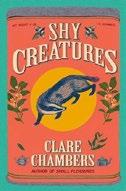
The arrival of a mysterious recluse at a British psychiatric hospital unlocks secrets from the past and sets in motion possibilities for the future. In 1964, Britain has not yet been reinvigorated by the youth revolution or the “Beatles phenomenon,” and many of its people are still marked by their World War II experiences; this is a stifling world of good manners, bad food, and limited opportunities for women. Thirty-fouryear-old Helen Hansford, however, has cracked the mold by choosing to work as an art therapist in Westbury Park, a psychiatric hospital, where she has met and begun a consuming affair with charismatic, married doctor Gil Rudden. An unusual patient, William Tapping, 37, arrives at the hospital; he doesn’t speak and hasn’t left his house in decades. His last living relative having died, Westbury Park becomes William’s home, a refuge where he can practice his considerable creative skills in Helen’s art class. At this point, the narration opens up to intersperse Helen’s story with chapters from William’s perspective, slowly revealing the reasons for his
isolation, withdrawal, and silence. In fastidious prose well suited to the novel’s period setting, Chambers traces William’s story back in time while advancing Helen’s growing difficulties with Gil and efforts to aid her struggling niece, Lorraine, now also a patient. While evocative of a buttoned-up time, the novel’s consciously understated tone (bad things are referred to as “unpleasantness”) muffles the few dramatic moments. More persuasive is the mood, redolent of post-war adjustments, and Chambers’ quiet but precise observations of circumstance (often drab), options, and individuals. Despite some two-dimensional minor characters, this is a finely detailed and modulated work, based on true events, that looks benignly on its characters and their trajectories. A composed period piece that pays sharp attention to the little things.
Chen, Karissa | Putnam (512 pp.)
$30.00 | Jan. 7, 2025 | 9780593712993
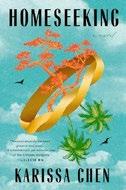
Major political, military, and economic events in 20th-century China affect the lives and romance of two Shanghainese over many decades. By moving around in time and place—including Shanghai, Hong Kong, Taiwan, and the U.S. from 1938 to 2008—Chen illuminates the parallels and relationships among key moments in China’s recent history. Intertwining the macro and micro, she makes readers care deeply about the impact of history on her characters’ very private lives. Even the characters’ names change to denote their code-switching based on geography and situation. Star-crossed lovers Suchi and Haiwen meet as first graders in pre-WWII Japanese-occupied Shanghai. A family crisis caused by Shanghai’s shifting politics forces Haiwen to enlist in the Nationalist
Army in 1947, before he can propose to Suchi. After Mao’s defeat of Chiang Kai-shek, Suchi lands in Hong Kong, and Haiwen in Taiwan; they meet briefly in the 1960s and do not communicate again until they cross paths in 2008 Los Angeles. Though they follow different paths and marry other people, they remain emotionally “tethered to each other,” as predicted in 1945 by a fortune teller who also described the concept of “mingyun”—a person’s “personal destiny” as determined by a combination of their intrinsic nature and chosen actions— which is so important to the story. Chen avoids romanticizing or demonizing any of her characters. Nuances of class and ethnicity, as well as political identity, come to life as she digs into crevices of ambivalence and muddled motivation. Suchi marries out of financial desperation. Haiwen abandons his passion for the violin to fight for a cause he knows is lost. Suchi’s father, a bookstore owner with progressive ideals, finds himself disillusioned once the Communists he backs take over. Haiwen’s cosmopolitan, Anglophile parents are vilified by both Nationalists and Communists. This is historical fiction at its most effective. Romantic lyricism and hard-edged realism merge in this compelling novel.
Child, Lee | Mysterious Press (256 pp.)
$28.99 | Sept. 3, 2024 | 9781613165669

A collection of short stories featuring the seedier side of life by one of the country’s best crime writers.
“Fabergé eggs they ain’t,” Child admits in the foreword, and he’s right. These are unfancy little eggs—to stretch the metaphor—that don’t overshadow his novels, and yet they satisfy our innate craving to read about other people’s failings and misadventures. Some of them end in twists that harken back to
O. Henry, such as “Ten Keys,” where a drug-running escapade ends in a surprising way. It also has the book’s best line: “He was a white guy…the product of too many generations of inbred hardscrabble hill people, his DNA baked down to nothing more than the essential components, arms, legs, eyes, mouth.” “My First Drug Trial” is also like that, with a last line that pops off the page. In “The Bodyguard,” a guy is hired to protect a young woman who is the high-value target of a rich and prominent couple. A nice twist at the end makes the bodyguard doubt himself, and the reader might smile. And then, in “The Greatest Trick of All,” there’s a professional killer who can nail you from a thousand yards and thinks he can’t be stopped. Said “greatest trick” is getting paid twice for a hit, but in this case, he might be mistaken. Most of the stories won’t keep you on the edge of your seat, but they’re easy, brief explorations of the darker nooks and crannies of humanity. But one story takes a sad turn into the past: In “New Blank Document,” a freelancer is assigned to write a sidebar about the brother of a modestly accomplished Black American artist living in Paris. The crucial, heart-rending story has to do with the fate of a second brother not everyone knows about; think Jim Crow. Finally, the title tale features a narrator you’d never want to meet in real life. Twenty tasty morsels, served over easy.
Coble, Colleen & Rick Acker
Thomas Nelson (352 pp.) | $18.99 paper | Nov. 12, 2024 | 9780840712578

Af ter losing her husband, grandmother, and job in quick succession, a young woman strives to uncover a criminal conspiracy while falling back in love with her hometown and its people.
A year after her husband, Jason, died in an accident, attorney Katrina Foster arrives at Talk, Inc., the Silicon Valley company where she’s employed, to find the FBI raiding the premises. David Liang, the chief executive, is under investigation for embezzlement and has apparently fled the country, leaving Liv Tompkins, his pregnant girlfriend—who’s also the company’s chief technology officer, and Katrina’s friend—behind. On the same day, Katrina’s beloved grandmother dies of a heart attack. Shattered by upheaval and loss, Katrina travels home to North Haven, California for the funeral, where she learns that she’s inherited her grandmother’s restaurant. With a lead on a new job back in Silicon Valley, she offers to sell the business to handsome restaurateur Seb Wallace, a local man with a tragic past who has become a major success. Katrina also has a secret: Liv loaded a prototype of Talk’s AI software onto her phone after Jason’s death, and she often speaks to the chatbot of her dead husband for comfort. She starts asking him more questions about the night he died, and he finally says, “I think I was murdered.” Returning to the homey comfort of North Haven, Katrina vows to uncover the truth behind Jason’s death, which involves a mysterious Satoshi egg that contains the code to $30 million worth of Bitcoin, a possible international assassin, and a potential mole in the FBI. She’s helped by her family, Liv, and Seb, with whom she falls deeper and deeper into attraction. It’s a high-octane thriller with the grounding touches of Katrina’s Norwegian heritage, the hygge of North Haven, and a very sweet romance between two likable, vulnerable people. Romantic suspense comfort food—just like waffles with cloudberry cream.
Corin, Joshua | Thomas & Mercer (287 pp.) | $16.99 paper Dec. 10, 2024 | 9781662523533

The line between fact and fiction is blurred when a dogged daughter seeks the truth about her mother’s murder. In 1995, when AOL chat rooms are new and all the rage, 15-year-old Bostonian Katie McCann, a self-professed “book-obsessed dork,” finds a kindred online spirit in 19-year-old Dev, who’s “WmbleyLnDet” to Kat’s “KMcCann14.” Their shared passion is renowned mystery writer Carissa Miller, who created the witty and charming detective Adrian Lescher, basing him on noted criminologist Alik Lisser; Miller’s reputation has grown even more glamorous since her mysterious disappearance. Kat’s interest isn’t random. When she was 6, her mother, Barbara, was murdered, and Lisser was instrumental in proving that the crime was committed by her father, Bill, who was convicted and died in prison. Dev, who’s tracked down Lisser’s phone number and address, presses Kat to contact him. When Lisser schedules a speech at Harvard, Kat is convinced to try. Lisser, it turns out, is equally interested in her. At the end of their long meeting, Kat is convinced that he, not her father, killed Barbara. Many twists follow. In addition to encouraging nostalgia for the early days of online chat, before skepticism of other people’s identities and agendas became the norm, Corin also includes many references to mystery literature and film. The first-person narrative nicely captures Kat’s passion and youthful recklessness;
A rabbit-hole whodunit full to overflowing with Easter eggs.
the title is a warning to both Corin’s resourceful heroine and his readers. A rabbit-hole whodunit full to overflowing with Easter eggs.
Dervis, Suat | Trans. by Maureen Freely Other Press (192 pp.) | $16.99 paper Dec. 10, 2024 | 9781892746931

A man reflects on the crime that sent him to prison— and on his uncertain future. Turkish author Dervis’ novel, first published in 1957, is now available to Anglophone readers in Freely’s tautly paced translation. The title character is a former medical student named Vasfi who’s leaving prison after having spent more than 12 years there, sentenced for his role in a man’s death. Initially, his mood upon reentering the wider world is bleak: “To look at the people around him and think of himself as a murderer was a torment he could barely endure.” Eventually, he thinks back over the events that sent him to prison, which related to his infatuation with Zeynep, a woman who lived in his neighborhood. He longed to be with her, but fate had other plans, and she ended up engaged to his greatuncle. When he confronted her with his feelings, she rejected him and went on to reveal that there were aspects of the situation—including the fact that she had previously been married and divorced, and had a 4-year-old child—of which he was completely unaware. His unresolved feelings remained an issue, however, and he eventually got into a fight with his cousin Nuri when Nuri claimed that Zeynep had been unfaithful to her new husband. That fight resulted in Nuri’s death and Vasfi’s prison term. In her introduction, Freely accurately describes this book as “a social-realist page-turner.” It isn’t until the long flashback has ended that the book takes a more philosophical turn, as an
Star-crossed skaters whiz through decades of melodrama on and off the ice.
increasingly destitute Vasfi wanders through the city overcome by desperation and self-loathing. And he gradually realizes something: “His Zeynep—the incomparable Zeynep of his youth—no longer existed.” It’s not until after this moment that he can find a path toward redemption. A melancholy look at dashed illusions.
Faladé, David Wright | Atlantic Monthly (304 pp.) | $28.00 Jan. 21, 2025 | 9780802164063

After World War II, a young French Jewish woman has romantic liaisons with two very different Black men.
Faladé’s second historical novel, after Black Cloud Rising (2022), is set in Paris and its suburbs and revolves around a young woman named Cecile Rosenbaum, whose experiences mirror those of the author’s mother, which he described in the New Yorker in 2022. The book opens with a chapter set in 1943; while the family is completely secular, Cecile’s grandparents and other Jewish neighbors are lost to the purge and she herself is hastily confirmed and enrolled in Catholic school. The second chapter jumps ahead to 1947, when Cecile meets a Senegalese French girl named Minette on the bus to the Communist Youth Conference. Through Minette, Cecile will connect with a young West African man named Sebastien. Both are acutely aware of politics and their relationship is plagued by ideological questions,
laid out rather pedantically. “Yes, she was white and he black, her of the colonizers and him the colonized, but what was each one willing to give, and to give up, in order to be together?” As Cecile and Seb struggle to find their way, she meets an African American GI in a jazz club. Mack Gray is from “KC, Baby!” He calls her Baby exclusively rather than her name, speaks in a Southern dialect, and introduces her to soul food, but is also eager to understand her situation and background. He concludes, “She was white and from money, but the money long gone...both of them easy targets as a result, yet neither lying down for nobody—not for nobody.” Though the characters and settings of this novel are well-researched and carefully drawn, the memoir version of this story in the New Yorker is more compelling than the fictionalized one. Vividly dramatizes issues of race and politics in turbulent post-war Paris.
Fargo, Layne | Random House (464 pp.) $28.00 | Jan. 14, 2025 | 9780593732045
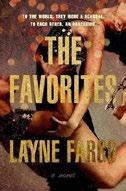
Star-crossed figure skaters whiz through decades of melodrama on and off the ice.
Fargo’s latest feature pairs skaters entwined by destiny and irradiated by fan and media obsession, as she cleverly tells her tale by alternating between narrative sections and clips from the script of a fictional 2024 documentary called The Favorites: The Shaw & Rocha Story. Katarina Shaw and Heath Rocha
are “small-town Midwestern trash,” both orphans, he of mysterious origins. Teen lovers, they enter the world of skating at the 2000 Nationals, where they meet their rivals, brother and sister skaters Garrett and Bella Lin, the privileged twin children of figure skating icon-turned-coach Sheila Lin (and an anonymous Sarajevo Olympic Village sperm donor). For the next 14 years, violent passions, bloody on-ice accidents, bedroom betrayals, sabotage, paparazzi-driven scandals, and nonstop cliffhangers—“Unfortunately, it was only the beginning”—lead up to an epic brouhaha at the 2014 Winter Olympics in Russia, by which time the reader’s capacity for outrage and surprise has gotten quite a workout. But don’t give up in the stretch: “NBC Sports commentator Kirk Lockwood reports live from the Sochi Olympics. ‘In all my years covering skating,’ he says, shaking his head solemnly, ‘I’ve never seen anything like this.’” Though the stereotype-driven characterizations of the skaters are a couple dimensions short of real or relatable—Heath in particular is a furious cipher—Fargo does a nice job with the narrators of her documentary. One of them, a former skater turned gossip blogger named Ellis Dean, can be relied on to spill the tea (“That program was the most passive-aggressive shit I’d ever seen— and I’m from the South, honey”), while an uptight U.S. Figure Skating official dryly tows the party line: “Ice dance can have a certain sensuality to it, yes. Many programs express the beauty of the love between a man and a woman. But what Ms. Shaw and Mr. Rocha were doing bordered on vulgarity.”
After all the histrionics and hormones, the unlikely ending Fargo bestows on her characters is a hoot.
Colleen Hoover–style romance heads to the Olympic rink. Buckle up.

Gardiner, John Rolfe | Illus. by Maria Nicklin Bellevue Literary Press (224 pp.) | $17.99 paper | Jan. 14, 2025 | 9781954276321

A clutch of wry coming-of-age tales, the first in 20 years from the veteran Gardiner.
deafness and embrace of sign language slyly reveals everyone’s failures to better understand themselves.
Foursquare but often affecting studies in domestic anxiety.
For more by Layne Fargo, visit Kirkus online.
The 10 well-turned stories in this collection usually feature narrators looking back on awkward but meaningful moments in their youth. The narrator of “Tree Men” is a failed academic who comes into himself as an assistant for a tree service. In the title story, a man recalls an ill-advised flirtation with a hard-to-read classmate at a Christian college. In “Virgin Summer,” a young man’s student-exchange trip to France offers some historical and social enlightenment. “Freak Corner” looks back to 1953, as the narrator explores the history of his deaf sister, a transgender neighbor, and the neighborhood bullies who tormented them both. Gardiner’s narrators are writing from a position of maturity, and some stories feature more grown-up types: “The Man From Trenton” centers on a semi-successful writer and a noisy conflict he had with a man on an Amtrak quiet car, while in “Familiars,” two couples who’ve taken vacations together for 17 years find their friendship beginning to fray. But even in those cases, Gardiner is interested in his protagonists’ past youthful foibles and how they shaped the flawed adults they became. Gardiner began publishing in the early 1970s in publications like the New Yorker, and his prose sometimes has an overly mannered, slightly fusty feel. One man, fearing death, “wondered if he was getting the scythe man’s signal,” and a plot point about a viral blog post in “Familiars” feels untenable. But at his best, he has a nuanced sense of characterization and a knack for writing gracefully about stress without undercutting the tension. That talent is strongest in “Freak Corner,” where the narrator’s sister’s misunderstood
Goldberg, Tod | Soho Crime (304 pp.)
$25.99 | Oct. 29, 2024 | 9781641296137
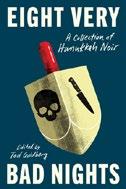
Eleven dark tales offer a perplexing take on the Festival of Lights. Christmas crime stories often focus on the more secular aspects of the holiday: shopping, presents, parties, snow. But many of the stories Goldberg selects seem to regard Hanukkah—a relatively minor festival—as deeply religious and widely observed, even by secular Jews. The tension between characters’ focus on celebrating the holiday correctly and the egregious aspects of their personal behavior is unsettling. In David L. Ulin’s “Shamash,” an aging man becomes increasingly obsessed with his grandmother’s menorah as his traumatic past prods him to violence. In James D.F. Hannah’s “Twenty Centuries,” a mother turns her back on the death of her adult child to go home and light candles with her new husband. A spurned girlfriend uses a Hanukkah party to get revenge against her boyfriend in Liska Jacobs’ “Dead Weight,” and the annual Hanukkah party at Sucks to Be U Records, with a carefully curated menu of Jewish delicacies, has an equally grisly finale in Jim Ruland’s “The Demo.” A selfdiagnosed sociopath loses it when her no-good brother-in-law disrupts her family’s latke celebration in Stefanie Leder’s “Not a Dinner Party Person.” And editor Goldberg seems to regard his hero’s string of thefts, drug deals, and causal mayhem as some sort of Maccabean victory. Only in Lee Goldberg’s “If I Were a Rich
The novelist and critic surprises readers with a delightful book set in a midcentury New York women’s hotel.
BY MARION WINIK

STILL IN HIS 30 s , novelist and cultural critic Daniel M. Lavery has a long list of achievements. He founded the website The Toast, had a five-year run as Slate’s “Dear Prudence” columnist, and published several books that retell classic texts from a humorous feminist perspective. Among them is The Merry Spinster (2018), which Kirkus, in a starred review, called a “wholly satisfying blend of silliness, feminist critique, and deft prose.”
In 2020, a hybrid memoir—that addressed, among other things, his gender transition—made a splash and received another Kirkus star. Of Something That May Shock and Discredit You , our critic enthused, “Everyone should read this extraordinary book.”
That same year, the one where we all stayed home, Lavery went deep into the reading that would lead him to write Women’s Hotel (HarperVia, Oct. 15), about a group of characters who live and work at the fictional Biedermayer Hotel in 1960s New York. We caught up with him over Zoom to discuss this latest Kirkus-starred feat of literary magic. Our conversation has been edited for length and clarity.

Women’s Hotel seems quite different from your previous work. Would you agree? I think so. After the memoir, I was interested in writing something removed from my own experience—I wanted to write the kind of book that I had been reading a lot of. During the pandemic, I spent a lot of time with books from an imprint of Dean Street Press called The Furrowed Middlebrow. They specialize in reprinting lesser-known British, Irish, and American
women writers from about 1910 to 1960.
So classic—or at least existing—texts did play a role.
Yes, and I was also influenced by novels like Rona Jaffe’s The Best of Everything and Mary McCarthy’s The Group. I love the kind of book that describes a lot of little moments in the lives of quite a few people.
I had the feeling, reading Women’s Hotel, that it was
not of the present time. It felt like something I dug up at a yard sale, a forgotten gem from another era. I’m thrilled to hear you say that! When I finally got to see the cover of the book, I felt they got it just right. While it’s not ever totally possible to recreate a historical period that you didn’t live in, I tried to think about what novels from that era had to say about friendships and resentments and ambitions, and the way that people talked to and about one another. I gave my characters attitudes and perspectives that I could feel affection for but that felt totally different from [my own].
What other research did you do?
I spent some time at the New York Public Library gathering historical and architectural details and also found a few newspaper columns
about life at women’s hotels. Three of the characters in this book are loosely based on real people.
Do tell.
Stephen, the elevator operator, is partly inspired by Stephen Donaldson, the first openly queer student to attend Columbia (it’s Cooper Union in the novel). Like his namesake in the book, Donaldson actually contacted the dean, via a social worker, after his acceptance and asked if they would register a “known homosexual.” He was told he could attend if he promised to enter psychoanalysis and not seduce the other students.
Lucianne is loosely based on Lucianne Goldberg, who founded the Pussycat League, a sort of tongue-incheek anti-feminist organization of the 1960s, although the connection there is much more tenuous. The
glamorous character Gia Kassab, who comes to New York with the intention of marrying a man her mother dated when she was growing up, is inspired by Joan Brady, who ended up marrying a midcentury writer named Dexter Masters, whose work I happen to love. She published a beautiful piece in the Daily Telegraph after Masters’ death called “Why I Stole My Mother’s Lover,” and I just adored it. It was so frank and remorseless and libidinal.
The phenomenon of the women’s hotel is discussed in the foreword, advancing the idea that the thing the residents share is that they just don’t want to be home. That seems contrary to one of the most universal motivations in literature. These are characters who, both for reasons they could articulate and ones they couldn’t, are avoiding living at home. Some feel they failed, some have been rejected, others have just sort of washed out. Because the book is set right before there’s a significant counterculture, they are waiting for a moment that hasn’t quite arrived—but when it does, it will help them make sense of their lives.
Are there characters you particularly identify with?
Yes—Katherine, Lucianne, and Ruth, though they’re all quite different from one another. With Lucianne, it’s the perverse desire to tweak things, to poke at situations sometimes to my own detriment. With Katherine, it’s obsessional worry about being rejected, which can itself become very selfish.
And like Ruth, I know the feeling of sometimes just wanting to get out of everything and glom onto somebody else’s life.
Katherine is a recovered alcoholic with a story that seems straight out of the Big Book. Are you sober? I am. I got sober in 2013. But alcoholism looks very different in Katherine’s life versus mine. I did read through the Big Book , and thought quite a bit about Alcoholics Anonymous. Here’s a midcentury institution that is actually
becoming more and more influential, unlike the women’s hotel, which is on the opposite trajectory.
Katherine’s relationship to AA is meant to show that this is something understood at the time as brand new and transformative. This is the wave of the future. This is going to be the thing that actually helps people.
Speaking of the downward trajectory of the women’s hotel, let’s talk about one of the throughlines of the plot, the end of breakfast
These are characters who, both for reasons they could articulate and ones they couldn’t, are avoiding living at home.

service at the Biedermayer. The first sentence of the book tells us, “It was the end of the continental breakfast, and therefore the beginning of the end of everything else.”
I love books that are interested in food and creature comforts. I find that so much of my ability to be a convivial, caring person rests on when I get my little meals and treats. As long as I have them in exactly the right order and configuration, I’m a delight. When I don’t, my ability to be a person in the world often really falls apart.
When their free breakfast goes away, and the Automat is shutting down, and the availability of big, well-made breakfasts and lunches around the city is disappearing, everybody has different reactions to it. Lucianne tries to score meals from dates and former co-workers. Other characters start stealing. Others eat less. Some try to pretend it isn’t happening.
The Biedermeier is part of a class of institutions that grew up in the 1920s and ’30s— boarding houses, automats, kitchens and cafeterias serving cheap batch food—that supported the growth of an artistic middle class in major cities. As the book unfolds, that infrastructure is crumbling. My characters are living through this period of change. Because they are funny and interesting and resilient, they will make it through, and go on to live other ways—but it is, I think, a loss.
Marion Winik hosts NPR’s podcast The Weekly Reader.


Percival Everett and Rachel Kushner are among the authors contending for the award.
The shortlist for the Booker Prize has been revealed, with Percival Everett and Rachel Kushner among the authors in contention for “the best sustained work of fiction written in English by authors from anywhere in the world and published in the U.K. and/or Ireland.”
Everett made the shortlist for James, his retelling of Mark Twain’s Adventures of Huckleberry Finn from the point of view of the enslaved Jim. The novel was a finalist for the Kirkus Prize and also longlisted for the National Book Award.
Kushner was named a finalist for Creation Lake, which also made the National Book Award longlist. She was previously longlisted for the Booker in 2018 with The Mars Room
Samantha Harvey was the sole British novelist to make the longlist, for Orbital, which was previously shortlisted for the Orwell Prize for Political
Fiction and the Ursula K. Le Guin Prize for Fiction.
Australian author Charlotte Wood was named a finalist for Stone Yard Devotional, alongside Dutch writer Yael van der Wouden for The Safekeep and Canadian author Anne Michaels for Held
Edmund de Waal, chair of this year’s judging committee, said in a statement, “Here is storytelling in which people confront the world in all its instability and complexity. The fault lines of our times are

For more literary awards news, visit Kirkus online.
here. Borders and time zones and generations are crossed and explored, conflicts of identity, race and sexuality are brought into renewed focus through memorable voices.”
The winner of the prize will be announced at a London ceremony on Nov. 12.
—MICHAEL SCHAUB
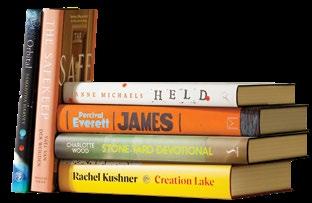

Man” does the hero recognize the irony of his appropriation of Jewish cultural symbols in facilitating his crimes. Feh.
Josaphat, Fabienne | Algonquin (288 pp.)
$29.00 | Dec. 3, 2024 | 9781643755885
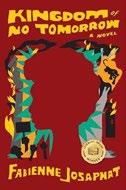
A coming-of-age story mixes Black Panther Party ideals with besotted romance. It’s 1968 and Nettie Boileau, the beautiful, orphaned daughter of a murdered Haitian doctor, arrives in Oakland, eager to assist with the first free medical outreach of the Black Panther Party. “If she couldn’t do this, then what point was there in even living?” 20-year-old Nettie asks herself, in a story built of breathless interior rumination. Her best friend, Clia Brown, is crushing on her, but the novel’s opening scene supplies Nettie with another reason to exist when she “lock[s] eyes” with the capable Panther Party captain, Melvin Mosley. He has been called in to dispatch the racists menacing the home of a boy with sickle cell anemia, but “what distressed her the most was how handsome he was.” In due course, Melvin will give Nettie a gun and a pregnancy, two time-honored plot devices. Nettie takes both to the Midwest, following Melvin to his assignment to help open an Illinois chapter of the party. Young Nettie soaks up the rhetoric of Stokely Carmichael; she “caught those words like falling rain, swallowed them like holy water.” But the high of revolutionary ardor precedes the low of Melvin’s infidelities and the bitter winters of Chicago. Worse, the FBI moves in to shut down the Panthers, and it’s Nettie and her body that pay the price. Josaphat, a Haitian-born writer living in South Florida, quotes Huey P. Newton, Fred Hampton, and James Baldwin to strong effect. Police are “pigs” here, and the Panthers’ newspaper “was like a portal,” reporting “who in the community had been imprisoned, whose
death went uninvestigated, whose bail needed to be posted, and who needed legal assistance.” The author is drawing clear parallels between police violence then and now. In her acknowledgements, Josaphat writes that she has “always been fascinated by the minds of radicals.” Unhappily, her cliched prose makes a poor container for the history she reveres.
A strong premise set amid the Black Panther Party falters in its execution.
Korn, Gabrielle | St. Martin’s (304 pp.)
$29.00 | Dec. 3, 2024 | 9781250323484
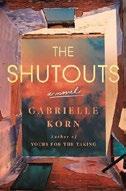
A group of survivors finds new ways to live and love as the world burns around them. Set in 2041 and 2078, Korn’s dystopian sophomore novel serves as both a prequel and sequel to her debut novel, Yours for the Taking (2023). In 2041, the world is falling apart due to rapidly accelerating climate change. As storms, fires, and viruses destroy cities, millions of climate refugees find themselves without homes. Kelly, a hacker and activist, is traveling across the United States and writing letters to the daughter she left behind. Seven years earlier, Kelly joined a group she believed would save the world. Starting from her childhood, Kelly recounts in devastating detail how and why she left—and, even more importantly, why she’s returning. In 2078, a group of queer characters seeks out new ways of surviving in a world that is unimaginable and nearly uninhabitable. Max, a nonbinary person who grew up in the Winter Liberation Army, discovers truths about their home that make it impossible to stay. Survivalist Orchid sets out to save her ex-girlfriend Ava from the Inside Project, a highly selective, government-funded climate protection program. Meanwhile, Ava and her daughter, Brook, have escaped the Inside after unearthing a deadly secret. Finally, climate refugee
Camilla decides to wait for her friend Orchid to return, while their group travels further north for safety. As Max, Orchid, Ava, Brook, and Camilla try to survive both together and apart, they begin to discover the known and unknown connections among them. As the novel races to a finish, the dual story lines converge satisfyingly, if a bit too conveniently. However, Korn’s worldbuilding and character development (especially Kelly) breathe life into the novel as it explores societal collapse, political conspiracies, and the pliable nature of historical narratives. The novel ends with a perfect blend of sadness and hope that refuses to downplay the dangers of climate change nor discount humanity’s desire to survive.
A page-turning queer, feminist dystopia.
Littell, Robert | Soho (208 pp.)
$25.95 | Jan. 28, 2025 | 9781641296861

The veteran spy novelist indulges what he calls an “obsession” with Leon Trotsky to imagine the Russian’s brief New York sojourn. Born Lev Davidovich Bronshtein, Trotsky took his betterknown name from one of his prison guards. Littell mentions in a foreword that his own father was born Leon Litzky, but he had the surname legally changed in 1919 to Littell because of its resemblance to the infamous revolutionary’s nom de guerre. This nominal link is why, the novelist says, he “couldn’t resist fantasizing” about Trotsky’s 10 weeks in New York just before the 1917 revolution erupted. Trotsky sails with his longtime companion and their two sons in early 1917 to New York, where his fame has preceded him. J. Edgar Hoover conducts his immigration interview, a likely anachronism, and the press greets him on the pier. Trotsky moves into an apartment in the Bronx and begins writing for the Russian-language
newspaper Novy Mir and the Jewish Daily Forward. He begins an affair with a journalist named Frederika Fedora, who has ties through her father to Mexican revolutionary Emiliano Zapata. He gives speeches and argues with various emigres and sympathizers, including Nikolai Bukharin and Eugene Debs. The average reader might be mystified by the factional nuance and rhetoric that emerge among committed Socialists, Bolsheviks, and Mensheviks. The U.S. visit comes to an end when the czar abdicates and Trotsky feels he must return to a Russia where revolution has begun again. While the historical characters are little more than foils and talking heads, Littell creates a wellrounded personality in Trotsky. Some of the character development derives from his highly active and vocal conscience, whose contrarian bent constantly tests the man’s convictions and assertions. And note that Trotsky associates his conscience with a “childhood nemesis” named Leon Litzky—which may make sense if you’re fantasizing about an obsession.
A colorful but uneven venture into historical fiction.
Kirkus Star
Muchemwa, Chido | Astoria/House of Anansi Press (176 pp.) | $17.99 paper Oct. 8, 2024 | 9781487012465
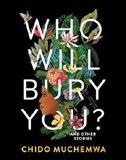
In her debut collection, Muchemwa—a Zimbabwean writer living in Toronto—deftly chronicles both family tensions and national struggles. The first three stories in this empathically rendered collection provide a useful summary of Muchemwa’s skill at capturing emotional complexity and avoiding cliches. “Who Will Bury You?,” “This Will Break My Mother’s Heart,” and “If It Wasn’t for the Nights” play out like a chamber drama: A young
Zimbabwean woman moves to Canada, where she falls in love with another woman; back home, her devoutly Christian mother wrestles with her own feelings. In three stories, Muchemwa takes readers inside the heads of mother, daughter, and the daughter’s fiancee in turn, taking each of their struggles seriously and arriving at a moving conclusion. These three pieces start the collection on a high note, and Muchemwa’s attention to detail throughout the book pays welcome dividends, even down to small things like characters’ taste in books. A character in one story describes reading Chimamanda Ngozi Adichie’s Americanah, while two others bond over their shared love for Anne McCaffrey’s science fiction novels. Muchemwa skillfully deploys references to books and music where you least expect it, as when the narrator of “Finding Mermaids” goes looking for a woman who is said to be “evidence of the power of mermaids.” The person she finds is far more idiosyncratic: “She wore a headband made from goatskin and a cowhide pinned around her shoulder, but under the hide was a black System of a Down T-shirt with the sleeves ripped off.” Elsewhere, in stories like “Kariba Heights” and “The Last of the Boys,” Muchemwa steps back in history, exploring Zimbabwe’s colonial past and struggle for independence. The total effect of this notable collection is of an author demonstrating her range and skill. An impressive and expansive collection.
Parlato, Terri | Kensington (304 pp.)
$28.00 | Dec. 24, 2024 | 9781496738622
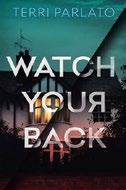
Marital dysfunction is complicated by an inexplicable kidnapping. After a short prologue that finds Nathan Liddle helpless “as a bug on its back” and expecting to be killed at any moment by his beautiful wife, Eve Thayer, a psychiatrist, the story flashes back three weeks to the couple’s
strained marriage. While their new baby, Rosewyn, is the proverbial bundle of joy, her needs and bouts of ill health add strain to their relationship. So does Nathan’s careless extramarital affair with a free-spirited woman named Nicole. A parallel plot thread follows Det. Rita Myers and her handling of multiple local crimes. The two threads converge when Rosewyn is kidnapped from the home of babysitter Barbara Singleton. For a while, suspicion falls on Donald Barry—a disgruntled patient of Eve’s—and his wife, Gail, but some strange additional twists widen the circle of suspects. The surprise return of the baby doesn’t solve the original crime; it just deepens the mystery. Parlato’s thriller is breezy but a bit muddled, full of feints, shadowy suspicion, and an 11th-hour murder. Short chapters ricochet among the first-person perspectives of Eve, Nathan, and Rita, making for a quick read and giving the illusion of pace. Both Eve and Rita commiserate about their jobs and their struggles to achieve the elusive work-life balance, Eve with her old friend Rachel and Rita with her brother Danny. The overall effect resembles a Lifetime thriller: half skillfully executed soap opera, half diffuse whodunit.
A lively pop thriller with a pair of hard-working heroines that could almost have been written by AI.
Ragan, T.R. | Thomas & Mercer (287 pp.) | $16.99 paper Nov. 5, 2024 | 9781662517303

The murder of a bullying ex-journalist threatens to rip the lid off the many scandals plaguing a toney Sacramento neighborhood. Time was that Rosella Marlow was widely respected by her professional peers and her neighbors. In fact, her lovingly preserved home in the Fabulous Forties district won the Best House on the Block award twice. But since her husband and son were
killed in a car accident and her house has lost top honors to Chloe Leavitt’s far inferior place, she’s gone off the rails, spying on her neighbors, vowing vengeance for their slights, and becoming the recipient of anonymous notes (“I Know What You Did”) and menacing stick figures. Even Shannon Gibbons, the nobody she’s plucked out of nowhere and moved into the Forties to serve as her researcher and footrest, is put off on their first meeting by her brusque manners and casual cruelty. When Shannon returns the following day, she finds Rosella dying after having been stabbed in the neck by a letter opener. Since there’s no husband left in the picture, Det. Seicinski and Det. Toye elevate Shannon to the top of their list. But that’s only because they don’t know about all the secrets held close by Chloe, who quickly bonds with Shannon, and by Jason and Dianne Abbott, Kaylynn and Nicolas Alcozar, Becky and Holly Bateman, and, yes, their children. Seicinski and Toye will make two arrests before the cascade of unsurprising surprises reveals a killer only Shannon will have failed to suspect. Expertly paced revelations that disturb the heroine and her new neighbors a lot more than the reader.
Rishøi, Ingvild | Trans. by Caroline Waight | Grove (192 pp.) | $20.00 Nov. 19, 2024 | 9780802163493

A Christmas story about a 10-year-old Norwegian girl who believes in miracles, and her 16-year-old sister.
“Hello, two motherless children and an alcoholic here, can you please give us two more weeks?” This is the phone call that Melissa resorted to just once, according to her little sister, Ronja. It’s the full truth, which the sisters try to keep hidden—from the neighbors, from the schools, and even from themselves. The story focuses on one Christmas season when, ever so briefly, their father dries out
and gets a job as a Christmas tree seller before once again falling apart. As he disappears into bars, Melissa takes over his job, doing the work before and after school, but for less pay. Soon, her coworker Tommy brings Ronja in to convince customers to buy decorative wreaths so he and the girls can split the commission. She hawks them, saying that “all proceeds go to children in need!”—that is, she and her sister and Tommy’s soon-to-be-born child. But Ronja is too young to be working at the tree market, so her efforts must be kept secret from the owner. Though the sisters love their father, he’s unable to care for them and regularly put food in the fridge, so they’re desperate. But as much as they hope no one sees their situation, everyone does—and just a scant few try to help: There’s Aronsen, the across-the-hallway neighbor who feeds Ronja a few meals and irons her Christmas costume. The caretaker at school who shares his lunch with Ronja every day. Ronja’s friend Musse and his dad, who find her wandering in the cold and try to get her sister to take her to the emergency room. Ronja is convinced that when things are at their worst, a miracle can happen, because sometimes they just do. But then again, sometimes they don’t.
A heart-wrenching tale of children trying their utmost to take care of each other.
Ross, Adam | Knopf (528 pp.)
$29.00 | Jan. 7, 2025 | 9780385351294
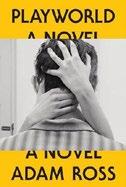
A teen actor in 1980 Manhattan grapples with the consequences of fame, his eccentric family, and the advances of a family friend. This longawaited follow-up to Mr. Peanut (2010) and the wellreceived story collection Ladies and Gentlemen (2011) chronicles a season of upheaval in the life of a child actor on the cusp of adulthood. It offers a blast to the past in the vein of Garth Risk Hallberg’s City on Fire (2015) and the
existential angst of Donna Tartt’s The Goldfinch (2013), but lacks much in the way of pathos. The book is written from the point of view of Griffin Hurt, an otherwise ordinary prep school student whose actor father pressured him into show business. What’s meant to make Griffin unique is his role as popular Peter Proton on an NBC show called The Nuclear Family, but we barely see any of those experiences. Instead, the show and its accompanying fame serve as an albatross around Griffin’s neck that interferes with his true passion: wrestling for the school team. Meanwhile, Griffin’s parents are distant and self-absorbed, while his younger brother, Oren, although personable, mostly exists as a sounding board and partner in crime for Griffin. Instead, Ross pulls his inciting incident straight from The Graduate with the introduction of Naomi Shah, an older friend of Griffin’s parents whose unhappy marriage and impulsive tendencies lead her toward predation. As Griffin lies through sessions with the family therapist and his storied career threatens to derail his own ambitions, his avoidance mirrors the novel’s narrative pitfall: plenty of movement but no real change. With no true villain and nowhere for the story to go, readers may find themselves anxiously awaiting a climax that never comes. An intriguing coming-of-age story that’s rich in atmosphere but falls short on resolution.
Sallis, James | Soho Crime (848 pp.)
$35.00 | Nov. 12, 2024 | 9781641295543

A retrospective banquet of 154 stories, including 11 never published before, from a novelist who’s always been something of a miniaturist.
The aptly titled “Abeyance,” the longest by far
of the new stories, cuts back and forth between Hannah Martyn, a nurse in the neonatal intensive care unit, and her colleague Moira Jarosz, who’s vanished from the NICU ward and her home. As usual in Sallis’ work, the plot is secondary to the evocation of an impossibly teeming world in which Hannah’s search for Moira competes with the equally urgent rhythms of infants struggling for breath; couples trying their best to conceive; passing interactions with friends, neighbors, and family members; haunting dreams and memories; and the general sense of a world in which, as Moira reflects, “change is the constant….You’re forever opening doors then standing there hoping it won’t come in.” Several of the other new stories provide especially notable epiphanies. The narrator of “Blood Draw” ruefully acknowledges that having good veins hasn’t prepared him for what comes next. The sorely distracted husband of “Silver” frets about what steps to take with his wife, who has early-onset dementia. The teacher turned monster-killer in “All My Grendels in a Row” reflects on his vocation to serve and protect. “Billy Deliver’s Last Twelve Novels” devotes one teasing paragraph to each of those novels. A ritualistic conversation about “what we leave behind” in “How the World Got To Be” leads the narrator to wonder whether words will save or damn us. And the narrator’s contract with Rerun Inc. to provide a do-over of his unfortunate last three days in “How I Came To Be,” an homage to a classic Ray Bradbury story, leads to far more public calamities. Like a hive bereft of its queen, Sallis’ world buzzes endlessly with worker bees and drones.

Shamieh, Betty | Avid Reader Press (336 pp.) | $28.99
Jan. 28, 2025 | 9781668046548

Multiple narratives track three Palestinian women from the Middle East to America and back again.
Arabella Hajjar is a New York theater director specializing in hip adaptations of Shakespeare and making a mess of her love life; she refuses to admit to longstanding feelings for her best male friend, who happens to be Jewish. Her Teta Zoya wants to set Arabella up with Aziz Habeeb, a doctor whose grandfather came from Zoya’s childhood village of Ramallah. Harvard-educated and hoping for bigger things in her directing career, Arabella is frustrated by her perception that people are more interested in ethnicity than art: “If you asked either to describe themselves in a word,” Arabella muses of two acquaintances, “they would have the same answer. Palestinian. Mine would be director.” So, when she’s given the opportunity to return to Palestine to direct a gender-swapped Hamlet, Arabella is apprehensive. Will her devotion to her work carry her through the complex political and emotional terrain of her return to Ramallah? And will Arabella finally open herself up to more than just theater? Playwright Shamieh, in the novel’s first part, toggles back and forth between Arabella in 2012 and Zoya, beginning just before the 1948 Arab-Israeli war and the family’s subsequent immigration to Michigan. Part Two interweaves Arabella’s arrival back in Palestine with her mother Naya’s childhood in 1970s Detroit and her adult life in California. Shamieh’s tone—present throughout, but strongest in Arabella’s sections—is
confiding and chatty, a Carrie Bradshaw if Carrie had to worry about getting detained at Ben Gurion Airport by Israeli guards for eight hours. But this book isn’t fluffy: Its ethically complex characters carry heavy weights.
Shamieh refuses easy moral lessons, aiming for complexity and nuance with a light, voicey touch.
Suzuki, Izumi | Trans. by Helen O’Horan Verso (192 pp.) | $19.95 paper Nov. 12, 2024 | 9781804293300

An intimate, candid portrait of a 20-something woman navigating the tumultuous world of music, partying, and relationships in 1970s Japan, originally published in Japanese in 1996.
In Suzuki’s first work to be published in English, Izumi—whose name suggests a stand-in for the author herself—is restless in relationships. She takes up with men for a few months, seeking validation or an end to her ennui, but quickly gets bored. Seemingly at random, she steals the guitarist boyfriend of one of her friends, a music journalist named Etsuko, but the friendship outlasts the relationship. Izumi reflects on the rock music of the era and pines for Joel, the bassist of a legendary band called Green Glass. She even manages to meet up with Joel, though their attempt at a relationship is, for reasons not entirely clear, never fully realized. Fatefully, Izumi is drawn to Jun, a man so complicated and intriguing that she’s ensnared in his deluded—and at times dangerous— ideas of desire and commitment; she laments that Jun “completely ignored [her] wishes and well-being. He didn’t think
An intimate portrait of a 20-something Japanese woman.
[they] were different people with different feelings in the first place.” Izumi claims she has no character: “I’m just not a protagonist,” she says. “…I’m like water. I flow easily into any vessel and take its shape.” And again: “Sometimes I even wished I were more flat and frictionless.” At times, these proclamations can feel awkwardly self-aware; her endless fixation on men becomes tedious and perilous. Vivid and unflinching, if at times somewhat derivative.
We Lived on the Horizon
Swyler, Erika | Atria (336 pp.)
$28.99 | Jan. 14, 2025 | 9781668049594

A murder reveals the faults in an allegedly optimized farfuture society. Bulwark is a walled city in the desert, built centuries ago by survivors of an apocalypse. Early residents sacrificed greatly to make the settlement habitable, and in recognition, they were venerated as Saints—a heritable title. Saints were also exorbitantly compensated in “life hours,” the continuing basis for Bulwark’s economy, which values goods and services according to the time and effort necessary for production. Life-hour totals are now tracked by Parallax, Bulwark’s avataristic AI, whose primary purpose is to “ensure a basic quality and value of life, that everyone is cared for and no one needlessly suffers.” At present, however, Saints’ descendants are using their ancestors’ unused life-hour balances to live isolated lives of luxury, while everyone else toils tirelessly just to fall further behind. Sexagenarian bioprosthetist Saint Enita Malovis is only peripherally aware of Bulwark’s growing societal inequity thanks to her preoccupation with creating a body for Nix, the AI who runs her household and assists with her work. Then, someone kills one of her peers, Saint Lucius Ohno. Nix’s queries to Parallax for information about the crime return “a glut
of junk code,” and Nix also starts noticing unsettling voids in Bulwark’s data grid. Enita’s on-again, off-again partner, historian Saint Helen Vinter, believes everything that’s happening is connected. She’s not sure how or to what end, but feels certain that neither she nor Enita is safe. Swyler achieves a seemingly impossible amount of sophisticated worldbuilding using an economy of vibrant, graceful prose. The story transports and transforms, alchemizing a combination of mystery, romance, and science fiction into an impactful exploration of the importance of connection, the evolutionary nature of identity, and the inevitability of revolution. Affecting relationships and a sinuous, kaleidoscopic third-person narrative further define and develop the exquisitely rendered characters.
Singularly stunning and stunningly singular.
Tierney, Marie | Henry Holt (368 pp.) $29.99 | Nov. 12, 2024 | 9781250357595

A teenage girl with a taste for the macabre makes a series of horrific discoveries that turn her life and the lives of everyone in her British neighborhood upside down.
Fourteen-year-old Ava Bonney loves nothing better than to study the decomposing bodies of animals she finds littered along the motorway that runs through Birmingham. But when she accidentally comes across the bodies of two young people—one a teenager like herself, and the other a small boy—who have had their throats ripped out by a set of human teeth, she realizes a predator is stalking the town’s children. In this chilling novel, Tierney pairs the precocious Ava with an openminded police detective named Seth Delahaye to create an unlikely—and memorable—crime fighting duo. An “eternal student” gifted with the willingness to learn from everyone he meets, Delahaye appreciates Ava’s intelligence and preternatural ability to read between the
lines of physical evidence, which he witnesses firsthand when she begins anonymously calling the police station with information about the murders. Her observation that the murderer is a deeply disturbed young person who suffers from clinical lycanthropy goes against what Delahaye expects to find. But the closer the two get to uncovering the killer, the more it becomes clear that Ava’s shocking conclusions hold more truth than anyone could want or imagine. By turns terrifying and heartbreaking in its depictions of the bloodthirsty killer—and, by extension, the brutality that lies at the heart of every human being—this eloquent, darkly suspenseful debut novel will haunt the reader’s imagination.
An edge-of-your-seat thriller with a savage twist.
Turow, Scott | Grand Central Publishing (544 pp.) | $30.00 Jan. 14, 2025 | 9781538706367

Having been falsely convicted of murder himself years ago, prosecutor Rusty Sabich defies common wisdom in defending his romantic partner’s adopted son against the same accusation. Now 76, Rusty has retired to the (fictitious) Skageon Region in the upper Midwest, far removed from Kindle County, Turow’s Chicago stand-in, where he was a star attorney and judge. Aaron Housley, a Black man raised in a bleached rural environment, has had his troubles, including serving four months for holding drugs purchased by Mae Potter, his erratic, on-and-off girlfriend. Now, after suddenly disappearing to parts unknown with her, he returns alone. When days go by without Mae’s reappearance, it is widely assumed that Aaron harmed her. Why else would he be in possession of her phone? Following the discovery of Mae’s strangled body and incriminating evidence that points to Aaron, Rusty steps in. Opposed in court
by the uncontrollable, gloriously named prosecutor Hiram Jackdorp, he fears he’s in a lose-lose situation. If he fails to get Aaron off, which is highly possible, the boy’s mother, Bea, will never forgive him. If Rusty wins the case, the quietly detached Bea—who, like half the town, has secrets—will have trouble living with the unsparing methods Rusty uses to free Aaron. In attempting to match, or at least approach, the brilliance of his groundbreaking masterpiece Presumed Innocent (1987), Turow has his own odds to overcome. No minor achievement like a previous follow-up, Innocent (2010), the new novel is a powerful display of straightforward narrative, stuffed with compelling descriptions of people, places, and the legal process. No one stages courtroom scenes better than this celebrated Chicago attorney. But the book, whose overly long scenes add up to more than 500 pages, mostly lacks the gripping intensity and high moral drama to keep those pages turning. It’s an absorbing and entertaining read, but Turow’s fans have come to expect more than that.
An accomplished but emotionally undercooked courtroom drama by the author who made that genre popular.
Wees, Alyssa | Del Rey (320 pp.)
$18.99 paper | Nov. 12, 2024 | 9780593357521

The woods call to three generations of mothers and daughters in this dual-timeline modern fairy tale. In a Michigan tourist town, Virginia Cassata and her daughter, Gemma, live above an antique shop bordering the woods. Every day, Gemma is drawn to wander the fairies’ forest, and every night Virginia steals away her memories with an enchanted hairbrush. Desperate to protect her daughter while also thwarting a witch’s curse, Virginia will let this selfish magic rip her apart if it means keeping Gemma close. Fifteen years prior,
Clarice and her daughter, Virginia, live above an antique shop bordering the woods. Every day, Virginia is drawn to wander the fairies’ forest, but rather than erase her recollections, Clarice scares her into staying away—until Virginia falls in love. The consequences of this humanfairy coupling ripple forward and backward in time, reflecting Clarice’s own unrequited desires and enticing the Slit Witch, who curses the family with ruin by Gemma’s 15th birthday. When the witch captures Virginia, Gemma must follow half-remembered steps to embrace her fey heritage. “It’s an old story, isn’t it?” Virginia, perennially caught in the middle as both daughter and mother, muses. “The sins of the mother, repeated, because the daughter tricks herself into believing that she can save her own daughter from the ache of regret.” Wees’ contemporary fairy-tale language favors layered repetition of motifs over narrative plot twists, which lessens the emotional impact of Gemma discovering these secrets and lies by omission. Inspired worldbuilding details, like Clarice offering up human-wrought antiques to be enchanted by the fascinated fairies, are sorely underutilized, especially for a story that tracks three generations in the same setting. While the epic quest transforms all three by the end, the reader may feel unfulfilled. Despite compelling explorations of monstrous impulses in women, this dark bedtime story cannot see the forest for the trees.
Wood, Naomi | Mariner Books (256 pp.)
$28.00 | Nov. 26, 2024 | 9780063399723
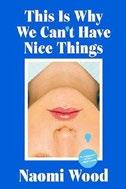
A socially astute collection about the pleasures and perils of motherhood. Triangulating the roles that many women with children play—as mothers, wives, and professionals—these
stories smartly ask whether women can successfully pull off all three. In “Comorbidities,” winner of the BBC Short Story Prize, the narrator’s love for her children comes at the price of her fierce desire for her husband. When they finally do share an intimate moment, she almost cries, contemplating “how much [they] had both lost, the price [they] had paid.” In “Lesley, in Therapy,” a woman suffering from extreme postpartum depression cuts short her parental leave, only to realize that work isn’t the solution—not only because her job can’t lift her malaise, but also because of the absence of real structural support for mothers. When Lesley complains about her work load, which is supposed to be lighter after having a baby, the therapist leading her company’s Group Therapy for Returning Parents counsels her to “focus on the here and now, and what we can change.” “We all want to leave,” a woman in “A/A/A/A/” tells a friend who has just learned that her husband has left her for another woman. “No one wants to stay. But they’re the grand love affair, in the end. The kids.” While women bear the burden of family life in many of these stories—and some readers will surely experience PTSD reading “Flatten the Curve,” about parenting through the Covid-19 lockdown— they’re not saints. What’s true horror, wonders the pregnant director in “Dracula at the Movies” as she cruelly manipulates her star into a good performance—being the victim, or the perpetrator? While a few stories get bogged down by elaborate, slightly boring work situations, this is a deft account of the huge toll of trying to have everything.
A must-read for working mothers— for whom reading might be a luxury they can’t afford.



AWARD-WINNING PR FOR AUTHORS & PUBLISHERS MEDIA
TRADITIONAL AND ONLINE
CONTENT, INFLUENCER CAMPAIGNS & ADS
IN-PERSON AND HYBRID LIVESTREAMS
TRAILERS AND AUTHOR VIDEOS
DEVELOPMENT AND MANAGEMENT
“WILDBOUND TOOK THE NATIONAL BOOK CRITICS CIRCLE AWARDS TEAM FROM VIRTUAL PRODUCTION NEWBIES TO A SUPERB VIRTUAL AWARDS EVENT. WE'LL ALWAYS BE GRATEFUL TO OUR WILDBOUND ANGELS.”
JANE CIABATTARI, PRESIDENT OF NATIONAL BOOK CRITICS CIRCLE
“HOW CAN YOU CUT THROUGH THE NOISE OF THE CULTURE AND GET ATTENTION FOR DESERVING WORK? HIRE WILDBOUND, FOR STARTERS. THEY’VE GOT A LOT OF ARROWS IN THEIR QUIVER AND THEIR AIM IS TRUE.”
STEVE WASSERMAN, PUBLISHER OF HEYDAY
“WORKING WITH WILDBOUND IS A DREAM! THEY’VE TAKEN OUR BOOK FESTIVAL TO NEW HEIGHTS THROUGH EXTENSIVE PRESS COVERAGE AND LEADING EDGE
SOCIAL MEDIA STRATEGIES, NOT TO MENTION SNAZZY VIDEO PRODUCTION.”
CHERILYN PARSONS, FOUNDER OF BAY AREA BOOK FESTIVAL
The characters who tell these stories—and the performers who voice them—will stay with you.
BY CONNIE OGLE
PERCIVAL EVERETT’S
reimagining of Adventures of Huckleberry Finn has already been praised as one of the best novels of 2024. That it’s one of the best audiobooks of the year should come as no surprise, either.
Like Mark Twain’s classic, James (Random House Audio, 7 hours and 49 minutes) is driven by a strong voice, the sheer force of its narrator propelling the action, in which a runaway boy and a runaway enslaved man embark on adventures along the Mississippi River. Dominic Hoffman, who you may recognize from the audio versions of James McBride’s Deacon King Kong and The Heaven & Earth Grocery
Store, embodies the depth and intelligence of Everett’s protagonist. Told from his thoughtful perspective, the story takes on a new and intriguing light and is all the more compelling for it.
One of Everett’s recurring themes concerns the power of language—how it can be deployed as a weapon or a shield, a survival strategy or an act of trust. James and other enslaved people speak one placating dialect to whites and a more elegant language with each other, a distinction that Hoffman’s deft performance underscores and elevates.
Narrator Shayna Small reads most of Essie Chambers’ Swift River (Simon &
Schuster, 10 hours and 17 minutes), a story of identity, family, and racism in the 1980s. Diamond, an overweight biracial teen whose father vanished when she was a child, feels both isolated and uncomfortably conspicuous in her all-white New England town. When her mother decides to have her father declared legally dead, one of his relatives reaches out to Diamond, who begins to learn the truth about the Black family she’s never met.
Janina Edwards and Robin Miles voice the family members guiding Diamond to a new understanding of herself and her past. Small, however, carries the production, reflecting Diamond’s youthful angst and frustration with her mother, whose cloying, clingy warbling grates on the listener in precisely the same way it frustrates her daughter. This clever trick may seem annoying at first, but the listener’s cringes and impatience mimic Diamond’s own reactions, investing them firmly in her future.

Irish author Kevin Barry ’s ribald Western The Heart in Winter (Random House Audio, 5 hours and 54 minutes), his first novel set in America, begins in the debauched mining town of

Butte, Montana in 1891. An opium-fogged poet and the new bride of the pit boss fall in love and run away together, desperate to outrun fate and a gun-brandishing posse to start over in San Francisco. Barry, who reads the book himself, delivers a dazzling, award-worthy performance, alternately funny and fierce, his pitch-perfect narration revealing the story’s profane beauty, sharp humor, and profound tragicomedy.
Actor Éanna Hardwicke— from the TV series based on Sally Rooney’s Normal People— reads the author’s Intermezzo (Macmillan Audio, 16 hours and 29 minutes), in which two Irish brothers—one a lawyer, the other a competitive chess player—come to terms with their father’s death and their own messy romantic lives. Though it blossoms into a remarkable character study, the novel starts slowly. But Hardwicke’s steady, nuanced performance is enticing, demanding patience as Rooney expertly fleshes out her complicated brothers to examine the universal conflict between society’s expectations and our own fragile hopes and desires.
Connie Ogle is a writer in Florida.

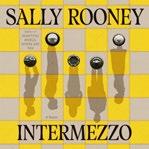

The Irish comedian’s Frankie will be published in the U.S. by HarperVia.
Graham Norton’s latest novel is coming to the U.S. next year.
HarperVia will publish the Irish comedian and talk show host’s Frankie in the winter, the press announced in a news release. It calls the book “a heartwarming and decades-spanning story about love, bravery, and the quest for a meaningful life.”
Norton began his career as a comedian, known for his television appearances on shows including Carnal Knowledge and Father Ted before landing his own series, So Graham Norton, in 1998. He went on to host V Graham Norton and The Graham Norton Effect, and now hosts The Graham Norton Show, which has aired since 2007.
He made his literary debut in 2004 with the memoir So Me, and published his first novel, Holding, in 2016. A critic for Kirkus praised the latter book as “a bright, quick-paced novel, especially inviting because of its tongue-incheek wit.”
Frankie follows an older woman who forms a friendship with a young caretaker who visits her after she is injured in a fall.
“This latest work solidifies Norton’s stature as one of today’s most compassionate and incisive novelists,” HarperVia says. “His storytelling prowess shines through in this deeply emotional and engaging narrative.”

Frankie is scheduled for publication on Jan. 14, 2025.
—M.S.




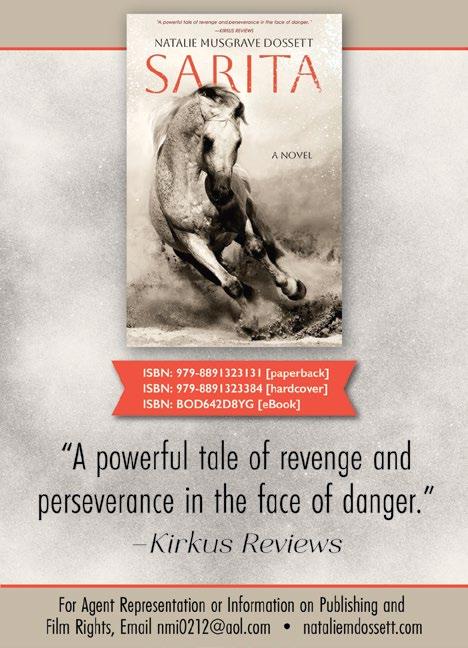


The author was known for novels including The General’s Daughter and Plum Island. Nelson DeMille, the author known for his bestselling suspense and adventure novels, has died at 81, Newsday reports.
DeMille, a New York City native, was raised on Long Island and educated at Hofstra University. He joined the U.S. Army in 1966 and served in Vietnam, where he earned a Bronze Star.
He made his literary debut in 1974 with the novel The Sniper, which introduced Joe Ryker, a tough New York police detective; the character would return in several more novels, including The Hammer of God and The Night of the Phoenix.
DeMille was known for his series of books featuring U.S. Army investigator Paul Brenner, whom he introduced in the 1992 novel The General’s Daughter, which was

adapted into a 1999 film starring John Travolta. He also published several novels with the character John Corey, a retired New York detective; that series debuted in 1997 with Plum Island. His most recent book, Blood Lines , co-written with his son Alex DeMille, was published last year.
DeMille’s admirers paid tribute to him on social media. On the platform X, author Harlan Coben wrote, “Mentor, colleague, literary hero, war veteran, icon, raconteur—Nelson Demille was always the best company and the coolest guy in every room. I will miss you always, old friend.”—M.S.
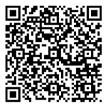
For a review of The General’s Daughter, visit Kirkus online.
A promising debut for a sleuthing pair who go at it hammer and tongs.
THE LOOSE END
In the Blink of a Pie
Bruns, Catherine | Poisoned Pen (312 pp.) | $8.99 paper
Oct. 22, 2024 | 9781728253992

Murder threatens a maple farmer’s newfound equilibrium. Life finally seems in balance for Leila Khoury. Although she still misses her murdered father, she’s improved her relationship with her mother, Selma, who now admits that she may have favored Leila’s younger brother, Simon, in the past. But Leila’s able stewardship of Sappy Endings, the maple farm and syrup business her father left the family, helps mother and daughter reconcile. Now Sappy Endings is so successful that they need another employee to help out in the farm’s cafe. But the same day Leila hires Jenna Fleming away from The Bagel Place, disaster strikes. The Khourys’ meddling neighbor, Margaret Middleton, sneaks a sample of a maple pumpkin pie that was supposed to be tasted first by the three judges at the inaugural Sappy Endings pie-baking contest. Pushy Margaret quickly falls down dead, and sales plummet nearly as promptly among locals who blame Sappy Endings for her death. To add to Leila’s stress, her college roommate, Taylor Hudson, surfaces to relitigate her grudge against Leila, who turned her in for cheating. Even Leila’s relationship with Noah Rivers, who runs the sugaring operations at Sappy Endings, hits a bump when his daughter, Emma, objects to their plan to combine
households. But Sappy Endings is her first priority. Knowing that nothing will bring back business but solving the murder, Leila throws herself into unmasking Margaret’s killer and saving her dad’s legacy. Although the solution is obvious, Bruns’ tale is good-natured enough for a happy—if, well, sappy—ending.
Cross, A.J. | Severn House (240 pp.)
$29.99 | Nov. 5, 2024 | 9781448314744
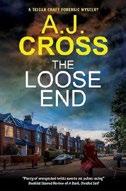
The discovery of mummified remains in a house under renovation triggers a new investigation into old crimes and brings together a most unusual detective duo.
The West Midlands Police are short of personnel, so DCI Steve Thompson reluctantly accepts the suggestion of his boss, Supt. Graham Holdsworth, that he team up with Prof. Teigan Craft, a researcher in forensic psychology at Central University, to solve the murder of Emma Matheson, the middle-aged estate agent who was strangled and hidden in her residence at 3 Forrest Road, Birmingham. In no time at all, Craft has linked the murder to two other assaults on younger women in the area shortly afterwards, only one of whom survived and is in no condition to testify about it. None of this is good news for Thompson, who likes his cases straightforward and tidy. But he gets nowhere when he tries to curtail the
inquiries of the neurodivergent Craft, who insists that the cases are connected, demands access to the crime scene, and persuades Thompson to join her on an expedition that discloses the remains of yet another victim. With the help of police data analyst David Brown, Craft, whose domestic life is just as messy as her professional life, painstakingly constructs a portrait of the killer and toils to secure fresh evidence. When Holdsworth announces that she and Thompson have only a week to make an arrest before they’re taken off the case, it’s no surprise who identifies the culprit and sets a trap for him—nor is his identity much of a surprise, either.
A promising debut for a sleuthing pair who go at it hammer and tongs.
Erickson, Alex | Kensington (304 pp.) | $8.99 paper Nov. 26, 2024 | 9781496745521

Yet another murder game turns into the real thing. Several teams of Pine Hills, Ohio, residents are working to solve a fake murder that’s part of an event directed by Oliver Quick. One of the teams includes a real police detective, John Buchannan; another includes coffee shop owner Krissy Hancock, who’s already solved several murders, much to Buchannan’s annoyance. Originally, Oliver was going to use local actors for the game, but then he changed his mind and imported professionals, a decision that’s led to bad feelings. When Scott, a member of one of the other teams, is found dead by Krissy’s group, the game quickly gets serious. Krissy is warned off by Buchannan and her own boyfriend, Paul. He’s also a police officer, but he knows that Krissy’s curiosity won’t let her walk away, especially once she’s egged on
by the friends who’ve helped her in other cases. The self-absorbed Oliver has no problem using the murder to boost his event, and many of the actors don’t want to make waves because they need the work. Krissy has faith that looking into the complex relationships among the actors and members of the detective teams will help reveal a killer, but she’s tested by all the players who lie about their own relationships for reasons utterly unrelated to Scott’s death. Krissy’s sleuthing puts her in danger, and a reporter highlighting her past successes makes her life even more difficult. Despite it all, tidbits of information come together little by little, pointing her in the right direction.
The amateur detective’s irresistible need to investigate drives a story with plenty of red herrings. Maybe too many.
Frost, Jacqueline | Crooked Lane (288 pp.)
$30.99 | Nov. 12, 2024 | 9781639109067

It’s Christmas: Time for another murder in Mistletoe, Maine. Holly White, who works at her family’s Reindeer Games tree farm, loves all things Christmas— except having to help solve those pesky murders all the time. This year, the charming town is decked out in a Victorian theme and visitors are arriving in droves, planning to sample everything that makes up the Christmas spirit and watch Holly’s mother bake a gingerbread man she hopes will set a new world record for size. Special invited guests include Violet Snow and her son, Elijah, two members of Mistletoe’s founding family, who are staying at the Reindeer Games Inn that Holly manages. The town still wonders why the Snows abruptly left Mistletoe decades ago, but mother and son aren’t talking. Soon after having an
A deep dive into the characters’ lives brings depth to a puzzling mystery.
THE HERRINGBONE HARBOR MYSTERY
argument with longtime resident Henry Moore, Elijah is found dead on Holly’s mother’s cookie sheet, covered in gingerbread dough. Two obnoxious podcasters who combine true crime with baking are delighted to be in town for yet another Christmas murder. Holly’s husband, Sheriff Evan Gray, hates seeing her involved in crime-solving, but is well aware of her inability to ignore problems. Although Moore has some kind of past with the Snow family and is obsessed with Mistletoe, Holly doesn’t think he murdered Elijah. With some help from her crew of good friends, she starts looking for a motive that may lie buried in the past.
A delightfully quirky group of Christmas- smitten sleuths add joy to a middling mystery.
Goldenbaum, Sally | Kensington (352 pp.) $27.00 | Nov. 26, 2024 | 9781496747181
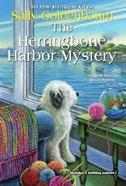
Four friends continue their habit of bringing murderers to justice.
Wealthy widow Birdie Favazza, lobster company owner Cass Halloran Brandley, yarn studio owner Izzy Chambers Perry, and Izzy’s aunt Nell Endicott form a close circle of amateur sleuths in Sea Harbor, Massachusetts. When Squid, the frightened dog of well-regarded business owner Nick Cabot, turns up at the home of Birdie’s teenage
granddaughter, Gabby, who runs a dog-walking business, Gabby knows something bad has happened. Nick is widely beloved in Sea Harbor, and plenty of people have been encouraging him to run against longtime mayor Beatrice Scaglia, whose announcement that she’ll never let that happen gives her an obvious motive when Nick is found shot dead in the burned ruins of his house. In addition to Beatrice, there are other people who didn’t like Nick. Bobby Palazola, the chef at Gracie Santos’ Lazy Lobster and Soup Café, had a sterling reputation as a Boston chef and blames Nick for the bad reviews he’s been getting. And Gracie and Cass are wary of Marco Costa, who works part time helping Bobby buy fish. Marco used to work for Cass, who didn’t trust him, and he overheard the two women asking Nick about him, since the men were neighbors. Slowly, the four women, who— except for Izzy—were born and brought up in Sea Harbor and are related to many of its residents, begin to gather tidbits of information they eventually shuffle into a pattern that will uncover the killer. A deep dive into the characters’ lives and relationships brings depth to a puzzling mystery.

Hannah, Darci | Kensington (368 pp.)
$8.99 paper | Nov. 26, 2024 | 9781496747402
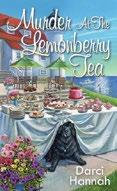
M ichigan townsfolk eagerly anticipate cooking-related events that turn out to include murder.
Lindsey Bakewell and her dog, Wellington, left New York to open a bakery in Beacon Harbor, where Lindsey has acquired a boyfriend, hunky former Navy Seal Rory Campbell, and a high-maintenance best friend, beautiful Englishwoman Kennedy Kapoor, whose former beau, police officer Tuck McAllister, is still madly in love with her even after having been relegated to friend status. On a visit to town, Kennedy’s grandmother, mother, and sister are staying in Lindsey’s lighthouse home, keeping her busier than a bee. Plus, she’s making an appearance on a British cooking show, Nibbles From Across the Pond , that’s about to film in Beacon Harbor. Kennedy’s mother is thrilled to meet the show’s host, Vivi Lemonberry, even though her past is a bit checkered. The filming gets off to an unfortunate start when the ever-friendly Wellington tries to befriend Vivi, who’s terrified of dogs. Then Vivi makes a pass at Rory, seemingly takes pictures of Lindsey’s recipes while teaching her to make a Bakewell Tart, and gets slapped in the face by rival cookbook author Gretta Gardiner. Vivi doesn’t show up for a planned tea party, and when Lindsey goes for a scuba diving lesson with Rory the next day, she’s horrified to find Vivi dead in the water, her hands tied with a dog leash and a tennis ball in her mouth. Apparently, someone’s framing Lindsey, but once the police, Lindsey, and her friends dig into Vivi’s background, they turn up oodles of motives. Now, they
just have to figure out which is the right one. Charming characters combine with tempting recipes in a mystery that’s perfect for food lovers.
Lupica, Mike | Putnam (352 pp.)
$30.00 | Nov. 26, 2024 | 9780593716137

Boston’s gift to the private-eye pantheon is thrust into a case that’s far too personal for his liking.
Defense attorney Rita Fiore has come on to Spenser in lots of ways over the years, but never before by getting shot. As she takes two steps forward and one back at Mass General, Spenser and his wingman, Hawk—aided willingly by the police and a lot less willingly by everyone else— look for a motive for her drive-by shooting. The most likely suspect is Shannon Miles, the TV news anchor whose sexual harassment suit against co-anchor Brian Tully was shot down once Rita took Tully’s case. But Spenser, looking beyond the obvious, focuses on Rita’s clandestine relationship with Nicholas Drummond, whose meteoric rise as the boy wonder of the state Senate was cut short by his accidental drowning off Castle Island in South Boston last September, before the record snowfalls began. Or was it really accidental? Digging into Drummond’s activities as Senate
president, Spenser zeroes in on a high-stakes competition between kingpin developers Kevin McManus and Thomas Mauro for a parcel of land in South Boston they both have big plans for (McManus’ plans in particular will make Beantown readers gasp).
When Tully is killed and Shannon Miles shoots an intruder who escapes from her home, Spenser concludes that the mystery must run even deeper. As psychiatrist Susan Silverman, no fan of Rita’s, tells her longtime lover: “The whole thing is a hot mess, isn’t it?... And Rita being shot is just one part of it and you’re trying to figure out how big a part.”
Though the premise is punchier than the payoff, fans of the series won’t complain.
Malliet, G.M. | Severn House (240 pp.)
$29.99 | Nov. 5, 2024 | 9781448314720
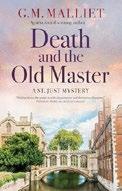
A violent death rocks the fictitious Hardwick College, surely the last outpost in Cambridge University to be visited by homicide.
Going to investigate an untoward shriek, night porter Oliver Staunton finds Sir Flyte Rascallian, the master of the college, stabbed in the back. Given the inveterate envy characteristic of so many academics, it’s possible that the motive for his killing was the eagerness that Prof. Patricia Beadle-Batsford, of the Department of Women’s Studies,
Michigan townsfolk eagerly anticipate cooking-related events that turn out to include murder.
MURDER AT THE LEMONBERRY TEA
Osler puts a queer 19th-century spin on a familiar tough-gal type.
has expressed to succeed him in his August position. It seems more likely, though, that he was really killed because of another old master: Rembrandt, who may just have painted the portrait of a young woman that was among the canvases and papers Sir Flyte was given by Beatrice Rascallian, his uncle’s widow, shortly before she died. DCI Arthur St. Just, returning for another investigation, is clearly in no hurry to close the case, and the unruffled pace of his investigation gives the killer time to claim another victim, narrowing the little pool of suspects even further. Was the master killed by Beadle-Batsford; by her teenage daughter, Peyton; by the American graduate student Rufus Penn, whom Peyton insists is her boyfriend; by gallery owner Ambrose Nussknacker, who’d shown a keen interest in having the suspect Rembrandt tested to establish authenticity; or by one of the other Hardwick porters? The question is upstaged by the fact that the mysterious painting has disappeared. Malliet works conscientiously to distribute suspicion among the survivors, but none of them is half as interesting as that portrait.
Lots of potential conflicts, but they’re as soft-pedaled as the background music at a funeral parlor.

Osler, Rob | Kensington (320 pp.)
$27.00 | Dec. 24, 2024 | 9781496749482
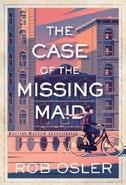
In 1898, a female detective proves she’s no lady while investigating a case that takes her from wealthy to seedy areas of Chicago. Bold and ambitious, Miss Harriet Morrow has wrangled herself a position as the first female field operative for the Prescott Detective Agency, quite an experiment for agency principal Theodore Prescott. Maybe it’s her ankles, which Prescott deemed “thick and sturdy” in her interview, but Harriet just isn’t built like other women in the late 1890s, starting but not ending with her interest in a nontraditional role. She’s determined to make good by finding Agnes Wozniak, the live-in maid to idiosyncratic widow Pearl Bartlett. On her initial visit to Agnes’ quarters in Pearl’s stately Italianate home, Harriet sees that the room has been tossed and a window left open, turning the disappearance into a likely kidnapping. The only agency colleague who helps Harriet track down any leads is Matthew McCabe, whose friendliness extends to acquainting Harriet with the right end of the gun—the one where she’s doing the shooting, at least during practice. Learning marksmanship doesn’t make Harriet feel any safer, for her investigation brings her to unfriendly neighborhoods whose
unsavory denizens she’s certain would have made off with the pretty young maid if given the chance. She does find an ally in Agnes’ older sister, Barbara, who seems almost as eager to impress as Harriet is. As she feels herself making headway, a saboteur starts working against her. Her time to find Agnes is limited not only by safety concerns but by her need to prove herself as a woman detective in her first case.
Osler puts a queer 19th-century spin on a familiar tough-gal type.
Penney, Elizabeth | Minotaur (288 pp.) $9.99 paper | Nov. 26, 2024 | 9781250344137
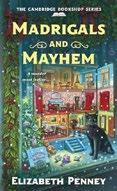
Christmas in Cambridge is a new experience for American Molly Kimball, though murder is not.
Molly and her widowed mother have moved to England to help her great-aunt run the family’s 400-year-old bookstore. Molly— who’s already made friends, acquired a delightful boyfriend from an aristocratic family, and helped solve several mysteries—now meets and befriends Charlotte Pemberly, who’s just inherited a wonderful toy store from her grandfather, much to the dismay of his thrice-married widow, Althea, and her family. When Charlotte gives Molly a tour of the shop, they discover Barnaby—her grandfather’s step-grandson— deathly ill and call for an ambulance, narrowly saving his life. Then his sister Tori shows up, followed by the police, who are suspicious about some cakes he’d eaten at the store and suggest that Molly’s best friend, bakery owner Daisy, may have made them. Daisy says the box is hers but the cakes definitely aren’t, since she would never use blue frosting. Considering the family feud, Charlotte looks like
While Prose tips her hat to “The Gift of the Magi,” she brings original plot points to the Christmas table.
THE MISTLETOE MYSTERY
a suspect, but Molly thinks it’s more likely she was the target of the poisoned cakes—after all, they were left in her shop. When Charlotte asks for help, Molly is more than willing to try solving the mystery. She meets Charlotte’s awful step-family and their friends, even joining her boyfriend to sing in a play Althea is staging. It will take a lot of luck to find the answer before Charlotte becomes the next victim. A complex mystery featuring the historic charms of Cambridge and a likable, clever sleuth.
Prose, Nita | Ballantine (128 pp.)
$22.00 | Oct. 1, 2024 | 9780593875445
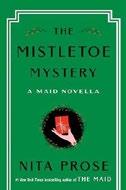
T his (ultimately) merry little Christmas novella finds Molly Gray, star of the Maid mystery series, harboring yuletide suspicions.
It’s almost Christmas, and narrator Molly, head maid at the Regency Grand Hotel—geographic location unspecified—is initially enjoying the holiday ramp-up with Juan Manuel, her equally cashstrapped live-in boyfriend and the hotel’s pastry chef: They’ve purchased a Charlie Brown Christmas tree, he’s stocked their reusable Advent calendar with gewgaws, and so on. But Molly is put off her eggnog when a hot blond living in their apartment
building knocks at their door, seeking help unclogging her toilet.
“Juan seemed to know her,” Molly thinks. “In fact, she seemed familiar with him, too. But how can that be if she recently moved into the building?” Molly tracks what she considers other examples of Juan’s suspicious behavior as she counts down the days to the hotel staff holiday party, where she hopes not to relive a past Secret Santa–related drama. Readers’ appreciation for this novella will depend on their tolerance for sentimentality and their patience with protagonists who can’t see what’s right in front of them. Some of Molly’s muddlement is explained away by her long-standing problem reading social cues—“Little Miss Literal,” a colleague dubs her— which Prose handles with unshowy sensitivity. Perhaps inadvertently, and certainly endearingly, Molly recalls another frequently befogged maid of letters: Amelia Bedelia.
While Prose tips her Santa hat to “The Gift of the Magi,” O. Henry’s holiday classic likewise centered on two frugal young lovers, she brings original plot points to the Christmas table.
Tailor-made for the cozy-mystery lover’s Christmas stocking.

Ripley, Mike | Severn House (272 pp.)
$29.99 | Nov. 5, 2024 | 9781448314713
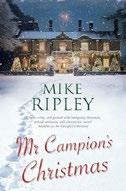
As Ripley’s bittersweet closing note makes clear, his 12th addition to the decorous chronicles of Margery Allingham’s beloved English sleuth will be his last.
It’s also a good deal less decorous than most of the others. The day after Christmas 1962 finds a severe snowstorm barreling toward Carterers, the Norfolk home to Albert Campion and his wife, aeronautical engineer Lady Amanda Fitton. Also headed their way is a bus thrown so far behind schedule by the blizzard that three American Air Force officers aboard it suggest to driver Graham Fisk that he diverge from his ordained path to seek the nearest town. En route, the bus plows into the entry gate to Carterers, where the passengers seek refuge. No sooner have Campion and Amanda surveyed the crowd—retired vicar Elis Breck, Dutch art dealer Fred De Vries, Devon postmistress Florence Pounder, Professor Hereward Henderson, and those Americans—than the phone lines go dead and they realize that this Boxing Day will be unique. Things get worse when one of the new arrivals is found dead, and worse still when Campion learns that not all of his unwilling guests are who they pretend to be. At least one of them, in fact, is a Russian agent plotting a most improbable revenge for the Soviet Union’s recent embarrassment over the Cuban missile crisis. So, what starts as a Christmas cozy, with a snowstorm sealing off the playing field from the rest of the world, turns into a game of cat-andmouse between a group of strangers seeking to rally their very different gifts behind a common
cause and a well-armed enemy who’ll stop at nothing. A surprisingly lively adventure that belies its heroine’s ironic summary: “Sounds like a traditional Christmas to me.”
Wegert, Tessa | Severn House (256 pp.) $29.99 | Nov. 5, 2024 | 9781448314232
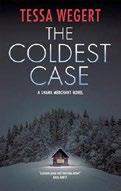
Though there’s stiff competition for which unsolved mystery (Edwin Drood? Jack the Ripper?) really is the coldest case, Wegert’s latest is a definite contender in more ways than one.
Four years ago, Shana Merchant and her NYPD partner, Dave Johansson, worked overtime to identify a Jane Doe fished out of the East River whose facial scar echoed the one Shana had received at the hands of her murderous cousin, Blake Bram. They never succeeded, and Shana moved on, taking a job with the state police’s Troop D, posted near the Thousand Islands. Now she’s called out in the hope that she can traipse through the omnipresent snow and find Cary Caufield, a graphic designer and online influencer whose absence makes quite a stir among his neighbors because he constitutes one-eighth of the population of the tiny island of Running Pine. Sylvie Lavoy, Cary’s girlfriend and partner in the
Instagram account Running Wild, manages to be both frantic and unhelpful, and Tim Wellington, Shana’s “partner in every way,” offers limited help himself before he goes missing, too. Wegert will put readers through endless flashbacks to the Jane Doe investigation, tales of the legendary misdeeds of the island’s founders, rumors of a lost treasure that would provide a compelling motive for murder if it actually exists, and Shana’s endless handwringing over a cousin who clearly merits every shudder before she pulls the curtain aside to reveal not one, but two murderers whose identities will leave most readers gasping— and not from cold. Whatever the opposite of comfort food is, Wegert dishes out a heaping portion.
Williams, Beatriz, Lauren Willig & Karen White | Morrow/HarperCollins (416 pp.)
$30.00 | Nov. 5, 2024 | 9780063259867

After the murder of a literary superstar at a writing conference in remote Scotland, three American authors join forces to clear their names and uncover a killer. It will be clear to readers from the very first pages that, despite claiming to be best friends, Cassie Pringle, Emma Endicott, and Kat de Noir do not get along. Cassie is
After the murder of a literary superstar at a conference in Scotland, three American authors join forces to clear their names.
THE
AUTHOR’S GUIDE TO MURDER
a mother of six who writes cozy mysteries in her free time; Emma is a blue-blooded New Englander who specializes in historical fiction; and Kat writes erotic urban fantasy novels. Nonetheless, they manage to convince their agent to let them write a book together and foot the bill for them to travel to a conference at Kinloch Castle hosted by Brett Saffron Presley, the internationally bestselling author—and “spokesperson for the famous Presley How-to-Write-a-Novel software”— who owns the castle. When Brett is murdered and his body is found high in Kinloch’s tower, it falls to Detective Chief Inspector Euan Macintosh to interrogate the castle’s occupants, including Cassie, Emma, and Kat. While Euan can’t stand the American novelists—or Americans in general—it becomes quickly evident that they might be his only chance at finding out who killed Brett and why. The problem is that none of their stories about what brought them to the castle seem to line up. While three authors collaborating on a book about three authors writing a book together feels fresh and charming at first, especially as each chapter changes point-of-view, the writing is uneven and the plot disjointed. The result feels less like satire and more like secondhand embarrassment as Cassie, Emma, and Kat bumble their way through the Scottish countryside. A murder mystery that tries to be tongue-in-cheek but can’t quite pull it off.





EDITORS’ PICKS:
Our Wicked Histories by Amy Goldsmith (Delacorte)
The Dictionary Story by Oliver Jeffers & Sam Winston (Candlewick)
Mina’s Matchbox by Yoko Ogawa, trans. by Stephen Snyder (Pantheon)
THANKS TO OUR SPONSORS:
Zodiac Pets by Eric Giroux
Fun Things To See and Do on Uranus by Geoffrey Simmons, M.D.
Survival in the Land of Beasts by Ron Rasband
Fully Booked is produced by Cabel Adkins Audio and Megan Labrise.

To listen to the episode, visit Kirkus online.
In The Palace of Eros, Caro De Robertis shines a light on freedom and desire. BY
MEGAN LABRISE

On this episode of Fully Booked, Caro De Robertis discusses The Palace of Eros (Atria, Aug. 13), a retelling of the Greek myth of Psyche and Eros from the author of 2019 Kirkus Prize finalist, Cantoras. Kirkus calls their sexy, sumptuous new novel “a vulnerable, sensual, and joyous journey about living and loving in one’s truth.”
De Robertis is an award-winning writer and literary translator whose honors include two Stonewall Book Awards and a National Endowment for the Arts fellowship. They are the author of six novels, including The Gods of Tango and The President and the Frog, and the editor of Radical Hope: Letters of Love and Dissent in Dangerous Times. Their work has been translated into 18 languages. They teach at San Francisco State University and live in Oakland, California, with their two children.
Here’s a bit more from our review of The Palace of Eros: “Psyche, the youngest of three daughters, is wild, loud, and uninterested in taking a suitor. As tales of her beauty spread through the kingdom, crowds of leering men begin to flock to her home to see if the rumors are true: Could Psyche really be more beautiful and interesting than Aphrodite, the goddess of love and beauty? Furious and jealous, Aphrodite asks her daughter Eros, who reigns over love and desire, to destroy Psyche.…Instead, Psyche is carried to a palace beyond her wildest dreams. Created by Eros, who has fallen for this human girl, the beautiful and bountiful home is shrouded in secrecy from gods, goddesses, and humans alike. Within the palace, they can be together—as husband and wife (or something in between)—just so long as they are always cloaked in total darkness. As Psyche realizes all the ways her dream home still falls short, she makes a decision that changes the trajectory of their lives—and the mythical
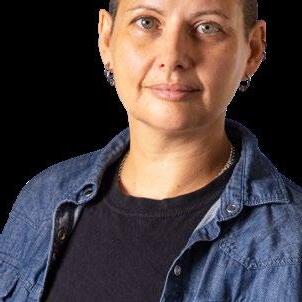

The Palace of Eros
De Robertis, Caro Atria | 320 pp. | $28.99 Aug. 13, 2024 | 781668035238
world—forever.…De Robertis’ prose is as sharp and beautiful as ever. Their meditations on gender, desire, and freedom soar off the page. The author’s retelling provides a space to dream of a world where those ‘born perfect yet outside the rules’ of their time may find ways to step out of the shadows and into the light.”
De Robertis shares the story of the Greek myth of Psyche and Eros, how they first encountered it, and why they’ve been obsessed ever since. They point out that The Palace of Eros is their first novel that’s not set in their countries of origin, exploring actual histories; nevertheless, it shares a few key themes with the rest of their work. They read aloud from the first page of the book, and we discuss how they thought about time in this retelling. We acknowledge the time it takes to identify and claim one’s desires; how Romans call Eros Cupid in their myth; whether this felt like a risky book for them to write; advice to queer writers working on sex scenes, and much more. Then the editors share their top picks in books for the week.
Editor-at-large Megan Labrise hosts the Fully Booked podcast.
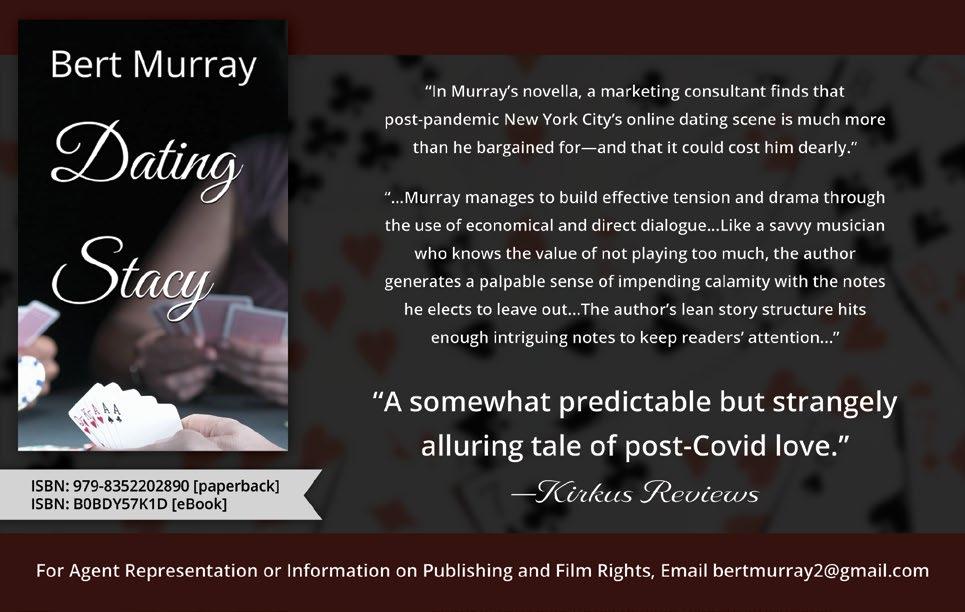
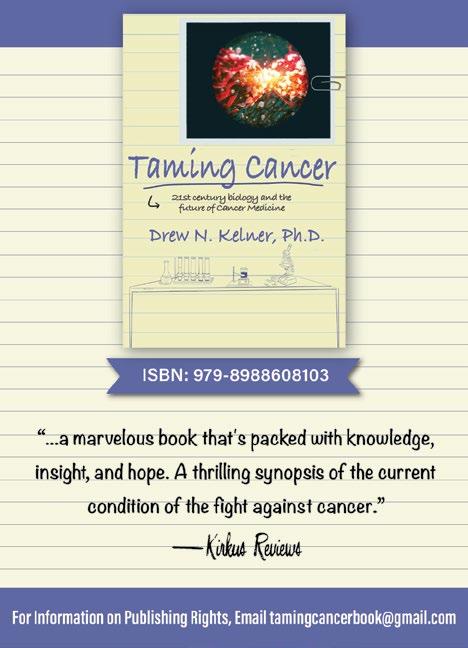

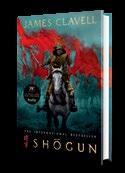
The FX series, based on James Clavell’s novel, is the most awarded show in a single season in Emmys history.
The FX adaptation of James Clavell’s Shōgun took home four Primetime Emmy Awards
and 14 Creative Arts Emmys at this year’s ceremonies. Its 18 trophies make it the most awarded show in a single season in Emmys history.
The Primetime Emmys honor television acting, writing, and directing, while the Creative Arts Emmys are given in technical categories, as well as a few artistic categories.
Shōgun, which takes place in Japan at the dawn of the 17th century, won the Emmy for outstanding drama series, becoming the first Japanese-language series to do so. Anna Sawai took home the lead actress in a drama series prize for her role as

Toda Mariko, while Hiroyuki Sanada was awarded the lead actor in a drama trophy for his performance as Yoshii Toranaga.
Frederick E.O. Toye won the Emmy for directing a drama series for the episode

“Crimson Sky.” The series previously won in categories including casting, costuming, hairstyling, and editing.
Ripley, the miniseries based on Patricia Highsmith’s novel The Talented Mr. Ripley, won one Primetime Emmy, for Steven Zaillian in the directing for a limited or anthology series or movie category. It previously won three Creative Arts Emmys.—M.S.
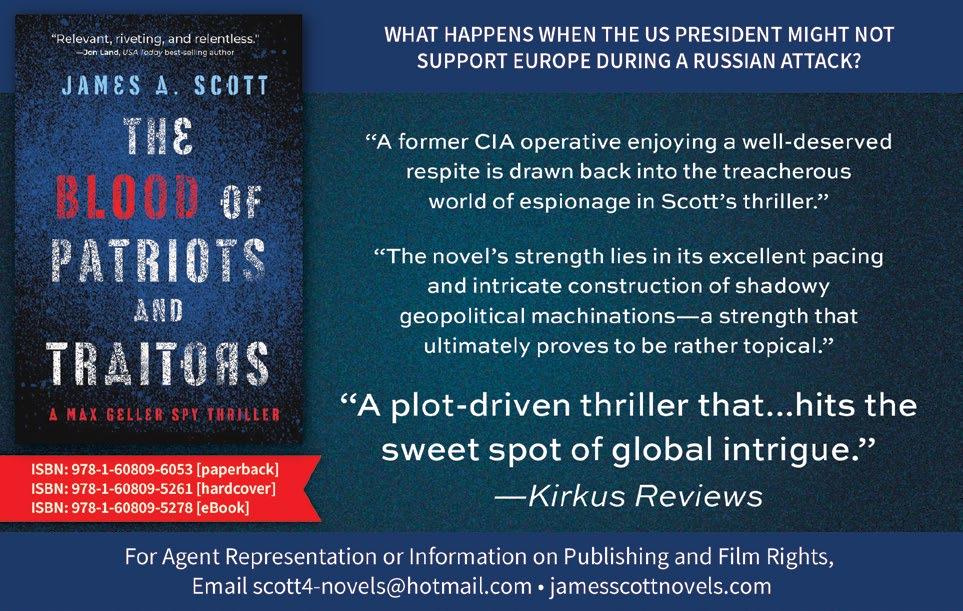
Eden, Lucy | Forever (368 pp.) | $17.99 paper | Nov. 12, 2024 | 9781538756973

A publicist inherits her estranged grandparents’ farm—and discovers that the town’s residents are hiding a big secret.
Emmaline Walters is a high-powered publicist in Atlanta— or she was, until one mistake leads her boss to fire her. On the same day, she breaks up with her longterm boyfriend, a budding politician. She’s jobless and adrift, but there’s one saving grace: She just inherited a farm in rural Green Acres, Georgia. Emma hadn’t spoken to her grandparents in years because of drama between them and her mother, but they left her their charming farmhouse in an equally charming town. The town’s residents, however, are openly hostile to Emma—and Emma is almost too close for comfort to Danesh Pednekar, the farm’s manager, who lives in the attic of the farmhouse. This is the classic “big-city-girl-inherits-afarm” story that has inspired many a Hallmark movie, but Eden adds an interesting twist: The farm is growing medical marijuana, and the whole town’s ecosystem depends on the crop. Soon, Emma finds herself happily ensconced in the quirky world of Green Acres, and in an idyllic relationship with Dan. But when the farm comes under threat, Emma has to figure out how to save the place—and the people—she’s unexpectedly grown to love. Eden creates a cozy world in Green Acres, and although some plot lines aren’t explored as much as they could be (the resolution happens almost a little too easily), this small-town romance is still fun to read and features plenty of steamy scenes. A sweet and sexy romance, perfect for readers who want a Hallmark movie but with more spice.
Hall, Alexis | Montlake Romance (415 pp.)
$16.99 paper | Dec. 17, 2024 | 9781662509421
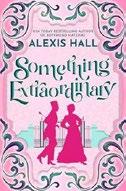
Two unconventional people try to avoid matrimony by…eloping.
Sir Horley Comewithers and Arabella Tarleton were good friends once upon a time, but life has taken them in opposite directions. Sir Horley, who is extravagantly gay but miserably in love with Belle’s (now taken) twin brother, spends his days thoroughly soused. Belle, who once dreamed of being a dashing heroine and now has no interest in adventure of any kind, feels abandoned by her friends and family. Even so, she still cares about Sir Horley enough to try to keep him from entering a loveless marriage. Unfortunately for both of them, he’s too drunk and miserable to listen to the reasons they should elope, and the only solution she can think of is to (technically) kidnap him and head to Gretna Green. This, of course, almost immediately goes pear-shaped. Though Sir Horley is both hungover and furious when he realizes what’s happening, he also realizes he has to see it through, lest Belle’s reputation be ruined. Their slow trek toward the Scottish border, while increasingly absurd, brings them closer with every screwball moment, though not in the way that romance readers will expect. That’s because once again, Hall has leveraged his trademark wit to nudge historical romance into new territory. For example, though the story includes multiple steamy intimate scenes, none of them are between the hero and heroine, which everyone involved is very happy about. Their separate sex lives do not detract from the development of true affection and love between Sir Horley and Belle, who lean into their unconventional future with aplomb, including Belle’s acceptance of herself as what we would now call aromantic. Fans of Something Fabulous (2022) and
Something Spectacular (2023) will be delighted to see these two make a life together, especially given how they came across earlier, and the book is best enjoyed in that context, though it can stand alone well enough. Though the pacing is a bit uneven, with great warmth, a good deal of silliness, and a touch of anachronistic language, this story succeeds across the board. A thoroughly queer and extraordinary historical romance.
Hall, Alexis | Sourcebooks Casablanca (512 pp.) $16.99 paper | Nov. 5, 2024 | 9781728251325

A former bully and his childhood victim meet again. Ever since Alfie Bell went south to London, he’s not felt quite comfortable “oop north” in South Shields. In fact, he doesn’t really feel comfortable anywhere, despite his career successes. Though closeted when he left, he’s now out to his friends and family, but still struggles to accept himself in many ways, and can’t shake the uncomfortable feeling that he no longer fits in anywhere. When he’s home for a wedding, his discomfort drives him to a small bar where he meets a stranger, Fen, who is antagonistic but still wants to go back to Alfie’s hotel for a one-night stand. It’s not until after their encounter that Alfie realizes he actually does know Fen—they went to school together and, back when Alfie was in the closet, he was one of the boys who’d bullied Fen mercilessly for years. Now, Fen says he just wanted to see “the school bully demonstrating what a good little cocksucker he’s grown into.” The revelation shocks Alfie out of the life he’s settled into, and he finds himself leaving his important job and friends in London to drive his fancy sports car back home and try to apologize so he can see Fen again. Despite his understandable
Two co-workers with nothing in common find themselves
A FIVE-LETTER WORD FOR LOVE
reservations, Fen has always daydreamed about Alfie and is curious enough to see whether he’s actually changed, so they begin spending much more time together, leading to some scorching-hot moments as well as many complicated emotions for both to work through. This is the fourth volume in Hall’s series of Spires stories, but it can be read as a standalone. Though this is a rerelease of a book Hall self-published in 2018, fans will be thrilled to revisit Fen and Alfie’s story, especially as Hall has annotated it throughout, sharing thoughts about the Northeast England setting, his intentions while writing the book (and how he reflects on them now), and how to write a Geordie accent. Though it’s likely not for readers who don’t care for former-bully-to-lover stories, any others looking for a steamy, emotionally driven contemporary romance will be delighted.
A compelling romance worth reading again, or for the first time.
James, Amy | Avon/HarperCollins (368 pp.)
$18.99 paper | Dec. 3, 2024 | 9780063399013

Two co-workers with seemingly nothing in common find themselves bonding over Wordle. Emily Evans has never known what she wants to do with her life. She’d like to find her dream job, something that will pay the bills and allow her to follow her greatest
passion—but she doesn’t seem to know what that passion is. In the meantime, she’s making ends meet by working as a receptionist at an auto repair shop, considering a move to the big city while stuck in her small town on Prince Edward Island. The only bright spot in her day is playing the New York Times ’ Wordle, on which she currently holds a streak of more than 300 days. Hoping to make it a full year without a single miss, she reaches a point of desperation one day when she finds herself stuck on the answer with only a single guess left. Asking her stoic, introverted coworker John Smith for help is a last resort, and she’s surprised to discover that someone she thought she didn’t have anything in common with is also a regular Wordle player. As Emily bonds with John over their shared hobby, she gradually gets to know the man she previously wrote off as standoffish and apathetic, while he starts to rethink his preconceived notions about her in return. James’ debut is a sweet small-town romance that revolves around Emily’s journey of self-discovery and personal improvement. Given that the book is told solely from Emily’s first-person perspective, it’s she who gains the most depth, with John an intermittent and inscrutable presence at first, before slowly becoming more dimensional over time. Strong supporting characters, including some elderly neighbors Emily befriends and cares for, add tenderness to the narrative. At the core of the book, however, lies Emily’s efforts to better understand herself and what she truly wants. Wordplay and romance collide in this charming debut.
Robinson, A.C. | 831 Stories (160 pp.)
$14.99 paper | Nov. 12, 2024 | 9798893310207
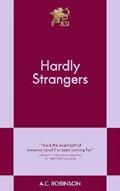
Sometimes it takes just one night to change everything. Shera Benoit finally feels ready to reenter the dating pool after her last relationship left her with insecurities and trust issues. She’s been eyeing Michael, a newcomer to the LA scene, for the past few months, and she finally asks him out despite red flags like his flightiness, self-involvement, and the way he asks her “So where are you from— originally ?”—a question the biracial Shera is used to getting, but “the framing…made [her] feel divorced from humanity.” When she gets to the bar where they’re supposed to meet, though, Michael shows up late, and it’s Irish punk band frontman Max King who makes her feel desired. She winds up going home with him instead, but starts second-guessing her decision pretty quickly. Max’s honesty and openness comfort her, though, and she allows herself to be vulnerable as they talk. As the late night turns to early morning, Shera and Max’s conversations and intimate moments lead them both to experience a rollercoaster of emotions, confront difficult pasts, and question deeply held beliefs. At first, readers might think they’re in for a fun, spicy romance, but this brief novel is really more of a close character study of two flawed people who evolve through their relationship as they learn not just about each other, but about themselves. Shera’s namesake is the storyteller Scheherazade from Arabian Nights, and this fits both with Shera’s aspirations as a writer and her captivating, poetic first-person narrative throughout the book. Some of the big emotional swings feel exaggerated, but they add necessary tension and conflict, and make the ending all the more satisfying. A thoughtful, introspection-filled, bite-sized romance.
The Lebanese author was known for novels including Little Mountain and Children of the Ghetto.
Elias Khoury, the Lebanese author known for his political novels and support of Palestine, has died at 76, the Associated Press reports.
Khoury was born and raised in Beirut and educated at the Lebanese University and the University of Paris. He fought and was injured in the Lebanese Civil War, later making his literary debut in 1975 with the novel On the Relations of the Circle , which he followed up two years later with Little Mountain . His other novels included The Journey of Little Gandhi, The Kingdom of Strangers , Yalo, Broken Mirrors , and the Children of the Ghetto trilogy. Humphrey Davies’ English translation of the second book in the series, Star of the Sea , will be published in the U.S. by Archipelago on Nov. 12. A reviewer for Kirkus called it a “powerful chronicle of the search for peace and identity amid constant disruption.”
Elias Khoury
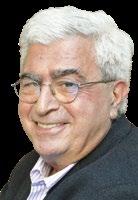

Khoury also worked as a journalist for several newspapers and magazines.
Khoury’s admirers paid tribute to him on social media. On the platform X, historian Lauren Banko wrote, “The loss of Elias Khoury is huge for the literary world, the Palestinian resistance, for storytelling, but his novels and words and his love for Palestine are forever.”
And writer Alina Stefanescu posted, “I just learned that Elias Khoury passed away today and there are no words for the grief that his voice should be taken from us.…Just shattering.”—M.S.
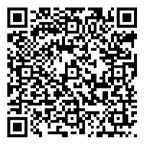



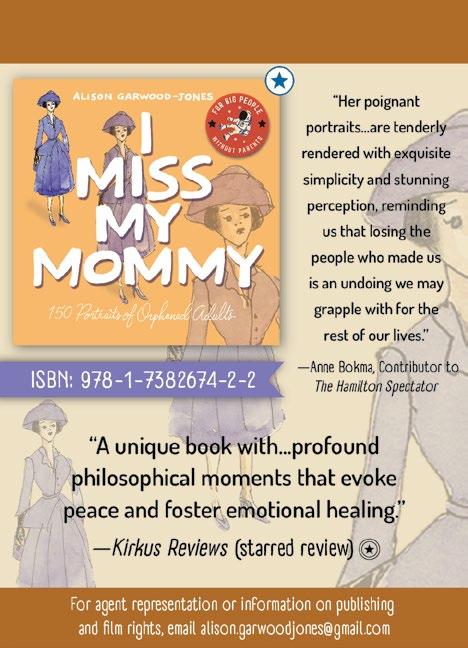

The actor played the lead role in the 2015 film adaptation of Colm Tóibín’s novel.
Saoirse Ronan has lent her voice to a new audiobook version of Colm Tóibín’s Brooklyn, Simon & Schuster Audio announced in a news release.
Tóibín’s novel, published in 2009 by Scribner, follows Eilis Lacey, an Irish woman who moves to New York for work and falls in love with plumber Tony Fiorello. She returns to Ireland after the death of her sister, and develops feelings for Jim Farrell, a man in her town whom she used to know.
The novel won a Costa Book Award and was longlisted for the Booker Prize. Tóibín published a sequel, Long Island, earlier this year; that

novel was an Oprah’s Book Club selection.
Ronan, the Americanborn Irish actor known for her roles in Lady Bird and Little Women, played Eilis in a 2015 film adaptation of Brooklyn, written by Nick Hornby and directed by John Crowley. She was nominated for an Academy Award and a Golden Globe for her performance in the movie.
“I have long been a big admirer of Saoirse Ronan’s work,” Tóibín said in a statement. “It is a tremendous gift that she has made this wonderful audio recording of my novel Brooklyn. She already graced the film with her great talent, her flawless performance. Now she has done more: She has made the words come alive with her voice.”
The new audiobook edition of Brooklyn was released on Oct. 22.—M.S.

Ingram Library
and Kirkus
are partnering to bring a RAW look at readers’ advisory!
Help your patrons CUT THE LINE with a curated list of readalikes for the books with the longest hold times across the country. In this series, you’ll hear from collection development professionals speaking about titles your patrons will love —but won’t have to wait for as well as hear from the authors of those books in a moderated panel hosted by Kirkus Reviews editors.

Sign up for the first webinar on Thursday, November 14th, 2024 @ 2 PM ET

Can’t make the date? Register and receive a link to the archived webinar after it airs! *Registrants will receive a Professional Development Certi cate for readers’ advisory participation.

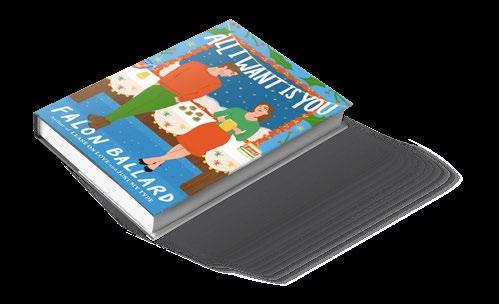
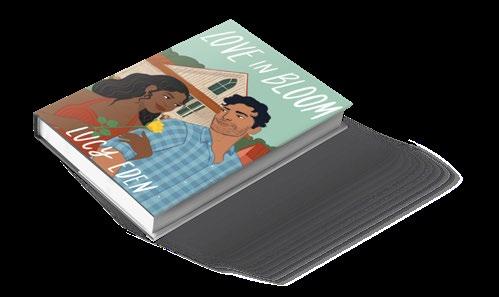
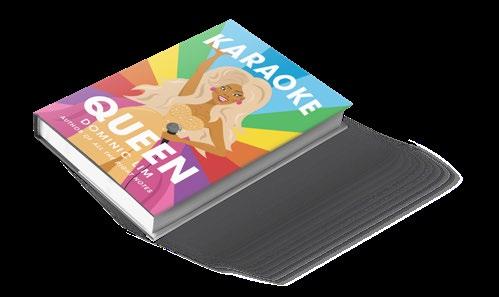



BILLIONS OF CICADAS emerge from underground every dozen-plus years, loudly making their presence known across the land to lure mates. Slightly fewer politicians come out of hiding to attract admirers, but they do so more frequently, often writing books every four years to sing their own praises. This election year is no exception. There have been memoirs by potential presidential candidates (Gretchen Whitmer’s True Gretch) and past contenders (Hillary Rodham Clinton’s Something Lost, Something Gained, published by Simon & Schuster on Sept. 17). Bill Clinton, for his part, is waiting until shortly after the Nov. 5 election to publish his latest book, Citizen: My Life After the White House (Knopf, Nov. 19).
Donald Trump first made a name for himself as a real estate developer in the 1980s with his bestseller The Art of the Deal. The lucrative approach continues apace: Within two months of surviving an assassination attempt in July, the Republican presidential candidate released a $99 photobook, Save America, whose instantly famous cover image shows its author’s face streaked in blood, his fist held high.
The former president is not the only Trump who has published a book this season: Melania , a memoir, came out within a few weeks of the election, on Oct. 8, and less favorable portraits of her husband were written by Trump’s nephew Fred Trump ( All in the Family) and his niece Mary L. Trump (Who Could Ever Love You).
Unflattering examinations of Trump, of course, haven’t been limited to relatives.
Two election-year titles stand out: Meridith McGraw’s Trump in Exile and Russ Buettner and Susanne Craig’s Lucky Loser: How Donald Trump Squandered His Father’s Fortune and Created the Illusion of Success
Bob Woodward, prolific as ever, is also in the mix. His most recent behind-thescenes book, War (Simon & Schuster, Oct. 15), homes in on Ukraine, the Middle East, and the presidential campaign.
It’s not just presidents and presidential contenders who are the subjects of political books this season. Michael Tackett, deputy Washington bureau chief for the Associated Press, has published a critical look at the U.S. Senate’s minority leader: The

McMURTRIE
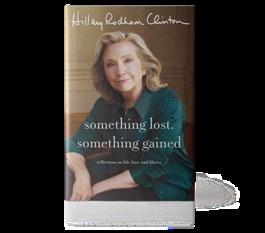
Price of Power: How Mitch McConnell Mastered the Senate, Changed America, and Lost His Party (Simon & Schuster, Oct. 29). McConnell’s congressional colleague, Nancy Pelosi, shares her own view of leadership in her memoir The Art of Power (Simon & Schuster, Aug. 6).
Will any of these books have a shelf life that goes beyond the election season? It remains to be seen, of course. But one acclaimed political biography may well stand the test of time. David Greenberg’s John Lewis: A Life (Simon & Schuster, Oct. 8) celebrates the late civil rights activist and “conscience of the Congress” in its 700 capacious pages.


As Greenberg writes of Lewis’ death in 2020, “In a summer when the names of statesmen were being stripped off buildings in penance for their racism and other imputed sins, Lewis was someone everyone wished to honor. For months to come, his name would be affixed to schools and centers, bridges and parks, streets and post offices, fellowships and awards.”
Other than a book, what more lasting physical tribute could there be?
John McMurtrie is the nonfiction editor.



Getting to know the more personal side of a prolific writer.
Sacks, the beloved late author, is best remembered for The Man Who Mistook His Wife for a Hat (1985), which collected a variety of tales that he had encountered in his clinical practice as a neurologist. In addition to more than a dozen books, he wrote numerous essays and articles, his work doing much to destigmatize mental illness and promote “patient-centered” medicine. Sacks was also a devoted writer of letters. Edgar, who was Sacks’ editor, researcher, and friend, notes that the archive of his
correspondence totaled roughly 200,000 pages (he kept copies of many of the letters he sent, and others were returned to his estate after Sacks’ death in 2015). The early chapters include letters to relatives and highlight his youthful travels and experiences; as he grows older he recounts his evolving thinking about his patients and their therapy. In his correspondence, he emphasizes the need to engage with patients and explore innovative therapies, including music and visual art. Sacks wrote to colleagues and friends as well as fans, often with a self-deprecating sense of humor. Along
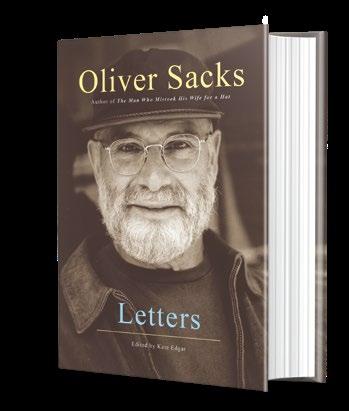
Sacks, Oliver; Ed. by Kate Edgar Knopf | 752 pp. | $40.00 Nov. 5, 2024 | 9780451492913
the way, he addresses his recurring depression and his addiction to amphetamines. Marshaling this mountain of words must have been a herculean task, but Edgar has managed to
compile a collection that is coherent and, most of all, very enjoyable.
A lifetime of correspondence adds new dimensions to a brilliant mind’s oeuvre.
Ali, Tariq | Verso (800 pp.) | $34.95 Nov. 5, 2024 | 9781804290903
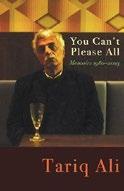
Novelist, filmmaker, and firebrand Ali delivers a second volume in his memoir series, following 2018’s Street Fighting Years
“These memoirs are centered on politics of one sort or another.” That’s an understatement, to be sure. Ali, a stalwart socialist, has never been shy of courting controversy. That’s true of this blend of autobiographical notes and gathered journalism and essays: toward the end of the book, for instance, in an essay on the horrific events of Oct. 7, 2023, he writes, “I don’t agree politically with Hamas.…But I do not and will not criticize them in public for defending Gaza.” Of course, one could dispute that the definition of “defending Gaza” includes the slaughter of peaceful concertgoers, but then one might argue with Ali at many points and still wind up learning a few things. In this, Ali resembles Christopher Hitchens, though even Hitchens might have waited a few days postmortem before lighting into the late Queen Elizabeth II (“The mainstream press of Europe wasting so much paper on the Windsors would do well to remember that the late queen was…a staunch supporter of Brexit, as revealed by Murdoch’s rag the Sun .” Whether Hitchens would take a swing at Ali for revealing that Margaret Thatcher once “affectionately spanked him” is unknowable, but it’s modestly amusing to learn that Ali, now in his
80s, is game to slap someone who gainsays his version of the cause. The doctrinaire stuff can be tiring, as can his dissecting the smallest of disagreements on the part of his fellow Fourth Internationalists. Still, Ali has always kept interesting company—the comedian Peter Cook, the writer Claud Cockburn, the literary scholar Edward Said—and gone after interesting subjects, whether the fiction of Anthony Powell, domestic spying in Britain, or the dictatorial politics of Venezuela’s Hugo Chávez and Pakistan’s Zulfikar Ali Bhutto. Vintage Ali: literate rabble rousing mixed with entertaining sniping, smart aperçus, and endless provocations.
Anderson, Perry | Verso (400 pp.)
$39.95 | Nov. 5, 2024 | 9781804297674
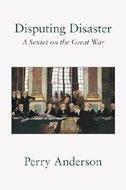
An examination of the many approaches historians have taken to understanding the origins of the First World War.
As British historian
Anderson notes, thousands on thousands of books have been devoted to World War I. Yet only a small number concern the history of history—historiography, that is. Anderson considers six major historians whose work even well-read students of the Great War may not know. While many historians have viewed the war as inevitable, others as the result of a chain of errors, Anderson’s sextet took a far more nuanced view and delivered far more
Ali, a stalwart socialist, has never been shy of courting controversy.
intriguing interpretations of events. Some suggested, for instance, a causal chain that traces the war to England’s arrangement with Russia that the czar could do much as he pleased in Central Asia as long as Russia left British India, the keystone of its empire, alone. In the view of conservative American historian Paul Schroeder, the war was at least in part due to the major European powers’ undisguised desire to bring down the Habsburg Empire: “No actor in the system gave any thought to what the consequences of the deletion of Austro-Hungary from it were likely to be,” Anderson writes. “Sensing this, Austro-Hungary rebelled against the system, only to bring itself down with the system.” And it took plenty of lives down with it: Italian journalist and historian Luigi Albertini examined the reluctance of Italy, initially an ally of Germany and Austro-Hungary, to join in the war, only to do so 10 months after the outbreak in order to take part in the spoils; the result, thanks to the blusteringly inept chief of staff Luigi Cadorna, was the slaughter of the Italian army at Caporetto, “the most ignominious single defeat of any belligerent in the First World War.” Provocative exploration of overlooked causes of a war that may or may not have been a historical inevitability.
Barss, Patchen | Basic Books (352 pp.)
$30.00 | Nov. 12, 2024 | 9781541603660

One of the greatest physicists and mathematicians of the past century receives his first biography. Science journalist Barss, author of Flow Spin Flow: Looking for Patterns in Nature , does a
It’s often forgotten that The Jazz Singer was inspired by Jolson’s own story.
fine job with a difficult subject. Penrose, now 93, did not win his Nobel Prize until 2020. Few deny his genius, but explanations of his groundbreaking discoveries are, like Stephen Hawking’s, likely to baffle a lay audience and were no snap for his colleagues. His Ph.D. advisors, world-class mathematicians, acclaimed his thesis but found it “by no means light reading.” Einstein’s relativity, which illuminated space, time, and gravity, is easier to explain. Penrose discovered the limitations of relativity but also simplified many of its complex equations. Ironically for a mathematician, Penrose disliked equations, preferring to view the cosmos visually. This fascination with geometry has made his name best known for a few dazzling optical illusions such as the Penrose triangle and Penrose staircase. Penrose’s genius was no secret. He was showered with honors, lectured, traveled the world, and enjoyed collaboration and quarrels with fellow scientists. His personal life was less satisfactory, although Barss has a much easier time explaining it. His brilliant but distant father encouraged a fascination with science and puzzles but seems to have left his son emotionally challenged. A popular speaker, Penrose had no trouble dealing with fellow scientists but seemed unable to handle intimate relationships. Intensely attracted to energetic, accomplished women, often fellow mathematicians, he married two but carried on long relationships with others whom he openly referred to as his “muses,” preferring to pepper them with his papers and solicit feedback, behavior they found both
flattering and creepy. Readers may incline toward creepy.
Superb insights into a flawed genius.
Bernstein, Richard | Knopf (272 pp.)
$28.00 | Oct. 8, 2024 | 9780805243673

An exploration of Al Jolson, blackface, and Jewish migrants’ transformative role in American culture. Today, Al Jolson (18861950) is famous mainly as the star of 1927’s The Jazz Singer, the first feature-length synchronized-sound film. More specifically, he’s famous for singing its showstopper, “My Mammy,” in blackface, a performance that would be unthinkable today. But in his heyday, Jolson was the best-paid entertainer on Broadway (earning $5,000 weekly at one point). In Bernstein’s thoughtful account, the author of Out of the Blue (2003), China 1945 (2014), and other works, doesn’t diminish blackface’s offensiveness, but he strives to give it some meaningful context in terms of Jolson’s life and Jewish American entertainers more generally. “In enlightened, post-civil-rights-movement America,” Bernstein writes, “blackface has come to be like the swastika and the N-word, banned from public spaces. But at the time that Jolson adopted it, it was taken for granted; it was a sort of stock image, a cliché. Born in a Lithuanian shtetl as Asa Yoelson, Jolson arrived
in America hungry to assimilate and was performing onstage by the time he was 12. At the start of the 20th century, Jolson was part of a wave of Jewish Americans leading an incursion into American culture, playing leadership roles in theaters and film. It’s often forgotten that The Jazz Singer, based on a short story and play by Samson Raphaelson, was inspired by Jolson’s own story: a young Jewish cantor torn between the allure of Broadway spotlights and the demands of his family’s faith. Within that plot, Bernstein finds a rich allegory not just for Jolson’s life but for the experience of Jews in America “who came nearly to dominate American popular culture, remaking themselves and remaking the country in the process.” It’s not a full-dress Jolson bio, but some elements—particularly his abusiveness toward women—are glossed over.
A revealing study of a pioneering if problematic entertainer.
Botton, Michele | Illus. by Dorilys Giacchetto | NBM (176 pp.) $24.99 | Nov. 5, 2024 | 9781681123462
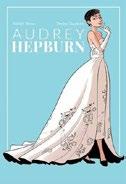
Graphic treatment of the life of the goldenage Hollywood star and philanthropist. Is there anyone who doesn’t love Audrey Hepburn? She lived admirably, after all: She served as a teenager in the Dutch Resistance, advocated tirelessly for UNICEF late in life, and in between she made classic films like Breakfast at Tiffany’s . Italian comic artist Giacchetto and writer Botton tell Hepburn’s story, its arc beginning in the terror of war and the disappointment of not landing a much-wanted place as a ballerina, its trajectory marked throughout by lost and failed love. From that
EAVESDROPPING ON ANIMALS
disappointment, Hepburn was able to put together a modest living as an actor in numerous small films, “if saying a few lines in unmemorable movies can be called that.” Then William Wyler, the famed director, happened on her, looking for an aristocratic-looking unknown to play opposite Gregory Peck in her breakthrough film, Roman Holiday It’s problematic that Peck, of chiseled and almost Rushmore-like countenance, and the wispily breathtaking Hepburn don’t much look like themselves in Giacchetto’s renderings; it’s not so much a lack of skill in rendering as the absence of a sense of their inner essence and qualities, such as Hepburn’s ability to move across a scene as if walking on air. For all that, the story does show how Hepburn worked her way through tragedies such as a miscarriage after falling from a horse in an on-set accident, as well as lesser sorrows such as being overdubbed in My Fair Lady, though she had a perfectly fine voice. (“Apparently I was good enough to say ‘The rain in Spain stays mainly in the plain,’” Botton has her say, “but not enough to sing it”). Readers wanting a blend of text and images will be better served, though, by Megan Hess’ Audrey Hepburn: The Illustrated World of a Fashion Icon . A respectful and accurate, though not especially inspired, tribute.
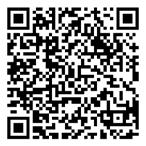
Bumann, George | Greystone Books (272 pp.)
$26.95 | Oct. 15, 2024 | 9781778400209
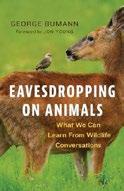
A Yellowstone wildlife ecologist and artist exhorts readers to open up our senses to the outdoors.
“Most of us spend our entire lives turning a blind eye and deaf ear toward animal conversations, chalking the chatter up to just more meaningless racket,” writes Bumann, decrying for the first of many times the unquiet desperation of our human habits. Point an ear toward the howl of a coyote, he continues, and you might hear—well, just a howl. Fine-tune your ear, and you may hear that the coyote is crying out the coyote word for “wolf,” not implausibly in a place like Yellowstone. Bumann’s notion that wildlife in conversation is as incessant and universal as human communication is pleasing, and his observation that “the sounds made and the gestures used by animals are anything but random” is well taken. On the other hand, Bumann reminds us that, yes, grasshoppers can hop much higher than humans, but it doesn’t add much to the human conversation for Bumann to say, “Who needs Marvel Comics when the nonhumans living in your own house or flowerbed can manage parallel feats?” Bumann’s account of experiences in the wild are the best part of the book, as he describes listening for differences in the calls made by prairie dogs, ravens, and owls; it’s good to learn that if you see butterflies atop a carcass or alongside a
puddle, they’re likely to be male, since males “need to replenish essential salts, namely sodium, throughout the breeding season.” His occasional notes on self-guided nature study—find a place to visit regularly, make notes in a journal, grow a wild garden, and so forth—are the stuff of a thousand blog posts, though, tending to detract from his larger narrative on animal behavior. A well meaning if sometimes preachy appreciation of the lessons of nature.
Clavin, Tom | St. Martin’s (304 pp.) $30.00 | Oct. 22, 2024 | 9781250282408

Of Butch Cassidy, the Sundance Kid, and other bad actors on the Western frontier. The glory days of the cowboy bandit lasted from about 1875 to 1905. Their turf extended from Canada to Mexico, “connected,” pop historian Clavin writes, “by what came to be known as the Outlaw Trail.” In this territory, Clavin’s heroes and antiheroes plied their trade, a particularly favorite spot being a plateau that bordered Utah, Wyoming, and Colorado, allowing for easy escape from one jurisdiction to another. Clavin’s cast of characters includes any number of figures who are well known to Western buffs, including Charles Siringo, the Pinkerton agent who, though he would later turn on the firm (and it him), spent years chasing after the Butch Cassidy-Sundance Kid gang; the hired gun Tom Horn, who cleaned out plenty of outlaws from their hiding places in the mountains, only to cross over into outlawry himself (and, notes Clavin, who wrote letters warning his intended victims that he was coming for them—“perhaps he still believed in fair play”); and the very bad Kid Curry, a stone killer who eluded capture while meting out death on lawmen and
innocents alike for years. Some of Clavin’s Western history is by the numbers, but to his credit he places the action in the larger context of social change: Butch and Sundance disappeared into the wilds of South America—and have never been definitively found in all the years since—because, Clavin writes, the Wild West had run out of time, while “the few outlaws who remained…were gradually driven or drifted out by bolder and more numerous lawmen, replaced by ranchers glad for new territory.”
Clavin’s shoot’em up yarns don’t break much new ground, but Western buffs will enjoy them all the same.
Clinton, Hillary Rodham | Simon & Schuster (352 pp.) | $29.99 Sept. 17, 2024 | 9781668017234

T he former presidential candidate mines those moments and pet projects easily overlooked during the course of a high-profile career.
Clinton has more former roles, titles, and experiences to account for and reflect on than most. In the opening pages of her latest memoir, she promises a series of conversational snippets that make it “feel like sitting with me at a dinner party.” Thus, the net of content is cast wide— especially given the book’s relatively short length—and jumps between her roles in both personal relationships and presidential administrations and her musings on issues facing America today, like political polarization, the repeal of Roe v. Wade, and threats to democracy posed by Donald Trump. Readers expecting a new intimacy from Clinton will not find it here; her acknowledged “midwestern reticence” erects guardrails to keep her within her comfort zone. Occasionally, she cannot resist reminding readers of what she has been right
about all along. Yet Clinton’s understanding of her own aging and dwindling number of “tomorrows” stays some of the temptation to pontificate and prompts her to “open up,” both in pursuing new professional contexts and in giving readers poignant, if small, windows into her personal grief, faith, and intentionality and investment in relationships. Unsurprisingly, persistence and resilience, as shown not only by courageous women worldwide but also by the United States, remain her thematic lighthouses. Rather than a vacant, Pollyannaish cheer, these twin drumbeats pound both above and beneath the book’s subtext, marking a thought-provoking and motivating push-pull between Clinton’s realism, anxiety, and optimism, no longer bound by the lenses and soundbites of campaigns and stump speeches and profoundly significant in the current political moment.
A sincere if measured attempt to impart both wisdom and urgency.
Compagnon, Antoine | Trans. by Jody Gladding | Columbia Univ. (368 pp.) | $27.00 paper | Nov. 12, 2024 | 9780231211352

A n iconic novelist’s religious heritage. Literary scholar Compagnon offers an authoritative examination of the reception of Proust (18711922) by the French Jewish community following the author’s death. Because Proust’s mother came from a family of assimilated Jews, many critics were inspired to ask about the author’s sense of religious or cultural identity. “Am I not more Jewish than European?” That is the question, Compagnon asserts, posed to Proust retrospectively by a host of erudite readers, spurred by an obituary of Proust written by Zionist André Spire in 1923. In the decades that followed, “some responded for him in a
decidedly positive way, emphasizing his Jewish heredity, even his rabbinical style,” Compagnon has found, “while others proved more prudent, and even more reticent.” Mining an extensive bibliography, Compagnon offers detailed readings of articles and books by more than a dozen prominent critics, focusing especially on the 1920s, when Proust was discussed in the pages of Zionist journals by critics known as the “French Israelites,” and continuing into the 1930s. Critics in the 1920s often compared Proust to Montaigne and Henri Bergson—both of Jewish ancestry—noting stylistic evidence of Proust’s “maternal heritage” in his “Talmudic sentences” and his representation of Jewish characters “who could not be reduced to conventional types.” In the second half of the 1930s, however, a “noticeable change” occurred, spurred by Siegfried van Praag, an influential critic who proposed “anti-Semitism as the explanation for certain character traits that Proust gives his creations.” Taken up by Hannah Arendt, in her Origins of Totalitarianism ,” this view created “long-lasting repercussions” in the debate over Proust’s connection to Judaism. It is a view, bolstered by close reading and biographical discoveries, that Compagnon persuasively challenges.
A meticulously detailed analysis.
Cooper, Christopher A. | Univ. of North Carolina (216 pp.) | $22.00 paper Oct. 15, 2024 | 9781469681719

Analysis of the curious politics of North Carolina, a definitively purple state. Cooper, a political scientist, writes that the Old North State is purple, a swing state, constantly competitive, or “whatever other
THE MEMORY PALACE
middle-of-the-road moniker you want to throw at it.” That’s as a collectivity, by which measure “North Carolinians are among the most moderate in the country.” There are outliers, of course: go to Charlotte or Chapel Hill, he writes, and you’ll find a politics reminiscent of the San Francisco Bay Area, whereas if you head into the countryside you’re in pretty solidly red country. These forces are balanced out enough that, apart from the attorney general’s post, which seems unshakably Democratic, political seats in the state constantly shift between parties: the current governor is Democratic, whereas the legislature is Republican. Therein lies a rub, Cooper notes, for the governor has little actual power, the legislature almost untrammeled weight, and one of the latter’s current projects has been to gerrymander the state for a permanent Republican majority and to limit the governor’s power even further. Evenhandedly, Cooper observes simply that “just as certain is the fact that the party in power will gerrymander to hold onto its power is the fact that the minority party will advocate for reform,” and so has it been of late. While Cooper suggests that much of the electorate is generally fair-minded, he does note that there are some oddities in the system, including the continued presence of a literary test in order to qualify to vote—a definitive holdover from the days of slavery. Foreseeing a future in which present trends of nationalization, competition, and polarization become ever more pronounced, he proposes reforms (increasing the governor’s line-item veto power) and rejects others (term limits). A useful handbook for students of political trends throughout the U.S. in a turbulent election year.
DiMeo, Nate | Random House (336 pp.)
$33.00 | Nov. 19, 2024 | 9780593446157
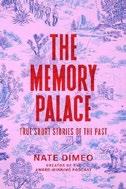
A collector of “true short stories” parades a caravan of curiosities. In mining “the space between the story of our lives and those lives as we live them,” DiMeo plays magician, conjuring the enchantments that reside in the subtle and unseen, often moment to moment. They come to him as some random fact or anecdote that finds a purchase in his imagination and are processed as stories. DiMeo, a former radio personality and artist in residence at the Metropolitan Museum of Art, is creator and host of The Memory Palace podcast and co-author of Pawnee: The Greatest Town in America. His first solo book engages deeply with history, locating new ways of perceiving lives familiar or obscure: how Samuel Morse invested 35 years learning to be a painter before tragedy compelled him to invent the code that bears his name; the legacy of Elizabeth Van Lew, aka Crazy Bet, a clever Southern iconoclast who spied for the Union in the Civil War; the strange history of Egypt’s Temple of Dendur; the rebuke to today’s anti-immigration forces embodied by the Jewish refugee ship St. Louis in World War II; the story of 19th-century farm wife turned artist Caroline Shawk Brooks, who sculpted masterworks in butter; and the inspiring career of Olympic runner Betty Robinson. Often DiMeo can only draw inferences from the facts at hand, but he is on surest footing when drawing on stories from his past, among the collection’s most fluid and emotionally resonant. The book’s
anecdotal structure is reminiscent of, but superior to, the late Paul Harvey’s The Rest of the Story (1977), with its characteristic surprise or ironic endings. Although some of the writing can be pedestrian, there are flashes of eloquence and style. Stylistics, however, are beside the point. DiMeo’s illumination of small wonders edifies and entertains.
Dunlavy, Colleen A. | Polity (240 pp.)
$29.95 | Nov. 4, 2024 | 9781509561735
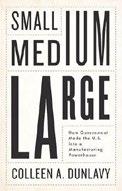
Efficient production methods are now taken for granted, but it was not always so, says this study. The processes by which the United States became an economic superpower are still being unraveled, but University of Wisconsin historian Dunlavy provides another piece of the puzzle with this short, pithy book. At first glance, the subject of manufacturing standardization might not seem an interesting one, yet this book turns out to be a fascinating read. Dunlavy looks back to the early years of the 20th century, when manufacturing was largely based on the production of goods—everything from beds to bricks—in a bewildering array of sizes and types. Henry Ford’s methods had shown the value of mass production, but the idea had not yet spread throughout the economy. The dominant business thinking was that consumers preferred wide variety over low prices. This changed with World War I, when the government encouraged manufacturers of war-related material to adopt mass-production techniques for greater efficiency and less waste. It worked, but many companies returned to their old ways after the end of the war. Enter Herbert Hoover, who became secretary of commerce in 1921 (and later president). He created the Division of Simplified Practice, which pumped out
reams of data to show the benefits. The methods spread, and by World War II the economy turned into a mass-production powerhouse. Standardization would also show the value of cooperation between government, businesses, and industry associations. Dunlavy recounts the story with an efficiency that matches her subject, making her book relevant for anyone interested in the history of business.
An engaging look at a cornerstone of economic growth.
Easter, Gerald | Pegasus (336 pp.)
$29.95 | Nov. 5, 2024 | 9781639367368

Russian imperialism is checked in an often surprising story of Native American resistance.
Beginning in the 1600s and stretching out over the next two centuries, czarist Russia had strong designs on what Boston College historian Easter and travel writer Vorhees call “the northwestern flank of North America.” Russia’s early ambitions had mostly to do with the lucrative sea otter fur trade, though later, as Russian ships made their way south to California, czarist planners saw the promise of a breadbasket that could supply the people of less fertile Siberia. Those ambitions were stymied and finally halted by the Tlingit people, from their capital at Sitka, Alaska. These Indigenous groups mounted fierce resistance against would-be Russian settlers, some of whom were “drawn from the most depraved thieves and bandits in Irkutsk.” Many of the Russians’ leaders were of a higher caliber and character than all that, though they were not reluctant to visit atrocities
on Indigenous people; in one engagement, many hundreds of Alutiiq and Aleuts died. By way of reply, however, the Tlingit coalition later killed 250 Russians in a localized campaign, a number “comparable to the number of dead cavalrymen at the iconic Battle of the Little Bighorn.” It must have been with some relief that Russia sold Alaska off to the United States in 1867 “at two cents per acre.” Easter and Vorhees skillfully relate the story of the Tlingit-Russian war to other events, asserting that the Monroe Doctrine was a response to Russian and not British expansionism and noting that the Russians also attempted to bring Hawaii into their empire, only to be thwarted by the intrigues of Yankee sailors.
A capable narrative that sheds light on a little known aspect of Native American history.
Feinstein, John | Hachette (256 pp.) $30.00 | Nov. 12, 2024 | 9780306833908

A prolific sportswriter chronicles an Ivy League football season shadowed by tragedy. Feinstein’s 50th book is frequently upbeat, lauding the conference’s rich heritage, standout players, and academic standards. But his account of the 2023 campaign, based on interviews with more than 80 players and coaches from all eight teams, begins with the league in mourning. Dartmouth’s longtime coach Buddy Teevens was bicycling when a truck hit him in March 2023. He died from his injuries on Sept. 19 of that year, days before Dartmouth’s home opener. Teevens’ death was especially hard on another Ivy coach, Harvard’s Tim Murphy. They “had been best friends ever since” Little League,
writes Feinstein, recounting Murphy’s sorrowful visits to his hospitalized friend’s bedside. The author lauds Teevens for being one of the first college coaches to reduce the practice-session contact drills that might hasten brain injuries. But Feinstein soon shifts his focus to the league’s traditional “ten games in ten weeks” schedule, which more than one player likens to a “sprint.” Feinstein introduces readers to charismatic players like the aptly named Brown wide receiver Wes Rockett and Cornell quarterback Jameson Wang, former benchwarmers who developed into stars. Feinstein hails the league’s commitment to classroom excellence, but aside from mentioning that spring practice is scheduled “around the players’ academic schedules,” he offers scant details about the football-schoolwork balance. Feinstein came to prominence with A Season on the Brink (1986), his candid portrait of a volatile college basketball coach, yet his depictions of current Ivy football coaches are conspicuously mild. He celebrates the league’s longevity, noting that several schools have been playing football since the 19th century, but rightly criticizes the conference for having just “two Black head football coaches in history.”
An admiring, knowledgeable, occasionally superficial look at one of college football’s storied leagues.
Finkel, Eugene | Basic Books (336 pp.)
$30.00 | Nov. 19, 2024 | 9781541604674

A Ukrainian-born political scientist examines Russia’s centuries-long efforts to subject his homeland.
“Russia’s full-scale invasion of Ukraine is the single most important event in Europe since the collapse of the
Soviet Union in 1991,” writes Johns Hopkins professor Finkel. The tension between Ukraine and Russia, he writes, extends to the days of Kyivan Rus’, the founding state of both modern nations, which, subjugated by Mongol invaders in the medieval era, gave way to the Podunk village of Moscow. The Muscovite elites, by Finkel’s account, came to see themselves as the legitimate rulers of Rus’; especially in and after the expansionist regime of Peter the Great, Russia claimed Ukraine and proclaimed it as “Little Russia.” That campaign is ongoing. Today, writes Finkel in his evenhanded but clearly pro-Ukrainian account, Russia is attempting to suppress the Ukrainian language and eliminate local traditions. What is worse, he adds, is that Ukrainian children have been kidnapped by the hundreds of thousands and taken to Russia, there to be “forced to become Russian.” The intent is to erase Ukrainian identity generationally, and to some extent that horrific plan is succeeding. For all that, Finkel notes, the Russian invasion of 2022 has turned out to be disastrous: the Russian army and intelligence agencies assured Putin—who, by Finkel’s account, hatched at least some of his war plans as a kind of Covid-19 isolation project—that they would be greeted as liberators and that the Ukrainians would fold in days. Instead, Ukraine has resisted bravely, despite casualties. The costs are many and will be long-lasting, Finkel concludes: “Even if Russia apologizes and pays reparations, it will take decades for Ukraine’s wounds to heal.”
A book that does good service in deepening our understanding of what lies behind the headlines.

WHAT CAN WE LEARN FROM THE GREAT DEPRESSION?
Frank, Dana | Beacon Press (368 pp.)
$39.95 | Oct. 8, 2024 | 9780807046906
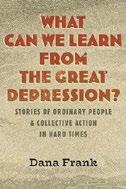
A sweeping history of minority self-help in the face of the Great Depression. If UC Santa Cruz historian Frank’s book has a governing idea, it might be that, to quote Patti Smith, people have the power. In this instance, numerous people poleaxed by the Depression did not wait for the government to catch up, although Franklin Roosevelt’s New Deal did help ease the suffering; instead, Frank’s subjects, primarily minority members, formed mutual aid societies, helping the most affected with “burial insurance, health care, ethnic solidarity, and cultural sustenance.” In some instances, she adds, these mutual-aid endeavors were long embedded in minority cultures excluded from such things as bank loans and mortgages. As Frank writes, Black communities across the country were hardest hit by the Depression, with more than 40 percent of men unemployed against slightly more than 27 percent of white men. Whites also formed mutual-aid societies, Frank adds, but these typically provided them “a way to draw a circle around themselves and keep out those who they identified as nonwhite.” Frank describes other actions, including a little-documented strike by Black wet nurses, whose own children were being monitored by the health department to make sure they were healthy and not being neglected. Not all popular actions
were progressive or noble: one case study concerns the rise, mostly in the Midwest, of a KKK offshoot called the Black Legion, who terrorized nonwhite populations (which, in the eyes of Legion members, included Jews and Eastern and Southern Europeans). Frank suggests some level of cultural and social continuity in the fact that the Legion’s heartland is the heavily gerrymandered congressional district that Jim Jordan now represents. A well crafted work of social history that highlights little known aspects of pre–World War II America.
Furedi, Frank | Polity (240 pp.)
$29.95 | Nov. 12, 2024 | 9781509561254

The destruction of our history is well along, says this scholarly polemic.
Furedi, emeritus professor of sociology at the University of Kent, Britain, and author of How Fear Works: The Culture of Fear in the 21st Century, points out that nowadays paintings created in the 18th or 19th century have a good chance of being linked to colonialism or the slave trade. America’s Founding Fathers knew that our Constitution would fail to pass if it forbade slavery, so they allowed it. No longer seen as an unedifying if essential political compromise in an otherwise iconic document, the author says, in the eyes of activists this converts the Constitution to a foul monument to racism. America’s National Archives has attached a cautionary note to the
original Declaration of Independence warning that the views expressed were “outdated, biased, offensive” because its author, Thomas Jefferson, included unflattering remarks on Native Americans. Furedi expresses outrage at this “grievance archeology” that he says is obsessed with uncovering historical injustices, atoning for them, and repackaging them according to the values of present-day identity politics. Emphasizing British activism, he turns up a small industry devoted to portraying Shakespeare as an advocate of racism, misogyny, and homophobia, and Churchill, an ardent imperialist, as a war criminal. Less familiar with the United States, Furedi maintains that our “attack” on history flourishes in the arts, academia, and universities but only hints that it has never caught on with the general public and is now in retreat as powerful institutions such as the Supreme Court and state legislatures go after diversity and remove “indoctrination” from school classrooms. A furious attack on the extremes of political correctness.
Goodwin, Megan & Ilyse Morgenstein Fuerst | Beacon Press (176 pp.)
$24.95 | Nov. 5, 2024 | 9780807012758
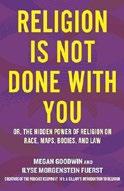
A critical examination of the pervasive influence of religion in daily life. Though both Goodwin and Morgenstein Fuerst are scholars of
religion, they denounce “bullshit takes on religion…that insist religion is always and everywhere good.” At the same time, they dispute the view that religion is retrograde and irrational: there’s a place for it, they insist, if perhaps not so all-encroaching as it is in American society. On that note, they observe, for instance, that Christianity effectively dictates the calendar, not just because it’s a Christian invention, courtesy of Pope Gregory XIII, but also because it deprecates holidays that are not Christian in nature. “Even working in liberal Massachusetts is not a guarantee your employer will be cool with you calling out of work as witchy,” they write of Goodwin’s Wiccan views. The authors go further still in their critique of religion-fueled patriarchy: if you privilege white male Christian worldviews over any other, they hold, you get Jan. 6, 2021. Religion shapes health care, as arguments over abortion highlight, and it shapes politics and policing. Noting that “nominally secular systems like laws and courts codify white Christian nationalism” even in the face of the Constitution’s establishment clause, they rightly observe too that no one is really free to opt out of the system: A Sikh with a turban cannot opt out of being looked at with fear and suspicion at the airport any more than someone named Ahmed can remove himself from candidacy for the no-fly list even were he to move to South Dakota and convert to Lutheranism. In all these ways, then, religion truly is not done with us, no matter how much we might want to be done with it.
A provocative, fresh way to look at the reach of religious belief in a supposedly secular society.
How religion shapes health care, politics, and policing.
Gorton, Stephanie | Ecco/ HarperCollins (432 pp.) | $32.00 Nov. 26, 2024 | 9780063036291

Two defiant women. Drawing on considerable archival sources, journalist Gorton creates an informative history of the fight for women’s reproductive rights in her dual biography of activists Margaret Sanger (1879-1966) and Mary Ware Dennett (1872-1947). Dennett came to the cause from her personal experience of accidental pregnancies and birth trauma; Sanger, from work as a visiting nurse among the poor of New York City, where she saw women die after illegal abortions. The two first met in 1902, but although they shared goals, they fell out over the means to attain them. Dennett, Gorton reveals, shunned publicity and preferred to put her efforts into lobbying politicians and physicians; Sanger, a charismatic public speaker and successful fundraiser, relished being in the public eye. They differed, too, over who should hold prescribing privileges for contraceptives, with Sanger insisting that only physicians and nurses should. The women’s most stalwart adversary was Anthony Comstock, U.S. Postal Inspector and founder of the New York Society for the Suppression of Vice. The Comstock Act of 1873 had made dissemination of information about contraception illegal, punishable by imprisonment. Both women suffered the brunt of that legislation. As Gorton points out, Project 2025, produced by the Heritage Foundation as a blueprint for a future Trump administration, “explicitly states the Comstock Act should be revived and enforced” a dismal prospect at a time when the legal right to contraception is codified in only 13 states. “A woman’s body belongs to herself alone,”


SOME PEOPLE CLEANED out their garages during the Covid-19 confinement. Some binge-watched streaming videos. Some took online classes.
Charles King wrote a book.
That’s not so unusual. One day, when an inventory is taken, thousands of books will be counted as Covid literature. But what is unusual is that King’s book, Every Valley: The Desperate Lives and Troubled Times That Made Handel’s Messiah (Doubleday, Oct. 29), grew not just from the pandemic but also from a needle-in-a-haystack treasure hunt. (See our review on p. 63.)
“My wife and I were just looking for ways of feeling better, like everybody was,” King tells Kirkus, speaking from his office at Georgetown University, where he is a professor of international politics. “She’s a singer and a writer, and she loves Handel’s Messiah. What if I could find the oldest recording of this thing and put it on an old Victrola that we happen to have? I mean, it’s silly, but that was my magical solution.”
A century-old recording was acquired by way of an internet search, and the game was afoot. “We put it on, and we both just started weeping. We’d heard it
A political scientist turns to musical and cultural history with the story of Handel’s Messiah.
BY GREGORY MCNAMEE
many, many times before, as most people have. But it got me thinking about how weird this iconic piece of music is, and it took me from Christmas-shopping and pumpkin-spice-latte background [music] into a kind of philosophical journey— because, it turns out, the life and times of Messiah are very much like our own.”
Messiah, of course, is considered the greatest work of German composer George Frideric Handel, the product of an ingenious musical artist’s lifelong journey as it neared its end. But, as King discovered when he began to look into its origins, it was also the result of a confluence of events and personalities, some quite unlikely: a religious dissenter, an enslaved African prince, an abused woman, British and German monarchs, and many others, all of them figuring, one way or another, in Handel’s masterpiece.
That religious dissenter’s story is a small tragedy all its own. Charles Jennens, whom readers meet at the outset of Every Valley, was a timid, retiring man so afraid of the cold that he slept under four blankets in summer and six in winter. He lived a hermetic life, his one true love an older man in an era when
such love could not be expressed, and he suffered from what today would probably be classified as bipolar disorder.
Jennens was also a brilliant scholar whose vast library, one of the largest in England, fueled endless writings, including a vast corpus that he called his “Scripture Collection,” an assemblage of snippets from the Bible and associated literature in which Jennens, King writes, “linked up one passage with another, editing and rearranging them, tying together themes that leaped out at him from the text.” In time, that text would evolve into the libretto for Messiah; Jennens, King holds, was “the person to whom the Messiah most properly belongs as an idea.”
Jennens was playing with fire in many of his writings, for early-18th-century England seemed on the verge of collapse, under tremendous stress on every front: religious, political, and cultural. Religious orthodoxy was inflexible, often lethal. Catholics were hunted, suspected of loyalty to foreign potentates. “Nonjurors” such as Jennens and his beloved dissident Protestants shielded their correspondence against the eyes of government agents. Whigs
and Tories feuded, while a Jacobite rebellion brewed up north. Hatred, denunciation, calumny, division, and uprisings threatened to tear the nation apart. And then there was the question of who, in the end, would rule—times very much like our own, indeed.
Queen Anne, that last monarch of the House of Stuart, ascended the throne in 1702. In constant pain (and probably suffering from lupus), Anne “seemed to oscillate between despair and rage,” King writes. Pocked by sores, covered with bandages, she took to drink and overeating. Her one joy was music, and there Handel comes in, a German in nebulous self-exile from the Hanoverian court that employed him as its musical director. Anne liked what she heard, Handel obliged with a birthday-present cantata, and soon both Handel’s finances and reputation began to grow.
Handel enjoyed the freedom of England, his newfound home, and the luxuries that money bought. At least some of his growing fortune, though, was tainted. As King tells Kirkus, “All of British society was intertwined with empire, and empire rested on the trade in people.” Most of those people were anonymous, unknown to those they enriched, but one figure in Every Valley was an exception, an African prince, Ayuba Diallo, who was kidnapped and transported in chains to the colony of Maryland. After an escape attempt and his eloquent defense, Diallo was put on a ship for England, where he became something of a celebrity. After a time, freed, Diallo sailed back to Senegal, one of precious few enslaved Africans ever to return to their homelands.
Jennens, who himself had built a considerable fortune from the slave trade, knew Diallo’s story. He may even have known Diallo personally, for he shared membership with Diallo in a “Gentleman’s Society” made up of the country’s leading intellectuals. Diallo’s name, rendered as Jalla, appears very close to Jennens’ on the published membership roll—and when King, devouring archives and libraries to research Every Valley, laid eyes on it, he recalls, “I thought, here’s another one of those astonishing connections of these lives of torment and brokenness that all
end up spinning into a monument to the idea of hope.”
That monument first took the form of a jumbled mountain of manuscripts that Jennens presented to Handel. More a tome than a libretto, Jennens’ text caught Handel at a time when he was eager for a meaningful project, having idled away a few years with his own eating and drinking binges. Handel, whom King likens to Sondheim as much as Bach, got to work, intent on reinventing himself musically even as, King says, “he recycled a few things that he’d tried out before,” paring down Jennens’ text to manageable length and pulling it together with the magnificent oratorio that, in its insistent repetition of “hallelujah,” speaks of glory to reward so much suffering.
The resulting score, with the basic shape that we know today, was slow to take hold. Handel premiered it in Dublin in April 1742, where, thanks to an emotive performance by yet another psychically wounded figure, the singer Susannah Cibber, it met with an enthusiastic reception. (Jonathan Swift
was in the audience.) Handel staged it in London the following year, where “it met with sort of polite enthusiasm,” as King puts it. Polite or not, audiences grew, performances multiplied—as King notes in Every Valley, Handel performed it 36 times, “more frequently than any other oratorio he ever composed”—and soon Messiah was on its way to becoming a classic.
Few contemporary readers will know much of George II, Queen Anne, Charles Jennens, Ayuba Diallo, Susannah Cibber, or even George Frideric Handel himself—until, that is, they read Every Valley. More than the story of how a beloved musical work was created and entered the canon, King’s book speaks to how unlikely coincidences shape our lives and thoughts. “It’s a story, I think, about the way in which our own legacies are things not of our own making,” King says. “The things that live on after us are subject to forces far larger than ourselves.”
Gregory McNamee is a contributing writer.
The life and times of Messiah are very much like our own.
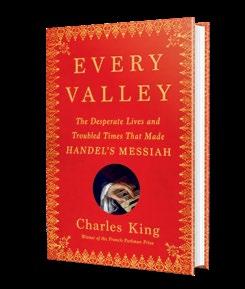
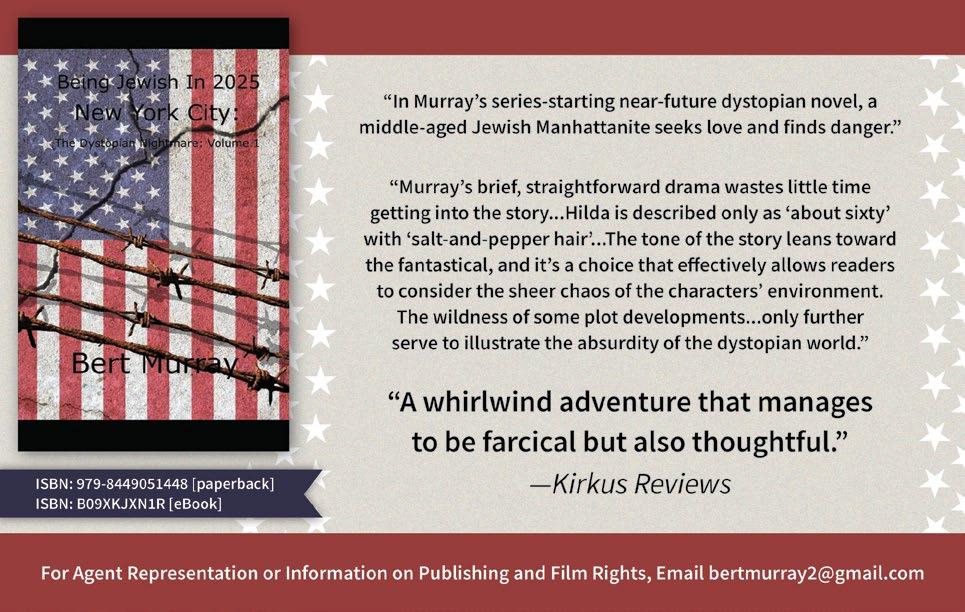


Night Magic
By Leigh Ann Henion
Henion writes with poetic grace, blending her journey of discovery with the natural wonders in our own backyards. 2 Living on Earth
B y Peter Godfrey-Smith
Enlightening insights into the natural world and our often perilous relationship to it.
The Heart of the Wild
Edited by Ben A. Minteer and Jonathan B. Losos Clarity and complication mark this wide-ranging collection.
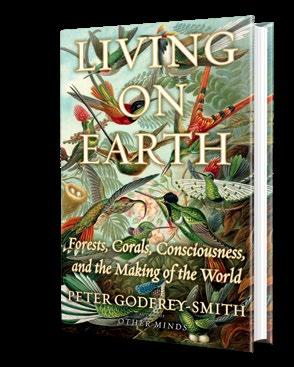
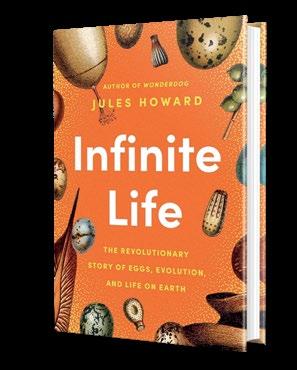

By Jules Howard
High-quality natural history.
The Wisdom of Sheep By Rosamund Young



Ecco will publish the chef and humanitarian’s Change the Recipe.
Chef and humanitarian José Andrés will share the lessons he has learned throughout his career in a new book, People magazine reports.
Ecco will publish Andrés’ Change the Recipe, co-written with Richard Wolffe, next spring. The press describes the book as “a collection of José’s most affecting and powerful life lessons: hard-won wisdom from a man who has dedicated his life to changing the world through the power of food.”
Andrés, a native of Spain, moved to the U.S.
when he was 21 and gained culinary fame as a chef at restaurants including Jaleo and Zaytinya. He now owns several eateries including minibar, Agua Viva, and Beefsteak.
In 2010, he founded World Central Kitchen, a nonprofit organization that provides food relief for people undergoing humanitarian crises.
“His lifetime of experience—from the kitchen to war zones— has given him a wealth of stories and teachable moments that are funny, touching and insightful, animated by the belief that food can bring us closer together and the conviction that each of us can change the world for the better,” Ecco says.
Andrés announced his book on the social platform X, writing, “You can learn so much about life in the mayhem of a kitchen, and by sharing a meal with people around you.…This book is a collection of those stories and life lessons.”
Change the Recipe is slated for publication on April 22, 2025.—M.S.

For more books about food, visit Kirkus online.

Andrés


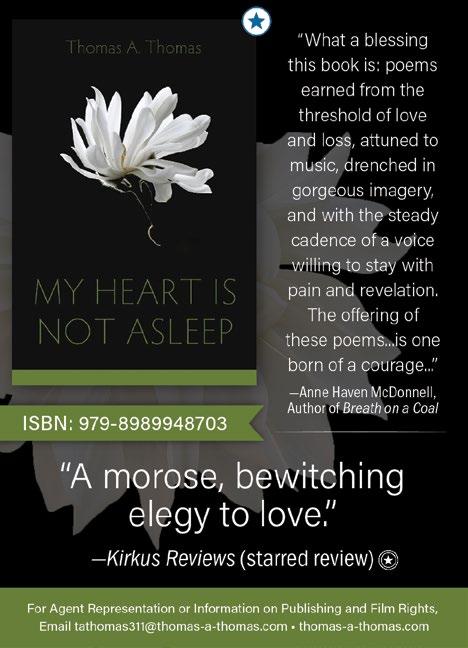


The activist’s Saving Five will be published by Questlove’s imprint, AUWA.
Activist Amanda Nguyen will tell the story of her life in a new memoir, People magazine reports.
AUWA, the MCD imprint founded by drummer Questlove in 2023, will publish Nguyen’s Saving Five: A Memoir of Hope next year. The press describes the book as “a heart-wrenching memoir of survival and hope.”
Nguyen was raped in 2013 while she was a student at Harvard University and opted to wait to press charges. She learned that her rape kit would be destroyed by the state of Massachusetts if she did not officially report the crime within six months.
Her experiences led her to found the nonprof-

it group Rise, which advocates for sexual assault survivors, in 2014. Nguyen and Rise were behind the Sexual Assault Survivors’ Rights Act, which was signed into law by President Barack Obama in 2016, establishing a bill of rights for victims of sexual assault.
Nguyen, a former NASA intern, is scheduled to be the first woman of Vietnamese descent to fly to space next year. Her memoir, AUWA says, is “a groundbreaking work that seamlessly blends memoir with a moving journey toward acceptance and hope, forging a path ahead that is as inspiring as it is instructive.”
Saving Five is slated for publication on March 4, 2025.—M.S.

Sanger proclaimed in 1914. “It does not belong to the United States of America or to any other government on the face of the earth.…Enforced motherhood is the most complete denial of a woman’s right to life and liberty.”
A timely contribution to a virulent debate.
Graeber, David | Farrar, Straus and Giroux (384 pp.) | $32.00 Nov. 12, 2024 | 9780374610227

Essays on politics, culture, and economics by the late anthropologist and activist.
An anarchist philosopher at heart, Graeber was known in his too-short life for book-length explorations of democracy as practiced by Indigenous people, pirates, and rebels, as well as denunciations of capitalism and its—his term—bullshit jobs. The essays here open on a contrarian, controversial note: If there is such a thing as Western civilization, “a particularly incoherent concept,” it’s demonstrably “just as hostile to anything we would recognize as democracy as those of India, China, or Mesoamerica.”
A look around at the current political landscape, to say nothing of the polities of ancient Greece and Rome, would certainly back up the notion, but Graeber probes further, noting, for instance, that when the Portuguese colonized parts of South Asia, an Arab legal scholar advised an Indian ruler that it was legitimate to declare jihad “specifically because they destroyed a tolerant, pluralistic society in which Muslims, Hindus, Christians, and Jews had always managed to coexist.” Coexistence seems more problematic these days, but Graeber holds that the most meaningful strides toward it, and toward democracy itself, happen when communities decide to “manage their own affairs outside the purview of the state.” Examining economics—one piece is a dialogue with French economist
Thomas Piketty—Graeber renews his call for meaningful work, for a state that does not rely on personal taxes, and for resistance to power based on coercion and violence. Nika Dubrovsky’s introduction quotes Jorge Luis Borges: “When writers die they become books, which is, after all, not too bad an incarnation.” Certainly that’s true of Graeber, to whose always readable books this should certainly be added. One hopes for more from the Graeber archive, but this makes for a fine overview of his cage rattling career.
Harris, L. John | Heyday (320 pp.)
$35.00 | Nov. 5, 2024 | 9781597146494

A haunting painting holds a journalist in its thrall.
On an afternoon in Paris in the summer of 2015, food journalist and illustrator Harris spied a painting of a young girl, unfinished and unsigned, leaning against a residential wall. He found the apparently discarded portrait compelling and rescued it. So began a seven-year quest to discover its provenance. “I feel oddly drawn to the girl who stares out at me with a story she does not tell,” he writes. Harris, curator of the Harris Guitar Collection at the San Francisco Conservatory of Music, was a significant contributor to California’s food revolution of the 1970s and ’80s as both author and publisher. His latest book is at once a detective story, a Parisian culinary travel memoir, and a chain of ruminations—often romanticized—on serendipity and the nature and power of art, especially anonymous art. Ever the urban ambler, Harris chronicles his investigations at great length, pausing here and there for interludes of navel-gazing. Though many of his observations and the introduction of less-well-known art figures can be arresting, other discourses in criticism and psychology seem self-consciously “arty” and
overintellectualized. There is much borrowed wisdom in the form of quotations that range from illuminating to fanciful. He also transforms simple coincidences into the karmic and ethereal. This, plus overlength, tends to weaken the presumed focus of the book—the origins of The Girl in Red. Who was she, and why was she abandoned? But the chief problem with this sometimes entertaining, sometimes exasperating book is that, failing to find “closure” in his sleuthing, Harris doesn’t know where to end this “embellished tale of acquisition.” Making more of a good painting than may actually be there.
Hersey,
Tricia |
Illus.
by George
McCalman
| Little, Brown Spark (160 pp.) $26.00 | Nov. 12, 2024 | 9780316365550
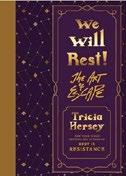
A multidisciplinary African American artist/ theologian muses on the concept of rest as necessity and strategy. Hersey opens with a provocative question: “How do you find rest in a capitalist, white supremacist, patriarchal, ableist system?” In this part art object, part “escape artist” manifesto, Hersey offers a 10-step guide to finding rest from the oppressiveness of “grind culture.” Finding inspiration in historical figures like Harriet Tubman, who led other enslaved people to freedom, Hersey counsels readers to first become a “trickster” dedicated to ignoring everything that “stands in the way of… liberation.” Creating community is also key to finding—and perpetuating—safe spaces that allow for deliverance. At the same time, she warns that freedom requires the artfulness of improvisation because no single path will suit all who desire rest. Seekers must consciously slow down and listen to their bodies and their own inner wisdom while steering clear of the material forms of self-care that “toxic capitalism” tries to force on those caught in its gears. Their inner trickster must
also be open to constant self-reinvention, an act that liberates in how it catches the grind culture off guard. Finding comfort in poetry—and especially the politically inflected poetry of Nikki Giovanni and Langston Hughes—also assists with a seeker’s mission to continue dreaming in a system that exhausts the body and numbs the mind and spirit. As it calls out the racist, sexist brutality of hypercapitalism, this spiritual book offers respite to the weary through spare, duotone illustrations, playful word-based page layouts, and refreshingly uncluttered pages that sum up her wisdom in everything from epigrams and single-paragraph reflections to poems and brief narratives.
Warm, wise, and humane.
Honneth, Axel | Trans. by Daniel Steuer | Polity (238 pp.) | $35.00 Nov. 4, 2024 | 9781509561285

German ethicist and humanist philosopher Honneth turns his attention to the world of work—and all its indignities.
Most people in a given society are workers, observes Honneth in this accessible work of political philosophy, and it is “one of the major deficiencies of almost all theories of democracy” that this fact is not of central importance. Workers can be made the backbone of civil society by creating dignified conditions that promote cooperative, social behavior; if poorly run, a society will instead produce egocentric, us-against-them citizens. That’s precisely what we have, Honneth argues, because workers lack the freedom, the opportunity, and the incentive to contribute to “societal prosperity.” Whereas the Hegelian ideal of work produces independence and honor, the reality in capitalist societies is very different: workers are oppressed not just by the
usual machinations of the bosses but also by such things as the fragile gig economy of the present, the suzerainty of finance and speculative capital, and the outsourcing of labor “to hugely underpaid remote workers all over the globe.” Add to that companies that break unions, that time workers’ bathroom breaks, and that view employees as fungible, and you have no chance of creating a society in which, as Adam Smith wished, “workers can fully understand the laws, accept them on rational grounds and embrace their meaning.” In short, workers are present, but they are not actors in a precarious society that does not value them. There are remedies, Honneth notes: one can reform capitalism, or one can fetter capitalism with laws and labor market reforms. He holds that a middle way between the two is “the moral order of the day,” one that contributes to human dignity and that allows workers a voice in the conditions of their labor.
A thoughtfully constructed argument in favor of work worth doing, and of workers treated as human beings.
Kirkus Star
The Scapegoat: The Brilliant Brief Life of the Duke of Buckingham
Hughes-Hallett, Lucy | Harper/ HarperCollins (688 pp.) | $40.00 Nov. 19, 2024 | 9780062940131
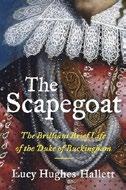
A delicious account of English politics in the decades after Elizabeth.
Historian Hughes-Hallett, author of Gabriele d’Annunzio: Poet,
Seducer, and Preacher of War, concentrates on the relations between middle-aged, unattractive but competent James I (reigned 16031625) and Henry Villiers (1592-1628), Duke of Buckingham, his “favorite.” The word is passe, but even today’s national leaders have a chief of staff or special advisor who owes their power to that leader alone and is often sacrificed to placate the populace. English monarchs in that era enjoyed great land wealth and executive authority but did not have absolute power and were usually short of money because taxes were temporary and required parliamentary approval. James had the enormous advantage (in our eyes) of being opposed to war and easygoing in matters of religion. This put him at odds with parliament, dominated by Puritans who considered British Catholics to be traitors and Catholic Spain a loathsome enemy. Mostly, he tried to rule without parliament. He had run through several favorites before Villiers joined the king’s bedchamber in 1615. All were handsome young men, and modern scholars now accept that James was homosexual. Villiers and James developed a passionate relationship that seemed both sincere and physical. James showered him with estates, titles, and offices, provoking jealousy from peers and salacious commentary from the populace. This had little effect until 1624, when Britain went to war against Spain with enthusiastic support from parliament, Buckingham, and young Charles, who succeeded his father the following year. Combining lively prose and skilled scholarship, Hughes-Hallett describes the catastrophic military debacles that followed. With attacks on royalty off-limits, blame focused on Buckingham, but newly crowned
The king’s favorite—in more ways than one. THE SCAPEGOAT
Charles cut short charges by dissolving parliament, beginning the interregnum that ended with civil war and his own execution long after Buckingham himself had been assassinated to widespread applause. Great men and politics history at its best.
Johnson, Kelsey | Basic Books (416 pp.)
$32.50 | Oct. 15, 2024 | 9781541604360
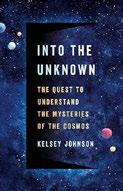
A tour of some of the universe’s inexplicabilities by a genial astrophysicist. “This is a book about what we don’t know and why we don’t know it,” writes Johnson, an astronomer at the University of Virginia. There’s plenty we don’t know, perched as we are in one infinitesimally small corner of a very large place, from the existential (Why are we us?) to the physical (When will the solar system end?). Undaunted, she encourages all readers, whether or not armed with a doctorate, to ponder matters that range from the meaning of life to the nature of time. On the latter, Einstein may have said it exists so that everything doesn’t happen at once, but Johnson is more cautious: “We interact with it continuously throughout our lives, and much of physics is defined with respect to time, yet we don’t understand what it truly is.” Yet, although she can throw out sentences to make an untested head hurt (“One way to think about imaginary numbers is that they are orthogonal to real numbers in a complex number plane”), she does so in good humor: If in quantum mechanics something that seems to make sense is in fact impossible and something that seems impossible is very much true, then it’s only, she writes, because “‘common sense’ and ‘reality’ are frenemies.” In the end, as Johnson suggests, things are pretty much as they are, whether we understand them or not,
the meaning of life.
INTO THE UNKNOWN
and lucky for us: Alter any given law of physics, after all, and “it would profoundly change the properties of the universe, and in almost all cases make the universe inhospitable to life-as-we-know-it.”
Popular science written warmly and accessibly, if not without thought provoking complexity.
Kempe, Michael | Norton (304 pp.)
$32.50 | Nov. 12, 2024 | 9781324093947
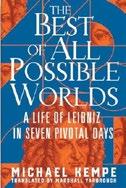
A distinguished German historian explores the life of the late-17th-century philosopher Gottfried Wilhelm Leibniz. Leibniz was easily one of the greatest minds to have emerged from the Enlightenment, yet he is little discussed today. Proceeding from the philosopher’s belief in the importance of “constantly changing one’s position and taking on a new point of view,” Kempe examines Leibniz’s life by focusing on seven key days between ages 29 and 70. He carefully reconstructs those days not only to give a sense of Leibniz’s world but also to allow readers a glimpse into the restlessness of a man who, at his death, left observations penned on 100,000 pages “of every size imaginable.” The story begins in 1675, when Leibniz, then living in Paris, had successfully created the symbolic language associated with infinitesimal calculus. Even as he pondered the workings of his system, his broad-ranging mind was also musing on how symbols could be used to “parse the
totality of human knowledge into simple terms.” Each of the chapters that follow finds the philosopher a little older and in a new city, drinking coffee and working on an astonishing variety of projects: windmills for mining operations, irrigation systems for noble families, and in-depth political histories of German royal houses. Some of his ideas, like the notion that his binary mathematical system could be used to decipher “the world and its knowledge” appear far-fetched, but they are all part of his enduring faith in progress and what is possible. As well researched as it is readable, this study will appeal not only to scholars of Leibniz and the Enlightenment, but to anyone with an interest in well-articulated, imaginatively crafted intellectual histories.
A unique biography about one of the world’s most brilliant polymaths.
Kimmerer, Robin Wall | Illus. by John Burgoyne | Scribner (112 pp.)
$20.00 | Nov. 19, 2024 | 9781668072240

Learning from the land.
Kimmerer, drawing from her Potawatomi heritage, uses the abundant serviceberry to demonstrate the gifts that the natural world provides, highlighting the “enoughness” of these gifts if we choose to view them as such. For a society consumed by consumption, this portrait is startling in its simplicity. “Recognizing ‘enoughness’ is a radical act in an economy that is always urging us to consume more,”
Kimmerer writes. While the prose occasionally verges on saccharine, each word is clearly chosen with care and deliberation, resulting in a masterful reflection on ecology and culture. The book seamlessly blends science, inherited wisdom, and philosophy, urging readers to reconsider their relationship with the environment and society. Kimmerer pushes back against the individualism and scarcity mindsets entrenched in our interactions, encouraging us to draw inspiration from the natural world and Indigenous knowledge systems. Rather than the exploitative system of modern capitalism, which can be damaging to both the earth and our relationships, Kimmerer invites readers to envision a life that embraces the gift economy— one built on reciprocity, collective well-being, and care. She writes, “When we speak of [sustenance provided from the land] not as things or natural resources or commodities, but as gifts, our whole relationship to the natural world changes.” Despite the dire repercussions of not living in harmony with nature, her beautiful and hopeful prose leaves readers feeling sated, galvanized, and keenly aware of the world around them.
A welcome meditation on living in harmony with the earth and fostering deeper connections with one another.
Kirkus Star
Every Valley: The Desperate Lives and Troubled Times That Made Handel’s Messiah
King, Charles | Doubleday (352 pp.)
$32.00 | Oct. 29, 2024 | 9780385548267
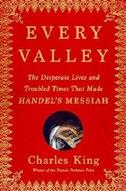
A ringing history of George Frideric Handel’s Messiah and its turbulent birth. Composed for Easter but long associated instead with Christmas, the Messiah is one of the world’s most widely performed
oratory pieces: As King writes, there were some 200 performances in the United States in 2023, many of them mass audience singalongs. His wide-ranging history begins not with Handel but with the eccentric Englishman Charles Jennens, whose “smallest agitations could balloon into obsessions.” A bibliophile and independent scholar with a huge library, Jennens made one such obsessive project out of what he called his “Scripture Collection,” a massive gathering of biblical quotations and his own notes that he delivered to Handel, “approaching sixty and edging toward the final stage of his career,” who would not live to see most of the fame that would come from his composition. King is a professor of international relations at Georgetown, but he writes with a musicologist’s insight into Handel’s methods. Closer to his own discipline, King writes winningly of the history surrounding Handel’s life and times; of his effectively fleeing the Hanover court where he was employed only to have that court become the rulers of Britain, where he had decamped; of the support of the unfortunate Queen Anne, who “seemed to oscillate between despair and rage,” an admirer of Handel’s work who put him on the path to wealth; of the disruptions of larger events such as the Jacobite Rebellion and the War of the Austrian Succession; and much more. Ever present onstage is Handel, a fantastically handsome young man grown obese in middle age (“He was known for overindulgence, even among the gentlemanly set that expected a full table and free-flowing port”). In a long but fascinating aside, King also traces Handel’s unexpected financial involvement in the slave trade.
A swiftly moving, constantly engaging portrait of a beloved masterpiece.
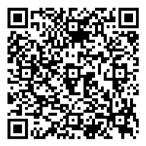
Klotz, Martin | Westholme Publishing (296 pp.)
$32.50 | Nov. 5, 2024 | 97815941464293

A patient dismantling of a frontiersman’s reputation. If you remember the 1940 Spencer Tracy vehicle Northwest Passage, Robert Rogers was a steely but fair-minded commander who turned uncouth frontiersmen into well-disciplined fighters. The movie doesn’t mention the real Rogers’ penchant for taking scalps of both the Native and French peoples who inhabited the old Northwest, pocketing the bounty money while decrying scalping as a “barbarous custom” of the “savages.” He was, attorney and history buff Klotz writes, “a chronic alcoholic whose drinking sapped his judgment,” an abusive husband and absent father, and a toady who kowtowed before his royal superiors, seeking favors. He spent more time in the courtroom than on the battlefield, it seems, from being hauled before the bench to be tried for counterfeiting and court-martialed for war profiteering. He was constantly in debt for “gambling, poor business decisions, and extravagant personal spending.” Having settled on the Loyalist cause before the Revolution, and “willing to sell his services to the highest bidder,” he fled to England during the Revolutionary War, spending his remaining days alternating between pubs and debtors’ prisons. Halfhearted efforts to find the Northwest Passage led to naught, although Klotz does allow that militarily Rogers had a few fine moments, seizing French forts in present-day Michigan and Indiana and escaping an assault by a larger Continental force, an attack motivated by the fact that George Washington “considered the destruction of the Queen’s Rangers an important objective.” Rogers is a largely obscure figure in the annals of the late colonial and revolutionary
era, then, for good reason, including his personal shortcomings and “deficiencies as a commander”—hardly the stuff of a movie hero.
Capable revisionist history that highlights an already despised figure, only to diminish him further.
Lightman, Alan | Pantheon (208 pp.)
$36.00 | Nov. 19, 2024 | 9780593701485

The popular-science writer turns in an eclectic set of essays on the wonders of the universe.
“I call myself a spiritual materialist,” writes Lightman, author of the bestselling novel Einstein’s Dreams (1992). The “materialist” bit comes from Lightman’s view that the knowable world is subject to the laws of physics; the “spiritual” part comes from the transcendental moments that the universe provides with rainbows, beautiful star-scapes, encounters with wildlife, and such. Each of the three dozen alphabetically arranged (save one) essays, from “Atmosphere” to “Yosemite Firefall,” contains at least one memorable takeaway point, as when he explains why many migratory birds fly in V formations: “Each bird after the leader…gets to take advantage of the uplifting pockets of air produced by the bird in front of it,” saving plenty of calories in the bargain. The lead bird gets no such break, and for that reason, birds, with admirable equity, take turns riding point. Just so, he notes, chlorophyll is green “because its molecular structure is such that it absorbs light in all wavelengths except those corresponding to the color green,” and it makes our world green, too. Hummingbirds are trapped in a catch-22: they hover because it allows them to extract nectar from fruits and flowers constantly, which they need to do in order to fuel their hovering. Lightman encourages us to pay attention to the night sky, have a kind thought for spiders, and consider the beauty of
mathematics. Though his prose can be a touch dense at times (“the electrons in the atoms of adenosine triphosphate and the oxidized luciferin move to lower energy levels and release that energy differential in the form of light”), it’s to good purpose. He closes with an out-of-sequence piece on the wonders of being human that makes just the right summation. An eloquent survey of nature and the rewards that come from paying attention to it.
Loske, Alexandra | Princeton Univ. (256 pp.)
$39.95 | Nov. 5, 2024 | 9780691263960
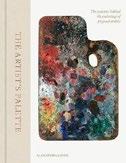
Tools of the trade—and what they reveal. An art historian and curator, Loske has written several books about her special area of interest, color. In her latest title, she examines 50 painters and their palettes. In many cases, the palettes, which range from polished wood to chunks of cardboard, still exist, and they provide clues about an artist’s method. Most of the book is organized chronologically, starting with artists mixing their paints from powdered pigment and arranging the palette according to a strict tonal scale. The development of premixed paint in metal tubes presaged greater dynamism and more choices of color. Artists who specialized in scenes of fantastic coloring, among them Marc Chagall and Paul Gauguin, understood that the luminosity they were seeking needed subtlety and care, according to the evidence found by Loske. The palettes of Edward Hopper and Georgia O’Keeffe reflected restraint, while Claude Monet’s palette recalls his misty, complex images. Francis Bacon, famously messy, used anything on hand as palettes but was extremely precise when it came to the effects he wanted. Some modernist painters, including Helen Frankenthaler, moved away from the palette to apply
liquid paint directly to the canvas. Loske includes a wealth of lushly produced plates to illustrate her points, as well as graphics that show the proportional breakdown of paintings by tone and color. It all makes for an illuminating and attractive book. The palette, she writes, is “a totemic object, a small physical manifestation of the creative spirit of the artist.”
An appealing study that uncovers important artistic secrets.
Luzzi, Joseph | Princeton Univ. (232 pp.)
$24.95 | Nov. 5, 2024 | 9780691156774
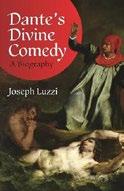
The making of a masterpiece. Bard College literature scholar Luzzi posits that Dante was “an intensely experimental writer,” one reason that centuries later James Joyce would take so many cues from him. Dante was experimental, Luzzi continues, first because he did not write his Divine Comedy in Latin—a choice that limited his audience, since all literate Europeans would know Latin but almost certainly not the Tuscan dialect of Italian. Tuscan, in turn, and particularly the Tuscan spoken in Florence, provided Dante with a vigorous language that “could capture the intimate rhythms, cadences, and meanings of everyday speech and, by extension, the resonances and experiences of daily life.” Despite Dante’s enthusiasm for the language and ways of Florence, the city banished him in 1302, which, though infuriating, convinced Dante that he was on a mission from God to write a sacred poem that would explain the workings of heaven, purgatory, and hell. It took time for that word to spread; as Luzzi notes, “by the end of the 1300s, about eight hundred manuscripts of the Commedia were in circulation.” The introduction of movable type and translations into other languages made it a world classic, if long
after Dante’s own lifetime. Perhaps ironically, Luzzi notes, one particularly close reader of Dante’s text was a “zealous Spanish cleric” working under the auspices of the Inquisition, who diligently crossed out passages that placed wayward popes and priests in hell and condemned “a Vatican that ‘fornicates’ with kings.” Perhaps it’s a sign of divine approval that the censor’s strikethroughs have faded away and Dante’s original text shines through. A learned but accessibly written essay on a centerpiece of the European literary tradition and its continuing influence.
MacLaine, Shirley | Crown (288 pp.)
$35.00 | Oct. 22, 2024 | 9780593735305

A worldly life journey candidly reflected in photos and captions. Throughout her illustrious career, from her 1950s star-making Broadway debut as an understudy in Pajama Game to leading roles in acclaimed films like Some Came Running and The Apartment, Shirley MacLaine has diligently chronicled her life’s journey. Her bestselling memoirs, beginning with Don’t Fall Off the Mountain (1970) and including Out on a Limb (1983), have documented her professional ascent and approach to living a fully independent, well-traveled life as a modern woman. Now in her 90s, MacLaine revisits her experiences through a collection of personal photographs and extended captions, serving as a visual
narrative thread. In mostly laudatory terms, her memoir showcases MacLaine’s connections with luminaries from various spheres of her personal, political, spiritual, and show business life. Such reflections include her long, unconventional marriage to businessman Steve Parker, her Rat Pack associations (Frank Sinatra, Dean Martin, and Sammy Davis Jr.), and her encounters with U.S. presidents and controversial political figures like Nikita Khrushchev and Fidel Castro. Of the latter, she notes, “Castro and I had two days together. He was open, funny, and curious, especially about the Kennedys, and did not come on to me as Barbara Walters suggested he would.” On the flip side, MacLaine occasionally dishes a few subtle asides: Jerry Lewis was “overpowering and controlling, and I didn’t think he was funny,” director Herbert Ross “was an arrogant guy, very full of himself,” and of her Terms of Endearment co-star she simply comments, “I did not enjoy Debra Winger.” MacLaine’s images and captions cumulatively reflect an enviable, well-lived existence, offering glimpses into her world travels, family, friends, and various love affairs. An engaging but lightly written exploration, the scant narrative may appeal primarily to her devoted fans.
A glossy retrospective of MacLaine’s remarkable life and career, visually captivating yet offering more breadth than depth.
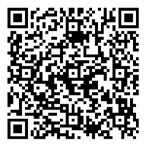
McIntyre, Rick | Greystone Books (272 pp.) $27.95 | Oct. 29, 2024 | 9781778401251

Longtime wolf biologist and former Yellowstone ranger sums up decades of observing Canis lupus.
“Wolves, like humans, are thinking beings that are constantly making choices and decisions,” writes McIntyre. One set of choices and decisions has to do with where and how to live: entering adulthood, wolves must position themselves in the pecking order, challenging the alpha or meekly accepting a role as beta; alternately, they disperse to find a new pack with better chances for advancement, a risky choice given that some wolves will kill an intruder. McIntyre has witnessed all these behaviors, as well as acts that, even recognizing the dangers of anthropomorphism, would have to be classed as heroic. Of one wolf known as 949—biologists do not name the wolves in order to avoid developing too much nonscientific attachment to them—McIntyre writes, he “had distemper, which is highly infectious. In his final days, he stayed away from the pack, stoically enduring his fate.”
Another had a broken jaw, likely earned from an elk kick, that must have meant excruciating pain; yet, McIntyre notes, the wolf lived on until dying while protecting his pack, unquestionably noble. Doffing scientific detachment, McIntyre writes with clear admiration of the great qualities and accomplishments of the Yellowstone packs, particularly of numerous elders that have lived several lifetimes beyond the average of three years in the wild. An especially affecting moment comes when he buries blood, taken from the body of an alpha female named 926, at the site where she had played as a pup: “That small amount of blood, her life force,
along with moisture and nutrients from the soil, would be carried up through the tree trunk.…That meant a little bit of 926 would abide in that tree.” Fans of wolves in the wild will learn much from McIntyre’s career spanning account.
Kirkus Star
Washita Love Child: The Rise of Indigenous Rock Star Jesse Ed Davis
Miller, Douglas K. | Liveright/Norton (464 pp.)
$32.50 | Nov. 12, 2024 | 9781324092094

A definitive biography of one of the great unsung rock heroes of the 1970s. Oklahoma-born Jesse Ed Davis was a guitarist’s guitarist, cherished by elite and aspiring musicians for the sensitive musicality of his work for Taj Mahal and as a studio musician in Los Angeles. No less than Duane Allman, perhaps the greatest bottleneck slide guitarist of his generation, credited Davis’ slide work on Mahal’s “Statesboro Blues” as the main inspiration for his own artistry. In short order, Davis’ guitar was in demand by artists of the highest stature in rock and roll. George Harrison called on him to play the Concert for Bangladesh in 1971. The Rolling Stones put him at the top of the list, next to the Faces’ Ronnie Wood, to replace Mick Taylor in 1975. Davis also worked—and partied—with John Lennon, Bob Dylan, Levon Helm, Leon Russell, and scores of other big names at the apex of classic rock. Why is he not better known? The answer, like Davis himself, is complicated. The only child of parents from distinguished Native American families—Seminole and Mvskoke on his father’s side and Kiowa on his mother’s—Davis grew up a typical middle-class baby boomer in Oklahoma City in the 1950s, but with the weight of Indigenous history deep in his bones. “Being Native was painful for
Jesse,” one friend said. “Part of him wanted to get away from it by becoming a rock star.” By the end of the 1970s, he had sunk into a heroin habit that derailed his career, ruined relationships, and ultimately killed him. Miller, an Oklahoma State University history professor and a former musician, is well suited to the subject; the research, he makes clear, was a labor of love.
A vivid, well rounded portrait of an overlooked major talent.
Mittelmeier, Martin | Trans. by Shelley Frisch | Yale Univ. (200 pp.) | $26.00 Nov. 12, 2024 | 9780300259308

A German literary theorist examines how the Neapolitan landscape influenced the philosophical movement known as Critical Theory. Followers of Theodor Adorno, Walter Benjamin, and other Frankfurt School luminaries do not typically associate Naples with Critical Theory or any part of its genesis. But as Mittelmeier shows, “that sulfurous, chaotic [and] exhausting city,” along with the neighboring island of Capri, likely played a far greater role both in the intellectual formation of Frankfurt School proponents and in how they thought about society, history, and modernity. The author takes as his starting point the late summer of 1925, when Adorno, then a music composition student, traveled with Frankfurter Zeitung editor Siegfried Kracauer to Naples, which by that time had become established as the charming “southernmost stop on the grand European educational journey.” There, and especially on Capri, they found themselves surrounded by an intoxicating mix of “nonconformists…dreamers and revolutionaries.” One in particular, literary scholar Walter Benjamin, had become
fascinated by porosity, which he detected in the building materials— fashioned from volcanic stone—and social interactions he saw around Naples. Porosity in turn became a concept that Benjamin—and later Adorno—would use to understand and explain social and historical processes that they believed were based on a process of continual intermingling of contradictory elements. For Adorno (as for Benjamin), porosity held possibilities for what he would identify as “unforeseen constellations” out of which new combinations could be born. The author further observes that this concept would revolutionize how both men would structure their theoretical works: less as a clear progression of ideas leading to a definitive conclusion and more as a constellation of dissimilar elements. Vigorous, provocative, and persuasive, Mittelmeier’s book offers original insights that will undoubtedly prove invaluable to scholars of Critical Theory. An exceptionally refreshing take on the origins of the Frankfurt School.
Moore, Marcus J. | Dey Street/ HarperCollins (240 pp.) | $29.99 Nov. 19, 2024 | 9780358494881

Rappers who broke the mold. When De La Soul released their first album, 3 Feet High and Rising in 1989, it immediately caught the ears of music critics and hip-hop fans. The single “Me Myself and I,” with its irresistible sampling of Funkadelic’s “(Not Just) Knee Deep” under the quirky, sauntering rhymes of Kelvin Mercer, David Jolicoeur, and Vincent Mason, stood in sharp contrast to the urgent, hard-edged tales of street life from the biggest rap acts of the day. Moore was a nerdy, gifted kid in a Washington, D.C.,
suburb when he first heard the album at a cousin’s house, and it made a huge impression on him. “They didn’t portray themselves as gangsters like N.W.A or smooth-talking ladies’ men like Big Daddy Kane or LL Cool J,” Moore writes. “Instead, De La appealed to the Black alternative…. They spoke to those who didn’t conform to what Black was supposed to be.” Legal troubles over samples and contractual disagreements kept the Long Island trio’s music off streaming platforms until shortly after Jolicoeur’s death in 2023, which only added to their mystique. The reader may feel cheated of new information about the group or wish that Moore had provided a more detailed analysis of its music and sociological impact. Then again, the author notes, the musicians didn’t talk to him for the book. An affecting memoir of a music journalist’s lifelong relationship with an eccentric rap trio.
Munson, Richard | Norton (256 pp.)
$29.99 | Nov. 12, 2024 | 9780393882230

The scientific side of Benjamin Franklin’s life and career. In this brisk yet well-packed account of Benjamin Franklin (1706-1790) as America’s quintessential polymath Founding Father, Munson (Tesla: Inventor of the Modern , 2018) deftly navigates Franklin’s myriad accomplishments as statesman, diplomat, writer, publisher, and more. Throughout, Munson highlights Franklin’s
passion for scientific inquiry as the bedrock of his rational approach to decision-making and problem-solving in these various roles while also surveying many of his scientific discoveries. From his groundbreaking experiments with electricity to his invention of bifocal lenses and the lightning rod, Franklin’s ingenuity and practical intellect are evident, underscoring his enduring influence on both science and society. Munson argues that Franklin’s scientific acumen was the driving force behind his success in all other arenas: “With all due respect to Franklin’s standing as a founding father of our country, we wouldn’t be discussing his political prowess were it not for his fame as a leading scientist, which opened doors for him in the worlds of diplomacy and nation-building. Science, rather than being a sideline, is the through line that integrates Franklin’s diverse interests.” Munson further traces the evolution of Franklin’s reputation over time, examining how shifting cultural currents and the subjective perspectives of various biographers have influenced our understanding of him, emphasizing instead the particular relevance of Franklin’s scientific approach within our current world: “As a vocal set of modern-day activists reject science and dismiss facts, Benjamin’s life highlights the importance of verifiable analysis....In our narrow view of America as either red or blue and our arguments as only for or against, Franklin suggests a more nuanced world, one that is ultimately more fascinating and entertaining. We now can see him with prismatic lenses, rather than bifocals that register at most two views.”
An engaging, fully dimensional portrait of Franklin, his empirical mindset serving as an example for our fact challenged era.
Nel, Philip | Oxford Univ. (160 pp.) $19.99 | Nov. 27, 2024 | 9780197777596

Tracing the backstory of a beloved book. Nel’s interest in the picture book Harold and the Purple Crayon began five decades ago, when he encountered the book as a child. In the ensuing decades, he not only wrote a biography of the book’s author, Crockett Johnson, but also aspired to write the current volume, which he calls “a biography of a book.” True to his intent, Nel traces the book’s origins, evolution, and cultural effects, beginning with the premise that picture books should be treated as works of art. He writes, “As one of our earliest aesthetic experiences, picture books shape our perception of what art is and why it matters.” Drawing on the work of scholars like Jean Baudrillard and artists like Paul Klee and Joan Miró, Nel argues that the Harold series was revolutionary not only because it explored the power of imagination, but also because it took children—and their art—seriously. Perhaps most fascinating is Nel’s interrogation of whether or not the protagonist is white: Nel draws on Johnson’s support of the Civil Rights Movement and the perceptions of Black artists like Prince to argue that Harold is not. Like the picture books themselves, Nel’s work is formally inventive, including a series of reflection questions for readers and two blank pages to “pick up your purple crayon, and just start drawing.” At times, the author slips into an academic register, slowing the book’s otherwise steady pace. Overall, though, this is an insightful, lyrical, and profoundly researched read. An inspired and fascinating look at a popular children’s picture book.

Robert Caro’s The Power Broker Now Available as E-Book
The prize winning biography went digital for its 50th anniversary.
Robert A. Caro’s The Power Broker finally has an e-book edition.
Alfred A. Knopf has released an electronic edition of the author’s iconic biography, the press announced. The publication of the e-book is tied to the book’s 50th anniversary.
The Power Broker, published in 1974 by Knopf, is an account of the life and career of Robert Moses, the influential New York City planner. The book won a Pulitzer Prize and has remained popular over the past five decades; it became something of a Zoom status symbol during the early days of the Covid-19 pandemic.
In a statement, Caro said that he wanted an e-book edition of The Power Broker “that would have fidelity to the physical book.”
“I wanted it done because if you’ve learned some things about political power that you think are worth knowing, you’d like as many readers as possible to know them,” he said. “And with so many readers now doing their reading digitally, an e-book is essential. Thankfully, technology advanced to a point that allowed linking of the notes, which should enhance the digital reading experience.”
Knopf publisher and editor-in-chief Jordan Pavlin said, “It is thrilling to imagine a generation of new readers falling under the spell of Caro’s essential work in its new form.”—M.S.



For a review of The Power Broker, visit Kirkus online.


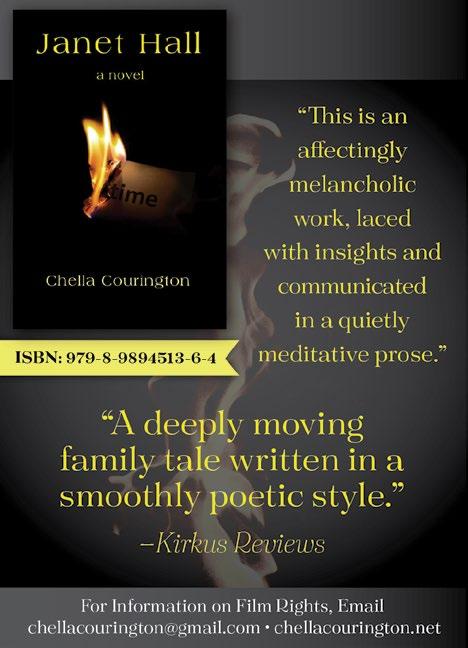
Mother Mary Comes to Me will be published by Scribner next September.
Arundhati Roy will tell the story of her life in a new memoir.
Scribner will publish the Indian author’s Mother Mary Comes to Me next year, the press announced in a news release, calling the book “an ode to freedom, a tribute to thorny love and savage grace—a memoir like no other.”
Roy worked as a screenwriter before publishing her first novel, The God of Small Things, in 1997; the family epic won the Booker Prize. She wrote several nonfiction books, including The Cost of Living, Field Notes on Democracy, and Capitalism, before releasing her second novel, The Ministry of Utmost Happiness, in 2017.
An outspoken political activist, Roy won the PEN Pinter Prize earlier this year. She is being prosecuted in India under an anti-terrorism law for comments she made in 2010 about the territory of Kashmir.

For reviews of Arundhati Roy’s books, visit Kirkus online.
Roy’s memoir, Scribner says, will be “a soaring account, both intimate and inspiring, of how the author became the person and the writer she is, shaped by circumstance, but above all, by her complex relationship with her extraordinary, singular mother she describes as ‘my shelter and my storm.’”
“I have been writing this book all my life,” Roy said in a statement. “Perhaps a mother like mine deserved a writer like me as a daughter. Equally, perhaps a writer like me deserved a mother like her. Even more than a daughter mourning the passing of her mother, I mourn her as a writer who has lost her most enthralling subject.”
Mother Mary Comes to Me is slated for publication next September.—M.S.

Oakes, Lauren E. | Basic Books (336 pp.)
$30.00 | Nov. 12, 2024 | 9781541603349

The potentials and challenges of forest conservation as a climate change solution.
Oakes, a conservationist-scientist and the author of In Search of the Canary Tree (2018), embarks on a global journey exploring forest restoration and conservation efforts to combat climate change. From the jungles of Costa Rica to the Scottish Highlands and from tropical landscapes to urban settings, Oakes investigates diverse environments, interviewing hundreds of experts and delving into both environmental concerns and socioeconomic inequalities. Oakes writes, “I wanted to investigate how our forests are changing. I wanted to explore the big and bold ideas for increasing forest cover and offer a window into the lives of the people who are now shaping the future of forests in [an] effort to help rescue our own.…To what extent can forests really save us? And how?” Throughout her exploration, Oakes balances the promise of forests as nature’s carbon-absorbing powerhouses against the risks of overreliance on this single solution. Oakes positions herself as both an ecologist-conservationist and a concerned mother. However, her scrupulous research presentation frequently overshadows her storytelling, occasionally compromising the narrative flow. Although Oakes’ writing lacks the captivating style of seasoned environmental journalists like Elizabeth Kolbert or Bill McKibben,
her work provides a comprehensive study of this crucial topic. She presents both the rewards and the challenges of maintaining healthy forests as a climate change solution, contributing significantly to the ongoing dialogue on environmental conservation and climate action. Despite its occasional density, Oakes offers an earnest and in-depth exploration of innovative strategies to increase forest cover and the potential impact on our changing climate. It serves as an important resource for those seeking to understand the complexities of forest conservation in the face of global environmental challenges. A meticulous if sometimes overwhelming examination of forests’ role in combating climate change.
O’Connor, Sinéad | Melville House (176 pp.)
$19.99 paper | Oct. 29, 2024 | 9781685891855

Memorializing a singer through her words.
O’Connor is in exceptional company in Melville House’s Last Interview series, joining a list that includes Martin Luther King Jr., Ruth Bader Ginsburg, and Marilyn Monroe, as well as musicians Lou Reed, David Bowie, and Prince, to name just a few. Her inclusion signals her cultural significance, not only as an artist but as an outspoken activist and spiritual seeker. O’Connor, who died last year at age 56, is best known for her 1990 hit “Nothing Compares 2 U,” written by Prince. She may be equally well known for offending devout Catholics by ripping in half a photo of Pope John Paul
A trailblazing singer in her own words.
SINÉAD O’CONNOR
II on Saturday Night Live and calling him “the real enemy” in protest of the church’s history of child abuse, especially in her native Ireland. O’Connor touches on all of the above in the nine interviews included here, which span from 1986 to 2021, but only a few bracketed editorial insertions fill in the gaps. This book is not for those interested in the particulars of O’Connor’s life story; rather, this collection, like the other books in the series, aims to capture the artist as she presented herself to journalists and media figures at various stages of her life and career. Some information, naturally, gets repeated; some trains of thought get developed over time. As Throwing Muses’ Kristin Hersh shares in her charming introduction, O’Connor “was a pretty normal person, I think, though she’d been accused of strangeness, of craziness.” A reclusive star’s normalcy shines through, as do her street smarts, candor, and sense of humor.
Owen, Michael | Liveright/Norton (400 pp.)
$37.99 | Nov. 26, 2024 | 9781324091813

Singing the praises of George Gershwin’s brother and musical collaborator. Ira Gershwin has long been overshadowed by his younger brother George, who died of brain cancer at the age of 38. Yet Ira, writes cultural historian Owen, was his own man, whose “true religion was words.” He labored away at songs that have long since entered the American songbook: “I Got Rhythm,” “’S Wonderful,” “Embraceable You.” As Owen writes, a constant source of tension was Ira’s deliberate, perfectionist approach to writing, even as George seemingly dashed off classics such as Rhapsody in Blue (a title Ira came up with) and Porgy and Bess: “George wanted his brother to work more quickly, as the endless melodies that flowed from George’s fingertips could not wait while Ira struggled to find his
SONNY BOY
own voice.” Ira was easygoing and modest, though when fame caught up with him, he took the familiar route of high living and, in middle age, “the popping of pills—whether uppers to lift his mood during the day or barbiturates to calm him down or help him sleep.” It was Ira’s good fortune to work often with lyricist Yip Harburg, a high school classmate and lifelong friend; Harburg wrote “Over the Rainbow,” to which Ira added the last line: “If happy little bluebirds fly / beyond the rainbow / why, oh why, can’t I?” It was his misfortune to sign on to movie projects that threatened to drain his talent dry, as with the Judy Garland remake of A Star Is Born, which, Ira feared, rested too much on “the shoulders of its shaky star, who, he was convinced, would eventually fall apart.” Owen is especially good on the business side: though Ira proved a faithful caretaker of his brother’s legacy, it required him to fight endless battles that detracted from his own work. A vigorous biography that accords Ira Gershwin his due as a canonical American writer.
Pacino, Al | Penguin Press (400 pp.)
$35.00 | Oct. 15, 2024 | 9780593655115
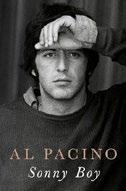
Winning reminiscences by a reluctant movie star. Pacino, it seems, would rather be known for interpreting Shakespeare than for playing Michael Corleone in the Godfather films, but of
course it’s the latter that brought him much of his fame. The debt to the Bard is great, though: As a young man growing up in the tenements of New York, where his childhood friends would die of drug abuse, he walked the streets and declaimed: “If the hour was late and you heard the sound of someone in your alleyway with a bombastic voice shouting iambic pentameter into the night, that was probably me, training myself on the great Shakespeare soliloquies.” In time, good luck smiled on him: He roomed with another young actor named Marty Sheen, “one of the best people I’d ever know,” earned roles in which he portrayed tough but sensitive young men in films like The Panic in Needle Park and Dog Day Afternoon, and became a star thanks to The Godfather. Pacino’s notes on acting can be mysterious (“The thing about acting is, you don’t really do it and yet it’s real. That’s the phenomenon”), but, considered in light of his work, they mostly make sense. What’s more, he reads deeply into his characters, nowhere more so than the Shakespearean ones, as when he writes of the much-maligned Shylock, “He feels a righteousness because of what was done to him. He’s not a Iago, not a Richard III, or any of the other villains of Shakespeare. There is a touch of the hero in him. He is a survivor.” So, clearly, is Pacino, and we’re fortunate to have this report from a long life on stage and screen.
Fans of Pacino—and students of the actor’s craft—will delight in this gracefully told memoir.

Kirkus Star
Parr, Patrick | Univ. of Massachusetts (352 pp.) $29.95 | Nov. 26, 2024 | 9781625348166

The early life and incarceration of the man who would become Malcolm X. Parr (The Seminarian: Martin Luther King Jr. Comes of Age, 2018) has written the definitive story of the youth and early adulthood of one of the most dazzling and controversial civil rights leaders in American history. He uses long-neglected primary sources— papers, correspondence, records from the Massachusetts prisons in which the self-destructive Malcolm was incarcerated for his crimes as the leader of a small band of Boston burglars—to vividly depict the fascinating transformation of Malcolm Little to the electrifyingly eloquent and ever-evolving activist Malcolm X. Parr’s thorough research and engaging style augment and enhance the story of Malcolm’s African, Caribbean, and American roots; the predisposition for intellectualism and worldliness that he inherited from his activist parents (particularly his mother, Louise Little, an intriguing figure in her own right); and the racial duality he struggled with as a child in rural Michigan. Parr makes use of The Autobiography of Malcolm X , the celebrated collaboration between Malcolm and Alex Haley, enough so that readers who have not read it are not operating in ignorance of that foundational work. Parr’s use of the prison documents provides for eye-popping descriptions of Malcolm’s horrifying and edifying correctional experience and in-depth profiles of the significant individuals Malcolm encountered—most notably John Elton Bembry “Bimbi”—who were instrumental in his quest for self-discipline, structure, knowledge, and erudition.
A rich portrait of a young revolutionary.
ANDY WARHOL’S MOTHER
Reeder Jr., William | Lyons Press (272 pp.)
$32.95 | Nov. 5, 2024 | 9781493085309
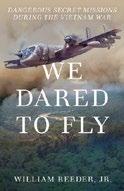
A pilot in the secret sideshows of the Vietnam War spins tales of unfriendly skies. Reeder arrived in Vietnam as a captain in the Army, which posted him to a secret aviation unit. Explained one fellow flyer, “We don’t have a mission inside South Vietnam.” Instead, their small, lightly armed Mohawks flew over Laos, North Vietnam, and eventually Cambodia, detecting heat signatures of enemy trucks and troops along the Ho Chi Minh Trail, taking low-altitude surveillance photos, and the like. The low-altitude part of the equation meant constant danger from ground fire: “Today,” Reeder writes of an early mission, “I’d been tracked by a North Vietnamese surface-to-air-missile crew who could have launched a SAM, but didn’t. I could have been blown out of the sky, but wasn’t.” Those constant dangers, and the heavy casualties that the self-designated “Spuds” took, had their effects on the air crews’ nerves, as one might imagine; Reeder writes of a comrade, “It was no wonder he, like many other Spuds, took to heavy drinking.” Reeder recounts plenty of drinkworthy encounters, including flights over the grinding bloodbath the press dubbed “Hamburger Hill” and the smoking ruins of Hue after the Tet Offensive, as well as a few unsettling moments with shadowy CIA operatives. Reeder tends to repeat himself on such things as why his unit got to wear black flight suits
and the official smokescreens surrounding his assignments, though he notes forthrightly, “I wondered what all the secrecy was for. North Vietnam knew what we were doing. Their communist Pathet Lao cronies knew as well. We were bombing the hell out of them.” It’s not literature—Tim O’Brien and Phil Caputo needn’t fear competition there—but the book has a few memorable moments.
A serviceable memoir of a little known corner of America’s misadventure in Indochina.
Rusinko, Elaine | Univ. of Pittsburgh (488 pp.) $40.00 | Nov. 12, 2024 | 9780822948407

The mom behind the Pop art. Julia Warhola’s worldview was defined by the traditional peasant culture of Miková, the village where she was born in 1891 in what is now Slovakia. Rusinko, a scholar of Carpatho-Rusyn literature whose grandparents were from the same region, is an ideal guide to this terrain. Her sources include Warhola’s surviving relatives and her son’s 610 “Time Capsule” boxes containing his mother’s clothing, prayer books, and correspondence. The author shows how Warhola’s ethnic culture and her self-mythologizing nature resonated in Warhol’s personality. As Rusinko writes, “Julia’s theatrical personality made her a skilled salesperson and a model for her artist son.” Warhol’s lifelong superstitions and mysticism were surely redolent of his mother’s old-country roots. In fact, Rusinko makes a convincing case that Warhola’s folk-art aesthetic—cottage
painting, embroidery, pysanky (painted eggs)—informed her son’s artistic vision. His famous series of soup cans and flowers mimic the visual representation of Eastern Catholic icons. His Skulls series echoes his mother’s memory of the skulls of World War I soldiers scattered in the forest. Warhola’s full life is recounted here, including her marriage to Andrii Varchola in 1909, her immigration to industrial Pittsburg in 1921, and her life cohabitating in her son’s Upper East Side townhouse in Manhattan for nearly two decades. But the book’s consideration of Warhola as a true folk artist with roots in Carpatho-Rusyn culture is its greatest contribution. Extensive illustrations include her childlike and charming drawings from the book Holy Cats by Andy Warhol’s Mother and examples of her idiosyncratic calligraphy, which became a “signature” of Warhol’s early commercial work. Her artistic output, it turns out, was significant.
A persuasive look at a famous artist’s maternal muse.
Sand, Shlomo | Trans. by Robin Mackay | Polity (254 pp.) | $22.95 paper | Oct. 28, 2024 | 9781509564408

An Israeli historian lays out contending possibilities for a political solution to the conflict with the Palestinian people.
“As a soldier and as a citizen,” writes Sand, “I had fought for Israel to become a state for all Israeli citizens (and not the state of all Jewish people in the world, who, as is known, don’t live there).” The latter conception, he says, deprecates the needs and wishes of the Palestinian population, with predictable reactions. Courting controversy, Sand observes that the horrific attacks of Oct. 7, 2023, were part of a chain of conflicts dating back to the first displacement of the Palestinians following the establishment
of the state of Israel, “in some ways an indirect repercussion of the Nakba, which occurred seventy-five years ago.”
The long-sought ideal for the Israeli left has been a binational—or one-state— solution wherein Palestinian and Israeli communities live with equal rights and obligations in a Swiss-like federation, but Sand is “highly skeptical of the possibility of seeing it put into practice in the near future.” As for a two-state solution, he writes, “there is currently no significant political appetite for this project within Israel itself,” even if the U.S. and others might back such a solution. One can hardly disagree with Sand when he concludes, “At present, there are no political options in sight to prevent another impending disaster.”
A sobering look at the complexities of even beginning to talk about peace in the Middle East.
Sempé, Jean-Jacques | 26letters (200 pp.) $55.00 | paper | Nov. 5, 2024 | 9781962272025
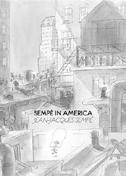
Tribute to a beloved artist.
French cartoonist JeanJacques Sempé (1932-2022) was well-known for his instantly identifiable covers for the New Yorker, to which he began contributing in 1978. In his characteristic delicate lines and pastel hues, Sempé captured what he saw as the essence of a country that enchanted him from the first time he visited in 1965. His cartoons, covers, sketches, and doodles (170 illustrations in all), accompanied by essays translated by Dylan Rocknroll, make for a charming volume that reveals the “elegance, tenderness, and lucidity” of a unique artist. François de Closets, Cape Kennedy correspondent for L’Express, recalls his colleague at the Houston Space Center during the Apollo moon launch in 1969. Sempé recorded his impressions of the gigantic rocket, the powerful technology, and the irony: in one cartoon, apartment dwellers all over Manhattan watch the
moon on their televisions, while a huge, bright orb shines in the night sky. Janick Jossin recalls how Sempé, at L’Express, caught the “spirit of the times” in his drawings just as journalists did in their writing. Susan Chace describes the decaying, garbage-strewn Central Park that tourists avoided in the 1960s and ’70s. Yet Sempé loved walking through the park, with its joggers, bicyclists, and grumpy old people who lined its benches. His “amused gaze,” portrayed a lovely expanse, welcoming and bucolic, where “fear and decline were absent.” Journalist and lyricist Philippe Labro offers an affectionate recollection of Greenwich Village in the 1960s, a time of “violence and creativity,” music, and hippies, which Sempé captured in “brilliant sketches.” Sempé often took a lofty perspective— perhaps the rooftop of an apartment building where, in one cartoon, he drew a little girl gaily jumping rope. It was a view filled with wonder.
A delightful homage.
Serra, Maurizio | New York Review Books (600 pp.) | $29.95 paper Nov. 19, 2024 | 9781681378701
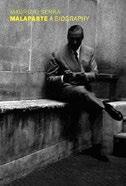
A searching life, by diplomat and historian Serra, of Italy’s arguably most enigmatic writer.
Born Curt Suckert to a middle-class German father, Curzio Malaparte cultivated aristocratic pretenses and was narcissistic, contrary, and ungovernable. He was also a brilliant writer and subtle thinker with a genius for being on the outs with whoever was in power and for making enemies; as Serra puts its, he “almost always ended up on the wrong side, with a love for lost causes (if not losers) that is hard not to admire.” That depends on your viewpoint: Malaparte championed
Mussolini, after all, if in a qualified way, with a rather confusing political agenda that for a time embraced the strange-bedfellow fascismo rosso, “red fascism,” suppressed the minute Mussolini actually came to power. Malaparte did much as he pleased all the same, and, surprisingly, he was only occasionally in trouble for it: he self-published sometimes subversive books, built the modernist house made famous in Jean-Luc Godard’s film Contempt , and went to the Russian front to report on how the war was going for the Nazis (who weren’t pleased by his conclusions), all capped off by his magnificently eccentric memoir-cum-war novel Kaputt . To this day Malaparte defies easy categorization: Che Guevara and European neofascists alike read his political essays; American intelligence agents gave him a pass even as top Italian communists befriended him; and at the end of his life, briefly dazzled by Mao Zedong, he traveled to China to see yet another revolution in the works. In this ambitious corrective to Malaparte’s self-mythologizing, Serra writes that he was consistent in at least one way: “Malaparte does not take anyone’s side, never forgets his role as an observer and often as a voyeur, in a Proustian sense.”
A rewarding essay in modern Italian intellectual history as embodied by one of its most curious figures.
Sheffield, Rob | Dey Street/ HarperCollins (224 pp.) | $27.99 Nov. 12, 2024 | 9780063351318
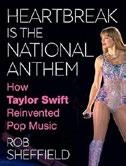
Tracking Taylor Swift from precocious teen to pop-music juggernaut. Why is Taylor Swift a cultural lightning rod? Why do people love—or hate—her and her music so
much? Those are the questions that Sheffield, a music journalist and self-avowed Swiftie, seeks to answer in this zippy and engaging work. Swift has been in the public eye for almost 20 years. Even though she sells out stadiums around the world, she remains an enigma, says Sheffield. “To some,” he writes, “Taylor is a creative genius, a cultural force, a feminist rebel crashing history with her girls-to-the-front energy.” To others, she’s “a symbol of capitalism, privilege, self-absorption, self-pity.… A factory of insipid tearjerkers.” Perhaps it’s because Swift is a shape-shifting mirror, reflecting her fans’ emotional ups and downs. A fan since her country-music days, Sheffield reads her lyrics as if poring over tea leaves. What do they say about her? More importantly, what do they say about him? “When I hear myself in her songs, it’s often the parts of me I try hardest to keep covered up and tied down. I’m threatened by the hairpin trigger in her songs, her constant edge of emotional danger.” Curiously, one doesn’t get much of a sense of what Swift’s music actually sounds like. While Sheffield cites song lyric after song lyric, he describes her music sparingly: “seething electronic pulse…a stark goth-folk sound.” The book is the most engaging when Sheffield shows what Swift means to him. After his mother’s funeral, he found himself singing Swift’s “The Archer” to give voice to his sadness. “Just another heartbroken son yelling Taylor Swift lyrics at four lanes of late-night truckers and bikers and speed freaks and streetlights, none of them impressed.”
An affectionate homage from an ardent fan.
Tepper, Jennifer Ashley | Applause (408 pp.)
$39.95 | Nov. 19, 2024 | 9781493080311

The unsung women behind Broadway musicals.
In 2020, stuck in her Manhattan apartment, theater historian Tepper “began to think about other New Yorkers who worked in theatre, and lived through unprecedented historic events.” This led to “thinking specifically about female theatre makers who had overcome obstacles throughout the decades, and created notable works— and yet were not adequately represented in history.” Hence this book, an encyclopedic reference that offers appreciations of women “who wrote stage musicals that were produced on Broadway and off-Broadway, starting in the eighteenth century and through to present day.” Tepper has arranged this work chronologically, beginning with artists such as Ann Julia Hatton, whose 1794 Tammany; or The Indian Chief “is widely considered the first libretto written by a woman.” She then proceeds to early-20th-century pioneers and current-day artists such as Quiara Alegría Hudes, who wanted to “present Latinx characters on Broadway who were not gang members” with her book for In the Heights, and Cyndi Lauper, who, with Kinky Boots, “became the first woman to ever win the Best Score [Tony] award as a sole writer without a collaborator.” Some entries are as short as a sentence. Prominent figures receive more space, such as Dorothy Parker, the
A pop star who sells out stadiums and remains an enigma.
“outspoken, sardonic, and unapologetic” wit whose credits included the book to Candide, and Dorothy Fields, who contributed books or lyrics to many musicals from the 1920s to the 1970s, including Annie Get Your Gun and Sweet Charity. It’s a fun, important book, albeit one to dip into rather than read straight through. And there are odd, unexpected connections, such as that “future pop legend” Toni Tennille’s 1972 Mother Earth was produced by 32-year-old Roger Ailes, who helped by “raising the money for it from Nixon supporters who were grateful he had helped Nixon get elected.”
A long overdue tribute to female lyricists and composers.
Tinniswood, Adrian | Basic Books (448 pp.)
$34.00 | Nov. 12, 2024 | 9781541602793

Picture books on English country houses are an ongoing genre, but this is a genuine work of history. Mixing research and gossip, historian Tinniswood has written
three volumes on his favorite subject. Although this first volume summarizes its long history, the author concentrates on the golden age of the country house between 1870 and 1914, when hundreds were built or drastically remodeled and a great deal of new money was invested in what was widely if not universally believed to be “a supremely attractive, if mythic, vision of the past.” British media and magazines such as Country Life glamorized the country, persuading successful businessmen from around the world to live in titanic mansions surrounded by vast estates. Tinniswood knows his subject, but readers may be surprised to discover that there are no illustrations. A coffee-table book such as The Country House by David Cannadine might help readers as an additional
reference when Tinniswood delves into architectural, interior decorating, and landscaping details. There are the expected topics—gardens, hunting, servants, royal visits, foreign villas, the arrival of the automobile, and modern conveniences. Readers with a taste for action will welcome accounts of country house fires, country house crimes, and owners’ often spectacular sexual peccadilloes and divorces. Imported, mostly American plutocrats make their mark, and readers will receive an education in upper-class antisemitism, traditional but not universal and less vicious than the Continental version. An entertaining mélange of scholarship and scandal.
Wilson, Randall K. | Counterpoint (416 pp.)
$30.00 | Oct. 8, 2024 | 9781640096653

History of the exploration of the Yellowstone River country and its establishment as the world’s first national park.
Yellowstone, writes Gettysburg College environmental studies professor Wilson, “is remarkably distant from just about everywhere and everyone else in the continental United States.” For all that, it draws 4 million visitors a year. It was always remote, little settled by Indigenous people until relatively recently. Early on, an American explorer with a background in geology, a junior Army officer named Gustavus Cheyney Doane, recognized that Yellowstone was a vast caldera formed by ancient volcanic action; by Wilson’s reckoning, the “largest recorded eruption in human history,” that of Indonesia’s Mount Tambora, blasted out just 6% of the volcanic debris that Yellowstone’s last eruption did—and, as catastrophists are fond of pointing out, Yellowstone is long overdue for another. Wilson’s early
explorers made for a hardy breed, though strange: The Sioux who encountered one geologist at work must have thought he was crazy for carrying a backpack full of stones, and they left him alone for it—adds Wilson, “In human cultures across the world, mental illness (real or imagined) is often cause for compassion rather than hostility.” Although cattle ranchers and miners resisted the effort, Yellowstone finally became a national park, helped along in the end, Wilson reckons, by a strain of 19th-century Romanticism that held that nature “offered humans a path to moral and spiritual well-being and deserved respect for its own sake.” Surprisingly, magnate John D. Rockefeller, as Wilson shows, was highly instrumental in protecting the park. Bedeviling park naturalists then and now was how to balance human visitation with protection for wild animals, which today include restored populations of wolves, grizzly bears, bison, and other creatures. A capably drawn portrait of an iconic American place that remains of world significance.
Zebley, Aaron, James Quarles & Andrew Goldstein | Simon & Schuster (288 pp.)
$28.99 | Sept. 24, 2024 | 9781668063743
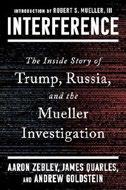
Prosecutors meticulously correct the record on Russian meddling in the 2016 presidential election.
The authors, who worked under special counsel Robert S. Mueller III during his high-profile federal investigation, aim to clear up lingering “confusion” about their findings. Recognizing that portions of the 448-page report they completed in March 2019 were “not as clear as we had hoped,” they don’t equivocate: “It is beyond dispute that
the Russians interfered in the 2016 election to support [Donald] Trump,” using social media and emails stolen from Democratic Party computers in an effort to boost Trump and villainize his opponent, Hillary Clinton. There’s no way to measure “the effect, if any,” this had on the result, yet “it is undeniable” that Trump’s campaign “organized a press strategy” based on information pilfered and released by Russian military hackers. The authors argue that persistent misinterpretations of their findings stem from statements that William Barr, Trump’s attorney general, made after Mueller filed his report. Mueller cited multiple “episodes” in which Trump potentially obstructed justice. But because the Justice Department holds that Congress, not prosecutors, must decide whether to allege wrongdoing on the part of a sitting president, Mueller declined to make a “traditional prosecutorial determination” on charging Trump. Crucially, Mueller’s report is neither a criminal indictment of Trump nor an exoneration. Barr, however, declined for weeks to publish “our analysis and our words” on potential obstruction, instead releasing his own “inaccurate and incomplete” summary, which omitted Russia’s backing of Trump and wrongly stated that Mueller’s report “identifies no actions” by Trump that “constitute obstructive conduct.” This “fundamentally undermined” the report’s conclusions “and made it more difficult” for citizens to understand what Mueller, in a preface, calls Russia’s “multiple, systematic attacks” on democracy. With another election drawing near, “Russia is interfering again,” the authors write, declining, alas, to elaborate. An essential account of Russia’s ongoing attempts to disrupt American elections.

For more books about Donald Trump, visit Kirkus online.





I’M ALWAYS IN awe when I read transitional books— stories that bridge the gap between picture books and longer middle-grade works. The authors of these titles face a difficult task: creating accessible tales that, using limited word counts and simple vocabulary, will still captivate children. When they succeed, the results are pure magic. The following selections, a mix of early readers, chapter books, and shorter middle-grade titles, will set youngsters on the road to becoming confident and passionate readers.

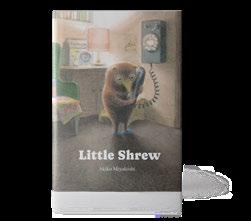

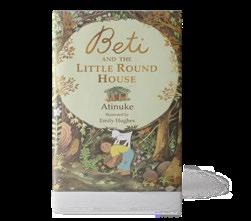

Born Naughty: My Childhood in China , written by Jin Wang with Tony Johnston, illustrated by Anisi Baigude (Anne Schwartz/Random, May 7), is an aptly named memoir; Wang’s chronicle of growing up in a small village in Inner Mongolia in the 1980s is filled with tales of mischief. She’s matter-of-fact about the harsh conditions her family endured—their one-room mud house, water scarcity—yet young Jin’s indominable spirit permeates the work; readers will find this a fascinating introduction to the genre.
Translated from Japanese, Akiko Miyakoshi’s Little
Shrew (Kids Can, June 4) follows an earnest creature who leads a simple, largely solitary existence—days spent working an office job, evenings devoted to doing chores, both punctuated by small, unexpected joys such as solving his Rubik’s Cube. Miyakoshi has an eye for the seemingly mundane details that add up to a richly rewarding life, while her graceful, finely honed illustrations depict an endearingly tiny anthropomorphized protagonist, one of the few animals in a world of humans.
The protagonist of Liz Garton Scanlon’s Bibsy Cross and the Bad Apple, illustrated by Dung Ho (Knopf, June 11), is thrilled about the start of third grade—until she meets her new teacher. Dour Mrs. Stumper, frustrated at Bibsy’s talkativeness, often moves the paper apple
bearing Bibsy’s name to the bottom of the class bulletin board—an embarrassing punishment for a child who’s always considered herself an enthusiastic student. Scanlon has crafted a compelling portrait of a sensitive, thoughtful youngster who stays true to herself even as she confronts the harsh reality that some adults can’t see kids as they truly are.
Atinuke’s Beti and the Little Round House (Candlewick, Oct. 8), illustrated by Emily Hughes, centers on a young girl and her family who live off the land, building a forest home out of trees, earth, and grass, picking berries, and raising domestic animals. Atinuke and Hughes have conjured up an idyllic world. Beti has the freedom to try new things and make mistakes—in an especially memorable
episode, she figures out how to refill the family’s water jug—though she’s always bolstered by a tightknit and loving community of friends and neighbors.
Kid lit is filled with saccharine stories of curmudgeonly characters seeing the error of their ways; this isn’t one of them. Kiah Thomas’ Lone Wolf Goes to School (Neal Porter/ Holiday House, Oct. 8) follows a lupine misanthrope who goes in search of solitude but finds people everywhere he turns. Refreshingly, Thomas brings the tale to a subversively funny conclusion that sees her protagonist remaining his cranky self; K-Fai Steele ramps up the humor with illustrations of the bug-eyed Wolf chafing at his cheerfully oblivious peers.
Mahnaz Dar is a young readers’ editor.
His family and friends in Panamá have big dreams for Danilo, but he isn’t sure they’re his dreams.
Set in 1990 just after the United States’ Operation Just Cause, an invasion centered on ousting dictator Manuel Noriega from Panamá, this novel centers on Danilo Osorio Jr. After a knee injury sustained while playing baseball led to him losing his construction job, Danilo’s father left for the States. But the calls and letters have stopped coming, and he’s not sending home any money. After the Osorios’ apartment in El Chorrillo is damaged in an airstrike, Danilo, his
mother, and his younger sister, Amara, are forced to relocate to a refugee center in an airplane hangar. All seems lost until Danilo is recruited to play on a youth baseball team in California for a couple of months. Danilo isn’t sure he cares about baseball anymore, but he realizes this might be a chance to contact Papá. Burgess skillfully covers a lot of ground in her representation of events that are seldom discussed in U.S. history books but that devastated Panamá and its people. Danilo’s journey is fast paced, heartfelt, and heartbreaking. The trauma, dislocation, and devastation

weighing heavily on him are palpable as he tries to adjust. His new teammates, who are predominantly white, are dismissive and exclude him socially; he also faces a slew of culturally
insensitive and ignorant remarks thrown at him as a Black Panamanian boy in the U.S.
A compelling book that’s here to stay. (Historical fiction. 8-12)
THE EIDI BAG
Yasmeen Lari, Green
Architect: The True Story of Pakistan’s
First Woman Architect
Abbas, Marzieh | Illus. by Hoda Hadadi Clarion/HarperCollins (40 pp.) | $19.99 Oct. 22, 2024 | 9780063285156

The career of Pakistan’s first professional female architect gets an appreciative overview. Pointedly characterizing her subject as a “great listener” and consequently a “great learner” even in childhood, Abbas follows Yasmeen Lari’s rise to “starchitect” status as she worked with “fickle and tough” clients on new projects in Karachi—and then switched her focus to preserving her country’s historical buildings. In the wake of the massive 2005 earthquake that struck northern Pakistan, she began studying traditional vernacular structures in towns and villages. Exchanging concrete, glass, and wood for bamboo, mud, and lime, she went on to design new ones more resistant to natural disasters and, in a grassroots initiative she’s dubbed “barefoot social architecture,” to train local residents to build them (40,000 so far). A strong, confident presence both in Hadadi’s brightly hued collage illustrations and the photo spread at the end, Lari actively scrapes and washes aging walls, works intently with plans and models, and dances her way past high-rises and mud-walled huts and through ornate arches and bamboo thickets. The book ends with a regal illustrated portrait and recent photographs of Lari leading an intent class of traditionally clad female students. “Yasmeen had tackled every challenge that came her way. She’d listened to the pleas of the planet and the
woes of the villagers. Now the world listens to Yasmeen.”
An inspiring portrait of a woman whose achievements have been both literally and figuratively groundbreaking. (more about Yasmeen Lari, author’s note, glossary, timeline, selected sources) (Picture-book biography. 7-9)
Afzal, Shazia | Illus. by Shiva Delsooz | Owlkids Books (32 pp.)
$18.95 | Jan. 7, 2025 | 9781771475426

A young girl celebrates Eid in a new way in a new home.
It’s Eid al-Fitr, and this one is special for Sarah—it’s her family’s first time observing the holiday in their new country since leaving Pakistan. With a small, beautifully embroidered pouch in hand, Sarah asks family members for her money gift, or eidi. Mama gently reminds Sarah to wait to be offered eidi, but Sarah can’t contain her excitement and sweetly plans how she will use the money she collects later at the mosque to buy gifts of her own to give. Her enthusiasm turns to disappointment when her friends and extended family acknowledge her pouch but don’t give her any eidi. Back at home, as she helps prepare food for the guests of their open house, Sarah feels unsure when Mama explains that things are different in their new community. But one by one, guests arrive with gifts in hand—candy, a box of markers, and more. Afzal allows readers to see the world from Sarah’s perspective as the girl finally understands that there isn’t one single way to celebrate Eid. The
youngster rides a roller coaster of emotions as she navigates novel situations—a feeling that will resonate with many children, especially those joining a new community. Delsooz’s brightly colored, exuberantly scribbly illustrations imbue this important Muslim holiday with warmth and excitement. An accompanying glossary and author’s note are welcome support. A festive tale that teaches valuable lessons of resilience and adaptability. (Picture book. 4-8)
Atinuke | Illus. by Emily Hughes Candlewick (128 pp.) | $18.99 Oct. 8, 2024 | 9781536225181

Sweet, precocious Beti and her baby brother, Jac, live in a little woodland house built by their parents, Mam and Tad. Made up of four sections that span the year, the book opens in spring with Beti celebrating her birthday. Tad gives her a goat (“So you can have milk every day!”). Beti’s initially irritated by Goat’s rambunctious baby but eventually comes to appreciate her gifts. The second tale takes place in summer, when Beti and her friends rely on the power of teamwork as they travel to the waterfall to refill the family’s water jar. In autumn, Beti goes berry picking with Mam, then gets separated from Tad during a storm that rages like a dragon. Winter sees Mam and Jac dealing with colds when Tad is away visiting Granny in town, leaving it up to Beti to care for the animals. Though Beti tries to do everything right, things often go awry, but she can count on reassurance from Mam and Tad. Depicting a loving, tightknit community of friends and neighbors, Atinuke weaves an enchanting world where characters live off the land, eschew technology (cell phones
exist, but Mam and Tad opt not to use them), support one another, and appreciate the small pleasures of life. The author creates a sense of warmth and tranquility, while Hughes’ lush, verdant illustrations evoke comfort and safety—this is a world readers will eagerly return to. Tad, Beti, and Jac present Black, while Mam appears white. An absolute charmer. (Chapter book. 5-9)
Baker, Keith | Beach Lane/Simon & Schuster (24 pp.) | $9.99 | Dec. 3, 2024 9781665940221 | Series: The Peas

Baker’s industrious, pea green micro-veggies return to celebrate Valentine’s Day. This cheerful tale focuses on celebration, cooperation, friendship, and heart-shaped everything: “pocket hearts” (the stitching on jeans), “chalky hearts” drawn on sidewalks, the “fluttery hearts” of butterflies’ wings, and “pizza hearts,” of course. (These peas are enthusiastic, opportunistic snackers.) While the rhyming text can be choppy in spots, Baker’s clever visual interpretations of the theme have plenty of compensatory charm as these busy legumes prepare— and share—their exuberant messages of love. They drive construction equipment up a mountain of candy hearts, tend a plot of heart-shaped flowers in the glow of a (heart-shaped) sun, excavate pink cookies from a gigantic jar, and load brimming bags of valentines into heart-patterned hot air balloons, scattering joy below. Sharp-eyed kids will spy not only a returning ladybug, but also a winged, pea-bodied Cupid who appears throughout, aiming to spread even more love. The peas have various hairstyles and wear different accessories, including hats and eyeglasses; one uses a wheelchair. Though all the peas are green, they vary somewhat in shading. A final illustration depicts Cupid, mission accomplished, peacefully slumbering on a pillowy cloud.
An amusing valentine confection, delivered in high style. (Picture book. 2-7)
Boldt, Mike | Dial Books (56 pp.)
$19.99 | Feb. 25, 2025
9780593697771 | Series: Can Do

Globular buddies roll into a tricky new project that promises a yummy reward. Their general approaches spelled out in the first and last letters of their respective names, hesitant Cant aloupe and impetuous HoneyDo start with a bagful of groceries. Through a gloriously messy process of trial and error, and with guidance from Cantaloupe, HoneyDo learns all about measuring ingredients rather than simply dumping them into a bowl. The friends mix various items together in the proper order, wait for what seems like an eternity in front of the oven (“Is it done yet?” “Now?” “No.” “Now?” “No.” “Now?” “No.” “Now?” “No.” “Now?” “No”), slather on the frosting, and eventually enjoy the woefully misshapen but richly chocolatey results. “Delicious! We CAN make a cake!” The two photographed, increasingly spattered melons have cartoon stick limbs and comically exaggerated expressions. Rapid repartee in dialogue balloons drives the cheery shtick of their interactions. The ta le ends with the two lying on the floor after HoneyDo slams down a big, red cherry on top; the pair chow down delightedly amid the crumbled remains of their labors. Budding bakers may be bummed that the book lacks specific instructions or measurements—but it’s really more about the fun of working together than making anything specific.
A lip-smacking recipe for productive collaboration. (Picture book. 5-7)
Bonilla, Lindsay | Illus. by Brizida Magro | Nancy Paulsen Books (32 pp.) $18.99 | Feb. 4, 2025 | 9780593529140

A family deals with the loss of a child.
“Matty’s gone,” and his parents and sibling (who narrates the story) are struggling with the feelings left behind, symbolized here as holes and depicted as scrawled, tight spirals in the middle of characters’ chests or on items that Matty once used. The protagonist is trailed everywhere by a hole. While some classmates don’t know how to provide support, many admit to living with holes of their own, representing other dearly departed family members. One day, the protagonist sees Matty’s best friend running and playing and feels upset. With the support of a friend named Nora, the child descends into one of the holes and finds comfort in crying, shouting, and throwing clumps of dirt. Nora invites the narrator to talk more about Matty, and the tale ends with the realization that “I don’t hate that hole. Not anymore. Because I know I can always fill it with memories of him.” This thought-provoking, poignant look at mourning never explicitly names death but makes concrete a euphemism that could be confusing to children while showing that love for a deceased family member always endures. In Magro’s striking collage illustrations, the protagonist is light-skinned and redheaded, while Nora is brown-skinned with three puffs atop her dark hair.
A unique and hopeful exploration of grief. (Picture book. 4-7)
Kirkus Star
Bouwman, H.M. | Neal Porter/ Holiday House (320 pp.) | $18.99 Jan. 21, 2025 | 9780823457755

In 1941, against the backdrop of turbulent world events, life unfolds in a tightknit, largely Quaker farming community where friends and family are one and the same.
Precocious, math-brained Peggy Mott, a Methodist 12-year-old who presents white, is the youngest student entering high school in rural West Branch, Iowa. Peggy is grappling with best friend Delia’s leukemia diagnosis, a first crush (on 16-year-old German Jewish refugee Gunther), a first dance, and changing relationships with friends and family. Refugees from Europe, mostly Jewish, have been staying at the nearby Scattergood Hostel, which is run by Quakers. Bouwman paints a rich, detailed landscape, from mundane farm chores to deeply layered explorations of characters and relationships. Peggy’s astute and observant first-person narrative captures her personal journey as she struggles with self-awareness, stages of grief, and her changing perspective as she’s exposed to the greater complexities of the world. Equal parts tender and heartwarming and tragically heartbreaking, this story, which will appeal to fans of Lauren Wolk, also offers a realistic depiction of marriage, showing compromises, challenges, and the different ways people care for and love each other. Readers will become deeply invested in the fully developed characters—each flawed and human but doing their best, Peggy included. The power of stories to connect people with others, bear witness, and create joy is an interwoven theme running throughout the text.
An engaging, textured, and deeply humane coming-of-age novel. (author’s note) (Historical fiction. 9-14)
Boxer, Elisa | Illus. by Sofia Moore
Rocky Pond Books/Penguin (32 pp.)
$18.99 | Oct. 15, 2024 | 9780593698174
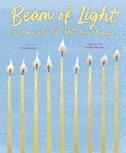
The story of the White House’s first menorah, narrated by a wooden beam salvaged after the presidential residence was renovated in 1948. Though reluctant to leave, Harry S. Truman agrees that the crumbling mansion requires a major overhaul; the first family moves out, and work begins. As the White House’s interior is razed and rebuilt, our narrator reflects on “a deeper level of destruction” it once witnessed. In 1943, hundreds of rabbis visited President Franklin Roosevelt to implore him to offer Eastern European Jews safe haven in the United States; Roosevelt refused, and millions of Jewish people subsequently perished in the Holocaust. (An author’s note in the book’s first printing erroneously references Theodore Roosevelt.) “I was supposed to be destroyed,” the beam repeats in a poignant refrain. Yet through it all, the narrator is somehow rescued. It sits in a storage warehouse for years until 2022, when woodworkers transform it into a menorah and President Biden introduces it as the “first Jewish artifact ever added to the White House’s permanent collection.” Previous administrations lit menorahs that were only temporarily on loan, but, as the beam-turned-menorah tells readers, “I can never be removed.” In this moving account, the humble menorah symbolizes the ancient miracle of salvation, as well as Jewish resilience and “strength for generations to come.” The muted,
dignified illustrations echo the solemnity of the text, effectively capturing historical details and settings.
An inspired and stirring tale to share at Hanukkah—or any time of year. (Informational picture book. 7-10)
Brett, Jan | Putnam (40 pp.) | $19.99 Nov. 26, 2024 | 9780593533888
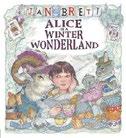
A retelling of Alice’s Adventures in Wonderland , set in the Alaskan tundra. Prolific picture-book author and illustrator Brett depicts Alice with short black hair, tan skin, and a fur-lined parka, while Lewis Carroll’s wellknown characters are recast in new guises: The Cheshire Cat and Queen of Hearts appear as a Smilodon (sabertoothed cat) and snowy owl, respectively. Progressing at a rapid-fire pace, the narrative follows key moments of the original plot, including Alice’s fall down the rabbit hole (located within a glacier here), her tea party with the Hatter and the March Hare (this time, with the Old Prospector and the Varying Hare), and a scene where several playing cards paint the roses red (instead, the cotton grass) at the Queen’s behest. Characteristic of Brett’s illustrative style, each spread is packed with detail. Observant readers will find much to explore, from the well-worn playing cards that line each page to the intricate Alaskan birds and mammals featured at every turn. Still, the hectic rhythm of the story might lose youngsters, and its ho-hum text flattens some of Carroll’s whimsy. Adults may be disappointed that Brett has chosen to highlight only the area’s animals and
An engaging, textured, and deeply humane coming-of-age novel.
SCATTERGOOD
colonial history (the Prospector hearkens back to Alaska’s history of colonial encroachment), with no explicit mention of the land’s rich Indigenous nations and cultures. A visually engaging but otherwise underwhelming take on a classic. (Picture book. 5-7)
Broach, Elise | Illus. by Kelly Murphy
Christy Ottaviano Books (128 pp.) | $6.99 paper | Jan. 21, 2025 | 9780316564175
Series: Bulldozer and Friends, 1
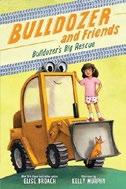
Broach and Murphy rev up for a promising new series starring a lonely anthropomorphic construction vehicle. Bulldozer’s usually on his own: His older sisters have their own social lives, and a pair of older twins who live nearby don’t want to play. He worries about making friends when school starts. His mom (a human, like the other characters) maneuvers him into welcoming the new family across the street—“a terrible idea,” in Bulldozer’s opinion, because meeting strangers is scary and hard. He really does want a playmate for his racetrack, so he complies—then contends with shy but bossy Millie Patel and her annoyingly voluble little brother, a cat in a tree, a pile of boxes that need to be moved, and feeling underappreciated. By book’s end, though, he’s made a friend; he’ll also garner a loyal following of readers who will eagerly anticipate his next adventure. Bulldozer’s monologue and the characters’ dialogue are spot-on, beautifully conveying the protagonist’s doubts and fears, irritations and resentments, hopes and wishes, and pride at stepping out of his comfort zone. Murphy’s graceful, two-color line drawings depict our hero as small (for a bulldozer) but sturdy, with a saffron-colored cab. He has “big
black tires that get hot in the sun” and an expressively mobile mouth on his windshield. The characters are realistically portrayed against minimal backgrounds; Mom is light-skinned, while the Patels are cued South Asian. An enthralling tale about doing the heavy lifting of making friends. (grammar activities) (Chapter book. 5-8)
Brown, Don | Abrams Fanfare (128 pp.)
$15.99 | Jan. 21, 2025 | 9781419773310
Series: Big Ideas That Changed the World, 6

A graphic tour of ways we measure and think about time, squired by (who else?) Albert Einstein. Using nonmathematical language to explain the mind-bending ins and outs of time to young audiences constitutes a challenge, even with help from the world’s greatest scientist—a challenge that Brown meets with aplomb. He starts out with such easy stuff as the history of timepieces, from the 364 steps of the great pyramid at Chichén Itzá to John Harrison’s nautical clock and why we divide a day into 12 parts. (It has to do with knuckles, specifically ancient Egyptian ones.) Things get more complicated when Einstein describes how he revolutionized Newton’s and others’ notion that time moves at its own invariable speed with the counternotion that because light has constant speed, the pace of time has to change, depending on how fast things go relative to one another. “Patience,” he counsels through his brushy mustache, marshalling such classic examples as a moving train with a stationary observer. “It will all make sense.” Thanks to Brown’s cogent explanations, it will, in time…and with some digging into the substantial appended bibliography. Along with brilliantly challenging readers to realize just how
much remains to be learned about how our universe ticks, the author leaves them with further puzzlers to ponder, such as whether time comes with a beginning and an end. Humans are rare in the loose, spare cartoon art. Expansive, engaging, and lucid. (timeline, biographical note) (Graphic nonfiction. 11-13)
Brown, Tameka Fryer | Illus. by Alleanna Harris | Farrar, Straus and Giroux (32 pp.) $18.99 | Nov. 5, 2024 | 9780374391010

A Black family celebrates their little one’s achievements. All children rely on the love and support of their caregivers, but they also need the space to take those first forays into independence—a truth that Brown clearly understands. Her book opens with a parent lovingly addressing a child: “Look at you. / I can’t believe / how quickly you have grown.” The parent adds, “Just yesterday, we did the things / you now do on your own.” But now? “You make your own bed. / You pick your own ’fro. / You dress your own self. You’re raring to go.” The youngster eagerly helps out with other tasks: cooking, washing dishes, gardening, and more. Most importantly, the child also demonstrates strength in the face of challenges. Scenes of the youngster taking a tumble during a soccer game are followed by tears, but, as the narrator points out, “Resilience is what counts / when times get rough. // Your best is enough.” Brown’s matter-of-fact verse thrums with a gentle energy, accompanied by Harris’ winsome illustrations, which radiate love. Subtle Christian undertones appear in both text and art; at one point the parent refers to the youngster as “a gift and a blessing / I’ll cherish forever,” and the story concludes at church, with the child performing a solo in a gospel choir. Thoughtful and empowering. (Picture book. 4-8)
and awfully sweet—in short, a quackin’ good time.
SEVEN LITTLE DUCKLINGS
Bussing, Kim | Random House (304 pp.)
$17.99 | Jan. 7, 2025 | 9780593708033
Series: The Princess Swap, 1

Two heroes trade places in a lightweight fairy-tale mashup. After some magical shenanigans, Belle, the daughter of a down-on-his-luck widower, wakes up one morning lying in a fireplace and facing a woman and her two daughters, who demand that she act as their servant. Elsewhere in Reverie, Ella, an orphan with a glass leg, is being kept captive in an enchanted castle by the beast of the woods. Both girls display considerable pluck and intelligence, standard-issue characteristics in fairy-tale reimaginings. The twist comes from the introduction of a third hero—a rebellious, bad-tempered princess who’s mysteriously disappeared from the capital city of Miravale. Belle teams up with the princess’ brother, Crown Prince Amir, in an effort to discover her whereabouts and escape her own servitude. Does the missing royal have anything to do with the grumpy beast living in the cursed castle in the forest, now befriending Ella? Many readers will spot the stories’ connections long before the official reveal, but they’ll nevertheless appreciate the resourcefulness and empathy of each of the girls as they strive to overcome their magical obstacles and help those around them. Bussing takes the popular trope of reframing villains’ stories to an intriguing extreme by offering everyone (even Ella’s stepmother) sympathy and psychological
motives for their misbehavior. Ella and Belle are cued white; Amir and his sister have olive skin and dark hair.
Devourers of fractured fairy tales will enjoy this kindhearted take on two classics. (Fantasy. 8-12)
Cate, Annette LeBlanc | Candlewick (40 pp.)
$18.99 | Jan. 7, 2025 | 9781536235746
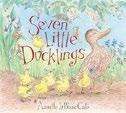
Will this mother duck find her seven babies? Cleverly doing double duty as a counting book and a bedtime story, this tale opens on a soothing note. “In the dark, quiet night, / when the pond’s all at rest, / a plump mother duck / is asleep on her nest.” A double-page spread portrays a contented duck and her eggs at the brushy edge of a large body of water against a serene moonlit sky. The eggs hatch as she slumbers, and all the ducklings but one venture off on their own. Awakening, Mama “looks around frantically” but finds “nothing but shells.” The expressive watercolor-and-ink art is integral to an increasingly hilarious plot: As the mother duck frantically gathers her own youngsters, she also unwittingly collects equally winsome avian babies who didn’t hatch from her eggs. A turtle ends up in her entourage, and she even pops a “wee / flailing” mouse on her back. Readers will enjoy counting along with Mama—and recognizing at least some of her blunders. By the time the last little one rejoins the group, there are 13 happy babies. The rhyme and the rhythm of the text set a jaunty tone ideal for read-alouds. Infusing her story with
wit and whimsy, Cate brings the tale to a wonderfully tender conclusion—a testament to the power of maternal love. Original, laugh-out-loud funny, and awfully sweet—in short, a quackin’ good time. (Picture book. 4-7)
Clarke, Bethan | Illus. by Nikolas Ilic | Tiger Tales (32 pp.) | $18.99 Feb. 18, 2025 | 9781664300644

A snide shark with an arrogant attitude disses the fishes.
Snarky Sharky has nothing but scorn for the other sea dwellers: the octopuses, who “literally suck,” the sea stars, who are “always missing the point,” and the irritatingly cheerful dolphins (“It’s like they do it on porpoise to annoy me”). When a clown fish tries to be BFF (“Best Fishies Forever”), Snarky jeers: “I’m on a sea food diet. And all I see right now…is you.” Snarky gobbles up the little fish only to spit it out: A clown fish naturally tastes “funny.” Concluding that “this reef is beneath me,” Snarky makes an “o-fish-al” exit, accompanied by cries of “Carpe diem” and “Seas the day” from the other wildlife. Smugly proclaiming, “I’m kind of a big deal,” Snarky’s overshadowed by a much larger maw in search of a “big meal.” Snarky’s last word? “Gulp.” Snarky’s small golden eyes are topped with fierce-looking eyebrows, but it’s the shark’s rows of seemingly endless pointed teeth in a sneering mouth that dominate. The reef inhabitants are candy colored and cartoonishly animated. The barrage of nonstop puns will have many older readers groaning, though they may go over some kids’ heads; at times, the tale feels a bit one-note. Still, younger audiences will appreciate the visual details and the exaggerated images. A few hints on the endpapers suggest that the huge final beast might be a megalodon. Brutally punny text enlivened by goofy illustrations. (Picture book. 4-7)
Coelho, Joseph | Illus. by Allison Colpoys | Thames & Hudson (40 pp.) $19.95 | Oct. 29, 2024 | 9780500653333

When bedtime is the goal, art and poetry mix together for the greater (sleepier) good.
Poet and former Waterstones Children’s Laureate Coelho finds sleepy beauty in 14 different works of art. Explaining that “the works of art I have chosen in this book each made me feel relaxed,” he’s constructed sleepy-time poems for each one. A view of Vincent van Gogh’s The Starry Night yields a musing on the “River Sky”: “I gaze upon the starry night / it twists into a river-sky / my every breath, a swirling light / I gaze upon the starry night.” Most of the other art selections will prove new and unfamiliar to young and adult eyes alike. Yayoi Kusama’s Infinity Mirrored Room and Faith Ringgold’s Tar Beach inspired poems that will speak to readers’ imagination as they drift off. For the most part, Coelho’s poetry is solid, though some entries veer into tepid, repetitive writing. But the book’s explicit purpose is to get kids on the path to slumberland, and here it succeeds. Backmatter offers guidance on using “Art as Therapy at Bedtime,” including how to become your child’s “sleep facilitator,” along with a treatise on why lullabies are so calming. Additional information on the artworks is appended.
A title sure to spur sleepiness, with appropriate verse to match. (Picture book/poetry. 3-6)

Colombi, Chiara | Illus. by Scott Magoon | Viking (32 pp.) | $18.99
Feb. 4, 2025 | 9780593526064
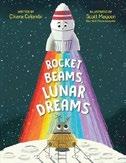
The protagonist of Rocket Ship, Solo Trip (2024) embarks on a voyage that’s not quite what she had in mind. Rocket Ship’s long yearned to go to the moon, but there’s been a change of plan. She’ll blast off into space, but she’ll be ferrying Lunar Lander, who will actually descend to study the moon’s surface and crust while she remains in orbit. Can Rocket Ship rise above her disappointment? Once the two are in space, uncertain Lunar Lander turns pale and quakes; Rocket Ship must overcome her jealousy to help him vanquish his fear of heights. Interspersed throughout this budding friendship story are basic facts about the moon, its phases, and the logistics of space travel. Dialogue between Rocket Ship and Lunar Lander and between the two space voyagers and ground control keeps the narrative moving at a fast clip. Unusual word placement on some pages adds whimsy and action to the rhyming text; the rhyme, in turn, helps readers follow the correct word order. Creative digital art features a rich palette and combines rather realistic images of the moon’s surface with brilliant streams of energy as Rocket Ship streaks across the sky as well as anthropomorphic cartoon portraits of Rocket Ship and Lunar Lander.
A fanciful tale of space travel and, perhaps the greatest journey of all, friendship. (Picture book. 3-7)
Prince and the Pawper Cooke, Stephanie | Illus. by Whitney Gardner | Simon & Schuster (192 pp.) | $13.99 | Jan. 28, 2025 9781665914956 | Series: The Racc Pack, 2
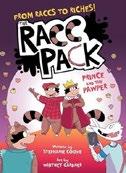
T he Racc Pack has gotten a taste of the good life, and an upcoming Pet Expo in town provides the perfect opportunity for another scheme. When raccoons Dusty, Scraps, and ReRe learn that the star attraction at the Expo is Prince, an internet-famous pet raccoon, they’re shocked. Humans hate their kind! But Dusty, who turns out to be Prince’s doppelgänger, smells profit: If the trio can figure out how to become celebrities, too, they’ll be set for life. Though initially suspicious, the pampered Prince warms to the pack, and they strike a bargain: He’ll teach them how to get famous, and they’ll school him in the ways of city raccoons. Dusty and Prince swap lives so each can learn how the other half lives…only to find that that might not be all it’s cracked up to be. Following the previous installment’s formula, the humor and snappy energy of the plot carry deeper undertones. Here, Cooke not only offers commentary on humans’ relationship with nature, but also considers conflicts between the privileged and marginalized—if readers look deep enough. But they need not look deep at all to enjoy the pack’s shenanigans, well served by the bright, dynamic illustrations. A heartfelt ending strongly hints at the “ paw sibility” of further adventures to come. Human characters are diverse. The latest in this entertaining series is a real treat. (Graphic fiction. 7-10)
A title sure to spur sleepiness, with appropriate verse to match.
Kirkus Star
Couch, Christina | Illus. by Daniel Duncan
MIT Kids Press/Candlewick (160 pp.)
$17.99 | Jan. 14, 2025 | 9781536229721
Series: Extraordinary Animals
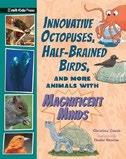
Insights into how our brains resemble, and are different from, those of other animals. With this lively overview of the animal kingdom’s “most extraordinary organ,” Couch delivers lucid descriptions of how humans and other creatures perceive the world, interact with their bodies, sleep, learn, remember, and communicate. Punctuating her narrative with comments from a large and racially diverse group of brain scientists and other workers, she visits research sites ranging from an outdoor squirrel lab to a trauma center where people with PTSD form mutually beneficial relationships with abused birds. She explores natural mysteries, such as an apparently immortal jellyfish and another species that sleeps even though it has no brain. The author expands her focus with profiles of a DNA researcher studying the remains of victims of the slave trade on St. Helena and an entomologist whose passion for roller derby has helped her become a better scientist, among others. As if all this isn’t stimulating enough, Couch also provides instructions for keeping a dream journal, testing short-term memory, and tackling other brainrelated projects for hands-on readers before closing with a substantial
bibliography, source notes, and further reading. Duncan includes anatomical cutaways, charts, and cartoon spot art featuring a diverse cast of young enquirers into the already generous mix of animal photos and portraits. Widely angled and unfailingly intriguing. (index) (Nonfiction. 10-13)
Coven, Willow | Illus. by Priscilla Burris
Little Simon/Simon & Schuster (128 pp.)
$17.99 | Jan. 7, 2025 | 9781665963978
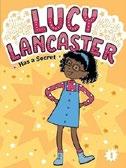
Meet Lucy Lancaster, best friend of series superstar Heidi Heckelbeck. Though Heidi appears in this book, along with the girls’ other BFF, Bruce Bickerson, Lucy takes center stage. After Mrs. Welli assigns Bryce Beltran to be Lucy’s science class partner, Bryce isn’t pleased—both girls wanted to work with their own friends—and all but slams her desk into Lucy’s. Lucy wishes she could have a more polite and compliant partner like Heidi or Bruce. Suddenly she begins hiccupping, and Bryce instantly becomes sweetly agreeable. This is wonderful…isn’t it? More strange things occur; Lucy’s perplexed. Then she hiccups again and inadvertently finds herself sowing classroom chaos. Ms. Egli, the alert town librarian who’s visiting the class, notices, gives Lucy a golden library card with access to the Magical Library, and helps her to understand her powers. Like Heidi (though neither girl is yet aware of the other’s gift), Lucy is a witch! Engaging characters, a well-crafted setting, and quick pacing perfectly suit the target audience; Lucy
A reminder for all—reading isn’t always silent and still.
promises to be a popular series star herself. Burris’ many illustrations portray Lucy with black curls, brown skin, and star-festooned glasses. Bryce and Ms. Egli are brown-skinned; most other figures are light-skinned. This series spinoff still brings the magic. (Early chapter book. 5-9)
Cribbins, AR | Little, Brown (40 pp.)
$18.99 | Oct. 8, 2024 | 9780316539388

A young Indigenous child faces a bumpy road while preparing for a dance at an upcoming ceremony. Bizzy’s cousins already look amazing in their cotton dresses, headpieces, and jewelry; Bizzy’s regalia has to be perfect. The child gathers fabric, as well as shells, beads, and rabbit fur, and sits down to the sewing machine with encouragement from Mom and Grandma. Bizzy’s confident (“I’ve sewn pillows before… It’ll be easy to do this part myself!”) but ultimately hits some snags as the garment gets caught in the machine. Tears in the fabric and crooked stitching mar the little one’s project. Bright and cheery digital illustrations show a youngster who’s determined to achieve perfection but who unsurprisingly falls short. Speech bubbles and panels make the action easy to follow as Bizzy’s family consistently responds with love, encouragement, and solutions. Grandma eventually teaches Bizzy a valuable cultural lesson about imperfection: “It’s the Pomo way to leave one little flaw in everything you make.” She adds, “And then we dance fast so no one sees where that part is!” Bizzy takes this advice to heart and eagerly looks forward to the ceremony: “Dance fast, dance slow. Dance for Creator, dance for ancestors, dance for me. When I dance, everything is perfect.” In her author’s note, Cribbins (Pomo) discusses the importance of ceremonial dancing and her people’s tradition of leaving flaws in dance
regalia as a reminder to “stay humble and strive for quality, not perfection.”
A vibrantly illustrated life lesson in humility. (Picture book. 3-8)
Davaze, Elizabeth | Illus. by Marianne Ferrer | Owlkids Books (32 pp.)
$18.95 | Aug. 13, 2024 | 9781771475884
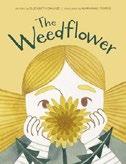
An observant youngster cultivates a dandelion growing on a playground. Racially diverse children run and jump under the watchful eyes of adults. “No one spotted the tiny flower bud sprouting, impossibly, between the schoolyard’s cement and rubber turf”—except for blond-haired, light-skinned young Sam, lying on her tummy with her hands under her chin. Capturing children’s universal affection for this “weedflower,” the illustrations depict her showering the “alien bud” with attention. She sings to it, and eventually, other kids flock to see this tiny miracle and band together to guard and water it. It grows and grows—a lovely metaphor for what happens to all living things when shown love. Predictably, the adults don’t care for the “weed,” as they call it, and decide to get rid of the now-enormous flower. But love cannot so easily be extinguished. This is a stirring reminder of the place of honor the lowly dandelion has in many young people’s hearts. Davaze’s straightforward, clear text contrasts with Ferrer’s whimsical images. Relying on a palette of muted greens, rich browns, and crisp whites, the artist depicts the dandelion sprouting forth dramatically, its unappreciated beauty spilling onto the pages as the youngsters look on in awe. The story may prompt discussions as readers ponder the outcome and what it means to nurture something that others see little value in.
A charmingly rendered ode to childhood wonder. (Picture book. 4-8)
Emerson, Perry | Illus. by Sean
Julian | Tiger Tales (32 pp.) | $18.99
Jan. 7, 2025 | 9781664300538

A reluctant reader learns a way to finally enjoy stories. Bun, a tiny orange-hued rabbit, and Pip, a larger rabbit with a flower tucked between her ears, are in the meadow together. Pip wants to settle down in the grass to read, but Bun can’t stand that idea. “Books are SO boring!” he says. “You have to sit still and be quiet forevvvvver.” As Pip attempts to read, Bun can’t stop impatiently interrupting. “Can we play now?…Now?” When Pip closes the book in frustration, Bun curiously picks it up. He’s surprised and delighted to learn that it’s a story about a penguin spy on a motorcycle! Pip starts reading aloud, and Bun acts the events out. He scales perilous mountains (ahem, rocks) and performs daring rescues. Reading has never been so much fun! They have a few squabbles along the way (Bun and Pip model reflection and forgiveness), but Bun’s eyes are opened to the power of a good story. Julian’s lightly washed field of flowers adds an overall tranquility to the setting as the two flop-ears bound around in shared fun. Bun will give all those wiggle worms who can’t sit still during storytime a kinetic way to enter the experience of reading. A reminder for all—reading isn’t always silent and still. (Picture book. 3-6)
Fang, Vicky | Candlewick (96 pp.)
$6.99 | Jan. 14, 2025 | 9781536229707
Series: Ava Lin, 2

Fortenberry, Julie | Margaret Ferguson/ Holiday House (40 pp.) | $18.99 Jan. 14, 2025 | 9780823458127
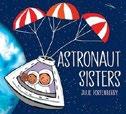
Now a seasoned first grader, Ava Lin returns to deliver new laughs and misadventures. Six-and-a-halfyear-old Ava is good at many things: making
>>> lists, coming up with new games, and treating her classmates respectfully. She has a new opportunity to show off this last skill; her teacher has found a way to reward kindness in the classroom. Each time someone is nice to a peer, they receive a ticket in their bucket. At week’s end, the student with the most tickets gets to select a prize. Ava is determined to win, especially once she spots a narwhal-shaped eraser in the bin; narwhals are her very favorite! At first, being extra kind is easy. Ava is polite on the playground, compliments her friends, and shares her treasures. Soon, however, her fixation on victory makes her irritable, and her ticket-collecting efforts stall. When her best friend, Kushi, offers to help with her plan to win over their classmates, Ava is relieved. The tickets come pouring in for Ava, but Kushi’s hurt that Ava takes full credit. Will Kushi forgive her? Ava’s world is full of silly humor and big feelings that will land with young readers navigating complex priorities of their own. Though occasionally exasperated with her antics, the adults in Ava’s life are supportive of her imaginative, unconventional problem-solving skills. Ava and her family are of Chinese descent, while Kushi is brown-skinned; their class is diverse. This series continues to charm. (Chapter book. 5-8)
3…2…1! Blast off with the astronaut sisters! Snowsuits and bike helmets become spacesuits and space helmets as Rosie and Fern rummage through their closet. An intergalactic trip to the playground with Papa launches the girls through the clouds as an imaginary adventure takes flight. They gaze down at the earth below and float alongside a space station that circles our planet 16 times in one day. The next morning, Papa
The award-winning author makes a “big statement” with a new anthology, Black Girl Power
BY MEGAN LABRISE
YOUNG READERS’ LITERATURE superstar Leah Johnson is committed to using her considerable powers for good.
Since we last spoke in 2021, the bestselling, award-winning author of You Should See Me in a Crown published her first middle-grade novel (Ellie Engle Saves Herself ), founded an independent bookstore in response to book-banning attacks on titles by BIPOC and queer authors (Loudmouth Books), judged the 2024 National Book Award for Young People’s Literature, and edited an exquisite anthology for Freedom Fire, a Disney imprint devoted to stories about the Black diaspora by Black creators.
“It’s a big statement,” Johnson says of the decision to put Black Girl Power: 15 Stories Celebrating Black Girlhood (Freedom Fire/Disney, Nov. 12) on Freedom Fire’s launch list, along with books by Tracey Baptiste and publisher Kwame Mbalia. “When they wanted to set the tone for what the rest of this imprint was going to be, they chose power.”

Johnson got a roster of A-listers to bring their A-game to the anthology— including Ibi Zoboi, Renée Watson, cover artist Vashti Harrison, Sharon Flake, Sharon M. Draper, and Dhonielle Clayton. The result is an “electric” collection, as Kirkus writes in a starred review of Black Girl Power, praising the book’s “confidence-building stories that sizzle with wisdom and a little bit of magic.”
Johnson recently discussed Black Girl Power with Kirkus via Zoom; our conversation has been edited for length and clarity.
What aspects of Black girlhood did you want to explore in these varied, vivid stories?
I wanted us to highlight the beauty and the strength of Black girlhood, the magic and the mundane. We have a lot of experiences [in the book] that are really typical coming-of-age experiences. What does it mean to go to my first sleepover but feel like I’m being left out? What does it mean to have this dream and not know if I’m going to be able to achieve it? These
I wanted us to highlight the beauty and the strength of Black girlhood, the magic and the mundane.
narratives are universal but so rarely given the time and the space to shine when it comes to us Black girls. And there’s something extraordinary about being able to chronicle those experiences in fiction.
This collection really brought me back, and had me remembering middle school as a transitional time. That line between babyhood and being a teen is so perilous to navigate. I remember feeling like the one person who just didn’t get it—like, everyone else got the memo that we’re dressing like this now, we’re acting like this now. That was so real to me.
It’s so funny. I remember, years ago— and it probably is still a conversation in the bookish internet somewhere— people asking, “Is there an age at which people should stop writing YA or middle grade, because you’re so far away from it?” I always thought that was such a strange line of thinking. Who among us, in their adulthood, doesn’t have that same feeling of maybe you just didn’t get the memo about something that everybody else seems to have already figured out? It’s not only universal in that it transcends race and gender—and, you know, arbitrary lines of nation-states—but also age. I feel like so many of these experiences are incredibly resonant to me as an adult, and that’s why it’s such a joy to be able to continue to write them—and, in this anthology, curate them. How many different ways can we talk about how hard and how incredible it is to be a preteen or tween girl? These stories are resonant for so many people but specific to Black girls in a way that I haven’t seen before.
The story that opens this collection is “The New Rules” by Elise Bryant. What were some of the qualities that made you want to lead off with that one?
It really set the tone for what the rest of the anthology was going to be, which is honest and humorous, and also deeply cringy. That’s the thing

Ed. by Johnson, Leah Freedom Fire/Disney | 320 pp. | $18.99 Nov. 12, 2024 | 9781368098960
about being a tween that I can never get away from. It’s mortifying to be a human in a body at any age but particularly that age when you’re just now adjusting to what it means to live inside of this new body, and your brain is changing in ways that you can’t always keep up with.
The collection ends with your story “Brave.” Where did that come from? How long did it take to write? Is it an idea you had for this anthology, specifically? Or did you write it in response to the pieces you were receiving? Tell us all about it. Oh, I love that question. Usually, if I’m contributing to an anthology, I’ll sit and knock out my short story contribution in one sitting. It’s not something that I return to over and over again. But this is one of those stories where it took me a while to figure out what exactly I was trying to say and how I was trying to say it.
It’s worth noting that, well, I am the anthologist. But we have an editor at Disney, obviously, who also worked
with us on this. And [editor Ashley Fields] is the one who said, “This is how we’re going to end the anthology.” And I said, “Maybe we should get somebody more famous.” I was like, “Do you know Ibi is in this collection? Let’s really end it with a bang!” But she was like, “No, girl, you’ve got all the bang we need.”
When I was a kid, I was diagnosed with ITP, which is idiopathic thrombocytopenic purpura, an immune blood disorder. So, my earliest memories are of getting transfusions in the same wing of the hospital where they were treating cancer patients. This is a real story; this was what it was like for me. I was slightly younger, but the rage [I felt] is something that we don’t always get to see in Black girls without punishment. I wanted to have a character who was allowed to be angry and to acknowledge that softness does not equal weakness. That felt like a strong message to leave the anthology on: that you’re permitted to be flawed, and permitted to be angry, and also permitted to be sad and scared. Those things are all valid, and you should be given the grace and the space to acknowledge those feelings.
Where did the idea for Black Girl Power originally come from?
We’re building on a really interesting foundation. We got to create this anthology to mirror, in many ways, what Kwame had already done in Black Boy Joy [2019]. I’m so grateful that these [stories] get to be in conversation with each other, because they are singular. They’re unlike any other books that I got to read when I was a kid, and, in that way, Black Girl Power has done something for me, personally, that’s immeasurable. I hope it will have that effect on the young people who pick it up—and the young at heart, who maybe still need to learn some of the lessons that our characters are learning in the book. Shoutout to Kwame for giving us that blueprint to work from, and also to Freedom Fire for creating the space for Black Girl Power in its first season of titles.
This review originally ran in the Aug. 1, 2024, issue.
In this inspired take on the Nativity, seven sheep venture from their field to find a special baby.
In a droll narrative intentionally packed with anachronisms, the small flock, each with a distinguishing characteristic (a leg cast, a retainer in a case, a snuffly nose), hears the news about the miraculous baby from a goat. Finding their shepherds gone (they heard the good tidings earlier from angels), they set out to visit the town where the baby is said to be. Various misadventures
ensue, and the sheep encounter other animals, including a donkey who tells them: “A couple of guys on camels just turned up in strangely shaped hats, bringing all kinds of gifts from the East.” Unfortunately, they learn that the baby and his family have moved on from the manger in a scrapyard. The sheep are indeed disappointed, having created their own present: a song that starts out “Si-i-lent niiiight”—a song that they speculate will be known for centuries.

Occasional illustrations begin with the sheep depicted in line drawings with mono-color washes; more color is added along the way. Hub manages a rare feat—a strikingly original Christmas tale that balances whimsy, wry humor, and moments of joy and tenderness. Originally
published in German and spawning an animated film in that language, this tale begs to be read aloud, provided the listeners already know the traditional version of the Nativity story.
A Christmas tale to hold the whole family spellbound. (Fiction. 6-12)

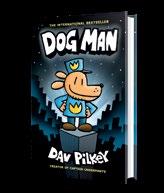
Pete Davidson and Lil Rel Howery star in the adaptation of Dav Pilkey’s book series.
Universal Pictures dropped a trailer for Dog Man, its upcoming animated film adaptation of Dav Pilkey’s
series of children’s graphic novels.
Pilkey’s series, which kicked off in 2016 with Dog Man, is a spinoff of his bestselling Captain Underpants books. The Dog Man books follow a police officer with the head of a dog who has sworn to protect his city from evildoers, including his archnemesis, a cat named Petey.
The film adaptation is directed by Peter Hastings, who worked as an executive producer on the Netflix series The Epic Tales of Captain Underpants, another Pilkey adaptation. It features the voices of Pete Davidson
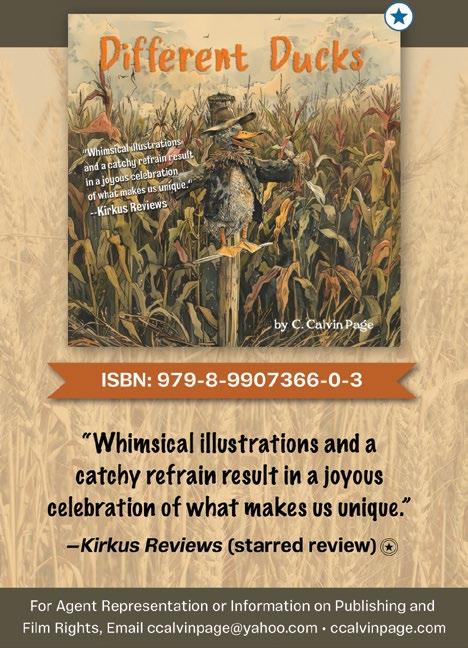

as Petey, Lil Rel Howery as the police chief, Isla Fisher as a news reporter, and Ricky Gervais as a telekinetic fish.
The trailer begins with a voiceover saying, “When the streets are held hostage, two of the city’s finest must come together and fight as one,” as a police officer and a dog

For reviews of the Dog Man books, visit Kirkus online.
attempt, unsuccessfully, to defuse a bomb. It cuts to both cop and canine on an operating table as doctors decide to fuse the dog’s head onto the human’s body.
The trailer ends with Dog Man enthusiastically jumping on the police chief, giving him a sloppy puppy kiss. “Stop it! Why do you always got to lick the inside of my mouth?”
Dog Man is scheduled to open in theaters on Jan. 31, 2025.—M.S.

drives the siblings, dressed once more in their spacesuits, to a special parade—a homecoming celebration for a real astronaut. But this isn’t just any astronaut; it’s Rosie and Fern’s mother! Their reunion amid a cheering crowd is a touching testament to Mama’s influence over the girls’ dreams and aspirations, manifesting through play. Colorful cartoon illustrations with scrawled black outlines lend a sweetness to the children’s lively game. The youngsters are brown-skinned; one of them has dark hair to match their brown-skinned Mama’s, while the other has orange hair like their light-skinned Papa’s. The crowd at the parade varies in terms of skin tone, body type, clothing, and head coverings.
A joyous ode to the power of play, the bond between sisters, and the vital representation of women in STEM. (FAQs about astronauts) (Picture book. 3-6)
Harriet Hound
Foster, Kate | Illus. by Sophie Beer Candlewick (176 pp.) | $17.99 Dec. 3, 2024 | 9781536238105

A young neurodivergent girl saves the day with help from her family’s rescue dogs.
Eight-year-old Harriet is autistic, and she’s a superhero! She assists the members of her community in Labrador, Australia, with their appropriately low-stakes problems. Whenever she has a problem, she turns to her magic pajamas, which are covered in images of canines from Hound’s Rescue, an organization run by her family; as soon as she touches a picture, the dog appears. In each of the book’s three stories, she picks just the right pooch for the job, teaching readers about dog breeds in the process. Huskies come to the rescue by pulling a cart of ice cream, while a Newfoundland is perfect for cuddling cold children after a rainstorm. The prose is thrilling and fast-paced, with different fonts and font sizes emphasizing important words and
A pitch-perfect portrayal of the ebullient highs and mortifying lows of middle school.
FRESH START
highlighting potentially unfamiliar vocabulary. Harriet’s autism isn’t the focus of the story but is an important part of her character. Her stims and accommodations (including noisecanceling headphones and a stress ball), as well as her penchant for soft, comfy clothes, are casually mentioned; many autistic readers will feel seen. Children will enjoy Harriet’s dog-filled adventures. Harriet presents white in Beer’s chipper black-and-white artwork, while her community is diverse. Fun adventures featuring positive autistic representation. (additional information about dogs) (Fiction. 6-9)
Galligan, Gale | Colors by K Czap
Graphix/Scholastic (288 pp.) $24.99
$14.99 paper | Jan. 7, 2025 9781338045864 | 9781338045840 paper
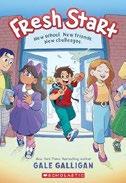
Putting down roots isn’t easy when you’ve spent your whole life on the move.
Seventh grader Ollie Herisson has lived all over— France, Singapore, and Thailand (where her mom’s from), to name just a few places—thanks to her white American dad’s diplomat job. She loves the fresh start that each relocation brings: Why worry about bad first impressions or embarrassing moments when you can count on eventually fleeing the country? This knowledge empowers her to fully embrace her goofy, anime-obsessed side, unabashedly immersing herself in imaginary worlds.
But when her parents suddenly announce their plans to stay in Virginia for the foreseeable future, Ollie must learn to adjust to American culture and navigate friendships for the long term. Will she be able to survive without her usual escape plan? Galligan translates some of their own childhood experiences into this contemporary story, imbuing it with an authentic energy that shines through the nuanced characters. Realistically imperfect parents, heartfelt moments of sibling solidarity, an identity crisis around race and gender expression, and misguided attempts at friendship all make for a well-rounded and appealing coming-of-age tale. The exaggerated manga-inspired illustrations and impeccable comedic timing create a pitch-perfect portrayal of the ebullient highs and mortifying lows of middle school. Anyone who’s ever engaged in fandom will undoubtedly see themselves and their friends reflected in the pages. A hilarious and undeniably endearing tale of tweenhood. (author’s note, bonus comics, photo album, more about Thai language and traditions) (Graphic fiction. 8-12)
Gresko, Marcia S. | Illus. by Steve Mack | Kar-Ben (12 pp.) | $9.99 Jan. 7, 2025 | 9798765620670

It’s time for the Purim party— wear your costume, and bring something delicious to eat! Each page of this board book presents a child dressed in a single-hued costume and carrying a food item to match. The getups vary,
with some children dressing as participants from the Purim tale and some in different imaginative or amusing creations. Lily is Queen Esther, dressed in red and displaying a bowl of apples. Nora is an orange butterfly, offering papayas. Ava is a frog with green grapes. And then there’s Leo, holding several yellow bananas and wearing a hamantaschen costume. So who does bring the hamantaschen? After all the items have been presented, the title question is asked and answered. Here comes a pair of loving grandparents—one wears a Purim party hat and waves a grager, or noisemaker—both displaying a large plate of the perfectly triangular jelly-filled treats. Everyone gathers around the festive balloon-decorated table to enjoy all the colorful foods. Making use of flat, simple shapes, the book brims with visual appeal as each vivid, clearly named color is introduced to young readers, but only readers familiar with Purim—or who have a knowledgeable grown-up nearby to explain—will be able to understand the Purim connections. Characters vary in terms of skin tone and hair color.
A charming introduction to colors, set against the backdrop of a happy, child-centered holiday. (Board book. 2-4)
Guarda, María J. | Candlewick (32 pp.) $18.99 | Jan. 14, 2025 | 9781536231441
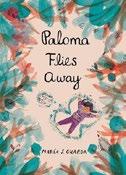
“My parents named me Paloma. They wanted me to be as free as a bird.”
But Paloma was born in a country ruled by a dictator. When things become too difficult, the family abruptly leaves. “We didn’t get to say goodbye or even pack.” The intrepid Paloma is excited but misses home dearly. Sharing photos and phone calls with far-away relatives, Paloma maintains connections while embracing a new life. Paloma’s parents long for their homeland, which Paloma now struggles to remember clearly. The family has always known that they will go
back one day, and when they do, it’s on their own terms. Now Paloma experiences the adventure of returning to an old-yetnew-again country and readjusting to being home for good. Simple yet poignant text paired with soft watercolor and ink illustrations together deliver a profound tale of resilience, belonging, and the complex emotions tied to migration and homecoming. Sepia backgrounds give the illustrations a solemnity tempered by the doodlelike linework and smudges of color, which infuse the tale with a childlike whimsy. Throughout, birds serve as symbols of freedom and hope. Paloma’s narration is direct and captures the sincerity of young children beautifully. The family is brown-skinned, though what country they’re from is never revealed. A gentle yet powerful reminder of the strength it takes to find home, both in new places and in the heart. (Picture book. 4-8)
Heuer, Lourdes | Illus. by Lynnor Bontigao | Amulet/Abrams (80 pp.)
$14.99 | Jan. 14, 2025 | 9781419767432 Series: Seashell Key, 2
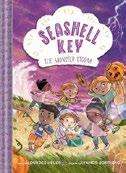
The second installment in the Seashell Key series sees the island’s inhabitants enjoying autumn. In the first of four stories, Mateo’s determined to win one of the fall festival’s competitions. He enters the pie contest, hoping to make up for his lack of baking know-how with enthusiasm; his results are “interesting” (in the words of the judge) but unsuccessful. Next, he enters the costume contest with a wild monster suit, but the judge is Sasha, a no-nonsense youngster who goes for realism above all. Finally, Mateo enters the scarecrow contest, where judge Sophia—Sasha’s more free-spirited sister—appreciates his unconventional approach. In the second entry, Lifeguard Luca trains Sasha and Sophia to teach the younger kids how to swim; imaginative Sophia takes the
metaphorical instructions literally. In the third story, a long-anticipated storm arrives, and Eli, Ezra, and Elana—three siblings who live in a lighthouse—entertain themselves with not-too-scary tales of “the monster of Seashell Key.” In the final entry, following the storm, the trio search for their dog, Pixie, who’s gone missing; along the way, they run across various potential monsters (all of which are callbacks to previous stories). Throughout the narrative, Heuer employs the comedic “rule of threes” to create gentle tension and a structure supportive of newly independent readers. In the lively illustrations, Mateo and Lifeguard Luca are brown-skinned, Sasha and Sophia are Black, and the lighthouse trio present white. Whimsical and spritely. (Chapter book. 5-8)
Hewitt, Nicole M. | Feiwel & Friends (352 pp.) | $17.99 Jan. 21, 2025 | 9781250906045
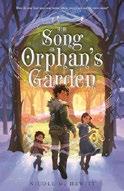
Lyriana and her 6-year-old brother, Zave, set off through a blighted winter wilderness in search of a magically sheltered garden that calls to orphans. Hewitt slips occasional rhyming lyrics and haiku into a free verse tale that’s shot through with DNA from Oscar Wilde’s The Selfish Giant. In a land that seems to be permanently gripped by bitter Winter Spirits, cold-hating giants jealously guard the other Seasons within walled gardens that only their specially talented Greensgrowers can create. The gardens must be sustained by infusions of musical magic called Fermata, which only human Songsummoners can conjure. That giants and rebellious humans have been at war for many years complicates matters—particularly for Greensgrower Brobdingnag (Wilde isn’t the only literary influence here) Jonrog, who returns to an isolated garden he
created years ago, only to find it taken over by orphaned tinies. He angrily drives them out, but they soon sneak back in, and what Brob sees transforms his feelings: “In every tree, a child, / and with each child // Spring blooms.”
Ongoing contact with two new arrivals, frail Zave and his loving big sister, Lyriana, deepens that change of heart on the way to heartrending sacrifice and a joyous renewal that signals a change of season in both the characters’ relationships and the world at large. Lyriana and Zane are cued white; references to skin color cue diversity in the supporting cast. Lyrical in both themes and language, with resonances both literary and ecological. (map) (Verse fantasy. 9-13)
Hiranandani, Veera | Illus. by Nadia Alam Random House Studio (40 pp.) | $18.99 Jan. 28, 2025 | 9780593643907
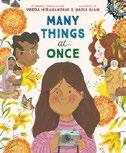
A Jewish Indian girl learns about her family’s history. As the young narrator looks at old family photographs, her parents tell her stories about her grandparents. Her maternal grandmother was a Jewish seamstress in Brooklyn, while her paternal Indian grandmother liked to cook “spicy sai bhaji and bubbling dal.” Her maternal grandfather escaped the pogroms in Poland, while her paternal grandparents fled their home during the Partition of India. Years later, her parents met in New York. They tell her she’s lucky “to be both Indian and American, to be both Jewish and Hindu, to be part of many things at once.” But the girl sometimes feels as though she doesn’t quite fit in anywhere—she doesn’t know the words to the Hebrew songs at Passover, and she doesn’t understand Hindi like her relatives do. At school she learns that no two butterflies are exactly the same. As she considers this idea, she realizes that she, too, is unique and part of many things at once. This thoughtful portrait explores the doubt that many interfaith
and biracial children feel about not fully belonging. Hiranandani gives her young protagonist room to appreciate both of her religions and cultures and to accept herself. The scrapbook-esque illustrations, which shift between pictures from the family’s album, memories, and present moments, offer a nice visual touch that tells a story of its own. A quiet reflection on belonging and acceptance. (author’s note) (Picture book. 4-8)
Kirkus Star
Hulse, Patrick | Illus. by Madelyn
Goodnight | Little, Brown (40 pp.)
$18.99 | Oct. 8, 2024 | 9780316537056

This table has room for everyone. Keenly aware that Thanksgiving is often associated with inaccurate portrayals of Indigenous peoples, Hulse and Goodnight (Chickasaw Nation) have created a loving, inclusive depiction of the holiday. Spare yet lyrical verse invites readers to take a seat at a table alongside a diverse group of characters who eat, ponder, and express gratitude for all they’ve been given. Hulse employs sensory-rich imagery to describe the autumnal season (“a fresh tablecloth, / crisp and gold like this day”), the various mouthwatering foods, and those who work tirelessly at planting and harvesting to make the Thanksgiving meal possible. The repeated phrase “At our table there is room” allows readers to linger on small details that make the holiday special (“swapping stories, / second helpings, and favorite jokes”). Hulse and
Goodnight also emphasize respect and honor for Indigenous peoples. In one illustration, a group of people reverently stand before a statue of beloved Wampanoag chief Ousamequin, while Hulse speaks of the importance of making “room to learn from / the first farmers / and builders / and knowledgegatherers.” Goodnight’s visuals turn solemn and stately here, though in general her images brim with warmth, suffused with an inner glow. Hope and thankfulness resonate throughout as loved ones eat, laugh, share stories, and create lasting memories.
Marvelously exemplifies the diversity of American holiday traditions and offers a more nuanced understanding of Thanksgiving. (author’s and illustrator’s notes) (Picture book. 4-8)
Hunter, H.D. | Illus. by Khadijah Khatib | Random House (336 pp.)
$17.99 | Nov. 19, 2024
9780593479506 | Series: Futureland, 3
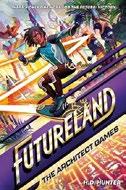
The fate of Futureland is at stake in this third series entry when the evil Architects return for a winner-takes-all showdown. Cam Walker, his parents, and Uncle Trey originally planned on a much-needed vacation to Italy, bringing along Futureland, their floating amusement park home, as well as Grandma Ava and Cam’s middle school friends from Atlanta. But the mysterious re-emergence of long-lost family friend Auntie Maxine coincides with these
Tender and empathetic—and a road map for families undergoing similar shifts.
ONE DAY AT A TIME
plans being derailed by familiar shadowy villains. The Architects challenge the crew to a series of high-stakes games for the future of Futureland. Obviously, the Walkers must accept. Their only saving grace is getting to choose the location— Cairo, where the technologically advanced Egyptians can serve as impartial referees. Otherwise, the Architects, with their advanced tech and lack of morals, are seemingly at an advantage. After some early issues with Cam’s leadership and a shocking betrayal, Team Futureland prove to be formidable competitors in a wide array of games and puzzles incorporating Egyptian culture—ancient, contemporary, and futuristic. The Architects are nefarious cheaters in the action-packed adventure, but teamwork and kid-size savvy win out. The dynamic format includes comic spreads and other visual elements. Ultimately, though, triumph for Cam looks less like vanquishing the Architects once and for all than finally taking on normal seventh grade life. Final art not seen.
A return to an exciting world of Afrofuturism where everything’s on the line and there’s a lot for a kid to learn. (guide to Futureland) (Science fiction. 9-13)
Ip, Rachel | Illus. by Natelle Quek
Christy Ottaviano Books (40
pp.)
$18.99 | Jan. 28, 2025 | 9780316577564
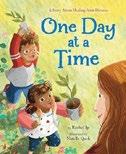
T hings change when Mommy and Daddy announce they’ll be getting divorced. Poppy and Robin learn that the family will have two houses, one for Mommy and one for Daddy; they’ll split their time between their parents. The siblings respond in different yet equally relatable ways. Poppy prefers to keep the news private, while Robin confides his worries to his friends. Both children have big, messy feelings that emerge at unexpected times. As the seasons pass, Poppy and Robin gradually adjust. After all, though
Mommy and Daddy live apart, the children realize that they will always be a family. This is a quiet, thoughtful depiction of divorce, with parents who do an exceptional job of supporting their young children through a tough time. Sunflowers are a motif throughout. When Mommy and Daddy are together, the flowers sprout tall; after news of the divorce, they seem to wilt; and toward the end, the children plant sunflower seeds—a sign that the family’s love will endure, no matter what. Appropriately warm, gentle digital illustrations employ late-summer and early-autumn colors and seem to be dusk-lit. Mommy has pale skin and straight hair, Daddy has medium brown skin and wavy hair, and Poppy and Robin both have light brown skin and their father’s hair texture. Tender and empathetic—and a road map for families undergoing similar shifts. (a note for parents and caregivers, online resources, recommended reading) (Picture book. 3-6)
Irving, Barrington & Chana Stiefel | Illus. by Shamar Knight-Justice | Dial Books (40 pp.) $18.99 | Jan. 14, 2025 | 9780593532133
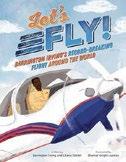
The first Black pilot to solo circumnavigate the world tells his story.
Irving, born in Jamaica, moves to Miami at age 6, and the “badgering” about his clothes and speech that he endures as an outsider just makes him resolve to aim high. That goal initially means football—until a stranger walks into his parents’ bookstore and asks if he’s ever thought about becoming a pilot. Captain Gary Robinson, who is also Black, takes him under his wing and into a cockpit, giving him a lesson with a flight instructor when Irving turns 16. Irving earns money for more lessons, works hard, and obtains his pilot’s license. Then Captain Robinson poses a challenge to the 21-year-old Irving: Pay
it forward and help someone else. Irving starts an after-school STEM program, then envisions a landmark goal: a solo flight around the world. His initial efforts to find support are discouraging; it takes two years to get a plane, another year to plan. Despite doubts, Irving takes off in 2007 before, 26 stops and 97 days later, eventually returning to Miami. One full-page illustration is devoted to the riskiest flight segment; a map traces the whole route. The art is colorful and uncluttered but detailed, with labels for cockpit instruments and levers, as well as many parts of a turbo-prop. Though details of the flights are few, the writing channels the aviator’s conversational voice, and the narrative arc is uplifting.
An attractive condensed account that will put the wind under readers’ wings. (more information on Irving, timeline, quotes from Irving, bibliography) (Picture-book memoir. 4-7)
Jackson, Bea | Aladdin (40 pp.)
$18.99 | Jan. 7, 2025 | 9781665941174

A fairy struggling to fly finds friendship with a kindhearted girl. More than anything, Lily wants to soar “with the birds and the butterflies high above the treetops.” Lily’s well acquainted with “the beauty closer to the ground,” but each time she attempts to fly, she tumbles to the ground. Her discouragement is palpable. When she finds a quaint fairy house in the woods, she marvels at the chair made of twigs and the lovely lanterns. She soon learns that the house was made by a gentle young girl named Willow. Willow patiently supports Lily, bringing her a fairy-size trampoline and a tiny helmet. Lily still finds flying a challenge, but she’s bolstered by Willow’s presence. The illustrations portray a ballerinalike Lily, her curly hair in a bun, while Willow has a friendly and welcoming face. Filled with large-eyed characters, butterflies, glittery trails, and sun flares,
the images feel almost like stills from an animated video. While Lily is the lead character in this story, in her author’s note, Jackson describes the bond with the human girl as the focus and adds that the story reflects her own sense of wonder at the natural world. The plotline is somewhat quiet—a quality that children must cultivate if they hope to entice fairies of their own—while the messages of compassion and helping others achieve their dreams come through strongly. Willow and Lily are Black. A low-key tale of magic and friendship. (Picture book. 3-8)
Jackson, Mick | Illus. by Rashin Kheiriyeh | Candlewick (32 pp.)
$17.99 | Feb. 18, 2025 | 9781536238921

A misunderstanding leads to disappointment as a family prepares to relocate. When Mom announces that the family will be moving, the literal-minded young narrator is initially thrilled. The child imagines what moving will look like: A “very big truck with a very big engine” will lift the home up, transporting it to a new neighborhood. They’ll need cranes, the child decides. And they’ll have to warn the owner of the nearby cafe to move the chairs and lampposts out of the way. The child pictures the house traveling on a boat over a river and a sea and by helicopter over mountains (“I hope I get to stay in our house while it’s being moved”). Upon discovering that the house won’t be coming with the family, the child frets. Soon, though, the little one realizes that “no matter where we live, the thing that matters most is that we have each other.” While the child’s anxiety about moving is relatable, the emotional resolution feels a bit rushed. Still, the book’s clever premise, endearingly sincere narrator, and beautifully rendered world make this a visual and textual delight; the whimsically childlike illustrations are particularly impressive.
Tenderly imaginative and moving. (Picture book. 3-7)
This day in the life is a beautiful, wistful tribute to a beloved homeland.
MY FATHER’S HOUSE
Javaherbin, Mina | Illus. by Lindsey Yankey | Candlewick (32 pp.) | $18.99 Nov. 19, 2024 | 9781536225532

In this tale inspired by the author’s own experiences, a child explores her father’s childhood home in Iran. As the sun rises, the narrator and her father start their journey at “the ancient temple” in Isfahan, while carefully rendered chukar partridges perch in the foreground. With matter-of-fact storytelling, naming specific neighborhoods and monuments, the girl recounts what she learns from her father’s friends, who take them around the city. They visit a synagogue, a church, and a mosque, noting the “people of all beliefs” who “celebrate the city they built together, side by side.” The dreamy, watercolorlike illustrations are at their most saturated, detailed, and showstopping when depicting the blue-and-gold-tile paintings covering the inside of the mosque—and the mouthwatering saffron rice, pomegranate sauce, figs, and radishes at the family’s dinner table. After a peaceful evening with her father, his mother, his grandma, and his childhood nanny, the girl falls asleep, dreaming of future adventures. Tinged with love and affection, the narrative concludes with an author’s note that offers more information on Isfahan’s history and reveals that Javaherbin and her father left Iran following the 1979 revolution, along with others “who chose the hardships of immigration over living under a new oppressive regime.”
This day in the life is a beautiful, wistful tribute to a beloved homeland. (glossary) (Picture book. 5-8)
Jones, Nashae | Aladdin (272 pp.) $17.99 | Jan. 7, 2025 | 9781665939911
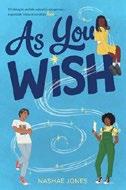
A 13-year-old Ghanaian American girl’s wish to go from weird to wonderful leads her through a web of relationship complications that she didn’t bargain for.
Bernadette “Birdie” JohnsonNkrumah is a rising eighth grader with a laundry list of restrictions imposed by her overprotective mother. Her mom even used to make her wear latex gloves to school, but Birdie’s father and her best friend, Deve Banerjee, offer support that helps her cope and understand her mother’s anxiety. While Deve is her “crunchy-peanut-butter friend” (crunchy is far superior to creamy, if you ask Birdie), she worries that she’s dragging him down socially. At a pool party, the friends are shocked by the sudden glow-up of the formerly dorky Ava, who’s now dating a basketball player. Birdie decides that finding a boyfriend for herself and a girlfriend for Deve will help them become popular, too. But Birdie’s desire to be “normal” causes a rift with Deve. Birdie is confused when Nancy, the new girl at school, claims that she’s Anansi, the spider god of stories and knowledge, and that she owes Birdie three wishes. Birdie attempts to use them to heal her friendship with Deve, but each wish has unforeseen consequences. The appealing fantasy and humor elements drive the narrative, and the shifts and changes in Birdie and
Deve’s friendship over the course of the story are clever and satisfying. A delightful exploration of friendship, mental health, and first love with a touch of magic. (Fantasy. 10-14)
Juckes, Sarah Ann | Illus. by Sharon King-Chai | Kane Miller (272 pp.)
$8.99 paper | Dec. 1, 2024 | 9781684649471
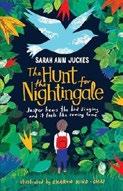
An English boy navigates grief and loss.
Jasper, a 9-year-old with severe anxiety, used to watch birds with his older sister, Rosie. They kept their own journal of bird facts and looked out for the nightingale’s annual visit. Their hobby offered a calming escape from their tension-filled home lives, with financially struggling parents who were constantly working. Rosie promised to return home from university in the spring, in time to hunt for the nightingale with Jasper— but she never arrived. Dad said she’d “gone to a Better Place,” and Jasper decides that if she isn’t with him, “her Better Place must be with the nightingale.” He packs a bag, leaves a note, and sets off by bus to find them. Along the way, Jasper helps others find their lost things, and each person he meets guides him toward understanding grief and loss. Jasper’s recollection of important memories of Rosie helps him come to terms with her death and emboldens him to communicate to his parents his frustration with their emotional neglect. Jasper’s first-person point of view is punctuated by expressive illustrations of birds, bird facts, and excerpts from the siblings’ bird journal. The bird information foreshadows parts of the story and symbolically represents Rosie’s ongoing presence. The mental health subplot will speak to many readers.
Jasper reads white; names cue ethnic diversity in the supporting cast. A beautifully written novel, pervaded with bittersweet and complex internal conflict. (map, author’s note) (Fiction. 8-12)
Huck and Loona
Kilgore, Emily | Illus. by Florence Weiser | Beaming Books (32 pp.) $18.99 | Oct. 29, 2024 | 9781506493305

Friends agree to disagree— eventually. Huck the bear and Loona the loon love fishing and playing hide-and-seek. But these BFFs can’t do everything together: Loona can’t climb trees with Huck, and he can’t dive to the bottom of the lake with her. When they have trouble agreeing on an activity one day, they quarrel and part ways. But Huck finds that berries taste less sweet when eaten alone, and Loona doesn’t enjoy soaring without Huck cheering her on. The next day, Huck, who initiated the separation, makes a move, bringing Loona a fish to share and acknowledging that she’s more important than anything. Nevertheless, they argue once more while cloud watching (“Psh, that’s not a dragon—it’s a unicorn!” “A unicorn?! How could it be a unicorn?”), and Huck feels angry. Kilgore takes on a familiar topic, but her characters don’t work toward compromise or attempt to hear each other out; the narrative simply comes to an abrupt conclusion as Huck decides “Maybe it’s okay for friends to disagree sometimes.” As a result, their happy ending feels unearned. Though attractive, Weiser’s pastel-hued illustrations lack the zany assuredness of her other books. She gives us a lovely loon and a bear who looks a bit like a stuffie, loose-limbed, purplish, and walking upright. Still, the art can’t elevate the lackluster plot. An often-explored theme gets an underwhelming treatment. (author’s note) (Picture book. 4-7)
Korsh, Kate | Illus. by Marta Altés Putnam (144 pp.) | $17.99 | Jan. 7, 2025
9780593533697 | Series: Oona
Bramblegoop’s Sideways Magic, 3
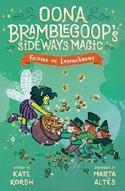
A feud with fellow magical creatures leads to a heap of problems in the fairy world. The glitterberries have gone missing from the warehouse! With only a four-leaf clover left as a clue, the fairies of Blackberry Bog soon find themselves being pelted from above with their favorite sparkly snack. Oona the Underwear Fairy, her cousin Horace the Slug Fairy, and their pal Lucy the Tooth Fairy set out to find the perpetrator but quickly discover that Lucy’s gold coins have also been purloined. All signs point to leprechauns—but why? With the help of human friend Marco, the fairies briefly capture the culprits and begin to piece together a motive. Lucy, shockingly, is revealed as partially culpable for the predicament that led the leprechauns to a life of crime. Each character feels fully, delightfully realized in this latest excursion to Blackberry Bog. Oona’s wonky spells conjure a bubble gum–chewing goat; on one eye-catching page, Horace gleefully catches falling glitterberries in his mouth. Meanwhile, Lucy maintains a somewhat problematically single-minded commitment to her tooth fairy duties. Their antics, as silly as ever, nonetheless have serious bearing on fairy society. With the world’s particulars well established in previous volumes, this story focuses on interspecies diplomacy, complex personal motivations, and ultimately a surprising recognition of Oona’s increasing competency and cooperative nature. Some diversity is implied through shading and hairstyles in the green-tinged, two-toned illustrations. Final art not seen.
A whimsical delight. (Fantasy. 7-10)
AND, TOO, THE FOX
Laban, Terry | Holiday House (208 pp.)
$22.99 | Dec. 17, 2024 | 9780823453566
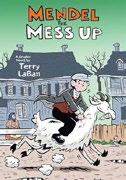
Can a boy who was cursed to mess everything up save his village?
Twelve-year-old Mendel’s incapable of doing anything right. When he hugs his mother, he knocks her into the washtub. While setting the table, he lights the table on fire. And when he chops wood, he almost decapitates his sister. Mendel’s mother tells him it isn’t his fault: Years ago, Starface Matja cursed Mendel when his pregnant mother refused to share the last cabbage at the market. But knowing why he’s Mendel the Mess-Up doesn’t make it any easier to bear. Now the Cossacks are coming. If they destroy the village, it will be Mendel’s fault, but the only weapon he has is his greatest weakness. Simple, entertaining cartoons bring Mendel’s adventure to life. An author’s note speaks to an attempt to render a historically inspired invented setting, a shtetl in a fictional Eastern European country. While some silly touches amuse (a happy goat grins as he trots on a machine designed to collect goat sweat), others (like the shtetl with the linguistically improbable name “Lintvint”) are disconcerting. Despite the comedic art style, the stakes can be surprisingly high; panels, sometimes unexpectedly, rocket from lighthearted to grim to inspirational. All characters are depicted with the same shades of peachy skin; Jewish characters are differentiated from the Cossacks primarily by hairstyle and clothing.
A coming-of-age fable, humorously told and illustrated. (author’s note) (Graphic fiction. 9-11)
Kirkus Star
Laminack, Lester L. | Illus. by Nicole Wong
Margaret Quinlin Books/Peachtree (40 pp.)
$18.99 | Jan. 7, 2025 | 9781682635230
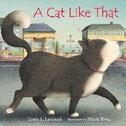
A jaunty kitty parades through her seaside town, greeting friends and neighbors until she locates one special pal.
“A cat. / A cat. // A big, round cat. // Have you ever seen / a cat like that?”
Anchored by an infectious and eminently chantable refrain, this succinct rhyming story is an ideal toddler read-aloud. A minimal plot follows a regal black-and-white feline as she ambles through the day, visiting a fire station, a bustling downtown, the fishing docks, and finally the school, where she waits for her light-skinned young owner. The text’s pacing is smooth, and the rhymes never feel forced. Tidy, full-bleed digital illustrations use light and shadow deftly, and the canvaslike texture gives the art a timeless feel. A light, beachy palette captures the town’s seashore vibes. Varied perspectives keep the pages feeling fresh, including spreads at cat’s-eye level or scenes showing the streets from above, along with a dottedline map of the feline’s wanderings. These images contrast beautifully with close-ups that highlight the cat’s expressions as she bats a butterfly or smacks her wee kitty tongue. The ending feels a bit abrupt—after so much
waiting, readers might wish to see more of the happy reunion between cat and child—but that’s a minor quibble. The town is filled with diverse residents. This simple yet skillful rhyming book is the cat’s meow. (Picture book. 2-5)
Larson, Hope | HarperAlley (240 pp.)
$15.99 paper | Jan. 21, 2025 | 9780063311282
Series: A Very Graphic Novel, 1
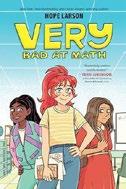
Verity “Very” Nelson is an ambitious class president, an overall top student, and an all-out charmer who faces one obstacle to a triumphant end to eighth grade: numbers. She’s failing math, which could force her to step down from student council and lose the class presidency she’s worked so hard on. Now she’s stuck in an “experimental math pod”—a special two-person class with Lucile, the grumpy ex-BFF of class vice president Bree—in a race against time to bring her math grade up. Very also faces distractions, including a fundraising fiasco and a quest to emulate her political idol, State Rep. Hazel Shaw. Very is a lovable, distinctly drawn protagonist whose various scrapes have a lighthearted tone. Her ultimate worst enemy isn’t other people but rather her own hubris and choices. Refreshingly, Larson avoids preachiness, and she shows Very’s life and personality as being larger than her learning disability. Very’s diagnosis of dyscalculia is handled with a light hand and given equal weight to her interpersonal struggles, such as her well-realized relationships with Bree and Lucile. Larson’s command of the medium is apparent in the dynamic, easy-to-follow layouts and panel flow and the funny, specific character designs. The balance between the writing and visuals enhances Very’s journey, and her colorful Asheville, North
Carolina, environs lend a cozy, reassuring air. Red-haired Very is light-skinned, Bree has brown skin and Afro-textured hair, and Lucile has light brown skin. A buoyant misadventure with some lessons along the way. (Graphic fiction. 8-12)
Leathley, Philippa | Illus. by Brie Schmida Harper/HarperCollins (352 pp.)
$19.99 | Jan. 28, 2025 | 9780063376519
Series: Inkbound, 1

An English child fears she’s doomed to become a murderer. In Leathley’s debut, ink is precious. The expensive fluid powers flying cities and enables wealthy citizens to perform enchantments. On their 10th birthdays, children are tattooed with symbols representing their future traits or occupations. But Meticulous “Metty” Jones’ tattoo—a skull, signifying death and murder, held by a gloved hand, signifying magic—horrifies her parents. Convinced she’ll someday commit murder via magic, Metty resolves to avoid magic altogether—but that doesn’t stop the house staff from treating her like a future killer. What’s the point of being good if everyone thinks she’s evil? When her father disappears, Metty vows to find him and maybe even change her fate. But New London is fraught with unrest, and Metty is targeted by the Black Moths, a militant group that’s violently protesting citizens’ unequal access to magic. But why are they interested in Metty? Though a late-appearing twist muddies a central theme of the story, readers will root for mischievous, wryly witty Metty. Creepy and whimsical details bring the setting of this third-person series opener to life, and while the primary villain is somewhat two-dimensional, the portrayal of Metty’s relationships with
her quirky friends and family members, including her divorced parents, blends together secrets, humor, and heartache. Metty’s dad is oliveskinned; her mum has “skin like starlight.” Final art not seen.
A page-turning exploration of family ties, self-perception, and the powerful effect of labels. (index of common fates) (Fantasy. 9-12)
Lehman, Barbara | Clarion/ HarperCollins (32 pp.) | $5.99 paper
Jan. 28, 2025 | 9780063389052
Series: I Can Read! Comics

A crisis at sea results in the introduction of a new neighbor. Puff the Atlantic puffin, Blue the blue Arctic fox, and Sealy the harbor seal are seaside neighbors, though Puff lives high up on a cliff. While peering through a pair of binoculars one day, Puff spots an Arctic hare named Tip who’s in trouble at sea; the intrepid bird takes flight to guide Tip’s ship to shore. Back on dry land but without a home (the volcano on the island where Tip used to live just erupted), Tip seeks shelter with each of the three friends, only to discover that the would-be roommates’ houses are incompatible for different reasons. Blue eagerly suggests solutions, but Tip has an initially overlooked idea that leads to a proper resolution. Ultimately, the addition of Tip to the community is cause for celebration. Each of the four anthropomorphic animals has a distinct silhouette and an appropriately warm outfit that help them stand out right from the first page, which introduces the cast. Simple paneling and layouts make following along a breeze. The characters all have helpful, can-do attitudes, which leads to lots of cheer, though tears are briefly shed in a few scenes—grief at Tip’s lost home, Blue’s worry that Tip
will have to live elsewhere. Readers, however, will be all smiles. An idyllic and cozy comic. (Facts about Arctic foxes) (Graphic early reader. 4-8)
Limón, Ada | Illus. by Gaby D’Alessandro | Carolrhoda (24 pp.)
$18.99 | Jan. 7, 2025 | 9798765639252

An adaptation of U.S. Poet Laureate Limón’s poem about a day in the life of a fox. The deceptively simple narrative follows the animal as he gambols across a field and wanders through wilderness and neighborhoods. Whimsical swirls of color suggesting that the fox has an almost magical quality vie with more mundane realities as the creature hunts, scrounges for food in trash cans, and relieves himself. Limón contemplates the animal’s inner life—his “work… / doesn’t seem / like work at all but play”—before acknowledging the less romantic aspects of his existence: “Fox lives on the edges, / pieces together / a living out of leftovers.” Toward the end, a pair of human silhouettes, perhaps stand-ins for readers, watch the fox in their garden, though the animal has little regard for people (he “never cares what you need / when you’re watching”). These statements make for a slightly melancholic ending despite the vibrant, flowery images that accompany the words throughout. Even so, the wonder and reverence conveyed through the text and the fluidity of the illustrations result in a smooth and calming experience that will leave readers awed at the beauty of nature. A grounded yet ethereal blend of verse and vulpine sentiments. (Picture book. 4-8)


“...the
—Kirkus Reviews
(starred review)

“Curious
“Makes
Booklist
Foreword Magazine
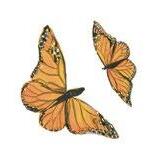






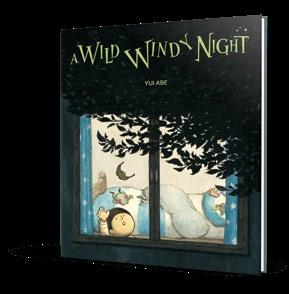
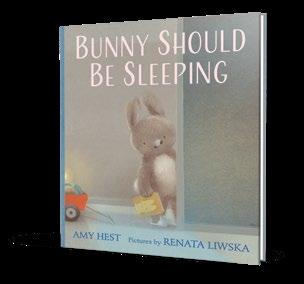

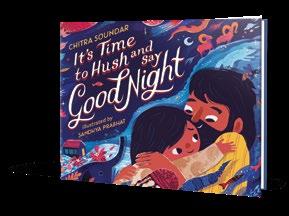



Lucas, Chad | Amulet/Abrams (336 pp.)
$17.99 | Jan. 28, 2025 | 9781419766848

An orphan boy raised in a religious mission begins to question his existence. The strict training of the Mission on the Hill on Rhodenroode Island is all 13-year-old Darian remembers. Being the only brown-skinned boy has resulted in some bullying, but he tries to stay out of trouble. One of the few bright spots in his life is working in the village bakery. But when Gregor, the other apprentice, disappears, and the Apostle makes it clear that they shouldn’t ask questions, Darian becomes alarmed. When he’s unable to stop his best friend, Micah, from running away, he decides to join him on a harrowing journey. Fortunately, they’re rescued by Zaide Odambo, a fearless Black girl, and her sibling, Ikebi, who take them to their community, Kyange. The boys quickly learn that everything they’ve been told about the lands and people outside the Mission is untrue; for one thing, the island’s original name is Lagoja. Hearing of an imminent invasion of Lagoja, Darian convinces his new friends to help save the boys who are still trapped there, which leads to the discovery of the depth of the corruption of the Brothers in charge of the Mission. Drawing on the history of the role of religion in colonization, Lucas has crafted a compelling, action-filled narrative in which Darian embodies both hope and the story’s central tension. A sweet romance also grows between Darian and Micah. A thoughtful depiction of youthful triumph over adult exploitation. (content advisory) (Speculative fiction. 10-14)
Kirkus Star
Lukoff, Kyle | Dial Books (352 pp.)
$18.99 | Feb. 4, 2025 | 9780593618981

A 14-year-old Ashkenazi Jewish transgender boy harnesses supernatural powers and pursues his world-saving destiny.
Every week,
A Izenson’s parents drag him to Save Our Sons and Daughters, a conversiontherapy group for families with transgender youth. Not many teens last long there before they disappear for “further treatment.” After Greek American group member Yarrow, one of A’s only friends, meets this fate, A sneaks over to Yarrow’s house to find out what happened. When he’s caught eavesdropping on Yarrow’s parents, a being made of garbage sweeps in to aid his escape. The creature describes itself as a golem, though its origins are a mystery. All the golem knows is that it awoke to help A fulfill his destiny to save Yarrow—and the world—before the end of Yom Kippur. At first, A is certain the golem has chosen the wrong person. But when he rescues his friend Sal, a white butch lesbian trans girl, from a demon who tries to devour her during a SOSAD meeting, he not only embraces his power, but also starts to see himself as a hero and Sal as his sidekick. Lukoff both explores and then subverts the chosen-one trope through A’s battle with his personal demons. The story is set in 2023, and the fantasy conflict is grounded in serious realworld problems—the ongoing impact of Covid-19, alarming rates of homelessness and suicide among LGBTQ+
A thoughtful depiction of youthful triumph over adult exploitation.
youth, and anti-trans legislation. The resolution is both honest and hopeful. Powerful and awakening. (note on research, note on resources) (Fantasy. 10-14)
Mahoney, Kristin | Illus. by E.B. Goodale | Knopf (40 pp.) | $18.99 Jan. 28, 2025 | 9780593428542
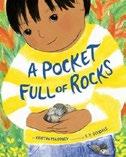
Throughout the year, a youngster explores all the things one can do with a pocketful of nature.
Anyone who washes a child’s clothes learns an important lesson— check the pockets first. But where an adult might find a jumble of rocks and other detritus, a child sees a world of comfort and possibility. Told in the second person with a repeating structure, the story follows a little one who gathers up treasures from nature and puts them to imaginative use. In the winter, a pocketful of rocks becomes “chairs for fairies to rest on.” Spring flower petals are transformed into perfume. Summer brings shells that sound like the ocean, and fall acorns make “perfect hats for the fairies now that the weather is getting cool.” At the end of each season, the child transfers the treasures into a jar to make room for the next discoveries. When the year ends, the young protagonist gifts them to the rest of the family. With an empty jar and a pocketful of rocks, the cycle starts again. A sour note in an otherwise sweet story is the dismissiveness of the protagonist’s family. With each new pocketful, Mom, Dad, and the child’s sister look up from their own activities to discourage the young narrator; petals will wilt, and collecting shells brings in sand. Still, the solitary child finds a way to make space for creativity. Soft, colorful illustrations provide quiet beauty. Characters are brown-skinned. A meditative homage to the creative universe inside a child’s mind—and pockets. (Picture book. 4-8)
A gentle look at the importance
Marcero, Deborah | Putnam (40 pp.)
$18.99 | Feb. 4, 2025 | 9780593696699

Youngsters strive to achieve their dreams.
Llewellyn, a contemplative white rabbit, starts collecting his dreams in jars, no matter how silly, loud, or quiet they are. After wishing for friends to play with, he encounters fellow hares Veera and Jaxx and introduces them to the joy of saving one’s hopes. Eventually, those small yearnings (“I wish I could see a caterpillar turn into a butterfly”) turn into grand aspirations (“I dream of going to the moon!”); the bunnies collect them en masse in an open wooded area. After a terrible storm hits, their colorful jars are destroyed, and they wonder, “What was the point of dreaming if everything could be lost?” But then they witness one of their hopes becoming a reality in the form of a graceful butterfly flitting away from their sole remaining jar. The friends decide to be grateful for what they have and continue to dream big things while being open to new experiences and the possibility of letting some dreams go. Fans of Marcero’s previous outings with Llewellyn— In a Jar (2020) and Out of a Jar (2022)—will thoroughly enjoy this sweet, affirming tale. Her watercolor, pencil, ink, and digital illustrations are bathed in soothing blues, yellows, purples, and greens while using perspective to give the world, both big and small, a sense of profundity from any angle. A gentle look at the importance of always keeping hope alive. (Picture book. 4-7)
Kirkus Star
Marianayagam, Maria | Harper/ HarperCollins (256 pp.) | $18.99
Jan. 14, 2025 | 9780063360921
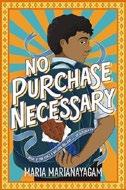
Ajay Anthonipillai has just won $1 million—and he’s in huge trouble. Starting eighth grade in a new school, Ajay is determined to avoid being labeled as “Obnoxious Ajay” again, the social outcast who’s completely consumed by grades. But when he gets a 79% in language arts and lands on the wrong side of popular Jacob Underson, things start to spiral out of control. Before he knows it, he’s lied to his parents, stolen a chocolate bar from the local convenience store, maybe won a huge jackpot as a result, and taken a part-time job at the store in order to try to destroy the evidence of his crime. The depictions of the family members—Ajay, younger sister Aarthi, and the kids’ Sri Lankan Catholic immigrant parents, all living in a largely white, suburban community—offer valuable insights into a specific cultural experience that will also resonate with children of immigrant families from other communities. Contextual clues situate the story in the early 2000s, but the setting’s vagueness gives it a timeless feeling. Most of the characters, including the villains, are multi-dimensional actors with realistic motivations. The close relationship between Ajay and Aarthi, who face similar challenges in different ways, is particularly well rendered. The novel’s plot twists will especially entrance and surprise younger audiences and those able to suspend disbelief and go with the
flow of this completely age-appropriate and appealing story.
Utter fun. (rules of the Anthonipillai household, glossary, references, discussion questions) (Fiction. 8-12)
Martin, Henry | Illus. by Shelley Hampe | Abrams (40 pp.) | $19.99 Feb. 4, 2025 | 9781949480535
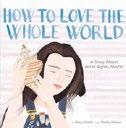
A loving portrait of an intense, solitary American artist who found ways to express deep feelings in her minimalist abstractions.
Author Martin (no relation to the artist) may be overreaching when he claims that painter Agnes Martin (1912-2004) is as famous as Georgia O’Keeffe and Frida Kahlo, and rather than providing concrete biographical details or even acknowledging that she was diagnosed with schizophrenia, he makes oblique references to her art materials and emotional extremes (such as her early tendency to set unsatisfactory work on fire). Still, in rapturous prose, he does coherently retrace her artistic development as she learned better ways of expressing her deep love for nature and the world with an “ordinary line” and shimmering colors: “Agnes’s ordered and controlled grid paintings of joy became translucent and expansive band paintings of happiness.” Hampe follows along, adding straight and flowing lines over subtle washes of transparent color and focusing more on evocations of select works than on depicting the artist herself. Readers catch only brief glimpses of a stylized face, a pair of hands, and a small figure who, even in the afterword’s one photo, is turned away from viewers. Readers’ appreciation for the qualities and appeal of her art will be further whetted by the occasional direct quote.
Emotionally rich, if so sketchy that the subject remains a remote figure. (list of works mentioned, citations for quotes and anecdotes, sources) (Picture-book biography. 7-9)
McKinlay, Meg | Illus. by Karen Blair
Candlewick (32 pp.) | $18.99
Jan. 28, 2025 | 9781536236057

A tot prepares for bed with a little help from a loving bear.
“When the sun’s light is fading / and night’s on the rise, / it’s time to start yawning / your sleepy goodbyes.” The narrator of this gentle rhyming tale appears to be the anthropomorphic bear who helps a young child settle into bed. The little one is light-skinned and has short, straight, strawberry-blond hair, while the brown, pajama-clad animal would be right at home in one of Virginia Miller’s bear books. There’s nothing threatening about the large creature, who looks on as the child bathes and dons pajamas, helps the youngster find a lost teddy, reads a story, and finally tucks the child in for the night with “a huggily hug, and a smoochily kiss.” Readers may wonder at the omission of toothbrushing, but there’s certainly no missing the affection between the child and the bear, and the warm palette and soft lines and forms that make up the illustrations only enhance the text’s soothing tone. At book’s end, the sleepy bear, duty done, retreats to the blanket fort where it first appeared with the child on the opening endpapers for some shut-eye as well, taking the narrative full circle. An artfully constructed bedtime book. (Picture book. 0-4)
Michelson, Richard | Illus. by Joe Cepeda | Peachtree (32 pp.)
$18.99 | Jan. 7, 2025 | 9781682636145

Moses’ mom gives money to Barefoot Benny, who’s unhoused, even though it’ll mean buying Moses secondhand sneakers again, and she prods Moses to donate, too. Though Moses protests (“Mom, we have little enough”), Mom says, “Little enough is more than enough for us.” With his parents’ guidance, however, Moses learns the importance of giving as he sees formerly impoverished people find work and help others. Benny becomes a barber and gives bedraggled Big Jim a free haircut. Later, Moses and Big Jim, now a janitor, watch baby PJ for free when Ms. Brown goes to a job interview. Moses invites a friend to a Jewish New Year celebration, assists at a soup kitchen at Christmastime, and persuades Pops to hire his friend’s unemployed father at his new store. Moses’ attitudes evolve as he learns to give freely without expecting thanks; backmatter emphasizes that in Judaism, charity is a “sacred and ethical obligation,” and it explains the Jewish philosopher Maimonides’ concept of the golden ladder of giving, which classifies acts of charity, from the first rung (when donations are given reluctantly) to the last, creating a job for someone so that they, too, can help others. Michelson makes a potentially complex topic accessible, while Cepeda’s bright paintings, each with brilliant backdrops, bring to life a bustling city. Most characters are brown-skinned; Moses and his family are cued Jewish.
A child-friendly exploration of charity. (Picture book. 6-9)
Moses, Shelia P. | Illus. by Keith Mallett
Nancy Paulsen Books (32 pp.)
$18.99 | Jan. 7, 2025 | 9780593617298
Alabama, to Washington, D.C., proud to be taking part in this momentous occasion in the summer of 1963. Munching on a homemade sandwich, Agnes dreams of prominent figures of the Civil Rights Movement such as Sidney Poitier, Lena Horne, and Jackie Robinson. (Backmatter offers a spotlight on some of the famous people who were part of the March.) Once in D.C., a detour to the historic home of Frederick Douglass places a lot of what’s happening in helpful perspective. The family reads a famous quote by Douglass: “I would unite with anybody to do right and with nobody to do wrong.” Agnes is pleasantly surprised to see people from all walks of life using the same water fountains (there are no “whites only” signs in sight), marching shoulder to shoulder, sharing a poignant moment in the reflection pond, and uniting for what’s right. Sitting on Daddy’s shoulders, Agnes takes in monumental words from John Lewis and Josephine Baker, a moving performance from Mahalia Jackson, and, ultimately, Dr. Martin Luther King Jr.’s “I Have a Dream” speech. Moses’ text is tinged with childlike excitement and wonder. Mallett’s digital illustrations glow with warmth, with Agnes’ braids and yellow bows framing her joyful face as she listens to the speakers with pride. A stirring tale and proof positive that young people can help make history, too. (author’s note) (Picture book. 6–9)
Nava, Eva Wong | Illus. by Natelle Quek | Candlewick (32 pp.) | $18.99 Dec. 17, 2024 | 9781536238792
People in Moses’ urban neighborhood have varying levels of economic need.

The March on Washington for Jobs and Freedom, seen through the eyes of a young Black girl. Along with her parents, young Agnes travels by bus from Birmingham,

A grandmother and grandchild share their love through the years by making dumplings for each other. Poetic text describes a child’s active grandmother as she “moves to tai chi beats” (“Slow. Firm. Focused ”) and walks home in the autumn leaves
(“ ka-runch, ka-runch, ka-runch ”). At home, the two prepare dumplings, dancing in the swirls of steam. As they eat them afterward, Grandma’s love “fills up my tummy.” Delicate illustrations full of movement and color portray family life through the seasons, while borders of flowers, leaves, and airy swirls frame many of the spreads. When Grandma falls ill, the story takes a turn as the child’s heart squeezes and “ da-dubs with fear” and memories of Grandma float in the swirls of incense smoke. The profusion of flower imagery returns when Grandma recovers and both, noticeably changed by time, return to their old places for tai chi and dancing. Soon it’s the child’s turn to make dumplings for Grandma, and the same love fills their tummies. Similar themes are more poignantly expressed in Laolao’s Dumplings by Dane Liu and Shinyeon Moon, but the art shines here. The child, grandmother, and mother, who present East Asian, are depicted throughout as the family unit. Lovely artwork elevates a familiar theme. (Picture book. 4-8)
Nelson, Vaunda Micheaux | Dutton (320 pp.) $18.99 | Jan. 7, 2025 | 9780593855782
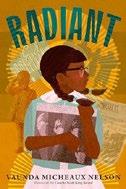
In 1963 Pennsylvania, a Black girl negotiates the impact of race on her journey to thrive. For precocious fifth grader Cooper Dale, life is good. Mostly. She has a loving family and lots of hobbies, but she also has a secret: Sometimes, she wishes she were white.
Not that she’s ashamed to be Black—“At church / I’m proud to be brown … / … I breathe, breathe, breathe in / the church feeling. / I store it inside me / and carry it / to school.” But if she wasn’t the only Black student in her class, maybe her racist bully would leave her alone and she could really shine, like her mama says she should. As she navigates life’s ups and downs—the assassination of JFK, the rise of Beatlemania, her conflicted feelings about her mother’s being a cleaner—Cooper reflects on the impact of skin color in the world around her and wonders how she can let meanness and unfairness roll off her back. The era’s more pernicious racist aspects are handled obliquely. This verse novel examines complex themes of identity, forgiveness, self-love, and self- actualization through writing that’s accessible to young readers. Nelson intentionally and deftly uses details to situate the novel with history, and she’s crafted an endearing, three-dimensional protagonist in Cooper, whose voice and authentic struggle to make sense of her experiences will resonate in a work that presents fertile ground for discussion. A complex yet accessible exploration of self-actualization, presented in full color. (Verse historical fiction. 10-14)
Newman, Patricia | Millbrook/Lerner (56 pp.)
$34.65 PLB | Oct. 1, 2024 | 9798765607992
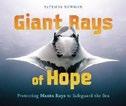
Manta rays become the stars of successful conservation work. Newman spotlights Peruvian marine scientist
A complex yet accessible exploration of self-actualization, presented in full color.
Kerstin Forsberg, who was struck by the number of turtles turning up dead or injured after they became tangled in fishing nets. Sea turtles are a crucial part of the ecosystem—something that many didn’t realize. Eager to spread awareness among young people, in 2009 she helped create the Marine Educators Network of Northern Perú. When another scientist, Andrea Marshall, needed help tracking down a lost tag that had been attached to a manta ray swimming in the waters near northern Peru, Forsberg stepped in to assist. She soon realized the rays could be a compelling way to encourage interest in ocean conservation—and to empower locals to take “starring roles” when it came to activism. Her organization, Planeta Océano, led expeditions where people could swim with the gentle giants, organized classroom lessons and community-wide celebrations of the rays, and asked fishers to let them know when they spotted mantas. Forsberg worked with fishers to help them avoid manta bycatch and drafted a national protection policy, which was eventually passed. Newman ably explains the concept of flagship species—animals that “grab people’s attention and make them care about protecting the environment.” Her feel-good account includes photos and quotations from local fishers and young people, as well as plenty of information about the rays themselves. Good news about a marine marvel. (timeline, author’s note, note from Forsberg, glossary, source notes, selected bibliography, further reading and websites, index, photo credits) (Nonfiction. 10-14)
Newson, Karl | Illus. by Ela Smietanka Templar/Candlewick (32 pp.) | $17.99 Feb. 4, 2025 | 9781536241198

A group of youngsters, dressed as a menagerie of animals, trumpet messages of self-acceptance. In a variety of child-centric settings, such as the park, a birthday
party, and the beach, kiddos extol the importance of staying true to themselves: “Whoever you are, whatever you do, however you feel… be YOU!” A page turn reveals a jaunty list: “Whether you’re a… toucan / tiger / crocodile / frog / monkey / elephant / turtle / dog,” Newson says, “wherever you’ve been, whatever you are, wherever you go… you’re gonna go far!” The tots not only showcase a diverse set of zoological creatures with their outfits, but also have varying skin tones and physical abilities (children use wheelchairs, crutches, and hearing aids; several wear very stylish glasses). The uplifting, minimal text trips merrily along, encouraging readers to believe in themselves while also acknowledging the difficult spots: “There may be days you’re feeling blue. But you’ve got me and I’ve got you. Together there’s nothing that we can’t do!” In addition to bolstering kids’ feelings, the costumed characters may even inspire some fun dress-up options for pretend play. A joyful treatise on confidence. (Picture book. 3-6)
Noble, Rachel | Illus. by Annabel Tempest | Page Street (32 pp.)
$18.99 | Jan. 7, 2025 | 9798890031600
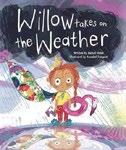
One young force of nature tackles several others when rain and wind swoop in to spoil her plans to play outside. Having gathered up a pool toy and other props for a round of play outdoors, Willow—portrayed as a tan-skinned child with unruly red hair—is in no mood to let a storm interfere. But when her determined efforts to blow away the swirling winds, push off the gray clouds, and bat back the rain prove futile, she changes tack and goes on to enjoy a morning of dancing in puddles with a puffy dark cloud, playing tug of war with the purple wind, and
A silly bedtime caper, likely to elicit more giggles than yawns.
THE BEAR, THE BOOK, AND THE BLANKET
chasing rainbows until it’s time to go back indoors and the sun comes out to beam brightly over all. “Thank you, Weather! Get ready for tomorrow,” she beams back, gathering her gear and waving goodbye. “We’ve got big plans!” The aptly named illustrator depicts the various weather elements in translucent digital watercolors with smiling faces. Willow displays an admirable mix of strongmindedness and adaptability, with a big personality that shines out in the splashy illustrations. Readers with a taste for solitary play who identify with characters such as Peter in Ezra Jack Keats’ Snowy Day will enjoy this summery alternative.
A sunny tale about making the most of stormy weather. (Picture book. 5-7)
Obuobi, Laura | Illus. by Olivia Duchess Harper/HarperCollins (40 pp.)
$19.99 | Jan. 21, 2025 | 9780063222465

A profile of the late Michaela Mabinty
DePrince, who broke barriers as a dancer of color in the predominantly white world of ballet.
Outside an orphanage in Sierra Leone, a ballet magazine floats on the wind and lands in a young girl’s hands. Michaela’s obsession with ballet and her determination to dance only grow after she is adopted and moves to the United States. With dark brown skin, dark curls, and vitiligo, Michaela faces judgment and rejection from the ballet community
from the start, enduring discouraging criticism about her body type and skin color. Michaela’s warm, loving white mother is a pillar of support, helping her dye her tights and paint her pointe shoes brown to match her skin tone and instilling confidence in her daughter, even when Michaela doubts herself. As she grows into a young woman, Michaela lands coveted roles such as the Sugar Plum Fairy in The Nutcracker and Odette in Swan Lake, “twirling ribbons of hope around hearts” and serving as inspiration to other young brown girls. Swirling strokes of white evoke the dancers’ movement throughout the story, wrapping around dynamic digital illustrations of Michaela as she matures. The ballerinas who surround Michaela in childhood present white, while the final spread shows her as an adult, trailed by young ballerinas with a wide range of skin tones, hairstyles, and body types. An author’s note speaks to DePrince’s recent death and the legacy she leaves behind. An uplifting reminder to jeté toward your dreams. (selected sources) (Picture-book biography. 4-7)
$19.99 | Oct. 1, 2024 | 9780593755006
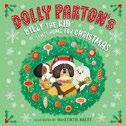
In this follow-up to singer Parton and co-author Perl’s Billy the Kid Makes It Big (2023), literal and figurative bumps in the road imperil the touring canine country star’s promise to be home for Christmas.
Inspired by one of Parton’s holiday songs, the tale sees Billy, a small brown French bulldog, and bandmates Bo, Buster, and Binky boarding a tour bus for “pawsome” glimpses of natural wonders along with meetings with fans and “puparazzi.” Then, although Billy has sent many letters home promising to be there for the holiday, an invitation to play Barkafeller Center on Christmas Day instantly changes his tune. “Billy was happy. Though he still felt a little…he wasn’t sure what.” Readers may be excused for having mixed feelings about his mixed feelings, not to mention his tersely unapologetic note to the folks. But when, thanks to a bus-busting rock in the road on Christmas Eve, it looks like the band will have to contrive their own celebration (“Silent night, howly night”), Billy remembers that he started making music in the first place for his loved ones. He has no problem bagging the big concert (Fans? What fans? Contract? What contract?) when Dolly herself rolls up in her own bus to offer a ride back to his “Tennessee mountain home” in time for a small show for “the most important audience in the world.” While Billy cuts an endearing figure in Haley’s cartoonish illustrations, his willingness to disappoint first family, then fans may have readers feeling less than cheery. A holiday outing that doesn’t quite satisfy. (lyrics to Parton’s “Comin’ Home for Christmas”) (Picture book. 5-7)
Peacock, Lou | Illus. by Ged Adamson Nosy Crow (32 pp.) | $18.99 Nov. 5, 2024 | 9798887771007
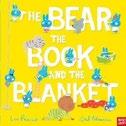
A fluffle of bunnies are on an alliterative mission to get a human infant to sleep. Ten bright-blue rabbits, each with names beginning with B, tromp into Baby’s room. The narrator quickly reminds the bunnies that it’s Baby’s bedtime.
“SHHHHHHH.” But wait. “Baby needs Bear, Book, and Blanket.” The cottontails quickly begin searching for Baby’s teddy. Many are found, but none of them are Baby’s cherished plaything. Finally, Baby is reunited with Bear. (Turns out one of the bunnies, Bobbie, had found the plush toy and was reluctant to part with it—a scene that will have readers chuckling.) Time to find Book and Blanket! As the eager bunnies scurry off chaotically, the weary narrator tries to rein them in: “Bunnies…you don’t need to take all the books off all the shelves.” (A nonplussed cat looks on.) The bunnies all wear distinct items of clothing so readers can follow their various paths, noting their contributions toward Baby’s nighttime goal. The droll narration pairs well with the scampering helpers, who never give up. Understandably, all the bunnies are exhausted by book’s end. It’s now time for them to snuggle up with their own bears, books, and blankets. Hopefully, sleepy readers will follow suit. In Adamson’s flat, exaggerated cartoon art, Baby has brown skin and a single squiggle of brown hair. A silly bedtime caper, likely to elicit more giggles than yawns. (Picture book. 3-6)
Peckham, Anthony | Atheneum (336 pp.)
$17.99 | Jan. 21, 2025 | 9781665913164
Series: Children of the Black Glass, 2

In this sequel to 2023’s Children of the Black Glass, a brother and sister must undertake several life-threatening journeys to save their people and one another.
After Wren plunges into the timeless and idyllic land of death to fetch back poisoned big brother Tell, who’s oddly changed by the experience, she struggles harder than ever to control her sorcerous powers. Now, the close-knit siblings are forced to confront multiple murderous foes as they struggle to
negotiate narrow mountain ledges to deliver a caravan of supplies to their hard-bitten mountain folk before traveling back down to the hostile town of Halfway on another mission. While the slow-paced plot feels excessively drawn out, the threat of brutal foreign mercenaries, who wear their hair in “ornate braids that [look] like rope,” and the necessity of persuading reluctant villagers to move down the slope before the arrival of a deadly oncoming winter, do raise the stakes. The central characters’ close ties and the distinctively flinty character of the setting and the supporting cast tie this entry to the opener, and a forcible separation at the end that leaves one sibling in the clutches of a mad sorcerer point to future rescues and exploits. Most characters present white. Rising stakes and some character development keep this tale trundling along. (Fantasy. 10-14)
Preble, Joy | Illus. by Valeria Cis Kar-Ben (32 pp.) | $18.99
Jan. 7, 2025 | 9798765629949

A child plans a Passover seder when a beloved neighbor, who usually hosts it, has a medical emergency.
Mia loves seders at Edie Rose’s apartment. Everyone in the building is invited, and Edie arranges things so the guests won’t have to bring anything. Mia enjoys making decorations and acting out parts of the Passover story. Edie, who has wrinkles and salt-and-pepper hair, tells Mia that when Moses led his people out of Egypt, they worked together. This year, though, Edie falls and injures her arm shortly before Passover and won’t be able to prepare the seder. Inspired by stories of Edie’s adventures around the world, Mia sets out on a journey of her own to make Edie’s seder happen after all. Edie and Mia’s sweet intergenerational friendship notwithstanding, astute readers may wonder why Edie usually
insists on preparing everything herself while extolling the art of working together. Common Passover foods, such as macaroons and potato kugel, are referenced, as well as seder activities such as searching for the afikomen and reciting the Four Questions. In the stylized illustrations, Mia has light brown skin and curly hair, Edie is light-skinned, and the building’s residents are diverse. A brief paragraph describes the basics of Passover, but adults introducing the holiday to children may want to pair this tale with books that contain more extensive backmatter. Friendship and community building are welcome themes in this Passover tale. (Picture book. 4-9)
Rappaport, Doreen | Illus. by Tonya Engel Little, Brown (48 pp.) | $19.99 | Jan. 14, 2025 9780316397834 | Series: Big Words

A respectful profile of Barack Obama, from childhood to the White House. Readers will have to learn elsewhere that Obama is still alive and a public figure, since the appended timeline ends in 2017, before much of the intended audience was born. Rappaport’s narrative ends even earlier than that, with approving references to his overseeing the 2011 assassination of Osama Bin Laden and the 2012 Deferred Action for Childhood Arrivals (DACA) executive order. Still, along with laying out major events in his life (so far) in a narrative punctuated by direct quotes, she does illuminate some nuances in his character. She notes that he lived comfortably in Indonesia rather than in “hovels” like many of his neighbors and that he didn’t have the smoothest relationship with his distant, autocratic birth father. More significantly, the author links early lessons in Civil Rights history from Obama’s mother (“Five days a week, at four in the morning”) and guidance in
treating others with compassion from his loving adoptive father. She also links his resolution of his early confusion about his own racial identity to his later firm, principled commitment to equality across lines of race and social class in the face of determined opposition from Republican opponents and “vicious assaults” from the media. Flashing that wide smile from an early age, he cuts a dignified figure in Engel’s illustrations, both in cozy family settings and posing before racially diverse crowds. Further cements the 44th U.S. president’s status as a strong role model and an admirable human being. (author’s and illustrator’s notes, selected bibliography, source notes) (Picture-book biography. 6-9)
Raúl the Third | Colors by Elaine Bay Little, Brown Ink (128 pp.) | $14.99 | Jan. 28, 2025 9780316528689 | Series: The Snips, 1
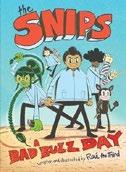
A team of buzzworthy heroes foil a hair-raising plot. Over in Scissors City stands the sharp Tijera Tower, part headquarters, part museum for the hair-oic Snips, a quintet consisting of brilliant scientist Casco Hardhat, madcap inventor Patty Pomada, tomb-raiding botanist Letty Lentes, cybernetically enhanced Nubes Cloudhead, and wunderkind pooch Flealix. The famous Snips provide the city’s residents with “DAZZLING DOs” and relative safety from potential “HAIRTASTROPHES.” From the onset, author/illustrator Raúl the Third and returning colorist Bay weave an
adventure that’s packed with punny humor, hair-larious worldbuilding, and richly hued artwork, all centered on a racially diverse crew (Letty, in fact, is green-skinned). When a gel-ous trio calling themselves the Bad Buzz Boyz hatch a scheme that involves unleashing a bizarre and unruly creature on the city, the Snips bounce into action. Meanwhile, the Bad Buzz Boyz start on their true goal: breaking the world record for most haircuts in a day (a record currently held by Nubes) to impress their father and reclaim the cut-rate honor for his company, Buzz Corp. Despite an uneven pace, this hero romp buzzes with action-filled thrills. Spanish words and phrases dot the primarily English text to add extra twists to this do.
A shear feast of an adventure. (snippets from Flealix) (Graphic fiction. 7-10)
Rendon, Marcie | Illus. by Mangeshig Pawis-Steckley | Heartdrum (40 pp.)
$19.99 | Oct. 22, 2024 | 9780063218680
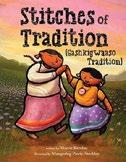
“Traditions stitch together generations with love.” Nookomis (Ojibwe for Grandmother) sews a ribbon skirt for her narrating granddaughter to wear to a new baby’s naming ceremony. Time passes, and Nookomis makes the child new skirts to mark other occasions—the Fall Ceremony, a beloved aunt becoming a district judge, and, at last, the protagonist’s comingof-age ceremony. The book ends with
the child—now a young woman—welcomed into a circle of loving female relatives. Employing straightforward, matter-of-fact text that’s nevertheless steeped in meaning, Rendon (Ojibwe) beautifully pays tribute to the deep bond between elders and the next generation. She relies on a repetitive structure: Each time, Nookomis selects the right fabrics and colors and takes precise measurements before creating a new skirt. Poignant details, such as the child growing taller as Nookomis grows shorter, emphasize the passage of time. The repeated phrase “My granddaughter, live a good life” anchors the narrative as the years go by. Pawis-Steckley’s (Ojibwe) thick-lined art depicts sturdy, stylized characters sporting brilliantly textured garments that pop with color; readers will feel welcomed into the community alongside Nookomis and her granddaughter. Rendon expertly works information about Ojibwe culture into the narrative; her author’s note explains that ribbon skirts are a “sacred, spiritual, and political” symbol of Indigenous resilience, passed down by generations of women.
A radiant and joyful glimpse at an important Native tradition. (Ojibwe glossary, note from Heartdrum founder Cynthia Leitich Smith) (Picture book. 4-8)
Reyes, Megan | Illus. by Kay Davault | Random House (128 pp.)
$6.99 paper | Jan. 7, 2025
9780593808542 | Series: Llama Quest

W hen adventure calls, a youngster leaves his parents’ llama farm and sets out on a quest. While shoveling llama poop one day, brownskinned 8-year-old Dak Evans notices a pale-skinned, bespectacled, purple-haired girl nearby. Lucy, a llama owned by the
monks at the temple next door, awakens him that night and leads him to meet the girl, an aspiring wizard named Fenn, but it’s Lucy—apparently a magical creature with great powers—who announces that Dak will need to help save everyone from danger. She tells him of a lengthy war fought over magic stones that were later hidden in the monks’ temple. The Kingdom of Ravenwood has been peaceful ever since. But the stones have been stolen, and so the journey to find them, and the thief, begins. Dak’s grit and yen for adventure have caught Lucy’s eye, and she chooses him and Fenn to be her companions. But it won’t be easy: Their search for the first stone takes them to a den full of fire-breathing dragons. The narrative incorporates common fantasy tropes—teleportation, magic shields—but the overall threat feels too vague to be truly menacing. While the book contains little internal conflict and the worldbuilding isn’t especially original, it has enough action to entice newcomers to the genre. Human characters are drawn as standard cartoon types in the grayscale art, but the dragons are impressive, and Lucy is adorable. Solid, though familiar, fantasy fare for readers not quite ready for Tolkien. (map, excerpt from Fenn’s creature journal, questions and activities) (Fantasy. 6-9)
Reyes, Megan | Illus. by Kay Davault Random House (128 pp.) | $6.99 paper | Jan. 7, 2025 | 9780593808573
Series: Llama Quest

sees the Stone Seekers—youngsters Dak and Fenn and Lucy the magical llama— preparing for a new mission by researching in the library. After they teleport to the forest near the royal castle, they realize that the alicorns—winged unicorns capable of telekinesis—have the stone. Alicorns are notoriously shy, so the team members seek help from Queen Luna. Though the palace is aflutter with preparations for a royal wedding, the queen invites them to consult the royal library. Along the way, they befriend Prince Kamoni and his friend Antonia (both wizard students) and encounter the alicorns. While Reyes relies on well-trod fantasy themes and tropes, young readers will find this book a welcome introduction to the genre. The writing is clear and the pacing effective. Compared with the first volume, this tale offers more character growth and minor but significant internal conflict. Dak deals with complex feelings toward Fenn; he finds her a bit bossy but wishes he could emulate her bravery and confidence. The cartoon art is at its best when depicting the alicorns. Dak, Queen Luna, and Kamoni appear brown-skinned in the illustrations, while Fenn and Antonia are light-skinned.
Fun escapades for budding fantasy fans. (map, excerpt from Fenn’s creature journal, questions and activities) (Fantasy. 6-9)
Rotner, Shelley | Holiday House (40 pp.) $18.99 | Jan. 7, 2025 | 9780823457854
A trio of adventurers search for the second of 12 missing magic stones in order to safeguard the Kingdom of Ravenwood. Picking up a week after the
events chronicled in the first installment (summed up in a quick recap), this book
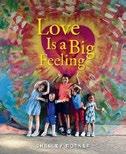
Full-color photographs showcase expressions and examples of love. Rotner, the author of similar photo-heavy titles, opens by proclaiming, “Love is a big feeling that comes from deep inside.” She goes on to describe love as a smile, a hug, and a hand; she adds that love can be found in a dance, in a story, and in art and among both family and
Luke Pearson thought he was done with his beloved children’s series. The characters informed him otherwise.
BY MICHAEL SCHAUB

IN 2019, BRITISH AUTHOR and artist Luke Pearson told a German newspaper that he would be stepping away from the world of Hilda, star of his popular series of children’s graphic novels featuring a curious, kindhearted young girl and her pet “deerfox,” Twig. Pearson had just published Hilda and the Mountain King ; the book, he said, would be the last in the series for a long while.
Fans of the series were not totally bereft, though—the previous year, Netflix had started streaming an animated show based on the character. The series, which Pearson created, wrote for, and co-executive produced, was a hit with critics and viewers alike and spawned several tie-in storybooks. But after the last episode aired in 2023, Pearson noticed that something was missing in his life.
“It was the end of various journeys,” Pearson says of the show wrapping up. “I seem to remember there was a day when I watched [the last episode], and then a couple of pieces of fan mail came in from little kids asking if there were going to be more books. I just had this strong feeling of I don’t actually want to be done with this.”
That was the origin for Hilda and Twig: Hide From the Rain, the latest installment in the series. Just like the first books featuring Hilda, this one takes place in the wilderness and not the city of Trolberg, where Hilda, her mother (Johanna), and Twig later move. This book puts the spotlight on Twig, who must protect his friend from a giant snake after the girl and the deerfox become separated on an adventure. It’s slated for publication by Flying Eye Books on Nov. 5.
Pearson discussed Hilda and his latest book via Zoom from his home in Nottingham, England. Our conversation has been condensed and edited for length and clarity.

to try and capture in comic form. Hilda was a character I’d been doodling, and I wasn’t quite sure what to do with her, so I paired her with this world. The first story was very simple; not a lot happens. It was just her and a troll and Twig.
Was Hilda based on your own experiences growing up at all?
the character was going to grow and I was going to build this world out, there was only so far [I] could really go with [the wilderness setting]. I was also keen to flex, from an artistic point of view. I wanted to draw some buildings. I wanted to draw more characters. Ultimately, I was just following my interests at the time.
Hilda’s become an iconic character in children’s literature. What was the initial inspiration behind her?
She didn’t emerge fully formed. The initial inspiration
was Scandinavian folklore and reading tales about trolls and elves. I got into that, and I felt like I was interested in doing some children’s work, and there was a vibe to some of those stories that I wanted
Initially, no. The setup of the cabin in the wilderness couldn’t really be further from my personal childhood. And the idea of this carefree kid who isn’t afraid of anything and explores independently—that was not me. But then she moves to Trolberg, and [part of that move was so] I could bring in more of my own childhood experiences that I felt would be relevant and recognizable to kids.
After the first couple of books, I could foresee that if
Having said that “there’s only so much you can do with the wilderness,” I have to walk back that statement, since that’s exactly why I’m now returning to the wilderness—to get away from the city and the expanse that Trolberg has become over the years. [Laughs.]
Twig’s name is finally in the title of this one. Did you want to explore him more as a character?
At some point, I thought about and discussed doing
some kind of spinoff that would focus on Twig. In the later comics, I realized, I wouldn’t really give him a lot to do. That kind of happened in the Netflix series as well, where people would be writing scripts, I would be writing scripts, and Twig just wouldn’t get mentioned. That was partly the original impetus for writing the episode of the series where Twig runs away. He runs away because he’s not getting involved in the adventures, which was a reflection of how it felt to me in the writing process. He was always getting left out, and it felt natural that he would feel that in the world as well.
At that point, I didn’t want to take the series forward. Partly I wanted to let the series end and see where
everything would sit. I felt like it would be really fun to have Hilda behaving like Hilda and then see Twig’s internal monologue and see that maybe sometimes he’s pulling the strings. He’s the one leading the adventure, and Hilda doesn’t quite realize that, and that felt like a really fun dynamic to explore.
Have your own kids read the books or watched the series?
Yeah, they’ve watched the series. My oldest is 7. It wasn’t really until the last season that she took a real interest. We watched season 2 with her, and it was a bit old for her; she was kind of spacing out. But she got really into season 3, which was nice to experience. She’d be watching [the episodes] on repeat and asking me stuff
about them and properly engaging with them, and that was really fun.
She also had the books, and she’d flick through them, but she was never super interested. That’s connected to this new book, because I wanted to do something that would be more easily digested by a younger reader. I specifically wanted this book to be one that you could sit down and read akin to a picture book, [something] that would have about the length and the kind of page-turning speed of a bedtime story. So you could read it to a kid, it wouldn’t go on forever, and you could have a pace and some satisfying page turns.
Are Hilda and Twig coming back for any new books? That’s the plan.

That must be exciting, but also maybe intimidating, since you’ve created this world and you’re maybe thinking, Where do I go next? This one is essentially a prequel. It’s set before the original Hilda and the Troll. The vibe’s a little different. I’m hoping people like it. I did a reading of it to an audience of kids, and they seemed to react really well to it. It’s not lore-heavy, it’s not extremely [deep in the] established Hilda universe, it’s not a sequel to the show or to the last book—although I’m hoping to look forward at some point in the future. This is a slightly more self- contained thing that I’m hoping will be really satisfying to people.
Michael Schaub is a contributing writer.
I wanted to do something that would be more easily digested by a younger reader.
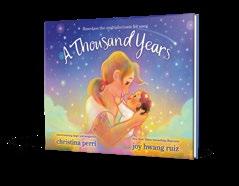
A Thousand Years is based on the singersongwriter’s 2011 hit single.
Singer-songwriter Christina Perri will make her literary debut next year with a children’s book.
Viking Books for Young Readers will publish Perri’s A Thousand Years, illustrated by Joy Hwang Ruiz, in the spring, the press announced in a news release. The press says the book contains “stunning illustrations of parenthood that complement Perri’s heartfelt lyrics.”

Perri burst onto the music scene in 2010 after one of her songs was featured on the reality competition series So You Think You Can Dance She released the EP The Ocean Way Sessions that same year and followed that up in 2011 with the album Lovestrong.
Also in 2011, she released “A Thousand Years” as part of the soundtrack album to the film The Twilight Saga: Breaking Dawn—Part 1 The lyrics to the single, which quickly became a hit, form the basis for her new book.
“Through the lens of special moments between mother and child, readers will see and feel the connection in this dreamy story,” Viking says. “From the first day they met to the first day of school, see how love transcends and evolves in this sweet pairing as they embrace change and courage.”
In a statement, Perri said, “It feels so right to read these words to my girls, so I hope you enjoy reading it to your little ones, too!”—M.S.

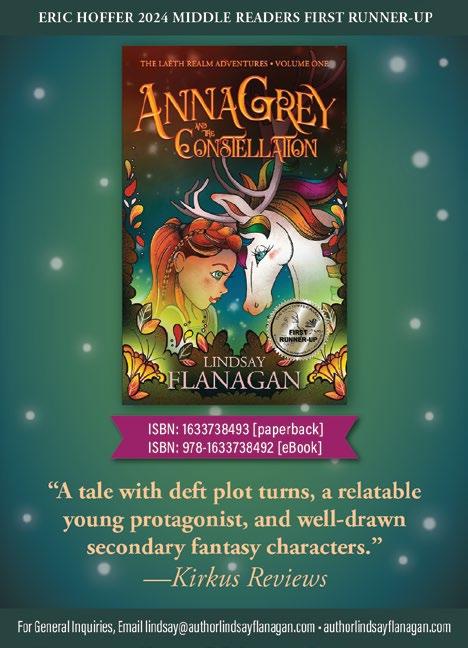


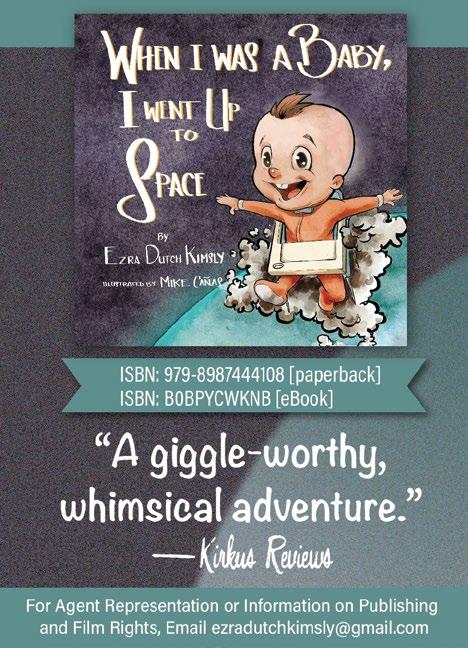

The Boston Celtics star’s Baby Dunks-aLot was published by Abrams.
NBA star Jayson Tatum stopped by CBS Mornings to discuss his new children’s book.
Tatum, the Boston Celtics small forward and five-time NBA All-Star, published his first book, Baby Dunks-a-Lot, co-written with Sam Apple and illustrated by Parker-Nia Gordon, with Abrams. The book follows a baby who becomes a basketball star after learning the sport from his family. A critic for Kirkus called it “silly and sporty in equal measure.”
Asked what made him want to write a children’s book, Tatum said, “I have to give a lot of credit to the author Sam Apple. His team came to my team two years ago with the idea. It was based on the relationship that I have with my son. Like many parents around the world who read children’s books to their kids at nighttime, that’s just something that we did.”
Tatum gently declined to say whether the antics of the book’s character—
including his constant singing of the infamous earworm “Baby Shark”— were inspired by his own son, Deuce.
“I can’t necessarily say so,” he said with a smile.
“Honestly, my favorite part is when him and his teammates take a nap.… Obviously as a parent, you need your kids to take a nap. And in the NBA, we all take naps before a game, so that was pretty funny.”—M.S.


friends. Each page brims with candid and posed photographs of diverse people, primarily kids (though adults appear as well), laughing, holding hands, and embracing in tangible demonstrations of love. The focus on children highlights their point of view and emphasizes the importance of their perspective. The images provide a helpful visual reference for little readers looking for cues to help them understand a complex and nuanced feeling. Multiracial families appear, as well as same-sex couples with children and a single parent with a child—inclusive representation that will help many readers feel seen. Though the text is occasionally a bit abstract, caregivers will be able to use this title as a springboard for discussing ways to show love and feel loved in return. The book closes with a reminder to care for the earth and each other and, importantly, to “love who you are.”
A meaningful celebration of love. (Picture book. 3-6)
Sánchez, Lauren | Illus. by Raleigh Stewart
The Collective Book Studio (32 pp.)
$19.95 | Sept. 10, 2024 | 9781685550639

A quick trip into space from the point of view of, literally, a fly on the wall.
Flynn, a fly who lives in West Texas, has trouble focusing on lessons in school. Nevertheless, Flynn longs to become an astronaut and realizes a lifelong dream by buzzing into a space capsule just as it’s about to be launched. After getting a high-five from one astronaut (which in a different, more realistic story would probably have been something other than a friendly welcome) and taking a gander with another at the planet below, Flynn returns to the surface to receive an astronaut pin and to reflect on “how learning about space helps us protect our home.” Flynn, or perhaps the author, should have paid more attention to those school lessons.
An astronaut wrongly claims that there’s “no gravity” in space, and the three crew members (who vary in skin tone) and their tiny stowaway apparently experience no G-forces at all on launch, since the only time it’s mentioned is upon reentry. The narrative is on the thin side and likely won’t entice youngsters for rereads. In Stewart’s elaborately constructed yet murky illustrations, the Statue of Liberty, the Eiffel Tower, and other landmarks not visible from space without telescopic aid loom large, along with the Grand Canyon and others that are. Members of Flynn’s heavily anthropomorphized fly family are depicted in shades of blue and brown. The dust jacket reverses into a skinny glow-in-the-dark poster.
A hero’s journey into outer space that plays fast and loose with the facts. (Picture book. 6-8)
Sewankambo, Yvonne | Illus. by Aurore McLeod | Candlewick (32 pp.)
$18.99 | Feb. 11, 2025 | 9781536239003

A child introduces a younger sibling to the world.
When the older sibling sees the younger one for the first time, it’s “love at first sight.” The protagonist is totally charmed by everything from the baby’s “button nose” to the infant’s diminutive size, even though it seems like all the newcomer does is “sleep, cry, drink, repeat.” As the baby matures, the illustrations show the siblings checking out new toys, taking walks in the woods, and playing hide-and-seek. As time
passes, the children watch clouds, “run around,” dance together, and make their parents laugh. Although they experience ups and downs such as “tantrums” and “squabbles,” the older sibling reassures the younger one that “no matter what happens, or where we both go, always remember that you can count on me.” After all, “there is no me without little you.” The book’s gentle, clear language and softly smudged illustrations combine for a tender tale about sibling love. While the text is more of a description than a story, the lyrical words and heartfelt sentiments compensate for the lack of plot. The child-friendly examples and hopeful conclusion make this the perfect tool for introducing children to their roles as older siblings or for celebrating family bonds. Both little ones are brown-skinned.
A sweet and affectionate window into the world of siblinghood.
(Picture book. 2-6)
Kirkus Star
Shaloshvili, Natalia | Candlewick (32 pp.) $17.99 | Nov. 5, 2024 | 9781536235548
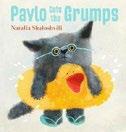
Can a kitten remain out of sorts when he’s double-teamed by a resourceful mama and a beloved friend?
It’s touch-and-go for most of the story as cranky Pavlo, clad in striped pajamas, rejects his mother’s suggestions about how they could spend the day. Not the park: “The swings are too swingy, the sandbox is too sandy, and… the slide is too SLIDEY !” Swimming is out, because “the water is too wet and…
A quick trip into space from the point of view of, literally, a fly on the wall.
THE FLY WHO FLEW TO SPACE
the fishies will nibble my toes!” The dark mood of the down-in-the-dumps, gray kitten is mitigated by Shaloshvili’s playful language and the light touch she employs as Pavlo imagines Mama’s proposed scenarios. Children will especially chuckle when Pavlo considers going to the movies; a dog, sitting next to a chicken, reaches over the seat to grab a handful of a distracted elephant’s popcorn. Despite the protagonist’s protests, the activities all look like great fun, and the softly textured acrylic, watercolor pencil, and digital illustrations create a cozy community of cheerful animals. After the grumpy youngster hears his friend Mila’s voice outside, he finally entertains Mama’s ideas; Mila’s hug helps even more, as does some ice cream. Featuring brilliantly rendered visuals with a tactile quality that will have readers eagerly poring over the pages, this clever tale captures the intensity of a youngster’s bad mood—and the speed with which it can transform into a good one. Young people will readily respond to this skillful rendition of free-floating unhappiness—and to its satisfying antidote. (Picture book. 2-5)
Shearer, Clea & Joanna Teplin | Illus. by Junissa Bianda | Random House (40 pp.)
$19.99 | Dec. 31, 2024 | 9780593712160
Series: The Home Edit for Kids
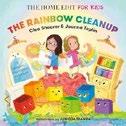
Shearer and Teplin, founders of the Home Edit—a company dedicated to decluttering domestic spaces— offer youngsters guidance on getting organized.
When Mia sleeps over at Hannah’s house, Hannah’s messy room keeps the girls from having fun. Every toy or activity is broken or has missing pieces. A storm rages outside, and the kids find themselves plunged into darkness. They hear voices as storage boxes, clothing, and pieces of furniture come
FIRST THERE WAS ME, THEN THERE WAS YOU
to life and offer to help the girls clean up. Mia suggests, “What if we make your room look like a rainbow?” (The ROYGBIV spectrum is at the heart of the Home Edit.) A list of basic rules appears on a pink piece of notebook paper: “1. Take everything out. 2. Put into piles. 3. Decide what to keep and what to give away. 4. Put things back where they belong.” Soon, old clothes and outgrown toys are ready for donation, art supplies have been properly arranged, and colorful storage boxes have been filled and labeled. The detailed digital illustrations are bright, but the rainbow organizational elements don’t stand out as they do in the vivid photographs in the authors’ adult books. While some parents may be able to use this book as an encouraging nod toward cleanliness, the narrative feels purposeful; it’s unlikely most kids will pick this one up on their own. The characters are light-skinned. Some helpful hints about keeping children’s rooms neat, but the storytelling falters. (note to parents and caregivers) (Picture book. 5-7)
Shum, Benson | Penguin Workshop (32 pp.) $10.99 | Dec. 31, 2024 | 9780593658871
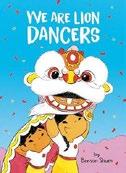
Two kids learn about the Chinese lion dance and try their hand at it themselves.
Lily and her brother, Noah, both cued Chinese and tan-skinned with black hair, encounter adult lion dancers at their kung fu club. Curious about the soft and colorful costume, they discover that the dance “scares away evil spirits” and “brings good luck and happiness to everyone for the New Year.”
They also learn about other festivities where the dance is commonly performed as well as the different dance styles (the Northern and Southern Lion). The performers show them how one dancer controls the lion’s head while another controls the tail; each must master different movements to bring the lion to life. Lily and Noah even get a chance to try the costume on—but it’s too big and heavy. Instead, they play the cymbals and gong as the adults practice. When they get home, however, they create their own lion out of cardboard, bed sheets, and other household items, then “LIFT AND SHAKE. LIFT AND SHAKE.”
On the day of the Lunar New Year parade, Lily and Noah play their instruments, take a bow, and receive a wonderful gift. Many stories about Lunar New Year feature lion dancing, but few delve into the meanings and mechanics behind the dance. Shum once again skillfully explains a Chinese tradition in accessible and engaging language filled with a wealth of information. Cute cartoon characters and bright colors create an inviting entree into a significant custom. Fun, informative, and festive. (more information on the lion dance) (Picture book. 3-7)
Soundar, Chitra | Illus. by Amberin Huq | Bloomsbury (32 pp.) | $18.99 Feb. 13, 2025 | 9781526642257

A South Asian family observes a holiday that honors the coming of spring. The family waits for the full moon that signals the beginning of Holi. To prepare, they collect wood for a bonfire,
clean the house, and gather flower petals, fruits, and tea to make natural dyes. Later, the family tells stories around the fire; the next day, joined by friends and family, they playfully spray each other with the colored powder and dye they made yesterday. Drumbeats form the soundtrack to the celebration as they “dance away the afternoon.” The festivities end with a delicious lunch consisting of spiced almond milk, a sweet pastry known as gujiya, and more. The book concludes with a reminder to “praise the love of god today” and to enter the new year with a spirit of generosity, forgiveness, and abundance. This is a lyrical, ebullient introduction to an important Hindu holiday. Huq’s energetic illustrations, appropriately filled with color and movement, depict characters with a variety of skin tones and abilities (one character uses a hearing aid), their faces radiating love and joy. While a few rhymes seem forced, these moments are quickly forgotten in the midst of some particularly lovely turns of phrase. Soundar highlights the major elements of the holiday, while backmatter includes further information and a glossary; those unfamiliar with Holi will emerge enlightened. Joyful, comprehensive, and poetic. (Picture book. 2-6)
Spicer Rice, Eleanor | Illus. by Max Temescu | Norton Young Readers (40 pp.) | $17.99 | $7.99 paper Feb. 4, 2025 | 9781324053712 9781324082378 paper | Series: The Deadliest
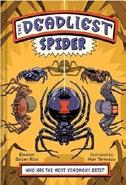
A rogue’s gallery of venomous spiders.
Claiming that her six profiles are “for fang fans only,” Spicer Rice in fact also offers broad views of the roles spiders play in food chains and ecosystems in general. She presents a sort of arachnid reality show that gives readers opportunities to pick the deadliest candidate and to come away appreciating the eight-legged horrors for their place in nature. “We have
them! We need them! Let’s love them!” she proposes in her frothy narrative. She notes that widow spiders come in white, red, and blue as well as black (and recluses come in shades other than brown), observes that Australian funnel-web spiders like to hide out in enclosed spaces such as shoes, and, with particular relish, details the painful, if seldom fatal, symptoms of being bitten by each of the contestants. Along with cartoon depictions of sick or terrified human victims of diverse hue, Temescu tucks in lots of close-up views of spiders, both anthropomorphic and anatomically correct, from spinnerets to “Fangs! Fangs!” All six are melodramatically posed along a “Death-O-Meter” at the end, next to a revelation that while almost no one dies from spider bites today, air pollution takes a far more lethal toll globally; even video games are deadlier. Terrifyingly informative. (drawing lesson) (Informational picture book. 6-8)
Stephens, Ann Marie | Illus. by Jenn Harney | Astra Young Readers (32 pp.) | $18.99 | Feb. 4, 2025 9781635927986 | Series: A Catastrophe Tale

In this simple concept book, eager kitties scramble to design and build a wind-driven robot. Confronted
with a table full of craft supplies, the “twitchy team” of furballs scrambles to gather cardboard boxes, cones, tubes, and wheels and then assemble the “motley mix of materials” into a working robot. In the lively cartoon
illustrations, Harney’s cute, big-eyed kittens dangle various items, some of which are outlined in red and labeled “square,” “rectangle,” “circle,” or “triangle,” and then try to fit them together in various ways. Their first effort results in a jumbled, nonfunctional “CATawampus,” but a bit of practical reconstruction that adds rollers to the bottom and a triangular sail on the top leads to a zooming “robot rumpus.” It all culminates in a mighty “Crash!” that leaves furry students and bits of bot scattered hither and yon. “But does it matter? NO! These creators are ready to…turn robot into rocket!” In an afterword that seems to be addressed as much to slightly older readers as the “out-ofthe-box” teachers to whom this outing is dedicated, the author explains the differences between two- and three-dimensional shapes; among suggestions for follow-up activities, she also provides instructions for a potato battery—a useful but somewhat random inclusion.
A vision of STEM education as a free-wheeling rumpus. (Informational picture book. 5-7)
Stephens, Ann Marie | Illus. by Jenn Harney Astra Young Readers (32 pp.) | $18.99 Feb. 4, 2025 | 9781635927979
Series: A Catastrophe Tale

Grandma’s return from a trip to Katmandu triggers frantic rounds of cleaning up and gift shopping among a feline family.
A satisfying tale of the rewards of showing kindness toward others.
I HAVE THREE CATS…
CATAWAMPUS!
Young readers in need of a truly methodical guide to making estimates may have to look elsewhere, since Stephens confines definitions and actual strategies to her afterword, rendered in a smaller type. The tumultuous tale itself shows the kitten siblings wildly choosing numbers at random: “Tons of toys are sCATtered on the floor. How many more can we stuff in this closet?” Nor do the cluttered, frenetic cartoon illustrations invite viewers to make judgments of their own, with household items often simply jumbled together in indistinct masses that spill off the edge of the page; the containers or spaces meant for them aren’t clearly depicted, either. The shopping expedition doesn’t go any better: The lack of a price tag on the “purrfect present” (a scarf) leads to uneducated guesses ranging from 42 cents to 500 cents, with the actual price improbably turning out to be near the low end of that span. The author waits until the end to offer the crucial insight that estimation “is not finding a right or wrong answer,” as with other sorts of math problems, before cheerily bidding “Goodbye for meow!”
A CATegorically unhelpful introduction to estimation. (Informational picture book. 5-7)
Stephens, Helen | Candlewick (40 pp.) $17.99 | Jan. 14, 2025 | 9781536235722
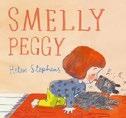
Meet this pungent pooch!
A youngster named Pie introduces readers to the family pet, Peggy, a rescue dog who is small with curly gray fur. Pie informs us that while Peggy may seem nice, she’s actually quite naughty. Whenever Pie, Mom, and Dad take
Peggy out for a walk, Peggy grabs sticks that are so large that they knock the legs out from under the whole family. But the naughtiest thing Peggy does is roll around in foul-smelling things, such as seaweed, washed-up trash, and…poop! After Peggy returns home and gets her poopy smell all over the rug and Pie’s clean pajamas, it’s time to wash up. Peggy dislikes showers, so when she’s all done, she makes sure to shake off, splashing water all over the place. In spite of it all, her family loves her. Light on plot, this book is ideal for dog lovers, since it’s basically an ode to one particularly mischievous canine. Told from Pie’s perspective, the conversational text engages readers with some “What do you think?” questions (“But do you think we love her? Do we?”). It also provides little ones opportunities to shout out “PEGGGGGY!” along with the family. Young Pie shows some responsibility by bathing Peggy. The quaint watercolor and crayon illustrations play with perspectives, much like a modern take on Ludwig Bemelmans’ style. The three-person family is pale-skinned and red-haired. Simple and pretty cute. (Picture book. 3-5)
Sumovich, Michelle | Illus. by Laura Park | Dial Books (40 pp.) | $18.99 Jan. 28, 2025 | 9780593112717

youngster. When a mangy, rambunctious feline wanders into the yard, Mom warns the narrator not to pay attention to the likely rabid animal. The child makes posters (“Found! Terribly hungry cat”) in the hopes that someone will come claim her. Still, the little one wonders about the creature’s well-being and, concerned, decides to secretly provide her with food, a bath, and warm blankets, even though “she is not my cat.” This bond of kindness is then tested when the kitty disappears for a few days. Though the child still has the Big, Little, and Middle cats, the youngster worries about the scruffy cat until the book’s end, when it turns out the child has just the right number of cats after all. Sumovich’s expressive, if lengthy, text uses repetition to build tension and draw readers into this tale of growing friendship. Using a saturated palette and, occasionally, comiclike panels, Park’s vibrant, evocative illustrations effectively depict the contrast between the warm world of the child’s home and the wild and unpredictable outdoors in which the new cat lives.
A satisfying tale of the rewards of showing kindness toward others. (Picture book. 3-6)
Tipsey, Carlianne | Pixel+Ink (32 pp.) $18.99 | Oct. 29, 2024 | 9781645952497
Three’s company…but is there room for one more?
“I have three cats—Big, Little, and Middle,” declares an Asian-presenting child. That’s just the right number of cats for this

Helping a sick pal feel better can be tough. A youngster describes a friendship with a yeti. The unusual bond has advantages: Yeti can reach the highest branches to pick the tastiest fruit, and, when sitting on Yeti’s shoulders while watching an outdoor movie, the child has “the best seat in the house.” Having a yeti BFF can be challenging, however. Every year Yeti gets a bad cold, characterized by
frightful chills, coughs, and sneezes. This year, the young narrator is determined to cure him and stocks up on supplies. The child’s preparations—sweaters, blankets, even a hot tub—don’t work. The youngster persists, proffering hot cocoa, a seat before the fireplace, and “crosscontinental trips to tropical islands!” (Since our protagonist is a kid, this doesn’t work out; an imaginary journey suffices.) Eventually, the narrator abandons hope for a cure, but then inspiration hits: giving Yeti his own “best seat in the house”— sitting with him in a makeshift tent and watching TV together, surrounded by some of the child’s “cures.” This thin story is somewhat light on plot, and the conclusion falls a bit flat. Still, it emphasizes friendship, which many readers will appreciate. The concept of a relationship between human and cryptid may spark interest in some children, but it’s not well developed. The cartoonish illustrations are lively, and this blue yeti is endearing and non-menacing. The girl is light-skinned.
Sweet but less than memorable. (Picture book. 4-7)
Kirkus Star
A Story of Ella Jenkins― The First Lady of Children’s Music
Todd, Traci N. | Illus. by Eleanor Davis | Chronicle Books (60 pp.)
$19.99 | Jan. 7, 2025 | 9781452170640

Ella Jenkins opened up the field of children’s music and inspired generations.
“Ella is a South Side girl, / a Bronzeville bird, / skipping in streets that / smell of sweets and black-eyed peas.” Todd’s gorgeous free verse bursts with internal rhymes and delightful assonance and consonance as she
Imaginative play has never been this exciting.
SUNDAY
tells the story of Ella Jenkins (b. 1924). Growing up in Chicago, Ella hears Count Basie and Cab Calloway, whose call-and-response music Todd aptly compares to “the beating / of wings.” As she matures, Ella hears rhythms in the sounds of protesters taking a stand against segregation; by contrast, while waiting to be seated in restaurants that don’t allow Black people like her, she’s surrounded by silence. She moves to San Francisco’s Codornices Village, where white and Black families live side by side. There she teaches music to children by day and at night listens to “Congas pop! / Claves click! / Maracas shick-shickshick!” When Ella later returns to Chicago, the Civil Rights Movement is in full swing, and she notices “a bolder sound.” She makes call-andresponse records, travels the world teaching and performing, and receives a Grammy Lifetime Achievement Award; through it all, she’s motivated by her belief that music can help listeners feel seen and understood. Davis’ energetic art explodes with stars, word bubbles, musical notes, and bold colors—a perfect complement to Todd’s lyrical language.
A hypnotic, dynamic biography of a woman who’s always understood music’s power to celebrate identity and spread joy. (author’s note, timeline, further information about Ella Jenkins, selected bibliography) (Picture-book biography. 7-10)

Kirkus Star
Tolentino, Marcelo | Trans. by Rahul
Bery | Blue Dot Kids Press (48 pp.)
$18.95 | Jan. 22, 2025 | 9798989858811
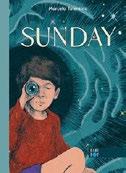
A desire to break a familiar routine leads a young boy to exciting new worlds. Every Sunday, Martin, his parents, and his dog, Maize, go to his grandparents’ house. Every visit is the same; bored one day, Martin decides to “[step] out into the unknown.” In detailed, action-packed double-page spreads in muted colors, Martin and Maize trek across several landscapes, from the “freezing cold of ice caps” to the “baking heat of lava flows.” Their epic adventures turn out to be a rousing game of make-believe; exhausted after a day of play, Martin eagerly anticipates filling his family members in on all his exploits. Eagle-eyed readers will realize that this is an imaginative journey, with several objects from around the house, seen in earlier spreads, ingeniously included in Martin’s daydreams. His mother’s Bundt cake becomes a volcano leaving hot lava trails, while the “arid desert” is his grandpa’s sleeping face. Crosshatching and detailed shading give the tale a charmingly retro feel. Originally published in Brazil and translated into English, this tale uses clever wordplay in conjunction with the art to further call back to the previously seen items (at one point, we’re told that the boy and the canine are “within an arm’s length of sacred creatures”—a reference to Martin’s father’s dragon tattoo sleeve). Readers will eagerly return again and again to get lost in
Tolentino’s sumptuous landscapes. Martin and his family are light-skinned.
Imaginative play has never been this exciting. (Picture book. 4-7)
Trehan, Meera | Walker US/ Candlewick (320 pp.) | $18.99 Jan. 14, 2025 | 9781536219258
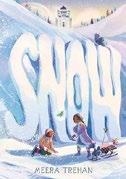
Two girls work together to find answers and save a snowcovered kingdom.
For years, the Princess has been endlessly digging Snow—which continually falls in a scientifically modified, self-replenishing form. She’s desperate to restore her kingdom of Mistmir to the way it was, but ever since she wished for “perfect” snow, the wintry precipitation has been unrelenting, and everyone has fled except her father, the King. One day, the Princess’ shoveling reveals her flutterbye toy, which was made by the Strangers who created the Snow, and she’s excited to show the King this sign of hope. But before she can do so, she meets a girl, 12-year-old Indian American Ela, who has stumbled into Mistmir from our world. Ela is shocked to recognize the Princess from “the Book,” Snow Princess , that her mother used to read to her. Realizing that the surprise visitor is the key to fixing the kingdom, the Princess invites Ela to her castle. Ela follows her, hoping to uncover the
truth behind the Book and the oddly vivid, memorylike images in her head, and they form an unexpected friendship. This story combines science and magic to create an engaging and moving setting with charming, detailed worldbuilding that’s tinged with eeriness and sadness. While the start is slow, the storyline eventually picks up, revealing family secrets, schemes, and drama. Trehan weaves in themes of loneliness, belonging, forgiveness, and power. In the brown-skinned, dark-eyed Princess’ kingdom, Hindi is known as their Naming Language. Poignantly beautiful. (Fantasy. 8-12)
Umrigar, Thrity | Illus. by Kamala Nair | Scholastic (40 pp.) | $18.99 Jan. 7, 2025 | 9781338875553
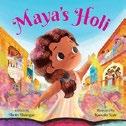
An Indian American girl observes her first Holi. Maya adores visiting her grandparents. From playing in banyan trees with her cousins to eating her grandmother’s sumptuous rotis, her time in India always feels as cozy as a “pair of warm socks.” This trip is especially exciting because, for the first time, she’s going to “play Holi,” which Maya learns means spraying water and smudging colored chalk on friends to mark the arrival of spring. When Holi arrives, Maya’s parents give her a new salwar kameez but remind her to wear her old clothes to the celebration. After a delicious,
A hypnotic, dynamic biography of a woman who’s always understood music’s power to celebrate identity and spread joy.
sweet-filled breakfast, Maya’s cousins show up, and the children rush outside. Along with her relatives and their friends, Maya takes part in a holiday that, as her father reminds her, is all about new beginnings and forgiveness. Later, Maya returns to America, where the air is chilly, but her memories keep her warm. The author’s descriptions are vivid and tender, matched by Nair’s visuals, dominated by rainbow-hued sprays of color. Unfortunately, the plot meanders, briefly hinting at conflicts such as Maya’s discomfort about being one of the few people of color in her neighborhood back home and the idea of Holi being an opportunity to “[forget] old hurts and insults” without fully unpacking them; the conclusion is also somewhat abrupt.
Sweet and upbeat, though disjointed. (information on Holi, recipe for mango lassi) (Picture book. 4-8)
Valentine, Jenny | Illus. by Claire Lefevre Kane Miller (224 pp.) | $7.99 paper Dec. 1, 2024 | 9781684649228 | Series: Joy, 1
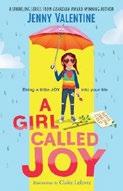
A well-traveled, formerly homeschooled girl faces challenges in attending school for the first time. Finding the silver lining in every situation has been the hallmark of Joy Applebloom’s personality. In Valentine’s series opener, Joy is moving “home” to the U.K., somewhere she’s never been, along with her 13-year-old sister, Claude, and her mum and dad. They’re leaving Zanzibar to go live with their injured granddad, a big change after being in places like Mumbai, Hanoi, and Mexico City. Granddad is settled in his ways, but slowly Joy figures out ways to spend time with him and even make him laugh. When she enters formal schooling for the very first time as a
10-year-old, despite being “genuinely, properly all geared up for it,” she struggles to cope in this “silverlining-free zone,” with its unfamiliar routines and social codes. But Joy, who’s cued white, finally meets a British Jamaican boy named Benny; they bond over the beauty of the old oak tree growing in the playground, which gives her hope again. But when the oak is threatened by plans to build a new school, Joy and Benny are galvanized into action. Told from Joy’s first-person point of view, the storytelling is clever and funny while dealing with age-appropriate challenges. Lefevre’s clean and imaginative black-and-white illustrations are scattered throughout this relatable and charming story. Comical and whimsical, with a lovable and precocious narrator. (All About Joy) (Fiction. 8-11)
Vickers, Elaine | Illus. by Samantha Cotterill
Paula Wiseman/Simon & Schuster (56 pp.)
$19.99 | Jan. 7, 2025 | 9781665929769

A youngster spreads love throughout the community.
The tanskinned narrator makes tiny paper hearts. “The hearts don’t say ‘I love you,’” explains the protagonist, “but, kind of, they do—when you share them.” The child gives the hearts to friends, family, and neighbors while finding other ways to show love: drawing a picture of a cat for a pal, delivering cookies to a neighbor, and reading a story to a younger
sibling. With the paper hearts now all gone, the child comes to an important realization: “I find love everywhere, being shared in a hundred different ways from hearts of all shapes and sizes.” Cotterill’s illustrations—hand-built sets that were then photographed—bring the narrative to life, giving it a three-dimensional, textured feel. The child’s handful of paper hearts pop off the page, while the bag of cookies looks real enough to hold. Movement and depth are so effectively conveyed that some images feel like video stills. This moving story will empower children to find ways to positively influence their own communities. The acts of service are practical and realistic, making this a perfect tale to share with preschoolers and early elementary school students. In her author’s note, Vickers discusses how she drew inspiration from an activity she implemented years ago at children’s classes at her church. People depicted vary in terms of skin tone and ability.
A kid-friendly demonstration of how we can all make the world a more loving place. (Picture book. 4-7)
Wells, Allen R. | Illus. by DeAndra Hodge | Farrar, Straus and Giroux (40 pp.) $19.99 | Jan. 7, 2025 | 9780374391355

A buoyant profile of Yvonne Clark (1929-2019), a lifelong tinkerer with a knack for making everything work better, from the family toaster to giant rockets.
A kid-friendly demonstration of how we can all make the world a more loving place.
Dubbing his former college teacher’s “remarkable spark for building and fixing things” a “superpower,” Wells takes her through a series of hands-on projects—beginning with malfunctioning household appliances that she methodically disassembled and studied as a child to later work solving pesky design problems in both a new type of rifle and in NASA’s humongous Saturn V rocket. The author also celebrates the stubborn determination that won Clark a post–World War II career in mechanical engineering and a university position despite the discrimination she encountered as a Black woman in a field dominated by white men. From overall-clad child to brisk, sensibly attired adult, her confidence and strength of character shine in Hodge’s illustrations as she wields hand tools, pores over blueprints, marches into groups of stymied-looking male colleagues to explain her solutions, and climactically stands in quiet triumph with a racially diverse group of children to watch the successful 1967 test launch of the first unmanned Saturn V rocket. That same confidence radiates from the appended photos, which take her from teenager to octogenarian. Inspirational fare for aspiring engineers and scientists. (author’s note, selected bibliography) (Picture-book biography. 7-9)
Welsh, Clare Helen | Illus. by Kristen Howdeshell & Kevin Howdeshell Nosy Crow (32 pp.) | $18.99 Nov. 5, 2024 | 9798887770833
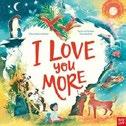
An animalfocused take on that perennial one-upmanship game familiar to parents: how to express one’s everlasting love for a child.
Joining a legion of similar books, some identically titled, Welsh’s tale
A love contest that encompasses all things nature, with affection for its young protagonist at its heart.
I
LOVE YOU MORE
offers a world of wild beauty. As the book opens, a bespectacled redheaded mother cuddles her pajamaclad child, Rae, whom she loves “as much as any creature loves the sea, the land, or shore.” She references penguins happily waddling in the snow, seal pups snoozing on a “sunlit icy floe,” an eagle soaring majestically, goats and foxes scrabbling up a mountain, turtles surfing, lizards basking in the sun, wolf cubs romping, tree frogs leaping, parrots flying, and leopards lazing. Mom concludes hyperbolically that her love is greater than the number of celestial bodies in the sky—setting up the child’s irrefutable winning claim: “I think I love you more.” The verses roll rhythmically, with only the occasional banal cliched line (“winged things love to flutter”). Stylized images against textured multilayered backgrounds— sea and sky, mountain, desert, and jungle—pulse with brilliant color and loving depictions of animals and their habitats. Art and words make a vibrant connection between the wild world and human love. Human characters are light-skinned. A love contest that encompasses all things nature, with affection for its young protagonist at its heart. (Picture book. 2-5)

|
Beaming Books (40 pp.) | $18.99 Jan. 7, 2025 | 9798889830429
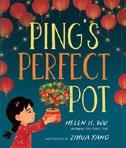
A young Chinese girl discovers the beauty of imperfection during a Lunar New Year celebration. When Grandpa picks up a tangerine tree at the market, Ping’s excited (“It will bring prosperity and good luck”). She decides that the leafy new resident needs a “perfect pot,” so she gathers her clay and gets to work. Ping deems her first effort too “clumsy.” Meanwhile, Grandpa cleans up around her and gently urges her on. The evenly paced narrative is artfully spotted with onomatopoeias as Ping attempts various media with rigor: She uses papier-mâché and vials of colorful glitter and tries to wrap yarn around a bowl. But nothing is just right. Yang fills every page with bright hues and intricate details, creating vivid scenes. Alluring illustrations show Grandpa decorating the house for the festivities as he urges Ping to persevere. Through Grandpa’s dialogue, Wu provides pragmatic examples on how to take a mindful approach to challenges, and finally, after taking a deep breath, Ping realizes her artistic vision. Grandpa praises her, but “something is still missing.” Ping eventually finds beauty within the flaws of her prior projects and decides to include them in the final celebratory display, each holding plants of their own. Her embrace of all aspects
of the creative process makes for a delightful holiday tale.
A charming story of encouragement, illustrated with life and movement. (information on Lunar New Year traditions, author’s note) (Picture book. 4-8)
Yoon, Susan | Illus. by Audrey Helen Weber | Abrams (40 pp.) | $18.99 Oct. 8, 2024 | 9781419763793
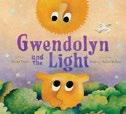
Seeking friendship, a nocturnal animal sets out in a rowboat, following a bright light in the sky.
“In a night forest by the sea, the moon had the stars, the trees had the breeze, but Gwendolyn was all alone.” Gwendolyn, a big-eyed, yellow teddy bear– like creature, asks what it’s like to have a friend. As stylized blue-tinted trees sway against a lavender night sky, more poetic prose ensues: “As bright as all the stars,” the moon responds. “As warm as a summer breeze,” the trees reply. One evening, Gwendolyn awakens earlier than usual and sees a light that little ones may realize is the sun. She attempts to greet this new friend, but the light begins to fade. As she sets off in her little white rowboat, the sky turns purple with the sunset; Gwendolyn counts the stars as she attempts to reach this potential friend. After she gets to two, a bird shows up. Gwendolyn misinterprets its chirps (“Twee!”) as an attempt to say the number three—a bit of age-appropriate preschool humor that recurs throughout. Gwendolyn shares a biscuit with the bird, endures a storm, and, after it subsides, tearfully tries to reunite with her new pal. Yoon’s dreamy, lulling text is matched by Weber’s textural, otherworldly art; readers will feel Gwendolyn’s sorrows and triumphs right alongside her.
A superior experience for nap- or bedtime. (Picture book. 3-5)


NOTHING HIGHLIGHTS THE need for greater information literacy and civic awareness like a major election. But the proliferation of online misinformation and disinfor mation—combined with a hostile environment for teachers in many schools across the U.S.—poses real challenges to educating the next generation of voters. Two compelling books published in recent years remain all too relevant: One Person, No Vote (YA Edition): How Not All Voters Are Treated Equally by Carol Anderson with Tonya Bolden and Strongman: The Rise of Five Dictators and the Fall of Democracy by Kenneth C. Davis. In addition, these 2024 releases will help teens (and many adults, too) develop a deeper and broader understanding of the democratic process, cultivating critical awareness of pivotal contemporary concerns and the history that shaped them.
The Facts About Election and Voter Fraud by Naomi Rockler (ReferencePoint Press, Jan. 1): This compact, reader-friendly guide to a hot-button topic corrects mistaken impressions about the degree to which fraud affects American elections. Rockler’s careful research


shows that it’s far rarer than many people believe. At the same time, she highlights related topics, such as the marginalizing consequences of some anti-fraud measures.
Future Tense: How We Made Artificial Intelligence— and How It Will Change Everything by Martha Brockenbrough (Feiwel & Friends, March 19): This scrupulously thorough volume helps demystify artificial intelligence, which has already upended our lives in countless ways. The well-chosen real-life examples show readers the impact of AI on elections—propaganda shared by bots, the Cambridge Analytica scandal, and more—leaving young people much better able to critically evaluate online content.
Shift Happens: The History of Labor in the United States by J. Albert Mann (Harper/ HarperCollins, June 4): An understanding of labor history is essential to being an informed voter: Different political parties’ approaches
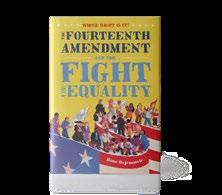
to many issues, from health care to taxes to environmental protection, are inextricably intertwined with the happiness and welfare of the working public. Mann’s far-ranging overview, written in a conversational tone, is a must-read.
Whose Right Is It? The Fourteenth Amendment and the Fight for Equality by Hana Bajramovic (Henry Holt, June 25): The author, a lawyer, skillfully and concisely describes the “long, nonlinear march toward progress,” highlighting landmark court cases and cultural shifts. Many topics will feel personally relevant to readers—such as affirmative action in college admissions, LGBTQ+ rights, reproductive justice, and immigration policy—helping to contextualize many contentious political debates.
Represent: The Unfinished Fight for the Vote by Michael Eric Dyson and Marc Favreau (Little, Brown, Sept. 10): This hard-hitting work fills in
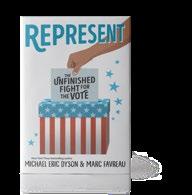
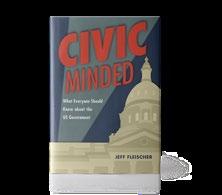
major gaps in the typical history and social studies curriculum by spotlighting the history of and ongoing struggle for equal voting rights. While the material is sobering, the vigorous prose and celebration of progress make this an empowering read that will inspire engagement and activism.
Civic Minded: What Everyone Should Know About the US Government by Jeff Fleischer (Zest Books, Oct. 1): This clear, straightforward, and nonpartisan text covers an astonishingly broad range of subjects that responsible citizens should grasp. Many of these policies, concepts, and terms— including Social Security, inflation, minimum wage, national debt, and undocumented immigration—are widely misunderstood, however, allowing inaccurate and inflammatory rhetoric to spread.
Laura Simeon is a young readers’ editor.
Eighteen-year-old New Yorker Carina Marshall is working as an au pair for the wealthy, prominent Hall family in Jamaica for a few months until their permanent nanny arrives.
Jamaican American Carina’s days are filled with tending to Jada and Luis, the family’s youngest kids, and spending time with the other staff members at Blackbead House, the Halls’ formal mansion. She also accompanies the Halls to high-profile events—Ian, the patriarch of the family, is running for prime minister. Amid what should be a carefree summer job, Carina harbors a deep secret that no one in the
country knows: She’s being plagued by a mysterious entity that seems to want her gone, no matter what it takes. She feels a “dense heat” and notices a “honeyed scent,” both of which are preludes to something going wrong around her. As Carina’s circumstances deteriorate, she faces a decision that could put her new friendships and her job on the line—and reveal everything she hopes to keep hidden. Carina is an enigmatic character who harbors many secrets, which unravel and will intrigue readers as they follow her journey to uncovering what’s happening at Blackbead

House. The story’s ominous elements contrast vividly with the beautiful ones, and the portrayal of the luxurious Jamaica the wealthy enjoy stands in stark contrast to that of those who are less
fortunate. The deliberate pacing in this book centering on a Black cast helps build the tension. A deliciously dark and mysterious debut. (Horror. 13-18)
Aster, Alex | Amulet/Abrams (400 pp.)
$22.99 | Nov. 12, 2024 | 9781419773785
Series: The Lightlark Saga, 3

Isla Crown’s world trembles on the brink of destruction even as she struggles to find a way to save it without killing either of the men she loves—Oro, the king of Lightlark, and Grim, the ruler of Nightshade—as a prophecy predicts. Threatened on the one hand by wildly destructive storms of mysterious origin and on the other by an unkillable Wildling who’s commanding armies of the dead, Isla and her shadow-wielding lover, Grim, nonetheless find time for both a second wedding and plenty of steamy scenes in this follow-up to 2023’s Nightbane. Catering to fans who like their fantasies literally awash in gore, Aster has Isla at one point falling into a deep pool of blood—as well as carving power-enhancing sigils into her own body, decapitating an assassin, and personally cutting the hearts out of multiple rapists and other bad actors in order to pay an augur for glimpses of her seemingly inevitable doom. Though Isla’s other heartthrob, Oro, just gets a supporting role this time through, Isla does acquire a dragon to ride into battle, along with even mightier magic that she’s ready to unleash. The love triangle’s intense sparks give the wholesale slaughter a run for its money on the way to a game- and locale-changing climactic twist. Isla and Grim have pale skin and dark hair; Oro has amber eyes and golden hair.
Series fans will be pleased by the continuing saga of conflicted love amid devastation. (Fantasy. 14-18)

A beautifully realized addition to the genre.
THE LAST BOOKSTORE ON EARTH
Bascomb, Neal | Illus. by Mithil Thaker
Scholastic Focus (272 pp.) | $18.99
Sept. 3, 2024 | 9781338701999

In 1930, Mohandas K. Gandhi led a nonviolent campaign across India to defy the imperial British salt tax, an effort that ultimately led to Indian independence and demonstrated the power of large-scale civil disobedience.
Bascomb opens with a capsule history of the British Raj (and Indian resistance to it) before zeroing in on Gandhi, his fellows in the Indian National Congress, and British viceroy Lord Irwin. From there, he recounts the planning and execution of the Salt March, drawing on Gandhi’s own words, reporters’ eyewitness descriptions, marchers’ diaries, and the contemporary writings and retrospective accounts of key players both Indian and British. Indeed, one of the book’s strengths is its presentation of the work done by freedom fighters such as Sarojini Naidu, Abbas Tyabji, and Gandhi’s son Manilal. For all the attention to Indian voices and the sheer volume of his research, however, Bascomb’s account falters, beginning with the title, a moniker Gandhi embraced with a heavy irony Bascomb does not convey.
Bascomb’s repetition of the slur “Untouchables” in referring to the Dalits—a name he never introduces—is inexplicable. While the epilogue complicates Gandhi’s legacy somewhat, it does not do so with the rigorous scrutiny now underway in India, eliding, for instance, Gandhi’s early anti-Black views. Thaker’s occasional illustrations help readers visualize events.
An uneven effort. (bibliography, source notes, index) (Nonfiction. 12-16)
Kirkus Star
The Last Bookstore on Earth
Braun-Arnold, Lily | Delacorte (320 pp.) $19.99 | Jan. 7, 2025 | 9780593899489

W hat do you do when the world ends? Maybe just keep going to work. Almost a year after The Storm, Liz still works alone in a bookstore in suburban New Jersey, although now customers only wander in occasionally to trade various supplies for books. She moved into the apartment on the floor above the shop, took on the role of an informal post office, and started recording the stories of regular visitors in a journal. In some ways, Liz finds this existence a relief; she hardly ever has to bother with people and all the stressors of her old life (like choosing a college major) have been washed away. But now, with another Storm coming, Liz realizes how precarious her situation really is, with dwindling food supplies and a building in desperate need of repairs. One night, she’s awakened by a creaking noise from downstairs. Armed only with a hardcover edition of Anna Karenina, Liz confronts the intruder—a girl about her age, Maeve, who’s in need of a place to stay and happens to be good at fixing things. The two form an uneasy alliance. This stellar debut is filled with cynical and witty characters who are exploring the nature of and need for human connection. The story contains just the right amount of action, balancing the introspective scenes, a blossoming queer romance, and a
well-executed slow doomsday reveal. Main characters present white. A beautifully realized addition to the genre. (Post-apocalyptic. 14-18)
Chao, Gloria | Viking (384 pp.) | $12.99 paper | Dec. 31, 2024 | 9780593692714

Recent high school graduate Gemma Sun goes on a treasure hunt in Taiwan. Gemma, who’s from “Podunksville, Massachusetts,” is looking ahead with excited trepidation to attending Amherst College. But covering the tuition weighs on her mind since she and her single mom have limited finances. So she’s shocked to hear that her grandfather in Taipei, whom she had believed to be long dead, was in fact estranged from her mom and died only weeks earlier. His attorney shows up with their inheritance: a box filled with old newspaper clippings. Gemma quickly realizes that the articles contain clues hinting at a big treasure for her to find in Taiwan. Her mother agrees to let her go—if she can pay her own way. The tightly written plot moves quickly as Gemma swallows her pride, asking Harvard-bound ex-boyfriend and nemesis Xander Pan to allow her to participate in the all-expenses-paid Taiwanese American Roots Pursuit program he founded (and which she previously scorned). There Gemma explores Taiwanese culture—and her own independence. As she solves puzzles and her hunt for her grandfather’s treasure escalates, she also must collaborate with Xander to get to the solution, bringing them closer together in the process. Chao artfully weaves in themes of Asian American identity, generational trauma, and compassion as each clue that Gemma uncovers leads to another compelling revelation. A thoroughly enjoyable romp that’s also rich in self-discovery and romance. (Fiction. 12-18)
Collins, Suzanne | Illus. by Nico Delort Scholastic (368 pp.) | $34.99 | Oct. 1, 2024 9781339030609 | Series: The Hunger Games, 1

Once more into the fray…but with pictures! Readers are invited to revisit Panem, a fascist country “that rose up out of the ashes of a place that was once called North America” and is run by an elderly totalitarian dictator. The harmful, long-reaching influence of reality television is on full display in this excellent read that remains as relevant to modern audiences as when the novel was originally published in 2008. While Katniss Everdeen, the selfless and determined young hero from a region that’s strongly reminiscent of Appalachia, is the star of that world, the star of this edition is Delort, whose scratchboard art deftly imagines memorable scenes throughout the story while avoiding influences from the film series. These illustrations are new and wholly themselves, and the book’s large format shows them off to great advantage. The black-and-white art brings a hefty weight to the poverty and despair of District 12, the poorest sector of Panem, while at the same time capturing the affected excesses of the Capitol and its citizens. Delort’s talent is fully evident when capturing Katniss in her fire-tinged dress; readers will be able to feel the heat thanks to the dazzling interplay of positive and negative space. Fans of Barry Moser, take note: There’s a new tribute in town.
Vivid and well worth a look from new and returning fans alike. (Dystopian. 12-18)
Funke, Cornelia | Trans. by Anna Schmitt Funke | Chicken House/Scholastic (320 pp.) | $19.99 | Nov. 12, 2024 | 9781338758931 | Series: Inkheart, 4

Happily-ever-after isn’t so easy to hang onto in the Inkworld.
Sixteen years after Inkdeath, the blood-soaked conclusion to the trilogy that began with Inkheart (2003), author Funke brings forth another dismal installment. Where the first book balanced delight and darkness, here rage and revenge suffuse the pages. Orpheus, defanged villain of Inkdeath, has discovered a way to punish his former idol, Dustfinger: He will have those Dustfinger loves painted into a book and thereby lure the Fire-Dancer to his doom. However, the drunken troubadour who acts as Orpheus’ stooge makes a mistake, losing the model for Dustfinger’s best friend, Nyame, the Black Prince. Thus, when Dustfinger heads off alone to confront Orpheus, Nyame can follow in hopes of keeping him safe. This novel is slender compared to Funke’s previous doorstoppers, but it still feels overlong, with arbitrary magic and plot twists that feel perfunctory rather than organic to the story. Adding to the dragging pace is the often-turgid prose. The late Anthea Bell’s translations of the first three books were full of power and grace; Schmitt Funke’s >>>
The star of this edition is Delort, whose art deftly imagines memorable scenes.
THE HUNGER GAMES
translation of her mother’s German text is characterized by awkward phrasing and malapropisms. As sentence gives way to leaden sentence, readers will be hard pressed to keep the pages turning. The characters, who are almost all adults, are mostly implied white; Nyame is Black. A slog. (dramatis personae) (Fantasy. 13-18)
Garrod, Beth | Sourcebooks Fire (352 pp.)
$11.99 paper | Oct. 1, 2024 | 9781728249001

In order to find herself, a British teenager must embrace the true spirit of Christmas.
Fifteen-year-old Molly Bell hates Christmas. Thanks to her parents’ band, the Rocking Stockings (formerly known as the Brussel Shouts), Molly has spent most of her life avoiding her past as the adorable child star of the music video for their hit song, “Love Your Elf!” Things get more complicated when “Love Your Elf!” is chosen as the theme song for Sleigh Another Day, this year’s hot holiday rom-com. Molly tries to avoid being recognized as Annoying Green Christmas Elf in her new town (where she hoped to make a fresh start), plan a charity event, and be there for her struggling best friend. At the movie’s London premiere, she meets an American boy called Kyle, who has also retreated from the hubbub to sit in a cluttered storage room. Their friendship quickly turns into butterflies, but they’re both hiding something. In the end, Molly learns that she must truly embrace who she is before she can embrace anyone else. It’s impossible not to root for the likable characters, particularly Molly, who transforms and grows through each challenge she faces. While the opening feels repetitive in places, the narrative, which celebrates self-acceptance and the power of friendship, picks up in pace as the
interpersonal conflicts develop. Red-headed Molly presents white; in the cover art, Kyle appears Black. A heartfelt, festive, and affirming romance. (Romance. 13-18)
Gregson, Marc J | Peachtree Teen
(496 pp.) | $19.99 | Jan. 7, 2025
9781682637067 | Series: Above the Black, 2

In the aftermath of the events of Sky’s End (2024), Conrad finds himself entrenched in the war against the Below.
Now Captain of his Hunter ship and Prince of the Skylands, he faces the challenges that come with his high rank. Conrad’s ruthless uncle rules with an iron fist, demanding unwavering loyalty from Conrad and his sister, Ella. Conrad’s feelings for Bryce deepen, but his uncle’s disapproval of her as a suitable partner puts their relationship in a precarious position. As Conrad navigates the complexities of leadership, he must make tough choices about the future of his family, friends, and the islands under his protection. Meanwhile, the Lantians, the people of the Below, continue to infiltrate the Skylands’ ranks, unleashing deadly new creatures in the skies, and Conrad’s uncle assigns him a pivotal mission, one that could alter the course of the war. While the book is packed with action, some of the battle scenes become repetitive, and some judicious trimming would have made the story feel punchier. However, readers will gain deeper insights into the worldbuilding, including the roles of the various Trades and the motivations of the Lantians. The ending sets the stage
for an exciting trilogy finale. Most characters are cued white.
A fast-paced if overlong middle volume that will leave fans eager for the series closer. (Science fiction. 14-18)
Jayne, Hannah | Sourcebooks Fire (304 pp.) $11.99 paper | Dec. 3, 2024 | 9781728262949

A teenager races to find her missing best friend, afraid she might be next. Lifelong best friends Lia and Diana are “good girls.” Lia is a straight-A student, a “rock star bassist” in a band, and an aspiring scientist. Diana is an experienced pageant competitor and the newly crowned Miss Teen Empire Hill. In reality, their friendship is strained: Lia is set to head off to college, funded by her wealthy scientist grandfather, and she resents Diana’s “thousand-watt smile and Hollywood hair.” Meanwhile, Diana struggles to save every cent of her pageant winnings so she can afford college tuition. These cracks in their friendship widen when Diana turns up missing one morning. The police believe she ran away; no one knows the girls were supposed to meet at midnight, but Diana never showed. Lia begins to wonder whether her disappearance is connected to the notes she’s been receiving from a secret admirer, who she hopes is Diana’s boyfriend. As she strives to find Diana, Lia (who’s hiding secrets of her own) realizes that no one can be trusted. This taut thriller keeps readers on their toes as it delves into the deeper issue of how missing girls and women are regarded, even by those closest to them. The central relationship between
Celebrates self-acceptance and the power of friendship.
ALL THE JINGLE LADIES
the two girls, who present white and who are realistically flawed and at times unlikable, explores how well you can truly know someone, even a lifelong friend.
A suspenseful tale centering on a complicated friendship. (Thriller. 14-18)
June, Jason | Harper/HarperCollins (368 pp.)
$19.99 | Nov. 12, 2024 | 9780063260085
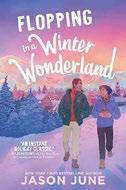
Winter heats up quickly when two gay teens find themselves falling in love.
Aaron Merry is a SoCal native whose mom’s sudden abandonment of the family left him cynical about love. When his Christmas-obsessed older brother, Casey, suffers a brutal breakup with his longtime girlfriend, Aaron agrees to accompany him on a last-minute, 12-day trip to Winter Wonderland, an island off Alaska with a year-round Christmas theme. Meanwhile, Kris Bright has lived in Winter Wonderland his entire life. His beloved uncle left the island when the theme park refused to feature an openly gay Santa. Now Kris is determined to win the Race, his friend group’s annual competition: Whoever can make a tourist profess their love first gets to accompany Anjelica, daughter of Wonderland’s founder, on her annual trip to the family’s Manhattan penthouse. If he can just speak to Anjelica’s dad in person, Kris is sure he can persuade him to bring Uncle Toby back. When Aaron’s and Kris’ paths literally collide, sparks fly. As they team up to sabotage Casey’s plans to win back his ex, they start falling hard for each other. But can a relationship that began as a game survive? June’s characters, both major and minor, have distinct voices and backstories, and they’re easy to root for. The hijinks throughout add hilarity to the central love story, and the beautifully depicted setting immerses readers
in Christmas cheer. Main characters present white. Steamier than a cup of hot cocoa—and just as sweet. (map) (Romance. 14-18)
Lally, Megan | Sourcebooks Fire (272 pp.)
$12.99 paper | Jan. 7, 2025 | 9781728270142

Two girls fight for their lives following a terrifying drive through the Oregon mountains. Brooke Goodwin has been on her very best behavior since “the incident” at her family’s lake house. Her father is under consideration for appointment to a judgeship, and she can’t do anything that will bring further shame to her family. But the day she finds out that she achieved her dream of getting into Yale, there’s a party at the beach and her crush, Dylan, is going to be there. How can she say no when her best friend, Jena, insists that they go? Brooke has been keeping a big secret from Jena and their other friends, however—she’s been the target of a campaign of anonymous harassment from someone who believes there was more to “the incident” than the official story. And when an old Bronco starts tailgating them on the remote drive home from the party, eventually causing an accident that sends the girls running into the woods, more than one secret is revealed. As the events of the pursuit play out, readers will feel ill at ease, then frightened, and then terrified right along with the characters. Teen thriller fans will be riveted. Brooke presents white, Jena is Black, and Dylan is described as being “like a genetic blend of Henrys, both Golding and Cavill.”
A pulse-pounding thriller. (Thriller. 13-18)
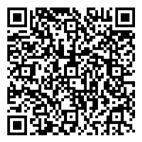
Kirkus Star
Lee, Shannon & Fonda Lee | Wednesday Books (352 pp.) | $21.00 | Jan. 7, 2025 9781250902672 | Series: Breathmarked, 1
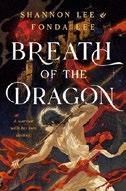
In a Chineseinspired fantasy world, a teen on the path to personal glory discovers his role in the complex world around him.
For the past decade, Jun and his father, Li Hon, have lived in West Longhan, exiled from their East Longhan home and separated from Jun’s identical twin, Sai, and the boys’ mother for illegally practicing martial arts. Jun embraces martial arts, training daily at the Iron Core school in hopes of winning the Guardians’ Tournament: Guardian of the Scroll of Heaven is a powerful and influential position with access to the emperor. Li Hon, blaming martial arts for destroying his family, instead pushes Jun to take the imperial exams and try to join the civil service. So Jun sneaks aboard the wagon of travelling performer Chang, a blind flutist, and his daughter, Ren. His plan is to leave town, win the tournament, and prove his father wrong. Jun’s journey skillfully weaves together his martial arts training and his gradually expanding political worldview as he realizes the impact he could have as Guardian. The unpredictable plot twists and innovative magic system, which incorporates religious elements, are intriguing and, along with Jun’s realistic emotional development and reactions, create a gripping narrative. The romance between Ren and Jun is low-key; the story focuses more on familial and platonic relationships, and the depiction of the family’s separation and its impact on both Jun and his father is nuanced and believable.
A complex, hard-hitting, epic martial arts journey. (map) (Fantasy. 12-18)
Kirkus Star
Levinson, Cynthia & Jennifer Swanson | Margaret Quinlin Books/ Peachtree (208 pp.) | $22.99 Jan. 7, 2025 | 9781682635377

An engaging look at the past, present, and future of space exploration and the challenges it poses. This mix of straightforward relaying of facts and narrative nonfiction retellings of significant space-related events maintains an easy-to-follow conversational tone. Throughout the book, the authors pose intriguing questions, such as, “What if two countries want to build in the same location on the Moon? Or what if there isn’t enough water for everyone? Who will resolve conflicts that arise‚ or set guidelines for humans living in space?” They dive into space history—for example, the Cold War space race—connecting science and government by explaining the composition of the Earth’s atmosphere and the geopolitical implications of how we define where space actually begins. Through descriptions of the International Space Station and interpretations of the Outer Space Treaty of 1967, readers see how intergovernmental cooperation occurs in space. The book also covers the dangers of space debris, the implications of new technology, the advent of space tourism, and more. Finally, there’s encouragement (“turn your curiosity into action”) to continue exploring as a citizen scientist or by pursuing one of the many careers that support space exploration, whether as a dietician, journalist, teacher, or judge at the International Court of Justice. Ample photographs, interesting quotes from experts, well-designed graphics, and thoughtful text boxes make this a work with broad appeal.
Informative, accessible, and compelling. (acronyms, authors’ note, picture credits, source notes, further reading
This mix of facts and narrative nonfiction maintains an easy-to-follow tone.
WHO OWNS THE MOON?
and viewing, selected bibliography, index) (Nonfiction. 12-18)
Liang, Ann | Harper/HarperCollins (384 pp.)
$19.99 | Jan. 28, 2025 | 9781335523129
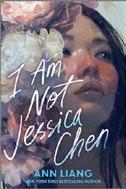
Seventeen-yearold Jenna Chen gets her heart’s desire when she makes a wish to become her perfect cousin, Jessica. Jenna and Jessica are Chinese American seniors at the cutthroat Havenwood Academy. But while Jessica’s exemplary academic and athletic performance has earned her admiration from teachers and peers alike, Jenna has always fallen short of expectations, no matter how hard she works. In a moment of despair, Jenna wishes on a shooting star to be Jessica— and is astonished to wake up the next morning in Jessica’s body. At first, being Havenwood’s star pupil is a dream come true for Jenna, whose hunger for outward approval is finally satisfied by the praise that’s being heaped upon her. But Jenna’s bliss fades as she experiences the immense social pressures that forced Jessica to maintain her spotless record. She feels a creeping sense of unease as everyone around her seems to forget her own actual existence, apart from Aaron Cai, her childhood friend and unrequited crush, who recently returned from studying abroad. Liang’s latest examines the costs of pursuing perfection through a vivid portrayal of the mental and emotional toll it takes on Jenna, Jessica, and their peers. Jenna’s artistic eye sometimes manifests in overly ornate prose in her first-person
narration, but the vulnerability of her voice will pull readers in.
A sincere and emotionally astute story offering reassurance to anyone who feels like they don’t matter.
(Speculative fiction. 13-18)
Luz, Elba | Simon & Schuster (368 pp.) $19.99 | Jan. 14, 2025 | 9781665942515

Amelia Hernandez wants more for her life than being constrained by the family curse to never find love.
Eighteen-yearold Amelia has grown up in Canton, Massachusetts, in a household of eight Puerto Rican women, including her mom, tias, and sisters. They all reckon with the 100-year-old family curse, which has doomed them to die alone and never find a life partner. The pressure to rely only one on another and join the family bakery weighs heavily on Amelia, who longs for love and adventure. When Perri, the girl she’s been dating for six months, breaks up with her, Amelia lets her family coach her in dating. Along the way, she reconnects with past love Leon, whom she dated for a year and planned to move in with—before he broke up with her over text and ghosted her two years ago. Amelia wonders whether she really can break the curse once and for all. The narrative relies heavily on Amelia’s internal monologue, which falls short of the clumsy charm it seems to be aiming for. Frustratingly, some interesting plot elements are introduced but dropped without being fully explored or resolved. Readers will appreciate the textured
portrayal of the family relationships, however, and the story has interesting things to say about truly being seen, even though Amelia’s worthwhile journey of personal growth feels overwritten. An uneven story of self-realization. (Fiction. 14-18)
McCullough, Joy | Dutton (304 pp.) $19.99 | Jan. 14, 2025 | 9780593855874
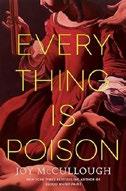
In 17th-century Rome, Tofana Apothecary helps women through sisterhood and botanicals in this novel that’s loosely inspired by real events. At 16, Carmela Tofana is eager to begin her apothecary apprenticeship under the guidance of her mother, Giulia. She’s a quick study when it comes to mixing ingredients for various powders, tinctures, and creams. Carmela also comes to appreciate the tightrope that Giulia walks as an independent woman: Anger the wrong person, and she could be hanged as a witch. Despite the risks, Giulia creates remedies that extend beyond toothaches and digestive problems. Girls and women come to her for help ending unwanted pregnancies, and more than one woman with a violent husband has surreptitiously obtained a vial of the apothecary’s most closely guarded secret, Acqua Tofana, which brings about a natural-looking death. But when Patrizia Moretti, beaten and terrified, makes a late-night visit to the apothecary, Carmela’s well-meaning actions lead to scandal: Signora Moretti is arrested for her husband’s death, and she names Giulia as the source of the poison. Giulia must flee to avoid execution, and Carmela is suddenly thrust into the responsibilities of being La Tofana. As she grieves her mother’s absence, she and unlikely allies breathe new life into the apothecary. The novel’s mixture of tenderness, brutality, loneliness, resignation, and joy makes for an intimate reading experience.
Free-verse poems between prose chapters elevate the story and highlight the universal elements.
An emotionally stirring celebration of women finding community. (maps, author’s note) (Historical fiction. 14-18)
Page, Shelly | Joy Revolution (336 pp.) $12.99 paper | Jan. 14, 2025 | 9780593897621

Two former best friends-turnedcrushes in Northern California must push through an awkward reunion to solve a crime and save a classmate.
Sage Bishop, 17, has two major problems: Bishop Brews, her family’s beloved magical apothecary, is struggling financially thanks to the big-box store competitor that opened in the next town, and her grandmother just hired Ximena Reyes, the ex-bestie who broke Sage’s heart by ghosting her after they kissed in middle school. Sage knows the “emotional recovery tonic” she’s developing can cure heartbreak and solve her problems. But when a batch she brewed is stolen during a break-in and administered to a local teen, erasing all her memories, Sage (who’s “prone to accidentally misbrewed tonics”) realizes she must have made another mistake. The town council threatens to close Bishop Brews, and without a counter brew, the tonic’s effects on the victim could be permanent. Desperate, Sage reluctantly teams up with Ximena to catch the culprit, and they must confront their own unresolved issues in the process. This story shines brightest in its worldbuilding, which uses plants’ aromatherapy properties to explain brewing magic, creating a believable low-fantasy setting. The romance and characters feel fairly one-note, however, and the mystery is straightforward. But those seeking will-they, won’t-they drama followed by a happy ending may enjoy this light story. Sage
is cued Black, Ximena presents Latine, and the supporting cast is diverse in race and sexuality.
A lightly developed cozy fantasy. (coven character list, love tonic recipe) (Fantasy romance. 12-16)
Parker, Danielle | Joy Revolution (320 pp.)
$19.99 | Jan. 21, 2025 | 9780593565315
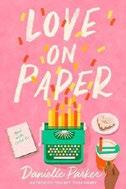
Macy Descanso knows she can be a great writer, if only someone would just give her a chance.
Seventeen-yearold Macy, who’s the daughter of two successful authors who are both Korean and Black, aspires to write as well. She applied to Penovation, an elite four-week writing retreat in Berkeley, but was only able to get in with her mother’s help. Once she arrives, she’s paired as critique partners with Haitian American Caleb Bernard, who’s also the child of famous authors—ones who have a bitter rivalry with Macy’s parents. Macy, who’s still trying to define herself as a writer, is dismayed when another teen refers to her and Caleb as “nepo babies.” The retreat participants learn that recently deceased romance author Betty Quinn has arranged for five students’ stories to be published in an anthology. Quinn also left behind clues about the whereabouts of her final manuscript. Macy and Caleb embark on a quest of discovery all around the Bay Area during which they also learn more about each other and their families. This is a fast-paced, sometimes poignant, teen romance that centers on a coming-of-age journey to claiming your own identity in the face of external pressures and standards. Unfortunately, the lackluster characterization weakens readers’ investment in the leads. The story concludes with the Penovation reading list, which spans a fun range of recommendations from William Shakespeare and Jane Austen to Elise Bryant and Maurene Goo.
An unevenly developed romance with a dose of self-discovery. (Romance. 12-18)
Deftly weaves together critiques of colonialism, power, and racism.
Parker, Natalie C. | Candlewick (320 pp.)
$19.99 | Jan. 7, 2025 | 9781536230093

A BountyApp job booking makes a night of babysitting go very wrong for a superhuman teen. Seventeen-yearold Tru Stallard has spent nearly eight years hiding in plain sight from the people who murdered her parents. She’s learned from the best—her infamous ex-assassin guardian, Logan Dire—how to be constantly vigilant for when (not if) the bad guys come back. No one, not even her best friends, Sage, Embry, and Amethyst, can know that she used to be named Gertrude Grey and, worse, that she’s a bastion—the rarest of all the talents in their underground world of superpowered people. Bastions are impervious to injury, making them feared and hunted in Underhill, the talented community existing in tunnels beneath Kansas City, where Tru lives. But when an innocent babysitting job turns violent, Tru must decide whom she can trust with the truth in order to protect baby Thea, whose mysterious powers have attracted the worst kind of attention. The threat includes Lila, Tru’s longtime crush and Sage’s older sister, who happens to work for the very people who are hunting Tru and Thea. Parker balances energetic action scenes with nuanced character development in which main and side characters alike shine. While the romance between Lila and Tru feels a bit superficial, the plot twists and endearing friendships will keep readers engaged. Tru, Logan, and Sage
read white, Embry is cued Latine, and Amethyst has brown skin. A heart-pumping, high-stakes ride. (Adventure. 13-18)
Raughley, Sarah | Harper/ HarperCollins (416 pp.) | $19.99 Jan. 14, 2025 | 9780063344389
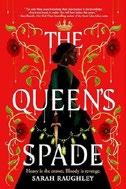
In this work inspired by real events and people, a Yoruba princess is kidnapped from West Africa as a gift for Queen Victoria. Omoba Ina, princess of the Egbado Clan, was enslaved in the Dahomey Kingdom after her parents were slaughtered. In 1850, Capt. Forbes of the British Royal Navy, commander of the HMS Bonetta, arrives, taking the 7-year-old princess to England as a present for the queen, a gesture “meant to symbolize a victory of British abolitionism.” Queen Victoria makes Ina her goddaughter, deciding she can be transformed into a lady. The renamed Sally Forbes Bonetta becomes a ward of the court with all its expectations, but she’s never fully accepted because of her race. Now 18, Sally is done being used as propaganda for the realm, and she seeks revenge on all those who were involved in her kidnapping and imprisonment. But when Queen Victoria begins to suspect that Sally is behind her friends’ recent “humiliation and ruin,” she announces she’s arranged for her to marry a certain Capt. Davies and return with him to Lagos. With her freedom in peril, Sally forms a partnership with an East End crime boss to finish the job. Raughley
deftly weaves together information about and critiques of colonialism, power, and racism. The novel’s true strength is Sally’s character development: Arya Stark meets Starr Carter, weaving a web of destruction despite her grief in order to reclaim her dignity. Revenge, murder, and political intrigue will captivate readers. (bibliography) (Historical thriller. 14-18)
Senf, Lora | Union Square & Co. (352 pp.)
$19.99 | Dec. 31, 2024 | 9781454955283

Three teens from different times enter another world in this dark portal fantasy. Ember, Sam, and Miles all come from different whens; Ember is a neglected and abused farm girl in 1913, Sam is a boy haunted by voices in 1989, and Miles is a track star in the present day. Following strange events, they’re each called toward a mysterious island where time moves differently. At the center sits the Losting Fountain, a body of water in which lost things can be found. The Fountain and the monsters within it are presided over by the Jury, who decides whether to grant the desires of those seeking what they have lost. But the Jury has gone missing, and in her absence, the boundary between worlds has grown porous, and the monsters within the Fountain have started to escape and wreak havoc in both worlds. Ember, Sam, and Miles have been called into the fray for a reason: Though they may not realize it, they each possess the power to help set things right or to cause further destruction. There’s plenty of unsettling imagery and monstrous gore in the second half of this tale for those who like their fantasy worlds dark, but the narrative takes its time building to this point and may lose readers before the action picks up. Racially ambiguous Sam has “quick-to-tan skin,” dark hair, and “darker eyes,” while Ember and Miles are cued white.
A painstakingly slow pace eventually culminates in a high-stakes showdown. (Fantasy. 14-18)
Swans of Harlem (Adapted for Young Adults): Five Black Ballerinas, a Legacy of Sisterhood, and Their Reclamation of a Groundbreaking
Valby, Karen | Delacorte (288 pp.)
$19.99 | Jan. 14, 2025 | 9780593643563

Valby’s young readers’ adaptation of her 2024 adult title of the same name describes how five trailblazing Black women broke color barriers in the world of ballet. There is no more quintessentially American story than that of the birth of the Dance Theater of Harlem. Mentored by George Balanchine himself, Arthur Mitchell became New York City Ballet’s first Black principal dancer. After Martin Luther King Jr.’s assassination, Mitchell vowed to build a school where Black people could thrive in a predominantly white art form. His extraordinary vision was built on the backs of five ballerinas—Lydia Abarca, Gayle McKinney-Griffith, Sheila Rohan, Marcia Sells, and Karlya Shelton—whose triumphs, tribulations, and journeys toward sisterhood make this story compulsively readable. Valby’s chronological account alternates among the women’s perspectives, detailing the prejudice that they battled within the company and in the dance world at large. She also doesn’t shy away from exploring Mitchell’s own internalized racism and misogynistic treatment of his dancers, even as he urged them on to greatness. Prima ballerina Abarca became Mitchell’s muse and was feted and celebrated, yet she struggled under the intense pressure to be perfect. This collective biography presents an unflinching portrait of the problematic perfectionism still pervasive in ballet, while joyfully celebrating a sisterhood of dancers who
made an indelible mark by demonstrating the beauty of Black bodies to the world. Unfortunately, the work does not contain a source list.
A poignant and gripping piece of little-known history. (index) (Nonfiction. 14-18)
West, Kasie | Delacorte Romance (320 pp.) | $12.99 paper Dec. 31, 2024 | 9780593643297

A Central California high school junior experiences betrayal—and learns the consequences of seeking revenge. Finley has big dreams of becoming a podcast host. Her football player boyfriend, Jensen, has been supportive and has helped her prep for the auditions for the school’s podcast, which is hosted only by seniors. Finley is hoping to garner a co-host gig—a coveted spot that opens the door to an internship at the community college. But Jensen surprises her when he tries out, too. To her shock, he’s named a co-host, and she only gets a research position. Making it worse, during a hot mic moment on the school’s PA system, Jensen insults Finley’s podcasting abilities. Finley decides that since he stole her podcast host dream, she’s going to hit him where it hurts: football. Theo, Jensen’s nemesis on the team, is popular, good-looking, wealthy, and well-dressed. At a party at Theo’s house, former soccer player Finley discovers she’s good at kicking a football. Theo agrees to coach her, with the goal of taking away Jensen’s coveted spot as kicker. There’s chemistry between Finley and Theo, and their flirtatious relationship intensifies during their training. Finley’s first-person narration explores the ups and downs of self-esteem, self-doubt, and self-reflection that many high schoolers grapple with. Romance is the driving force of this endearing story’s momentum. Finley and Jensen read white, while Theo is cued Latine.
A page-turning, character-driven romance that promotes girl power. (author Q&A) (Romance. 12-18)
Ed. by Wilson, Kip | Nancy Paulsen Books (304 pp.) | $19.99
Jan. 14, 2025 | 9780593625279

A celebration of love through 12 unique stories in verse. Beloved and award-winning young adult authors explore different forms of love across time and a variety of places. In Mariama J. Lockington’s “Love-Bomb,” a queer Black girl must decide between choosing herself by pursuing her dreams or staying close to the mother she loves but resents. A queer, white-presenting woman with a beard learns to believe in herself and her own power in “All for Annie” by Robin Gow. “We Are the Briar,” Laura Ruby’s retelling of “Cinderella,” centers on a Jewish girl who reclaims her strength and love in family. Editor Wilson’s “The Bridegroom’s Oak” shines: A shopgirl in Germany in 1899 is caught between romance and friendship. Padma Venkatraman takes readers to 12th-century India in “The Water Clock,” in which a talented mathematician born under an unlucky star takes charge of her own fate. Alexandra Alessandri deftly handles chronic pain and grief as they haunt a Colombian American girl with fibromyalgia, whose new job leads to community in “Kaleidoscope.”
Jordanian American Nasrin realizes that unconditional love is forever when she must say goodbye to her beloved dog in Jasmine Warga’s “The First, and the Last, and All the In-Betweens.” The evocative writing in different verse forms connects the narratives in this timely, relatable collection with a diverse cast of characters. The variety of themes and points of view offers something for every reader. Love wins in this enjoyable, well-executed anthology. (about the authors) (Verse anthology. 14-18)
The YA novelist discusses literary craft, religious belief, and the importance of jokes in his new book.
BY ILANA BENSUSSEN EPSTEIN
ISAAC BLUM’S SECOND NOVEL, The Judgement of Yoyo Gold (Philomel, Oct. 15), tells the story of an Orthodox Jewish teenager as she defines her own relationship to faith, navigating TikTok, new friendship, and a blossoming romance with Shua, a boy in her community, along the way. Kirkus caught up with Blum over Zoom from his home in Philadelphia; our conversation has been edited for length and clarity.
This book takes place in a similar setting to your debut, The Life and Crimes of Hoodie Rosen. What was similar, and what was different, working on these two books?
With Hoodie, the process was more in my own head. With Yoyo, because it was further from my direct knowledge, I leaned on my editor and my agent, both of whom were Orthodox girls growing up. They helped me not just in terms of their experiences, but in getting the voice down right as best I could. Writing Hoodie made me want to write the Yoyo story in a lot of ways. Hoodie’s whole thing, and a lot of the humor in that book, is that he’s not thinking about anything. He doesn’t know a lot about what’s going on. I wanted to look at things from the point of view of a


character who is more self-aware and dives into stuff at a deeper and more conscious level than Hoodie does. When I started thinking about writing this book, my editor asked me, “Do you think you could write a girl’s voice?” And I said, “Well, maybe, but what do you envision that that is?” And she said that the character needs to be way more aware about what’s actually going on for them to be a realistic female character. That was a really fun part about turning from Hoodie to a new story.
Much of Yoyo’s awareness and arc are also modulated by her role as the daughter of a prominent rabbi. Candidly, a lot of those decisions are just, How can I raise the stakes? How can I make this tension
stronger? If you have community expectations, well, everyone in the community is going to be working under those expectations. The question becomes, How do I ratchet it up for this character? Well, now this person has an even greater set of expectations, because they’re supposed to be a role model. Yoyo being the rabbi’s daughter creates an extra level of stakes and tension that wouldn’t be there otherwise.
The romance between Yoyo and Shua is very fully realized. What was important for you to show in their relationship? With any rule or tradition that tries to keep people apart, there’s a natural tension. It’s compelling, and I think that drama was part of it. Yoyo having this
relationship also provides a contrast in expectations and point of view between young men and young women in this community. A more traditional community often—but not necessarily—has stricter gender dynamics than the society at large has. I think the romance also provides someone for Yoyo within her own community to process her thinking with. She gets to a place where she wants to be a part of the community, but she wants her religion and her traditions to be something that she owns and that she derives meaning from for herself, and not because she’s been told it’s supposed to be meaningful to her. Shua goes on a similar journey, and that enables them to bounce their ideas and thoughts off of one another.
Much of what you’ve said so far betrays strong attention to the craft of writing. Do you attribute that to your work as an English teacher?
You know, I don’t think being an English teacher has anything to do with it [laughs]. So much of it is that the first book I published, Hoodie, was maybe the sixth novel that I wrote. I don’t think what kept those books from getting published was a lack of passion, I think it was either an unwillingness or a lack of skill on my part in engaging intellectually with the craft and with the market side of publishing. Yes, writing is art, you should want to express yourself creatively and all that—but there are also niches in a market, and there are craft expectations. It’s something I have
to think about consciously. Someone who interviewed me after the Hoodie book asked a lot of specific questions about the humor, and I was like, well, I’ve never once thought about it. I write a bunch of jokes, and the people who edit the book tell me which ones are funny, and we leave those in, and they tell me which ones aren’t funny, and we take those out. There are many pieces of writing, the voice or the jokes, that are very natural to me and I don’t think about them. But if the question is, What role does Shua play in the story? Well, that really is a calculated thing for me.
You’ve spoken about how one impetus for the Hoodie story was the rising tide of antisemitism. What was it like to write and release
What kind of stories are Jewish readers looking for? Are they looking for more celebratory or more nuanced stories?
Yoyo in context with current events, and the kinds of antisemitism we’ve seen as a result?
When October 7th happened, the book was already in copy edits. It was completely written. I’m not sure that I necessarily would have gone back and changed anything.
The antisemitism that’s in Hoodie has been the same for like, a couple hundred years. A couple thousand. There’s no question of, Will this be relevant two years from now, 10 years from now? Unfortunately, it probably will. Whereas whatever you write right now in response to the current climate, in two or three years when it comes out, I have no idea if it will feel right. We need more hindsight.
It’s a very strange time to be a Jew, period, and a
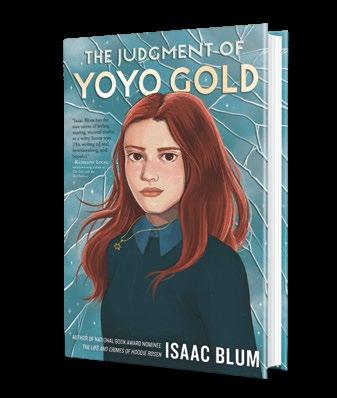
Jew in publishing specifically. You wonder what sort of interest there is in Jewish stories—is it heightened or diminished in this climate? And what kind of stories are Jewish readers looking for? Are they looking for more celebratory or more nuanced stories? It’s really challenging.
What’s next, and do you see it being set in an Orthodox community as well? I’m working on another book that will come out, knock on wood, in the fall of 2026, and it’s going to be about less observant Jews dealing with grief. At the moment, one of the characters is a more secular Jewish teen boy who experiences a tragedy. In needing to grieve, he reunites with his Jewishness and finds a community that he didn’t have previously. I’m hoping we learn about Jewish mourning practices with him as he finds meaning in these traditions.
What haven’t we talked about yet, that’s on your mind with this book? When Hoodie came out and I got to talk to people about the book—most of whom weren’t Jewish, because most people aren’t Jewish—people from different faiths said they also saw themselves in his story. A lot of young people are on the same journey of figuring out what they believe versus what their parents believe. So I was thinking about that a lot while making this book: the journey of making your beliefs, your faith, your tradition, your own is a universal one.
Ilana Bensussen Epstein is a writer and filmmaker in Boston.
Time After Time will be published next spring.
A new young adult novel by Mikki Daughtry is coming in 2025, People magazine reports.
Penguin Teen will publish the author and
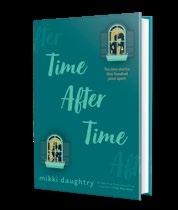
screenwriter’s Time After Time next spring. The press describes the book as “an epic YA sapphic romance, unfolding over two sets of lives, one hundred years apart.”
Daughtry is the co-author of two previous young adult novels: Five Feet Apart, written with Rachael Lippincott and Tobias Iaconis, and All This Time, written with Lippincott.
Her new novel will follow Libby, a 19-year-old woman who buys a house, and discovers in it a century-old journal written by Elizabeth, a woman who was in love with her maid. Libby then begins to fall for another young woman, and begins to see parallels between their relationship


and the one between Elizabeth and her maid.
Daughtry announced news of the book on Instagram, writing, “So… I did a thing. I’m so excited for this. Five Feet Apart was some of my heart. All This Time was more of my heart. Time After Time IS my heart. The whole thing. Unfiltered. Just me. I can’t wait for you to meet Libby and Tish, and Elizabeth and Patricia. I hope you love them as much as I do.”
Time After Time is scheduled for publication on May 20, 2025.—M.S.

For a review of Five Feet Apart, visit




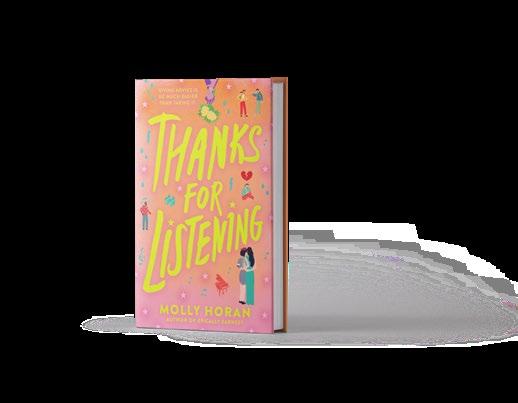
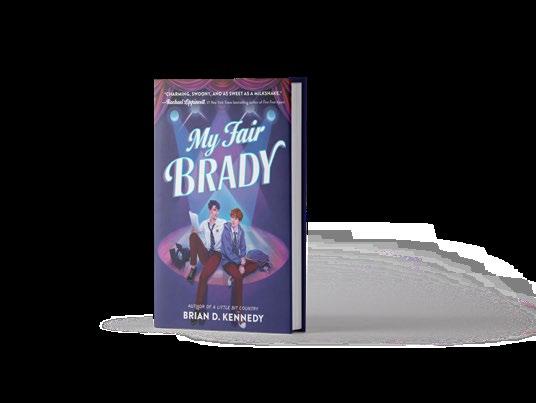


GENERALLY SPEAKING, spy stories used to come in two basic varieties: escapist tales of impossibly suave international operatives taking down battalions of evil minions as effortlessly as they seduce every gorgeous woman who crosses their paths (the Ian Fleming paradigm) or downbeat, oppressively bleak chronicles of faceless functionaries in shabby rooms awaiting cryptic phone calls as they contemplate their moral decay (the John le Carré model). Absurd power fantasies for armchair adventurers or stylish literary bummers that go down like sour gin—give or take a Jason Bourne: These were basically your choices. But in our postmodern era, as genres break apart and recombine like so many world-ending super-viruses concocted by mad megalomaniacs in their volcano lairs, espionage narratives have mutated into any number of fascinating forms. In Indieland, we’ve been updating our dossiers to track some of the more intriguing heirs of James Bond and George Smiley. In Hannah Honegger’s A Lady, Mary Hannah André, a young 18th-century Englishwoman, tires of being little more than a decorative
object at lavish parties and travels to America in search of adventure. She finds it, ultimately joining George Washington’s (real-life) Culper Ring spy network. Our reviewer praises the novel’s fusion of romance and espionage tropes, highlighting Mary as a “spirited, engaging protagonist, bringing readers directly into the intriguing spy games and up close to the colonial luminaries of the day.”
Allan Krummenacker and Richard Caminiti’s The Pass moves up the action from the American Revolution to the Civil War, chronicling the adventures of Keefer O’Connor, an Irish immigrant recruited by the War Department to assassinate the governor of
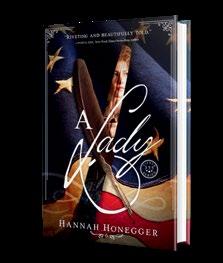
California should he waver in his anti-slavery stance. Keefer has the wit and charm of a James Bond— along with the paranormal ability to see 60 seconds into the future. It’s not exactly a missile-equipped Aston Martin, but it comes in handy as he struggles to evade the supernatural creatures hot on his trail.
Our reviewer singled out the novel’s “exhilarating scenes of battle and tension.”
Another war, another spy: F.R. Vincenti’s World War II–set Glenda Paal & The Devil’s Dawn features a young Swedish “linguistic chameleon” who, through a convoluted series of events, finds herself a triple-agent simultaneously working for multiple national interests (her true mission is to defeat the Nazis). Juggling a handful of unique personas, Glenda is “a stellar,
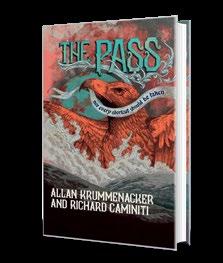

ARTHUR SMITH
larger-than-life (in good spy-genre style) lead,” per our review.
We come full circle with Haris Orkin’s The Spy Who Hated Me, a spoof of James Bond yarns that makes its intentions clear from the title page. James Flynn is a patient at a psychiatric institution who believes himself to be a master spy. He’s not entirely delusional: He has, in fact, saved the world on several occasions with his curiously effective skills. In this installment of the series, James embarks on a mission to track down his sort-of girlfriend, CIA agent Caitlyn Valentine, who has stopped returning his calls. Our reviewer judges the novel to be “endlessly entertaining”; in a world gone mad, James Flynn may be just the hero we need.
Arthur Smith is an Indie editor.

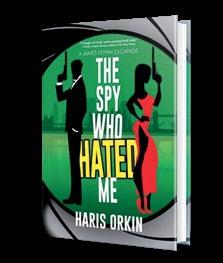
A historical novel looks at the Donner Party disaster through the eyes of a young woman.
Ada Weeks, 19, is on a wagon train headed to California in 1846. The long trek has barely begun when she loses her adoptive parents to a raging river. In a flash, she has little but the clothes on her back, but the Breen family takes her on as a kind of nanny. Even at the best of times, the journey is relentlessly horrendous: heat, humidity, biting insects, snakes, choking dust, quagmires, swollen rivers, wagon breakdowns, exhausted and starving oxen, hostile Native Americans—the list goes on. But the wagon train pushes on, with these folks even entertaining themselves in the evenings. Then comes a fateful
decision. Having lost precious time already, some in the party talk themselves into taking the new Hastings cutoff, supposedly a shortcut. Bad idea. The Great Salt Desert is a trip through hell and the trail often seems just a vague suggestion. The travelers fall further and further behind schedule and wind up stranded on the eastern slope of the Sierras at Truckee Lake as the worst winter storms in decades move in. The suffering is unimaginable, the deaths staggering. And then there’s the cannibalism. Will Ada make it to California?
Sweeney has blended Ada and a few other fictional characters seamlessly with real people—the Donners, the Breens, Pat Dolan (her first love), the Graveses, and the Reeds—who died

Sweeney, Ashley E. | She Writes Press | 344 pp. $16.95 paper | May 19, 2020 | 9781631528446
tragically or survived miraculously during the ordeal that is fixed in the national consciousness. (There is a helpful list of characters and a map in the frontmatter.) The author is a master of vivid descriptions, dragging readers along every wretched mile of the trail, sharing every dashed hope and every dramatic confrontation,
with Ada as their guide. Ada is a marvelous creation, twice orphaned and both hopeful and fearful about a new life in California, the promised land. And savor Sweeney’s prose: “Hope was what used to fill our cup, Ada thinks. Now we are down to dregs.”
A vivid westward migration tale with an arresting mixture of history and fiction.
Fast-turning pages filled with hearty servings of revenge, reconciliation, and remorse.
Andrews, John F. | 46 North Publications (300 pp.) | $23.99 $13.99 paper | Jan. 13, 2024 9798989383542 | 9798989383535 paper

In Andrews’ historical novel, two French siblings and their dog desperately attempt to escape invading German forces in 1918. Marcel and Geneviève Durand, 15 and 13 years old, respectively, live in Bouresches, a region of France soon to be evacuated as German troops march perilously close to it. However, Claire, their mother, is terrified by the prospect of evacuating because Geneviève is gravely ill with pneumonia and likely to die if compelled to walk even a modest distance. The Germans inevitably arrive, and Claire dies protecting Geneviève from their furious assault on the town. The children’s father, Pierre, also perishes fighting on the front, and they are left orphaned, their only guardian a fiercely devoted border collie named Abby. Marcel remembers they have a cousin named Henri somewhere in Paris— maybe in Neuilly-sur-Seine—but he has never met him and doesn’t even know his cousin’s last name. Abby, though, knows Henri and his wife, Sophie, well—they were once her owners. In this moving tale, Abby herds the siblings through a countryside ravaged by war, a dangerous journey that threatens the life of the ailing Geneviève. The story is told from multiple perspectives—including Abby’s, who is depicted with great nuance as deeply intelligent (border
collies are “geniuses of the dog world”) but still not overly anthropomorphized: “I may not understand human sadness, but I know what it smells and looks like. It fills the house,” the canine observes. The opportunities here for schmaltzy sentimentality are manifold, and occasionally the author simply can’t help but indulge, especially toward the conclusion of the novel. However, for the most part, Andrews resists the allure of maudlin melodrama and limns a surprisingly unflinching tale of loss and survival. This is often a profoundly forlorn story, but not a hopeless one, and it is as emotionally affecting as it is historically authentic. A remarkably sensitive depiction of the teenage psyche under unthinkable pressure.
Buttner, Regina | Black Rose Writing (242 pp.) | $20.95 paper Oct. 24, 2024 | 9781685134969

A troubled young man’s eviction leads to disaster in Buttner’s thriller. Revenge may be a dish best served cold, but in this tense novel, the temper of 25year-old Rudy Hodgens is red-hot as he seeks payback from his stepparents for evicting him from the house where he lived for two decades. When Rudy was in kindergarten, his mom died in a car crash; she had been married at the time to Iraq War veteran Mitchell, who was not Rudy’s biological father. A year after the accident, Mitchell married Debra, who became an instant mother to Rudy.
Now Debra sobs as her deadbeat stepson packs up and leaves by court order, but Mitchell stews—Rudy has had multiple chances to turn his life around. Before Rudy leaves, he steals a Glock from Mitchell’s collection of guns, ammo, and fancy knives. Rudy tries to sell the Glock to a local thug he knew as a child, but seeing the gun reminds the potential buyer of all the weapons in Rudy’s family’s basement. Rudy also commits “domestic terrorism” by sneaking into the house at night to scare the easily frightened Debra while Mitchell works his overnight shift as a security guard. To make Debra feel safer, Mitchell helps her buy a pistol and (because he loves her) a gun bag in a “pink camouflage pattern.” But is Debra the “wimpy little woman” she appears to be? Complicated, marginalized characters converge in this edgy narrative that zips quickly along. The author excels at writing about people with both minor and major flaws, stashing secrets in each character’s backstory. Lies unfold, revenge is plotted, and suspense builds quickly to a satisfying ending. Well-observed details enrich the story, such as descriptions of the coffeeshop fireplace “that looks warm and cozy, but doesn’t actually emit any heat” and “the sleety snowfall that’s studding the front stoop.”
Fast-turning pages filled with hearty servings of revenge, reconciliation, and remorse.
Caso, Susan | Radius Book Group (240 pp.)
$28.99 | Oct. 22, 2024 | 9781635769364
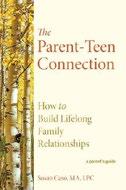
Raising teens can be tough, but counselor Caso’s practical guide aims to help. The author, a family counselor with 20 years of experience, offers a helpful manual to help parents, stepparents, and other caregivers forge stronger bonds with teenage kids. She draws on illustrative
stories from her practice and from her own life as a parent to explore the changes that emerge in adolescence: “Many teens who come to my office tell me, ‘We don’t talk about how we feel at home. I would like to feel closer to both of my parents,’” she reveals. The book also addresses LGBTQ+ issues, communication styles, common barriers to a feeling of belonging, and how to break cycles of negative interaction: “Often parents come into family therapy to discuss rules and what a teen isn’t doing well,” Caso writes. “Teens come to therapy wanting to discuss the relationship. I see this dichotomy over and over again in sessions.” If caregivers work to listen without judgment and empathize, this book asserts, they can foster closeness, trust, and transparency. Ideally, teens will feel safe sharing their emotions and learn lessons they can carry into future relationships. Caso notes that it’s up to adults to lead the way with conscious, continual effort, but that it’s well worth it. The book packs a lot of material into relatively few pages; as a result, it can feel disjointed at times, with some passages, such as the one addressing gender expression, only skimming the surface of its topic. That said, the guide provides readers with concrete steps to take, backed by solid, cited research, and it does so in a conversational manner that’s consistently positive and uplifting. Readers will be encouraged by the insightful questions that close each chapter, which are designed to help readers implement the lessons. However, the author might have considered using boxes and bullet points to break up the text, as solid, unbroken walls of words can be intimidating in a self-help format. A wide-ranging guide to understanding and cultivating better relationships with teenagers.
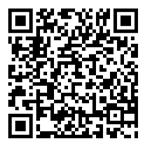
Crichton, Judy | North End Books (305 pp.) Oct. 1, 2024 | 9798350945898

Judy Crichton, a legend in documentary filmmaking, recounts her turbulent marriage to acclaimed novelist Robert Crichton in this posthumous memoir.
A trailblazer in documentary journalism, Crichton was among the first women to direct and produce documentary films for network television in the 1970s. She would go on to become the founding executive producer of American Experience, the PBS series that redefined the genre in the 1980s. The author began writing this memoir about her marriage to Robert Crichton in the 1990s; in this book, edited and published by Judy’s daughter, Jennifer Crichton, the celebrated documentarian reveals an intimate look at her personal life. Beginning as a whirlwind romance in 1951 between two 20-somethings, the Crichtons’ marriage endured through decades of pained love. “Big Bob,” as the author affectionally referred to her husband, thrived professionally (his 1959 novel The Great Impostor would inspire a 1961 movie by the same name starting Tony Curtis), but his life was plagued by untreated trauma from World War II and alcohol abuse. The memoir’s grappling with the tragedy of watching a lover, an intellectual companion, and the father of one’s children fight a losing battle with mental illness is particularly poignant. In addition to powerful reflections on the paradoxes of marriage, the book provides a fascinating insight into leftist circles in the 1950s and 1960s—Crichton describes her and her husband’s social circle as “a haven for unreconstructed activists: Marxists and socialists, feminists and integrationists.” The contrast between the author’s lifestyle and the mainstream culture of the era—from the banality of Howdy Doody to anticommunist
hysteria—effectively evokes a time of rapid change. The book also sheds light on the legacy of World War II, as jubilant postwar narratives of American victory belie the lived experiences of scarred soldiers like Bob. A tragic (but never morose) work, this is a tour-deforce memoir of a heartrending marriage. The intimate prose is accompanied by ample family photographs throughout. A powerful true story of two lovers that eschews mythmaking for brutally honest reflection.
Emerson, Lauren | Illus. by Kim Soderberg | Brown Books Kids (32 pp.)
$16.99 | June 4, 2024 | 9781612546735

A little girl searches for what makes her unique in Emerson’s picture book. Haley is a girl with long brown hair, fair skin, and blue eyes. She loves to write stories, make jokes, and doodle, and she never runs out of ideas. The only trouble is that whenever she writes, she leaves smudge marks on her hand and the page. At school one day, her teacher, Mr. Hart, assigns the class an exercise: “Writers, I want you to think about what makes you unique.” For the first time, Haley can’t think of what to write. One kid announces that her colorful glasses make her unique, while another explains that he’s bilingual, speaking both English and Spanish. Haley still can’t think of anything, so she tries drawing to spark an inspiration. Eventually, looking down at the smudges on her hand, Haley figures it out: She’s left-handed. Soderberg’s cartoon-style illustrations emphasize the diversity of students in Haley’s class, depicting kids with a variety of skin tones, hairstyles, and abilities. The narration also hints at Haley’s unique trait throughout the story, which renders the ending extra satisfying. Emerson’s prose has an easy, conversational tone and uses familiar
vocabulary to evoke Haley’s frustration (it’s a puzzler that Haley doesn’t consider her love of writing a unique trait) and the other kids’ pride in their special attributes. A charming confidence booster celebrating the wonderful uniqueness we each possess.
Farnham, Peter | Self (402 pp.) | $19.99 paper | Aug. 5, 2023 | 9798854313513

A Vietnam War veteran crosses paths with eccentric characters while making his way home to Maine in Farnham’s coming-ofage novel.
It’s 1969 and 20-year-old Arthur “Preach” West is back on United States soil after serving 18 months in Vietnam and surviving a deadly ambush. After meeting Amanda, a free-loving hippie who smells like “flowers and sun-dried cotton,” Arthur skips his connecting flight from California to stay with Amanda and her groovy roommates in the Haight neighborhood in San Francisco. They get stoned, have sex, and attend an anti-war demonstration, but their fling ends badly, setting the stage for the meandering, spontaneous cross-country trek that follows. On his wanderings he meets Chevrolet Ford, who teaches him boxcar jumping; Brenda, a survivor of marital abuse traveling with a van full of lost souls; dangerous cult leader Blue Hawk; and Ben Stetler, described by Arthur as “The Coolest Guy Ever,” who needs assistance driving 440 pounds of marijuana to New York. Despite Arthur’s many challenges, he often seems emotionally detached; after he’s violently mugged, he thinks, “Just great. Now I’m almost broke, too.” Arthur’s reactions to the deaths of several loved ones throughout the novel are also rather placid. This stoicism might be linked to his war experiences—readers must draw their own conclusions. The narrative timeline switches between Arthur’s past and present, the latter punctuated by
nightmares and memories of war; weaving these strands more naturally into the story would likely have improved the novel’s sometimes awkward pacing. Farnham broadly tackles themes of racism and homophobia, and astutely captures the transformative aspects of the period with references to relevant songs, clothing trends, the assassinations of Martin Luther King Jr. and Senator Robert F. Kennedy, and mounting hostility toward President Richard Nixon, all of which will appeal to historical fiction fans.
A perceptive meditation on the savagery of both war and ordinary life during a turbulent time in American history.
Florio, Mike | PFT Publishing (268 pp.)
$9.99 paper | Nov. 1, 2023 | 9798987944035

A lawyer stuck in a rut receives some crotchety holiday cheer from a mysterious old couple in Florio’s charming Christmas story. At the age of 45, with gray hairs and a spare tire growing apace, John Persepio makes a mediocre living filing wrongful termination lawsuits against superstore chain U-Sav-Plentee. But he still has a heart; on his way to court, he stops to help a shriveled old man whose ancient Chevy Impala has suffered a flat tire, weathering acerbic jibes in the process. (“Not much of a car for a lawyer,” the man notes of John’s threadbare Subaru.) The incident touches off a series of weird occurrences, including odd time
distortions, a vomiting spell that scotches his closing argument in a big case, and more encounters with the old man and his equally gnomic wife in stores, parking lots, and at a Christmas party. The couple subject him to amusing but enigmatic conversations while insisting that they are on their way home (where that may be is never specified). Meanwhile, John wrestles with his fraying marriage to his perpetually aggrieved wife Linda and his distant relationships with his teenage sons Joseph and Mark, whose faces are permanently buried in their phones and video games; his warm rapport with his sweet 5-year-old daughter Macy is the brightest spot in his life. Adding to his gloom are his guilty ruminations about his parents, who died young in their 50s, and his brother Michael, who committed suicide. John’s funk is sometimes relieved and sometimes deepened by the hectic run-up to Christmas: An excursion to a Christmas tree lot for a memorably crooked tree allows him to bond with the kids, a slapstick disaster that devastates both a ham and the tree heightens tensions, and a Midnight Mass proves surprisingly soothing. But at another meeting early on Christmas Day, the old couple bring up ominous prospects confronting John: divorce, a possible brain tumor, and maybe worse.
Florio’s yarn is a richly textured portrait of a middle-class clan with sharply etched characters and a touch of magical realism, written in evocative prose that’s wryly funny but has darker undertones of uncertainty, gathering estrangement, and loss. The author has a sharp eye for family dynamics, whether in the studied boredom of adolescents (“the boys seemed to be intrigued by the sight of the trees, even
A bittersweet exploration of family, nicely balanced between hangdog humor and plangent emotion.
though they tried to stifle any sign that perhaps they were on the verge of possibly enjoying themselves”) or the explosive antagonism between resentful spouses (“You had plenty of chances to tell me not to do this tonight. I asked you fifty times. You said, every single time, ‘It’s fine. Go ahead. It’s fine’”).
Through subtle observations of everyday life, Florio has crafted a resonant message about the purpose of parenthood, as when John watches the kids manage the tree without him: “In a weird sort of way, it showed they’d be OK without me, without parents, with nothing other than their own motivations and aspirations and above all else each other. I felt at once relieved and fulfilled and entirely irrelevant.” By turns comic, ruminative, and heartfelt, Florio’s tale captures the deep emotional currents flowing through a not-quite-typical Christmas. A bittersweet exploration of family, nicely balanced between hangdog humor and plangent emotion.
Ford, Preston | Thousand Candles Press (414 pp.) | $19.99 paper Dec. 30, 2023 | 9798224977161

A Black man flees his home after a terrible act of violence in this historical novel.
In 1934, Willie Lee Jameson, a descendant of enslaved people, is having an affair with a married Black woman named Emmy. Willie Lee wants to leave Charlotte’s Bend, Mississippi, and head west to California with Emmy, even though Emmy is a doting stepmother to her husband’s children. They get caught together, and the white men who catch them beat Willie Lee badly. Shortly after that, he gets fired from his job. He struggles to keep a job in Natchez, but he manages to save some money so he and Emmy can leave Mississippi and have a life
together. Then Emmy’s husband announces they’re moving to Chicago. At the same time, Willie Lee meets a man named Wise who gives him the guidance he needs to go west. Before he can leave, though, he has a vicious run-in that ends with the death of a white man. Now Willie Lee must flee; he grabs Emmy, and they make a run for it. They wend their way toward California, running into frequent obstacles. Emmy’s husband doesn’t intend to let her go, and there’s an unrelenting sense of danger. The white men in Ford’s novel are pure evil, and a sense of dread infuses everything Willie Lee does. The constant threat of violence makes the novel a difficult read, emotionally—although Willie Lee does occasionally get some help from kind strangers along the way. The dialogue is written in dialect that some readers may struggle with (“Schoolin’? Naw suh, I ain’t got much use fo’ it out yonder where I’m at”), but the novel is clearly well researched, and the resolution is an unexpected but interesting surprise.
A brutal, adventurous tale of Black life in the Depression-era South.
Green, Sandy Deutscher | Monarch Educational Services (294 pp.) $15.83 paper | May 14, 2024 | 9781957656465
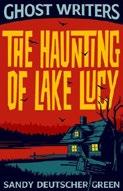
Twin siblings correspond with the ghost next door in Green’s free-verse YA spookfest. Thirteen-yearold Jayce and Evie are ready to unwind for their first summer
vacation at a Virginia lake resort. Local kids quickly fill them in on the legend surrounding Lake Lucy, reputedly named after a girl who inexplicably disappeared. As if that weren’t scary enough, an old, abandoned, and probably haunted house sits right next to the rental where the twins and their parents are staying. After Jayce captures
video footage of a potential ghost at said house, he seeks answers by means of writing a letter to the shade (actually, his braver sister slips it in the house’s mailbox). Even Jayce is surprised when the ghost writes back. Though the scribbled replies are initially vague, later correspondence makes an unusual demand of the twins. Jayce, whose dreams are plagued by the haunted house and phantom resident, willingly obliges. Is this ghost Lucy, or someone else, and what exactly do they want? Green’s free-verse text gives this novel ample style without diluting its substance. Suspense slowly builds as more than one person warns the twins to avoid the house and Evie spots something bizarre through a window…something that doesn’t belong. The cast shines, including the ever-playful Evie, whose most beloved possession is a plush lizard; fellow vacationer Blas, whose unwavering support boosts Jayce’s courage; and the mysterious “year-round boy” whose family runs the resort. Readers will fly through these pages as short stanzas beget concise chapters. The author’s lyrical verse makes reading a sheer delight: “My air-conditioned feet wiggle / as mist pours from the door / like steam from a witch’s cauldron.” The story takes a noticeable turn well before the end; while this blunts some of the mystery, the moody atmosphere sticks around for quite a long time. Chic, engaging storytelling elevates this delectable horror romp.
Greenberg, Emily | Kallisto Gaia Press (208 pp.) $19.95 paper

Greenberg’s short-story collection invites readers to reconsider their perspectives on seemingly familiar topics, including politics and interpersonal relationships. This author shows an interest in experimental storytelling from the first, titular work, which details a politically
charged conflict over the course of a nearly 12-page-long sentence that begins, “Maybe the two silver-haired, tuxedo-clad men were not really about to fight, Kellyanne thought.” Other tales play with structure, too: “Black Box” details the life of an unconventional character as he investigates his own goals and relationship along with what it means to be human. This story begins with a list of definitions that serves a dual purpose, first preparing the reader for a potentially unfamiliar environment, and setting a tone of clinical detachment. In “Tonight Show,” the author presents a speculative version of President George W. Bush’s childhood, bookended by an interview on an evening talk show; the story effectively navigates how public and private opinions intersect. These fictionalizations investigate their real-world counterparts with a surprising amount of humanity and complexity, and the prose reveals the author’s attention to craft. One striking example is in “The Author and the Heiress,” in which Greenberg writes of a character handling books: “She picked up a few, then tossed them on the floor one by one like she was a child again, trying on her mother’s perfumes in front of the armoire, humming her own invented melodies in the cavernous silence. Jasmine or lavender, orange blossom or coconut. And who would she be today?” A bold and often eerie set of tales that skillfully explore life’s what-if complexities.
Huntman, Rebe | Monkfish Book Publishing (280 pp.) | $24.99 paper Feb. 18, 2025 | 9781958972557
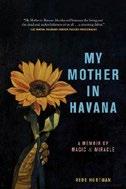
A woman seeking connection with her deceased mother immerses herself in Cuba’s Santeria religion in this powerful memoir. When Huntman was 19 years old, her mother died. Still aching from
Spiritually rich and unabashedly passionate, this memoir is a feast for the soul.
MY MOTHER IN HAVANA
the loss 30 years later, the author became intrigued by the Cuban festival celebrating Our Lady of Charity. On her first trip to Cuba to study dance, she was introduced to the ritual dances of Santeria and learned how the river goddess Ochún has been syncretized with Our Lady of Charity. Huntman felt compelled to join the yearly pilgrimage to Our Lady’s sanctuary, hoping to find a way back to her mother in the pursuit of the “divine matriarch.” She took a second month-long trip to Cuba, spending the first 15 days in Havana to learn more about Santeria and the dances and rituals surrounding Ochún. For the second half of the trip, she journeyed to El Cobre, where the yearly ceremonies honoring Our Lady take place, to commune with priests and historians. Finally, she visited a spiritist named Madelaine, whom Huntman hoped would be able to summon her mother’s spirit. As Huntman became enthralled by the goddess Ochún, she also began to adeptly interrogate the role of femininity in her and her mother’s lives, exploring how gender affected their ambitions, social expectations, and presentation of themselves. (“At night I’d kneeled by my bed praying to whatever father god looked over me. Nowhere had I been looking for a woman—a feminine source I carried inside myself.”) The author’s search for her mother becomes a compelling examination of the self as she questions her past and her belief systems as they relate to the divide between the living and the dead. Huntman’s deep love and respect for Cuba, and the Afro-Cuban traditions that permeate the culture, are abundantly clear in the writing. Lush, detailed descriptions of the world she was granted access to are skillfully interwoven with her personal reflections on her past and present.
Spiritually rich and unabashedly passionate, this memoir is a feast for the soul.
Kapllani, Gazmend | Trans. by Peter Bien | Laertes (172 pp.) | $22.00 paper Sept. 16, 2024 | 9781942281412

The death of his father brings an expat back to his fraught hometown in Kapllani’s novel. It’s been 27 years since Karl left his native city of Ters, Albania, for a better life in Greece and, ultimately, America. The death of his father has brought him back home, however, and he finds a city just as riddled with contradictions as it was when he left. Ters is a city in which Roman, Byzantine, Ottoman, and Soviet pasts mingle, a city “in which everything—religions, people’s names, streets, animals, inanimate objects—existed in double or triple versions.” There he finds his brother, Frederik, the son who remained in Albania to uphold the communist ideals of their father—a man so committed to the revolution that he named his sons after Marx and Engels. Karl has long resented his father’s dedication to what he sees as a failed ideology and is surprised to learn that the old man had become an observant Muslim before he died. Karl’s trip home reopens memories stretching back to his mother’s mysterious suicide decades before. As he and Frederik butt heads over matters personal and political, a portrait emerges not only of a fractured family, but also of a fractured city and of an exile who has lived most of his life (in the words of
his father) “speaking other people’s languages.” Kapllani’s prose, as translated by Bien, is not always smooth, but the images and ideas are almost always striking. “A writer’s mind often resembles a cemetery,” observes the narrator. “Most of the stories and characters fashioned by such a mind usually return like midnight shadows to the mysterious darkness of their source.” The narrative leaps around in time, covering Karl’s years in Greece and America before returning to Ters and the aftermath of his father’s death. Through Karl’s experiences, Kapllani excavates the complex and often paradoxical relationship a person has with the homeland from which they have been separated, whether through immigration, war, regime change, or the simple passage of time.
A thoughtful and surprising novel about Albania and exile.
Keating, Lori | Monarch Educational Services (264 pp.) | $15.99 paper June 17, 2024 | 9781957656557
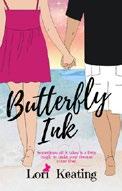
A young woman spends her summer learning several critical life lessons in Keating’s YA novel.
Callista Stockton is 18, freshly graduated from high school in Arkansas, and off to spend the summer living and working with her best friend, Becca, on Wellington Island, Florida. Calli’s confidence was obliterated in 10th grade when her crush asked her to homecoming and then ditched her for the prettiest girl in school. On Wellington Island, Calli immediately meets Jake Dawson, a gorgeous 19-year-old who seems to be interested—but Calli has her doubts. Wanting the summer to be different, she finds herself cast into the path of Mathias Soria, a vendor at the island market who gives her a temporary butterfly tattoo. Calli can hardly believe her luck when, the next day, she wakes up and is suddenly a stunner. Becca tells her, “You’re like beautiful…I mean, I’ve always thought of you as pretty, but wow, you are gorgeous.
Dang!” The changed teen soon catches the attention of the Wellington family, who offer her a job modeling for their fashion business, Beach Beauty. As the magical tattoo pushes Calli’s looks beyond anything she thought possible, a rift forms between her and her friends, who liked her just as she was. Readers will be hooked on Calli’s dilemma: Should she remain outwardly beautiful or true to herself?
Everything comes to an entertaining head during Calli’s soul-searching trip back home to Arkansas. Keating’s storytelling is fun, although the delivery is a little too obvious in places, like when Calli becomes annoyingly vain. Still, the novel capably limns the insecurities of coming of age, and the portrayal of first love and learning to be comfortable in one’s own skin will consistently engross readers.
A somewhat cliched but sweet summer romance for teen readers who enjoy a sprinkling of magic.
Kelly, Cordelia | Library and Archives Canada (330 pp.) | $16.99 paper July 15, 2024 | 9781738863396

A cursed teen and a blind orphan join forces against an onslaught of perils in Kelly’s YA fantasy.
Like many of the kingdom of Illyamor’s youths, 18-year-old Sabine Gillesella is cursed with a supernatural power (“people blessed with magical abilities were viewed with suspicion and fear”). She has turned invisible and will eventually fade away into nothing. Desperate, she makes a deal with the enemy: Duke Aurich, one of the Halwardians who have enslaved Sabine’s people, the Awhye. Sabine’s invisibility allows her to spy on nobles for the duke, a fire mage who for months has promised to help control her magic. Sabine opts to put her trust in Anora, a blind orphan seer who weaves tapestries at the Halwardian castle and foresaw the invisible girl’s arrival. Sabine learns that if she guides Anora to a creature-riddled forest that
people don’t generally survive, she can be cured. The two teens (along with Sabine’s younger brother Rafi) run into demons and monsters that crave human flesh or souls. Kelly excels at speedy worldbuilding but doesn’t rush the narrative. As the siblings and Anora trek to the Dikisi Forest, the novel introduces myriad creatures, both terrifying and possibly friendly, as well as numerous additions to the cast. Aurich is an unquestionable menace; he pursues Sabine (and, for a reason not immediately clear, Anora) with an unnerving firewalking ability (transferring his spirit through flames). Sabine is an easy protagonist to like, as she’s protective of her family and friends; she and her hotheaded but equally loyal brother both stumble into understated, engaging romances. The story continues to dish out startling plot turns (not just in the final act) before reaching an unforgettable open ending.
Dynamic characters galvanize this entertaining, well-paced magical tale.
Kelner, Drew N. | BioCentury Press (353 pp.) | $11.99 paper May 28, 2024 | 9798988608103

A thorough summary of the ways in which scientific breakthroughs are revolutionizing the treatment of cancer. For a long time, the author notes, the conventional approach to treating cancer relied upon surgery, radiation, and chemotherapy: the “cut, burn, and poison” trinity. But while these toxic therapies can be very effective in reducing the size of the tumor, they can also catalyze the genetic instability that spreads cancer. Decades of new research in cancer biology, immunology, biochemistry, molecular biology, and cellular engineering now promise new strategies that could reduce cancer to a manageable condition like diabetes.
“While this malicious malady inherent to
our biology cannot be eradicated, perhaps, at last, it can be tamed.” The author furnishes a concise but comprehensive history of the research related to cancer and the evolving scientific consensus, as well as a remarkably lucid discussion of the “startling advancements in cancer therapy” like precision oncology that can “characterize in exquisite detail the molecular characteristics of each patient’s cancer.” The great challenge of fighting cancer has always been its “astounding biological complexity,” but new knowledge, including the sequencing of the human genome, has revealed much about the “biochemical basis of life.” Kelner’s presentation has no shortage of scientific technicality; he writes with admirable clarity, although the complex nature of the subject only permits so much accessibility to a lay audience. Nevertheless, he achieves his goal not only to provide a rigorous synopsis of the most recent research, but also to convey his “enthusiasm and wonder” for biology and medicine. Cancer is a “dreadful human affliction,” but there’s something not only intellectually fascinating, but also morally noble about the collective scientific effort to counter it. For those interested in the subject, and armed with patience for some dense reading, this is a marvelous book that’s packed with knowledge, insight, and hope. A thrilling synopsis of the current condition of the fight against cancer.
Kirkus Star
Khan, Gulrez | Self (126 pp.) | $29.25
$18.53 paper | June 2, 2023
9781087966205 | 9781088205792 paper
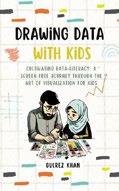
whose parents are teaching the basics of data visualization to her and her younger brother “one graph at a time.” Each of the book’s chapters contains a story in which little Pariza is exposed to some new data concept or mathematical process, followed by a “time out” in which more details are provided, concluding with a “your turn to play” segment in which young readers are encouraged to try out the skills they’ve just learned. In this fictionalized setting, the author contends with a variety of simple data-representation challenges, from the basics of making a graph to ways of breaking down such statistical data as the average rainfall in each of the United States or the number of vowels and consonants in the various state names. Gradually, the subjects grow more elaborate and more complicated, always couched in the activities of Pariza’s family. In one section, Pariza and her family members keep track of each person’s score during rounds of Scrabble; Pariza then converts those scores into a graph (“she started adding dots for her score and connected them to form a line graph”). Khan’s narrative choice to render all of this as a story with identifiable characters (including resourceful Pariza, her calm, understanding parents, and her headstrong younger brother) is a wise one; the approach will allow younger readers to learn the basics of data visualization without feeling intimidated or bored. The book’s uncredited illustrations, showing not only characters and their settings, but also multicolored charts and graphs, further help to demystify what might otherwise be daunting concepts. By the end of the book, Pariza is confident and ready to take on the world, and Khan’s young readers may very well feel the same way. A brightly inviting and effective manual for teaching data visualization to younger readers.
Leaven, Liam James | Illus. by Margarita Etienne Editions (36 pp.) | $15.95
$11.95 paper | Aug. 21, 2024
9798990471634 | 9798990471641 paper

Leaven surveys daily parental frustrations in this comical adult take on children’s picture books. “Why do I have to wear a coat, hat, shoes, or even pants?” asks an adorable little pastel girl. The parent’s exasperated response: “Wipe your snots. No more questions. Fu**’n said so.” Supplemented by Margarita’s soft but energetic illustrations, the text takes readers through a number of frustrating moments in which parents feel they simply can no longer answer a toddler’s incessant questions, such as, “Why can’t we play in the snow all day?” “Why can’t I hit mommy in the head with a tennis racket?” “Why can’t we keep swimming in the ocean?” “Why do I have to eat chicken nuggets?” “Why can’t I have the other toy I wanted?” (To which the author delivers one of the book’s funnier responses: “Well you better f***ing play with this piece of crap—and love it forever.”) Parents will certainly find numerous memorable lines that speak directly to their feelings of failure in the face of a fickle little one. Caregivers will also relate when Leaven writes of having been so mellow pre-child, only to now realize, “I’m just a dumpster fire of failed internet parenting tips.” The author displays deft comic skill at setting up jokes within this succinct format and offers several inventive variations (such as adding a “glub glub” as the mother feels like she’s drowning, literally and figuratively). The picture
An illustrated guide to teaching visual information to children. The key fictional conceit of Khan’s nonfiction debut is a 10-year-old girl named Pariza,
A slightly more bitter than sweet—but still very funny—picture book for parents.
BECAUSE I
book strives to walk that narrow line between childlike sweetness and adult humor that the well-known book Go the F***k To Sleep (2011) pulled off so well. (This book clearly draws heavy inspiration from that work’s similar premise.) Thanks to Margarita’s warm illustrations, the book is largely successful in hitting that difficult tone, but the exasperation and frustration do at times overpower the warmth. (The chicken nugget rant toward the end, for example, feels more in line with the beginning of an angry stand-up set than a charming picture book.) Despite these minor imbalances, loving and exhausted caregivers will certainly chuckle when seeing themselves reflected in these colorful pages.
A slightly more bitter than sweet— but still very funny—picture book for parents.
Lockwood, Katherine | Illus. by Evgeniya Krokhina | Acorn Cottage Press (35 pp.) $14.99 paper July 25, 2024 | 9781964836003

In Lockwood’s picture book, an owlet learns that everyone has their own differences.
Rose, a young owl, is having a birthday party and wants to invite all her park friends. Her mom expects her to be excited, but the youngster is worried. She feels self-conscious about the fact that she’s different because she has to turn her head from side to side to see things properly. Her mother tries to allay her fears by helping her deliver the invitations. As Rose tells each friend about the party, she sees that everyone is different in their own way: in their physical features, how or what they eat, and how they move, think, talk, see, or feel. Soon, Rose is happily making accommodations for all her friends’ needs. Atop watercolor backgrounds, Krokhina’s earth-toned colored-pencil illustrations finely detail each animal’s fur, feathers, or skin design as they joyfully participate in different activities with differences,
such as the use of a wheelchair or a feeding tube, clearly displayed. At the book’s end, Lockwood informatively includes a page about Moebius syndrome with illustrations that show how the condition presents in each of Rose’s friends throughout the story. An important story that celebrates diversity and promotes awareness about a rare condition.
Lowry, Ann E. | Koehler Books (392 pp.) $28.95 | $21.95 paper | Sept. 10, 2024 9798888244418 | 9798888244395 paper

In Lowry’s novel, a repressed politician’s wife finds unexpected strength in the story of her long-lost greatgreat-aunt. When Rachel Jackson’s mother passes on to her an heirloom—a small blue trunk that belonged to her “crazy” great-great aunt Marit, who was never spoken of by her family—going through the old papers within it to learn more about Marit seems like a pleasant distraction. Why do the contents include a napkin from a notorious speakeasy, a hank of horsehair, and a news clipping about gangsters? Rachel is secretly miserable, despite her privileged life. Her husband Blake, a conservative Arizona congressman, is running for reelection, and she feels stifled playing the part of the perfect political wife. Her situation further darkens when she accidentally finds a woman’s scarf—not her own—in Blake’s computer bag while looking for a rubber band. The narrative shifts: Carrying all her worldly possessions in a blue trunk, Marit Sletmo emigrates from Norway to Wisconsin with her older brother Jorgan and sister Ingrid in 1904 as a naïve 17-year-old. Jorgan, her legal guardian, plans to marry her off to a self-absorbed, rich older man to fund
his own ambitions. When her budding friendship with an unconventional older woman causes her fiance to break their engagement, Jorgan has her declared insane (and in a time when almost anything could be diagnosed as “hysteria,” that’s appallingly easy to do). He fears that Marit might reveal a damaging secret about him. (“We have decided you should go away…we think it’s the best thing for you.”) The perspective shifts between Rachel’s first-person point of view and Marit’s close third person, an effective way of highlighting the immediacy of the present and the distance of the past. Both women are compelling, sympathetic, and memorable characters. Their interwoven stories reveal unexpected parallels between their very different lives and personalities as each finds the inner strength needed to break free from captivity— Rachel figuratively and Marit literally. Inspired in part by the life of the author’s own ancestor, Marit’s tale will resonate long after readers have finished the book.
Lowry’s novel offers humor, sharp social commentary, startling twists, and a satisfying conclusion.
Manning, J.B. | Encircle Publications (356 pp.) | $19.99 paper | Sept. 25, 2024 9781645995654

In Manning’s novel, a lawyer disillusioned by his life in the city moves to Vermont but can’t escape the drama.
Arlo Hatch is a lawyer specializing in business litigation. Though his love for Stella, the daughter of one of his clients, is a bright spot in his life, Arlo is disenchanted with his career and yearns for a change. After Arlo is unsuccessfully mugged, Kostya Kozlov—a former client who was recently released from prison—benevolently takes the mugger (named Mikey) under
>>>


A paladin battles terrifying sea monsters in the author’s latest fantasy novel.
BY CHELSEA ENNEN
IN FUTILITY OF DEFENSE , Bryan Cole’s second installment in an epic fantasy series, A Paladin’s Journey, Krell is called by his patron god, ReckNor, to the coastal town of Waterford to help its people fight back against a peculiar threat:
Properly called the sahuagin, the shark-like sea devils lived under the waves. They were predators, and while they started small and bestial, they grew larger as they aged. More than that, they also gained intelligence. When one grew large enough, it attracted a school of them, bound to its will. Such groups swarmed in search of food, and instead of feeding on one another as they usually would, they worked together to hunt larger prey.
Every so often, they came ashore to hunt people.
Even on land, the sea devils were faster than a swift runner, and were exceptional climbers. Their talons and huge, teeth-filled maws made them deadly combatants in a fair fight. They often attacked in darkness and rain, seizing every advantage they could find for themselves.
Krell wasn’t completely certain, but he believed he’d been called to stand against the sea devils. He wished ReckNor would just explain why he had called him.
YOU MUST FIRST SURVIVE THE BATTLE TONIGHT.
ReckNor’s voice crashed like a tsunami into Krell’s thoughts. He had a lot of practice listening to that voice and controlled his reactions. Instead of flinching, he just shuddered slightly.
Are you ever going to explain to me what else I’m supposed to do?
IN TIME, PERHAPS.
Krell sighed. It was never easy being a paladin.
To defeat these amphibious demons and fulfill ReckNor’s orders, Krell bands together with a team of allies big enough to fill the pages of this epic fantasy. Kirkus Reviews notes that “a dazzling cast brightens this tale of clashing swords and spellcasting,” and “Krell makes an admirable hero who enjoys rescuing others.”
But “rescuing others” isn’t necessarily what being a paladin is all about. Cole, who works in enterprise software and makes his home in Toronto with his wife, daughter, and a beloved cat, is a devoted fan of the paladin trope. He cites fantasy stories like Elizabeth Moon’s The Deed of Paksenarrion and Margaret Weis and Tracy Hickman’s Dragonlance Chronicles for sparking his imagination about how to use paladins in interesting ways.
“Most fantasy settings will usually have a concept of multiple gods,” he says. “Each of those gods is a tangible, obviously real force. There are gods of good, who are noble and just, who call a holy warrior to defend the faithful, and therefore that warrior, the paladin, is also noble
and just and truthful. But when you look at any religion, there are people who do both good and bad things in the name of the same god. So the idea of a god being purely ‘good’ doesn’t interest me.”
What does interest Cole is a fantasy world of diverse gods with different kinds of interests, who would naturally call different types of people with varying motivations to serve as their paladins. Some paladins serving the more traditional, upright gods struggle to follow a litany of strict rules of honor. Others have different ideas about what it means to follow their patron god and therefore fight with their fellow paladins over who is right.
Krell, Cole’s protagonist in Futility of Defense, serves ReckNor, who doesn’t have any system of behavioral rules for his paladins to obey. God of the seas and skies, he holds freedom above all. “And while you’re free to choose, the consequences of your actions are yours, and you have to own them,” says Cole. “I really wanted to read the kind of story where a paladin is called by a more erratic god. It gives you a very different take on what a paladin can be.”
Cole’s technology career helps him a lot in his writing career, as he uses software to organize his worldbuilding. “Really what that does is ensure consistency,” he says. “It takes people out of the reading experience when things suddenly change, or when characters develop a power that they don’t have to struggle to learn. In a book, you want that process of characters putting in the work for something that pays off in the future.”
Cole’s books also consider that concept of consistency—of setting something up that will have continued consequences down the line—in Krell’s allegiance to ReckNor. The god speaks directly to Krell in his mind, giving him orders without fully explaining them. Krell tries to obey ReckNor to the best of his abilities, trusting that eventually things will make sense. But at the same time, ReckNor’s personality and focus on freedom of choice allows Krell a lot of space to make his own decisions and grapple with the outcomes.
“I feel like I’ve been telling stories like this for a long time,” says Cole. “Whether I’m engaged in tabletop role-playing games or telling stories to my daughter, I think there should be a lot of realism, even in a fantasy story.” Cole says that much of the feedback he gets on his A Paladin’s Journey series comes down to his attention to realistic detail. “In real life, you interact with at least five people a day, even briefly. Those people will have their own names and backgrounds.” Cole wants his stories to feel like real places where real people live among magic and tempestuous gods, believing that if the author doesn’t do their due diligence to get all those details right, then the story fails to be immersive.
Kirkus praises Futility of Defense for the “chiseled prose [that] keeps the narrative humming, even though combat scenes occur infrequently. The final act, however, amps up the action when Krell’s war against the sea devils explodes. In between the violence, Cole squeezes in some much-welcome humor. Krell’s
The idea of a god being purely ‘good’ doesn’t interest me.
conversations with ReckNor, for example, often lead to amusing exchanges.”
To get all that organization, detail, and story written down while also leading the typically busy life of a professional and parent, Cole tries to do what he can, when he can. Sometimes that means finally getting a few hours to himself, not feeling up to getting words on the page, and doing research instead. That way, when he does feel more in the mood to write, he can devote his full attention to the page and finish several chapters in one sitting without having to pause to look something up or study something.
This system of working has gotten Cole through the first book in the series, Beginning of Arrogance, as well as Futility of Defense, and he says he has plans for five more books. But he does acknowledge the possibility of more if his ideas start stretching out. “I have a solid idea of where I want each book to begin and end,” he says. “If that journey in between gets sufficiently big and I can’t see a way to cut anything, we might end up with more.”
Even if he does have to expand past his seven-book plan, Cole is committed to fleshing out all the details of everything that matters and makes his stories feel real, while also omitting anything that doesn’t serve that purpose. “If I put something in a book, even it doesn’t immediately make sense in the moment, you know that eventually it’s going to come back around and pay off.”
Chelsea Ennen is a writer living in Brooklyn.
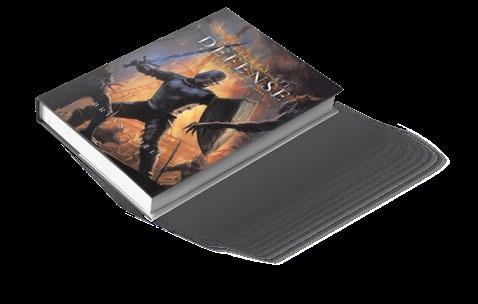
Cole, Bryan
Tellwell Talent (576 pp.) | $29.50
$16.99 paper | June 30, 2023 | 9780228892250 9780228892243 paper | Series: A Paladin’s Journey, 2
A compellingly poetic call for awareness, empathy, and action around racism.
his wing and tasks him with serving his wife, Elena, divorce papers. Both Arlo and Kozlov are in the employ of Pasha Pavlov, a Russian oligarch whom Arlo is representing in a case concerning embezzled funds and offshore accounts belonging to the president of Russia. Pasha’s case is ultimately dismissed, but he still wants to lay low and asks Arlo to help him hide. Upon learning his father is experiencing health issues, Arlo visits his parents in Stowe, Vermont, which spurs his decision to move back home and take over his parents’ farm. Following his resignation at work, Arlo takes up residence in Vermont’s Northeast Kingdom once again, where he must field duplicitous offers to buy his land in addition to attacks on his life. Manning’s story is immediately humorous; when readers meet Mikey, he’s hanging upside down, casually conversing with his victims-turned-tormentors. There is a delightfully punchy quality to the prose, which is fast-paced and crackles with evocative language: “A bottle-tan phony with a fake smile and an audience that skewed boat-parade boomer. Insincerity oozing from his makeup-packed pores.” Unfortunately, there are so many characters and subplots that the story sometimes becomes convoluted and difficult to follow. Despite this, Manning’s distinctive tale remains engaging throughout. A wild and enjoyable ride.

Manuel, John | Atmosphere Press (216 pp.) | $17.99 paper Sept. 24, 2024 | 9798891323667

In Manuel’s 1975-set comingof-age novel, five American prep-school boys take a photo safari through South Africa and the surrounding territories.
Aging British adventurer Cecil Covington has been taking teenage boys on African safaris for many years. When he makes a film presentation at a Connecticut prep school, he inspires 18-year-old Walker Scoville and his best friend Paul Schwartz (aka Schwartzy) to sign up for a six-week adventure that begins in Cape Town, South Africa. When the group docks in Africa, three more students have joined the expedition: Chas Morgan, Elliot Stroud (the youngest of the group), and troublemaker Alec Chapman. Ready for adventure, the youngsters do not yet realize the extent of the physical, moral, and emotional challenges that lie ahead of them. They arrive in a South Africa still ruled by apartheid and roiled by an increasing number of violent attacks by Black rebels based on the Namibia border. Their first taste of government authoritarianism comes at customs, when the agent confiscates the boys’ summer reading material. Over the next six weeks, they experience the exhilaration and fear of up-close encounters with wildlife, the appalling realities of apartheid, and a terrifying exchange with a group of rebels. Additionally, they must contend with the consequences of Cecil’s obsessive agenda to
gain recognition from the Royal Geographic Society. Manuel’s conversational prose, narrated in the detached voice of a third-person observer, captures the textured details of a rustic safari and fills the pages with vivid descriptions of the terrain and the magnificent variety of wildlife, much of which will likely be unfamiliar and intriguing to most readers. (“Below him, Table Mountain dropped a thousand feet, tapering down to a narrow ridge and rising again as a pyramid-shaped peak that did, indeed, look like a lion’s head.”) A few of the vignettes offer moments of real excitement, as when a large bull elephant charges one of the group’s Land Rovers, or the night when Elliot sleepwalks right up to a male lion. One heartbreaking episode involving a cheetah illustrates both the serene beauty and instantaneous, devastating violence of life in the wild.
An engaging tale of relationships forged in a changing land, loaded with historical and cultural nuggets.
Millwood, Simone | Self (76 pp.) Oct. 26, 2024 | 9781399921206

Historical injustice, personal trauma, cultural resilience, and more are covered in Millwood’s book of poems.
“Forcefully Taken,” the fiery opener, describes the harrowing experience of violation and “the weight of oppression, its jealousy and lust.” The speaker endures physical and emotional pain, likening the body to a “diamond under pressure.” “Guineamen” reflects on the brutal history of the trans-Atlantic slave trade. The poet juxtaposes joyful memories of freedom, when “Freewill crowned each step of life— / life was bright as the day once,” with the horrors of enslavement, when “Harvested like maize, / resisting bodies lay lifeless in heaps.” Body language, silence, and the power of words factor heavily into Millwood’s work. In
“Kindness for Weakness?” the speaker makes an outward show of agreeability but resents the need to be nice, warning “Do not mistake my kindness for weakness, / nor my silence for acceptance / Within me, lurks the power to pull down your walls of lies / and I will repay the past with modern vengeance.” In a critique of performative allyship, in “Do Not” Millwood writes, “Do not pretend to understand, / when you are part of the problem / by being silent, by downplaying, / by casually dipping your feet in torrid waters.” “Hidden in Plain Sight” is a poetic manifesto that speaks to Black people’s contributions that are often deliberately obscured and praises their resilience: “I am the roots that run through your veins. / I am the ancestors you venerate. / I am the blueprint of your DNA. / I am the face you seek to hide.” Millwood excels at conveying deep emotional experiences through vivid and evocative imagery. She describes “Great welts cascaded upon my temple, / Tattooing trees strong and ample, / With branches great and wide. Far-reaching” (in “To Never Forget”) and in “Rage” compares Black pain to a festering wound, “Oozing with yellow pus. / Injuries torn open / leaving rotting infection / down to the marrow / of the bone.” Her similes are equally strong, from clothes “discarded like empty wrappers” to how “your entrance is like a cool zephyr.” Millwood’s voice is direct and unapologetic, and she forces readers to confront their own perceptions and misconceptions around Blackness. While the book contains ample rage, it also shows encouragement and pride, as in “Black Gold,” when the poet asserts, “We are Jewels in human form, great beings to behold. / Calm as a summer’s day or as violent as a winter’s storm. / Walking the earth with majesty. / All who see them, bow in awestruck captivity.” Millwood also celebrates Black identities, proclaiming, “My Black is the type of black that brings forth life. / My Black breeds abundance in lack. / My Black is the type of black that calls men to stand as kings. / My Black rocks Earth and makes Heavens shake.” On the downside, the content can get quite gruesome and may be hard for some readers to stomach, like this recounting of a crime in “Little White Lies”: “One night,
2 Men, 1 Child, / Over days, beaten and tortured. / Smashing to a pulp / The child of a proud mother.”
A compellingly poetic call for awareness, empathy, and action around racism.
Murray, Bert | Amazon Digital
Services (114 pp.) | $9.99 paper
April 8, 2022 | 9798449051448

In Murray’s series-starting near-future dystopian novel, a middle-aged Jewish Manhattanite seeks love and finds danger. It’s 2025, and 44-year-old David Stein is searching for a suitable mate on the online dating site JDate after breaking up with his girlfriend of three years. However, due to “the new political climate,” he must get approval from the city’s Department of Health, because of laws put in place to ostensibly make dating “safer.” New York City has passed draconian measures that make it nearly impossible to practice Judaism or Christianity out in the open. During the Second Civil War of 2024, extremists burned down the White House, and a rise in antisemitic violence has made life dangerous for Jewish people nationwide. Nonetheless, David arranges a date in Central Park with a woman named Sue, and they both bring their dogs along. Things start off well enough, but then Sue reveals that she was fired from her job as an educator for teaching banned books. David and Sue hit it off, but they run into a major problem when Sue’s doorman tips her off that the Thought Police are waiting outside her apartment door; they’ve come to arrest her under a brand-new criminal code. The pair manage to flee to Long Island, where a woman named Hilda runs a hotel. The Thought Police don’t have jurisdiction in Nassau County, but that doesn’t stop them from trying to infiltrate the area. David and Sue
consider fleeing farther to Vermont, or teaming up with others who want to stop the ongoing assault on personal liberties in New York City.
Murray’s brief, straightforward drama wastes little time getting into the story. The descriptions are kept to a minimum throughout: Hilda is described only as “about sixty” with “salt-and-pepper hair”; David’s dog is just “a little white Havanese” that weighs 10 pounds. The political dynamics are kept simple, as well: The villains hate religion, and they’re very clear on this point. Indeed, when Sue and David encounter thugs in Central Park, one announces the name of their group as “Americans Against Religious Worship”; at another point, it’s mentioned that Christmas trees are routinely burned by anti-Christian extremists. The heroes don’t mince words; as Sue points out, when it seems that she and David are in imminent danger: “I just want this night to be over. It seems like it is lasting forever.” However, there are points when people unnecessarily point out the obvious, as when one man says of the Thought Police: “They are doing everything they can to make us live in fear.” The tone of the story leans toward the fantastical, and it’s a choice that effectively allows readers to consider the sheer chaos of the characters’ environment. The wildness of some plot developments, as when a member of the Thought Police is stopped by Sue’s massive Old English sheepdog–German shepherd–Great Dane mix, only further serves to illustrate the absurdity of the dystopian world. A whirlwind adventure that manages to be farcical but also thoughtful.
Palmer, Ronald | Barrow Street Press (108 pp.) $15.66 paper | April 15, 2024 | 9781962131025

Palmer’s poetry collection explores queer identity, Big Pharma, and Northern California Inverness, California, is an unincorporated
community in Marin County, a perfect hiking spot that Palmer frequents to meditate on the themes in this collection. Palmer’s narrators feel similarly unincorporated; they tackle social and historical events in the Bay Area, such as technology, the AIDS crisis, and LGBTQ+ life from a bird’s-eye view. The opener, “Telekinesis,” outlines what’s to come in the collection, including a near-drowning (rendered as “two heads full of memories…careening the paranormal Pacific”), relationships, and a bad breakup. Palmer writes about his past in pharmaceutical sales in the poems “Necrotic,” “Outside the Psychiatrist’s Office,” “The Art of the Tantrum,” and “Make Me Go Viral,” which grapple with the ethics of commodifying life-saving medications, the cavalier approach to wellness, and the paranoia within the queer community that AIDS could return to pandemic levels. The body is a central image for his ideas, and it appears as both viral host and lover. A frenetic quality builds throughout the work as Palmer reiterates his themes and skewers California’s pharmaceutical industry: “Ambition and antibiotics construct a secret circus / for psychotics.” The word virus appears over two dozen times, and Palmer favors the term manikin to convey his perceived lack of agency. The poems generally do not rhyme, and the stanzas are often broken, with lines that flow across the page like cells in the bloodstream. Some entries convey the subjects’ bleakness in the form of unyielding blocks of text. But Palmer’s knack for inventive imagery makes even the most despondent poems feel alive as he blends the landscapes of Northern California, Snapchat, anthropomorphic “furries,” and the rapper Future. These are queasy, graphic poems full of lines like “a chameleon the length of an erection” and “gravity is porous / and thinks /
like a virus.” As a whole, it’s a memorable, visceral collection. A startling, affecting work about self-determination and close observation.
Prettyman, Diane Owens | She Writes Press (304 pp.) | $17.99 paper Oct. 8, 2024 | 9781647427801

In Prettyman’s novel, a romance haltingly develops in the aftermath of a severe storm on the Gulf Coast. After her mother’s death, Teddy (short for Theodora) leaves Houston to manage the deceased woman’s candy store in the small Gulf community of Bird Isle—but, like much of the island after the recent “storm of the century,” Sweet Somethings is now only a pile of rubble. Enter Jack, a “George Strait lookalike” and the owner of a chain of barbecue restaurants. He’s helpful but lonely; his wife, Angela, died five years ago. Jack’s interested in Teddy, but she isn’t looking for love. She has a boyfriend in Houston and a stray dog named Pickles for companionship. Teddy also has financial problems but doesn’t want pity or help. Teddy’s island friends—Walt, a surfer; café owner Dot; and Barb, who rehabilitates animals— are pro-Jack, but Teddy has trust issues. It doesn’t help that all of Jack’s food trucks are plastered with Angela’s name. As their relationship tenuously evolves, Teddy catches Jack in a lie that jeopardizes their intimacy. Throughout the narrative, Prettyman switches back and forth between the viewpoints of Jack and
Light, breezy, and comforting as a block of fudge.
LOVE IS FOR THE BIRDS
Teddy, with mixed results. Teddy embodies both turmoil and growth; overcoming excessive pride, she learns to provide help to others and accept help herself. Jack, however, doesn’t change or ever experience doubt about Teddy, making him a less compelling character. The book has the easy flow of a summer read and is full of humorous elements, like the overly laid-back Walt nearly becoming a gator’s meal, Jack’s countryboy colloquialisms, and a small-town populace that keeps track of Teddy’s every move. The story is light on tragedy; no casualties from the storm are mentioned, and the deaths of Teddy’s mother and Angela don’t receive in-depth treatment. Thorny issues get neatly resolved (a teen girl quickly accepts her newfound father), and nearly everyone ends up with someone to love, delivering that cozy feeling familiar to readers of the romance genre. Light, breezy, and comforting as a block of fudge.
Priest, Dé Avery La Monte | Lupa Press (166 pp.) | $13.25 paper Aug. 4, 2017 | 9780692781432

A desolate world is lit with flashes of desire and heroism in these arresting poems. Priest imagines historical tragedies and the soulsickness of modern society—called “the Wasteland”—in verses full of dense allusions and vivid metaphors. His subjects include the destruction of Nazi Germany by Allied air raids, viewed through the lenses of the Kristallnacht pogrom and Buddhist mythology (“What were you doing when the bombs fell? … When the vigor of Shambhala wither’d and / The god-of-the-hinge lay bleeding en the grove?”); the 1978 mass suicide of the Peoples Temple in Guyana, with cult leader Jim Jones ranting against “Goddamn human trash / Dirty, Maoist hippies”; and Zelda Fitzgerald’s
descent from celebrity as the flapper muse of her husband, novelist F. Scott Fitzgerald, to madness and death in an insane-asylum fire. Relieving the darkness are odes to the energizing power of eroticism—“eye’ve chosen well / chosen wisely / To err on the side of Passion / on the side of Love” declares the legendary Paris when he plumps for the goddess Aphrodite. Framing the collection is a series of poems in the voice of the titular poet-protagonist decrying the ugliness and corruption— with occasional sproutings of beauty—of a social hellscape depicted in hallucinatory fury. Priest writes in a lyrical voice that’s full of evocative imagery in a wide range of registers, whether depicting haunting, dreamlike apparitions (“This strange little girl / Whose coat reeks of brimstone and / Whose pouty lips, when wet, / Part (ever so slowly) to converse with the dead”) or an addict’s dejected reality. (“Body’s breakin’ down / Werks ain’t no good // Can’t find a decent vein / And Mama’s olde house spoon / Don’t cook junk like it should.”) Readers will find here a captivating vision painted on the broadest of canvases.
A bold collection, featuring grand themes explored in colorful, intense language.
Quenon, Paul | Monkfish Book Publishing (166 pp.) | $32.12 paper Sept. 10, 2024 | 9781958972410
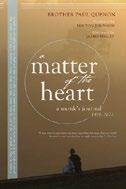
A Trappist monk reflects on such subjects as spirituality and the daily minutiae of monastic life in a series of journal entries spanning more than half a century. Quenon has spent the last six and a half decades as a monk at the Abbey of Gethsemani in Kentucky. Having authored multiple other works, including In Praise of the Useless Life (2018) and the poetry book Unquiet Vigil (2014), he now offers pages from his journals, which he’s
divided into five parts spanning from 1970 to 2022, and added footnotes to provide additional context and definitions of terms that may be unfamiliar to readers. Some accounts are highly personal, such as one of the death of his twin sister in 1995, while other musings are more philosophical and esoteric, as in this entry from 1993: “The act of wanting belongs to the idiom of the ego….Beyond that is a desire which is not set by the ego or derived from self-knowledge in the usual sense of the word. On that deeper level, I do not know what I want, in terms of a clear definition of a goal. I only know that I do want and even that is not always clear to me.” Overall, the author offers a unique mix of reminiscences, philosophical musings, and historical connections, as when he presents his impressions of the end of the Vietnam War in 1975. Throughout, Quenon makes the disparate parts of his unique life feel universal by regularly including events that will be relatable to people outside the monastery. Some passages, such as his middle-of-the-night thought that “God is not the predator but the prey,” may befuddle more than enlighten, but most observations—including his wry comments on mass consumerism or his ideas regarding connections between Taoism founder Lao Tzu and Jesus— contribute to the work’s accessibility. An intriguing collection of thoughts and impressions that offer a rare glimpse into a solitary life.
Renz, Gregory Lee | Three Towers Press (393 pp.) | $29.95 Aug. 24, 2024 | 9781595989987

Two seasoned firefighters and a police captain try to save young girls from a dangerous gang. Lee Garrison is merely 350 days away from retirement as a firefighter, but the job—and his elderly live-in father—are both weighing heavily on him. Lee also suffers from disturbing
memories of his fiancee’s death, his years rushing into burning buildings, and the tragedies he saw in the Vietnam War. While seeking treatment for symptoms of PTSD, Lee meets Police Capt. Brigid O’Brien, a steely female cop determined to try to get help for him. By chance, or possibly divine intervention, Lee meets the foster family of a young girl named Alexus, whom he saved from a school fire, and their family friend Mitch Garner. Alexus comes from the troubled world of inner-city Milwaukee, where a dangerous gang known as the Disciples rules the criminal underworld. Mitch enlists Lee’s help in trying to save Alexus’ older sister, Jasmine, whom he believes is being trafficked by the Disciples. When Brigid confirms that corruption at the highest levels may prevent them from getting help through the proper channels, these three tough but vulnerable heroes set out to save a family. Renz builds each of his central characters with great care. Behind the hard-boiled, tough-talking cop and firefighter stereotypes, there are numerous layers of complexities that touch on real psychological and social issues. That level of depth requires a lot of exposition, and the book’s first third dumps so much information about missing teens and past traumas that it’s difficult to keep it all straight. When Renz gets into the action of his three crime fighters verbally sparring with each other or taking down the nefarious Disciples, however, readers will be glad to be along for the ride. Complex, fast-talking characters add intensity to this action-laced thriller.
Robson, Cecy | Entangled: Red Tower Books (448 pp.) | $26.99 Oct. 22, 2024 | 9781649374059

A princess and a gladiator join forces amid political intrigue and bloody carnage in Robson’s fantasy novel. For the citizens of the wealthy kingdom of Arrow, the most exciting
DELPHINIUM GOSPEL
entertainment can be found in the arena—for the gladiators from the surrounding kingdoms, it’s a relentlessly brutal series of fights to the death. The combatants hope to win enough matches to earn the royal title of “Bloodguard,” which will allow their families to immigrate to Arrow. Leith, a gladiator in his mid-20s, is a skilled fighter driven by his desperation to support his mother and two younger sisters (and by the rage built from years of killing his peers for an audience’s delectation). After killing the arrogant Lord Filip (who challenged him to an impromptu duel) and subsequently emerging victorious in a surprise melee with a group of his peers and a dragon, Leith is getting closer to becoming a Bloodguard. He attracts the attention of Princess Maeve, a 20-year-old healer. Now that her fiance, Lord Filip, is dead, she’s in dire need of a noble spouse so that she can claim the throne when she turns 21. Maeve proposes a deal: She’ll help Leith achieve the Bloodguard status in exchange for his hand in marriage. But as their relationship blossoms, problems arise when royal secrets are revealed and government corruption is exposed. Soon, they’re not just vying for a title and a crown—they’re fighting for their lives. Robson’s novel is an exciting blend of action, palace intrigue, and romance in a high fantasy setting. The story unfolds through the perspectives of Maeve and Leith, who are both compelling and well developed, with flaws, foibles, and distinctive voices. The supporting characters are equally intriguing. Readers will love the richly detailed worldbuilding and combat sequences, as well as the use of snarky, modern language (“Of course the only royal offering me help is one who’s clawing her way to the throne, not already sitting pretty on one. That tracks,” Leith gripes). The book’s
thoughtful queer representation and exploration of oppression and exploitation are also noteworthy.
An expertly crafted page-turner with unpredictable twists, steamy romance, and magical creatures.
Scott, Denzel Xavier | ELJ Editions (108 pp.) | $20.00 paper June 18, 2024 | 9781942004684
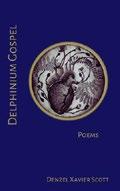
In his debut poetry collection, Scott explores the intersections of race, class, gender, and sexuality. The collection is divided into three parts covering distinct themes. In “Moonrise: Womb of Culture,” Scott elegizes his older brother, a victim of a mass shooting. He reflects on the inevitability of the loss of young Black lives: “In America, it’s sad, but practical / to plan for a Black child’s funeral,” the speaker explains in “Carrying Coffins.” Death and tragedy pervade this segment, which also explores Scott’s identity as a Black queer man. In “Midnight: Paradise of Self,” the author examines the intersection of his race, sexuality, and socioeconomic status, grappling with his position as a queer, working-class, educated Black man. Finally, in “Moonset: Resurrecting Social Worlds,” Scott looks outward at society, addressing pervasive racism and objectification in poems like “A Lesson Henrietta Lacks Teaches Anyone Willing To Learn” and “Churches of Hemlock.” Notably, this is also the section in which the author finds connection, ending the entire collection by depicting a party of queer people in “Seven People Dancing.” Though his
work is steeped in sometimes painful reality, Scott creates an alternate world in which he can explore intense subject matter; readers are swept into this sacred space to commune with the poet and understand his experiences. References to the delphinium plant simultaneously signify the dark corners Scott explores and the level of passion evident in his work. Allusions to Greek mythology align his work with classic literature while subverting readers’ expectations of neo-classical poetry and the “ivory tower” air of the form. While his references can sometimes seem inaccessible to a general audience, his verses create an emotional journey that all poetry readers can enjoy. Experiments with form allow for visual interpretations of each poem, enhancing the reader’s experience.
A riveting and esoteric collection of poems that creates space for coping with grief, violence, racism, and loneliness.
Serani, Deborah | Illus. by Kyra Teis Free Spirit Publishing (40 pp.) | $15.99 Sept. 10, 2024 | 9798885540919
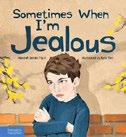
In Serani’s picture book, a child struggles with jealousy and turns to a teacher and family for advice. As the young narrator goes through his day, he realizes that he’s often jealous. Home can be difficult when his baby sibling needs help and his older sister gets to stay up late. School is hard when classmates want the narrator’s art materials, or when he isn’t the best at soccer. And weekends can be challenging when his friends play with others, and he’s left alone. However, when things are difficult at home, the narrator’s dad affirms his feelings and offers to include him in feeding the baby. At school, his teacher encourages him to reflect on what he can do with his jealousy; he shares markers and asks the soccer coach for help. On the weekends, Grandpa offers to bring the
narrator to the playground. Amid Teis’ colorful drawings picturing varying facial displays of the child’s emotions, young readers will likely find the story and scenarios relatable and easy to understand. The book goes beyond how to recognize difficult feelings and encourages children to share them with adults in their lives. The narrator and his family are depicted with pale skin, and crowds of children outside have a range of skin tones.
A good book for kids and parents who are navigating conversations around difficult emotions.
Sherwood, SJ | Blue Ned (210 pp.) Oct. 31, 2024
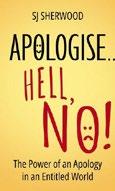
Sherwood presents a memoir of a difficult childhood and a manual about meaningful apology.
The Englishborn author writes that he grew up in a “domestic war zone” with a narcissistic mother; his father left when he was 2 and didn’t come back into his life for 20 years. As an adult, he found that he’d “spent a large portion of my life demanding apologies that hadn’t come and then feeling resentful for it.” And yet, the “s-word” (“sorry”) still haunted him, which led him to analyze how it’s used, abused, and manipulated. For example, he explores how technology has changed human interaction and asserts that it’s weakened people’s ability to empathize. A genuine, direct apology, Sherwood asserts, requires more empathy and less ego—a lesson that he punctuates with anecdotes about his mother. She had a habit, he says, of looking for reasons that others needed to apologize to her, especially in public: “Narcissists tend to be chronically irritated, and it comes out via impatience,” he writes. Confident people who are content with
themselves can easily say they’re sorry, he argues, and entitled people can’t. Sherwood also goes into detail about the emotional work he’s done to help himself and effectively acknowledges that he has more to do, taking Seneca’s advice: “Make sure against your dying day—that your faults die before you do.” He also takes an appealingly logical approach to his arguments, offering several examples to back up his claims, such as his father after the divorce, actor Will Smith after “the slap” at the 2022 Academy Awards ceremony, and politicians who often see apologies as dangers to their careers. Sherwood also ably examines different types of apologies, such as how a quick “sorry” is just a “pacifier” that “soothes in the moment without fixing the underlying problem.”
A deeply personal yet systematic approach to the delicate art of apologizing.
Soling, Cevin | Spectacle Films (100 pp.) | $11.39 paper Jan. 5, 2015 | 9780990939900

Author, filmmaker, and musician Soling presents a manifesto for empowering students in a system of mandatory education.
The author states his case in blunt terms, addressing high school–aged readers directly and informing them that schools are places of humiliation by design: “By being deprived of free speech and free assembly, you are literally held captive,” he writes. “By being forced to sit in an uncomfortable chair all day long and listen to someone you did not choose to listen to, and read texts you do not want to read, your most basic democratic rights are violated.” In these pages, Soling outlines what he sees as the evils of the educational system, from locker searches to
corporal punishment (which is legal in 19 states, and which he rightly calls “sickening”). He also describes the many things students can do to fight such evils, from organizing protests to filing police reports. Although many of the actions that he advocates in this slim work may have significant consequences for students, including poor grades, he repeatedly stresses that they shouldn’t commit illegal acts while disrupting the formal structure of their education. Because the book is polemical in nature, it’s unsurprising that it includes a chapter titled “Bad Arguments in Defense of Schooling”; the author ably short-circuits notions that schooling teaches interpersonal skills or acclimates students to authority structures they’ll encounter in adult life. For Soling, school is nothing more than “an institution that selectively dispenses information in an incoherent manner within an oppressive construct that interferes with learning,” and he effectively offers no compromise on this point. Indeed, his prose is electric in its passion and anger; even readers who are unconvinced by his case are likely to find themselves rethinking old certainties about a pillar of American life. A fierce and thought-provoking condemnation of the American school system.
Sweeney, Ashley E. | She Writes Press (344 pp.) | $18.99 paper Dec. 10, 2024 | 9781647427764
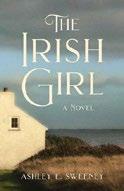
A young girl makes her way in America after emigrating from Ireland in Sweeney’s historical novel. It is October of 1886 when 13-year-old Mary Agnes (called Mary A.) Coyne gives her beloved grandfather, Festus Laffey, a tearful goodbye hug and kiss. She is on her way to America—alone, frightened, and excited. Although she had
dreamed of seeing the world beyond western Ireland, she had not expected to leave on her own at such a young age. But her mother throws her out of the house after her 15-year-old half brother Fiach attempts to rape her, blaming Mary A. for the attack. Her grandparents offer her sanctuary from her violent father and vengeful mother, but her grandmother grows ill and can no longer care for her. Her grandparents arrange for Mary A.’s maternal uncle and his family, living in Chicago, to provide a home for her. Arriving in Manhattan, she goes to the church that is supposed to send her on to Chicago and learns that she must live with and work for an Irish family in New York before the priest will pay for her train ticket. One month later, Mary A. heads west. After a warm and effusive welcome, her uncle makes it clear she must find a live-in service job in one of Chicago’s prominent houses. Joy and sorrow await her. The poignant narrative is helmed by a sturdy young protagonist who faces a series of obstacles and injustices with courage, picking herself up after each emotionally challenging (and sometimes tragic) setback and pushing forward with determination. Sweeney imbues her prose with a gentle Irish lilt: “a beauty she were, that Laffey girl, when she were young; such a shame what happened to her, do you think it could have been her—no, no, best not to say, best not to say.” Her depictions of life in Ireland, the tortuous journey across the Atlantic, and Mary A.’s experiences as a young immigrant, complete with the rampant bigotry and misogyny of the era, are always vivid and compelling.
An addictive and frequently painful drama with a strong female lead who shines with resilience.
Tembreull, R.M. | Atmosphere
Press (288 pp.) | $16.99 paper Sept. 1, 2024 | 9798891323599

Earth is on the verge of being judged unworthy and devoured by alien entities in Tembreull’s SF thriller, the first in a series.
In a hell-world in the center of outer space’s Dark Matter realm abide the Inani, batlike humanoids who inspired the infamous real-life West Virginia cryptid “Mothman.” They devour unpromising or nonessential planets to sustain themselves; Earth is on the menu, doomed by its detrimental, self-destructive apex species, the greedy and violent Homo sapiens. Earth actually had potential, as evidenced by the nature-centered culture and cosmology of North America’s Indigenous peoples, but they were extirpated by European invaders who were armed with bigotry, firepower, and religious fervor. Presentday humanity (manipulated by secret agents of Chaos) suffers under climate change and political discord. In the midst of natural disasters and fascist militias, the state of Texas secedes to become the brutal Lone Star Nation. (However, it still contains champions and “elementals” on Earth Mother’s side.) Arden McBride is a traumatized veteran of the United States’ invasion of Iraq. Now a born-again “Druid,” he serves as mystic protector of a handful of nature-loving Austin-based pagans running from conservative gun-nut death squads. Other heroes include Komkom “Kwin” Akwini, a talking tree
A vision quest–like eco-fantasy musing on the anguished conditions of modern Earth.
(the mighty Kwin?), and STEM, an elemental spirit who became entangled in a new human-made “innerverse” (the internet) and struggles to comprehend a Donald Trump–era miasma of digital disinformation and hostility. But what of the Mothman? See next installment. This book is very much a stage-setting opener, drawing from the same author-illustrator’s earlier linked short-story compendium, Stories, Legends and Truths From the Blighted Earth (2023). A veritable cornucopia of anthropological musings and introspection accompanies the slight storyline, which is rich in abstruse language and word invention (“Chaos’s En’Troop-EE had invaded the Web with an ingeniously conceived and well-executed insurgency of hate, infiltrating all exchanged processes”) and short on positive things to say about Western civilization. Timely references to 21st-century pathologies distinguish the story from artifacts of the literary era when Carlos Castaneda’s Don Juan did or didn’t walk the Earth.
A vision quest–like eco-fantasy musing on the anguished conditions of modern Earth.
Teresi, Christian | Red Hen Press (104 pp.) $17.95 paper | Sept. 24, 2024 | 9781636281704

In Teresi’s collection, he examines inequities, hierarchies, and history. In the opening poem, “Reading Osip Mandelstam in Zion National Park,” Teresi notes that the park’s very name comes from “the decisions of bureaucrats / And missionaries who ignored and redacted the indigenous words / Renamed this place after the Jerusalem fortress David conquered.” He quickly moves from the lasting effects of colonialism to the park’s unique beauty: “The quaint vulgarity of human architecture has no blueprint
for this.” The tension between humankind and the natural world continues throughout, with Teresi frequently observing how humans have treated one another across time. He uses a few recurring structures, so indicated by their titles: for example, the “reading” series features the narrator studying the work of historical figures while visiting national parks. In “Reading Osip Mandelstam in Zion National Park,” Teresi adeptly juxtaposes Zion National Park’s open landscape with the “windowless rooms” that held Mandelstam, a poet who was exiled and then imprisoned by Stalin’s regime. The collection also includes a series of conversation poems between two asynchronous figures. The boxer Mike Tyson explains aging and the perils of fame to the Romantic poet John Keats, “Most men must take a few punches / To win, but not you and me, John,” and Mayan gods pity Supreme Court Justice John Roberts and his court decisions. Other poems use the same phrases but ordered in two different columns and grapple with humanitarian issues, like the deaths of refugee migrants or the whitewashing of history. These stylistic choices work well, grabbing the reader’s attention and underscoring the overarching theme of interrogation. How people justify their decisions permeates the book. Teresi writes, “We think it mercy to forge one narrative / By removing another.” The “we” collectively implicates humanity in a long timeline of atrocities. Often, the justifications or motivations Teresi presents trace back to the divine and the ways various religions have used gods—Christian, Greek, or preColumbian—to serve personal interests. Here, a self-serving religious figure faces the consequences of his actions: A minister preaching about the Tree of Knowledge is later killed by a tree in a car accident. Teresi also grapples with how new generations are unaffected by prior wrongs. In “We Call It Wisdom,” a poem about teaching students about war’s effects, children react with laughter. Teresi’s work has the frankness of someone who, as one of his speakers believes,
“suspects nothing natural holds / On to vulnerability with nostalgia.” The author also employs imagery of damaged flora, fauna, and landscapes to explore how developed nations have collectively ravaged the planet. These verses allow readers to draw their own conclusions about the costs of human progress and even consider what no longer exists: “The ground is woven with the diaphanous swelling of where a birch once was…it is there, even after the ax, even after the hollering rot of a stump.” Overall, Teresi’s collection offers a cleareyed, inventive take on the effects of power.
A cogent, skeptical collection that examines those whose stories are erased or preserved.
Upton, Jon | BookBaby | Nov. 18, 2024

Upton’s middlegrade series starter takes place in a complex world of powerful, mysterious creatures. Wren Goldsmith is a 12year-old Beast Saver whose mission is to protect Beasts in need with the help of a Companion Beast named Tolstoy—a doglike creature who can change size at will and has fur that functions as armor. Wren is confident, skilled, quick-thinking, and eager to prove his abilities as a new Saver. The plot revolves around Wren and Tolstoy’s mission to the Pomm Islands, where formerly peaceful Beasts are going on rampages. The cause of the unrest seems to be parasites infecting the creatures, which drive them to violence. Wren must subdue a massive Beast called a coral cow, which is ordinarily a caretaker of the coral reefs. Later, the tween encounters twins Maxie and Vega, who are part of a mysterious group known as the Scavengers; they work for a larger, unknown entity that’s likely involved in illegal activity. Wren, Tolstoy, and their ally, Lieutenant Tang,
investigate as they aim to restore order to the islands; however, the mystery behind who’s responsible for the chaos remains unsolved, hinting at future adventures. Overall, Upton’s story is marked by energetic pacing and action-driven plot development, and it feels well suited for its target audience of young readers. The characterization leans heavily on familiar archetypes, with Wren as the brave hero and Tolstoy as the loyal sidekick; the bickering twin antagonists embody their roles with lines such as “It’s so unfair. Just because you were born two minutes early—” The characters’ relationships are central to the narrative, and the author highlights trust and teamwork throughout. Upton’s prose style is simple yet vivid, with imaginative descriptions of Beasts and dynamic action scenes, and the dialogue snappily propels the plot forward.
Young readers will enjoy this character- driven tale’s richly imagined fantasy world.
Volić, Ismar | Princeton University Press (408 pp.) | $27.28 April 2, 2024 | 9780691248806

A writer and academic explores how math can be used to understand and critique the world of politics.
“Math is a clarifying way of looking at the world,” Volić writes in his introduction; by introducing readers to this specific perspective, he hopes to lead them to a new view on the contentious topic of politics. The author explains that, for him, democracy is “a piece of civic infrastructure that runs on mathematics.” That idea forms the backbone of a university class he teaches on the topic that regularly outrages students as they realize the counterintuitive nature of
many long-standing political systems. With this book, Volić aims to bring that classroom experience to a wider audience. He structures his detailed examination of math and politics by first analyzing voting, then issues of representation, finally providing an explanation of how all of his ideas came together using concrete examples of civic infrastructure, both historical and contemporary. Volić walks readers through the ins and outs of simple majorities and pluralities and lays out the basics of mathematic theorems— the pinnacles of mathematical knowledge—noting the difficulty of translating notions like the “best” voting system into mathematic language. Early on, Volić brings out one of his most salient and important arguments, detailing how many “convenient numbers” used in the world’s democracies are largely unjustified. His primary example is membership in the House of Representatives being fixed at 435 seats, but there are several other examples that similarly become infuriating when looked at objectively. The author provides numerous examples, from Eurovision protocols to the 2010 Oakland, California, mayoral race, to illustrate the instant runoff system, which here receives ample attention and detailed explanations, forming a cornerstone of Volić’s recommendations. From there, the author moves on to perhaps the most enraging political processes of them all, discussing gerrymandering and the Electoral College, walking readers through the fine points of everything wrong with a system that works against fair representation. (He also offers several examples of proportional representation in other countries outside the U.S.)
Volić’s book is rich with ideas and explanations, and he writes with an enthusiasm for his subject that is infectious. It’s easy to imagine the
author in front of a classroom, leading the students to light bulb–moment realizations while being humorous and approachable. His writing is calibrated to speak to the greatest number of people, not just college-level students or academics. Volić’s humor, in particular, renders even the most complicated sections accessible. “The rest of this chapter will be exasperating. Irritating,” he writes at one point; he even puts a winking spin on his footnotes, proclaiming, “If you don’t know what MAGA is, you’ve either spent the last seven or so years in a well or you’re reading this 150 years from the time it was written.” Despite the passionate prose, the numerous tables, laws, and theorems can start to blur together— the subject remains complicated and academic at its core. Happily, there is just enough of Volić’s voice—and his own story as an immigrant from Bosnia and Herzegovina—to keep even the most math-averse reader pushing through the difficult sections, eager to hear more of his ideas. A fascinating perspective on challenging subject matter.
Walker, Michael | BookBaby (340 pp.) $16.99 paper | Sept. 17, 2024 | 9798350959277
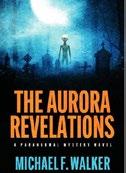
Walker’s novel charts the enigmatic disappearance of a prominent paranormal researcher and podcaster during a road trip visiting America’s most bizarre and mysterious landmarks.
In a New Mexico national park that serves as a New Age/occult-enthusiast destination, a bloodied, dazed man is found by a tour guide. The man’s backpack holds a strange scrapbook of printed transcripts, blog posts, emails, texts, short stories, old articles, and other miscellany that, arranged in rough chronological order, shape-shifts into a wild yarn spanning the summer of 2015. During an epidemic of suicides as more and more Americans just start giving up and becoming zombielike unhoused people, paranormal podcaster and webmaster Kevin Starkly gathers long-standing friends and weirdness enthusiasts (the “Nerd Legion”) for a road trip visiting the nation’s landmarks linked to UFOs, ghosts, and monsters. In the New Jersey Pine Barrens (the domain of the legendary Jersey Devil), Kevin vanishes, surrounded by blue lights. Spurred by the urgency to solve Kevin’s disappearance (or simply playing along with his game), the remaining teammates and some satellite associates travel onward to an alien-abductee convention in Ohio’s mound-builders’ country, the remnants of Nikola Tesla’s workshops, and an alleged 1897 crash (and burial) site of a “spaceman” in Aurora, Texas. Murder, menace, and bizarre occurrences proliferate in a fragmented plotline that is part Blair Witch Project and part Up the Down Staircase. The material speaks uncannily well to those familiar with late-night conspiracy radio and dubious volumes by Whitley Strieber—the narrative is a neat intertwining of fiction with actual Forteana lore (“I suggest a detour to the famous Mystery Hill here in North Salem, NH. Always some strange rituals taking place around here especially by the Sacrificial Table”). Walker pulls an amazing aggregation of borderline satire and surreal terror into a coherent and spooky whole; Neil Gaiman’s American Gods (2001) occasionally springs to mind, which is no small praise.
A supernaturally effective oddity odyssey.
Ripped

Kirkus presents Indies Worth Discovering , a sponsored feature spotlighting an array of fiction and nonfiction works recommended by Indie editors. Here readers can find a useful sampler that shows the excellence and breadth of Indie titles. Find pulse-pounding thrillers, revealing memoirs, twisty mysteries, fiery romances, thoughtful business books, problem-solving self-help guides, and incisive poetry collections, among many other works. Searching for something new and exciting? Read on.
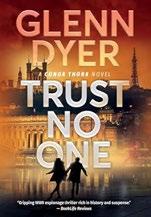
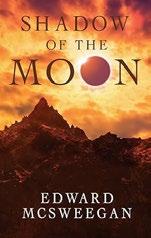
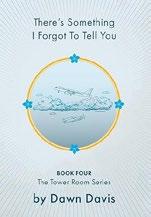
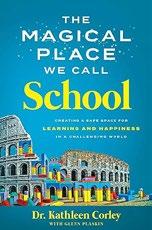
By Glenn Dyer
A series entry that offers thrills, intriguing locations, and brash heroics.

By Edward McSweegan
An enjoyable western with contemporary sensitivities.
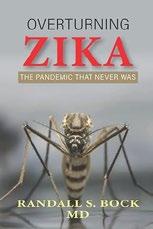
By Dawn Davis
This offbeat take on time-hopping stories begins slowly but finds momentum in memorable characterization.
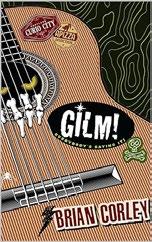
By
Kathleen Corley with Glenn Plaskin
An often encouraging, compassionate, and reasoned approach to running elementary schools.

By Charlotte Stuart
A solidly constructed and very satisfying murder mystery set in a largely vanished Alaska.
By Randall S. Bock
A provocative peek into the real-life mechanics of the scientific process.
GILM!
By Brian Corley
A short, catchy indie-rock love song of a book with underlying depth.
By James Gilbert
An absorbing legal thriller that’s both powerful and delightfully nuanced.

Kirkus Star
By
Amy Johnson
& Diane Madden; illus. by Abigail Gray Swartz
A charming tale sure to pique kids’ interest in Scotland—and tortoises.
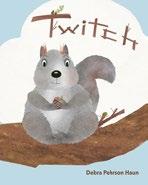
Twitch By
Debra Pehrson Haun
An appealing, preschoolfriendly introduction to perseverance, selflessness, and the changing of the seasons.

By Colleen Dolan
A poignant, hardhitting real-life tale of tragedy and accountability.

By Leon E. Pettiway
This formidable collection of essays offers a profound alternative vision for a more equitable future.


Ghosted
By Sarah Ready
A twisty time-bending saga with an appealing lead and secondary characters.

By Tim Turner & Moisey Gorbaty
A moving family tale with a strong cast that readers will love.

Childless Mother By Tracy
Mayo
A compelling remembrance that skillfully explores the cost of family secrets.
Home
By Dean Cycon
A haunting, emotionally challenging read, with frightening contemporary relevance.




Kirkus Star
By Denis O’Neill
A peppery and unfailingly compelling set of reactions to one calamitous year.
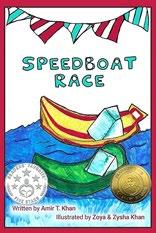
By Michael Jamin
A lovely anthology that strikes a perfect balance between humor and poignancy.
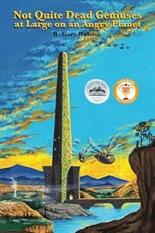
By Amir T. Khan; illus. by Zoya Khan & Zysha Khan
An earnest paean to determination and hard work for young readers.
Not Quite Dead Geniuses at Large on an Angry Planet
By R. Gary Raham
An increasingly madcap conclusion to an ecothemed SF saga of a weary Earth chafing under its alien tenants.
By Michael Lightsey
A sensational cast fuels this exuberant tale that baffles as often as it charms.
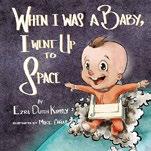
When I Was a Baby, I Went Up to Space
By Ezra Dutch Kimsly; illus. by Mike Cañas
A giggle-worthy, whimsical adventure.
Restarting Your Life When You Are No Longer a Wife
By Diane Burroughs
A helpful primer for getting over heartbreak after the age of 50 with humor and heart.

Deep Blue Cover
By Joel W. Barrows
Timely and tense; a worthy addition to a thriller series.


By Laurel Colless
A wild and compelling journey for young readers.

Two Bulldozer Buddies
By Tatyana Kuprienko; illus. by Kseniia Kudriavtseva
A heroic and easily accessible adventure for the very young.
By Brian Dovey
A refreshing and informative startup manual that offers an abundance of professional wisdom.

By Rin Kelly
A wide variety of thought-provoking tales.

